Aviat Networks 3ECJ68A4D Digital Radio User Manual CERTIFICATE OF COMPLIANCE
Aviat Networks Digital Radio CERTIFICATE OF COMPLIANCE
Contents
Users Manual

Rhein Tech Laboratories, Inc. Client: Stratex Networks
360 Herndon Parkway FCC: Part 15.247
Suite 1400 Industry Canada: RSS-210
FCC ID: ONJ-3ECJ68A4D Herndon, VA 20170
http://www.rheintech.com Model Name: Velox LE 5850
Page 38 of 46
APPENDIX F: USER MANUAL
Please refer to the following pages.

Velox LE
Installation and Operation
Manual
Velox LE User Manual
862-02411 February 2004
Copyright © 2003 by Stratex Networks, Inc.
ALL RIGHTS RESERVED
No part of this publication may be reproduced, transmitted, transcribed, stored in a retrieval system, or translated into any
language or computer language, in any form or by any means, electronic, magnetic, optical, chemical, manual or otherwise,
without the prior written permission of Stratex Networks, 120 Rose Orchard Way, San Jose, California, 95134, USA.
Windows is a registered trademark of Microsoft Corporation in the United States and other countries.
Andrew name and logo is a registered trademark of Andrew Corporation.
The HUBER+SUHNER word as well as the H+S word and the HUBER+SUHNER logo are registered trademarks and/or
service marks of HUBER+SUHNER AG.
The accuracy and adequacy of this document are the responsibility of Stratex Networks. Please address any comments or
corrections to Stratex Networks (see Support on page 1-4).

Federal Communications Commission Notice
The equipment has been tested and found to comply with the limits for Class A, digital device, pursuant to Part 15
of the FCC Rules.
These limits are designed to provide reasonable protect ion against harmful interference when the equipment is
operated in a commercial environment. This equipment generates, uses, and can radiate radio frequency energy
and, if not installed and used in accordance with the instruction manual, may cause harmful interference to radio
communications.
Operation of this equipment in a residential area is likely to cause harmful interference in which case the user will
be required to correct the interference at his own expense.
The manufacturer is not responsible for any radio or TV interference caused by unauthorised modifications to this
equipment. Such modifications could void the user's authority to operate the equipment.
This device complies with Part 15 of the FCC Rules. Operation is subject to the following two conditions: (1) this
device may not cause interference, and (2) this device must accept any interference, including interference that
may cause undesired operation of the device.
!
WARNING
WARNING- To comply with FCC RF exposure limits, the antennas for this
transmitter must be fix-mounted to provide a separation distance of 2 meters (6.6 ft)
or more from all persons to satisfy RF exposure requirements.
Equipment installation and use
This equipment must be professionally installed. The operator of the spread spectrum or digitally modulated
intentional radiator, or the installer if the equipment is professionally installed, is responsible for ensuring that the
system is used exclusively for fixed, point-to-point operations.
NOTE 1: The Velox LE 2410 frequency output must be limited to between 2412MHz and 2458MHz and the
power to a maximum of +22dBm (2412-2426MHz) and +18dBm (2458MHz) for the required antennas for
compliance to FCC standards, U.S. only.
NOTE 2: The centre frequencies of the Velox LE 5850 radio is limited by firmware between 5731MHz and
5844MHz as outlined in Velox LE 5850 and Velox LE 5850i Frequency Channels Plan A, B and C (FCC
Compliant) on page 8-6 and Velox LE 2450 and Velox LE 2450i Frequency Channels Plan A, B and C (FCC
Compliant) on page 8-7 and the transmit power is limited to +24dBm. The device must be used with one of the
antennas listed below to comply with FCC standards:
§ Gabriel Electronics parabolic antenna, model number SSP2-52B
§ Harris Corporation flat panel antenna, model number MT-20004.
NOTE 3 The centre frequencies of the Velox LE 5810i radio is limited by firmware between 5735MHz and
5840MHz as outlined in Table 2-5 on page 2-3 and the transmit power is limited to +25dBm. The device must
only be used with the antenna listed below to comply with FCC standards:
§ Gabriel Electronics parabolic antenna, model number SSP2-52B
INDUSTRY CANADA Notice
This device has been designed to operate with an antenna having a maximum gain of 33 dBi. Antenna having a
higher gain is strictly prohibited per regulations of Industry Canada. The antenna impedance required is 50 ohms.
Operation is subject to the following two conditions: (1) this device may not cause interference, and (2) this
device must accept any interference, including interference that may cause undesired operation of the device.
Exposure of Humans to RF Fields
The installer of this radio equipment must ensure that the antenna is located or pointed such that it does not emit
RF field in excess of Health Canada limits for the general population; consult Safety Code 6, obtainable from
Health C anada's web site: www.hc-sc.gc.ca/rpb
ETSI Notice
Transmit power has been limited to +20 dBm EIRP for use in ETSI regulated areas.

Velox LE Installation and Operations Manual
862-02411 February 04 i
Contents
Velox LE Installation and Operation Manual................................................................... 1
Chapter 1 : About this Manual..........................................................................................1-1
Welcome................................................................................................................................................................................1-1
Purpose ..................................................................................................................................................................................1-1
Intended Audience...............................................................................................................................................................1-1
What You Need To Know ..................................................................................................................................................1-1
Organization.........................................................................................................................................................................1-2
Associated Documents ........................................................................................................................................................1-2
Conventions and Terminology ..........................................................................................................................................1-2
Abbreviations .......................................................................................................................................................................1-3
Support...................................................................................................................................................................................1-4
Chapter 2 : Planning............................................................................................................2-1
Introduction...........................................................................................................................................................................2-1
System Type Selection........................................................................................................................................................2-1
Antenna Selection................................................................................................................................................................2-2
General .............................................................................................................................................................................2-2
Fixed Antennas ...............................................................................................................................................................2-3
Site Evaluation.....................................................................................................................................................................2-3
Multipath Effects .................................................................................................................................................................2-4
Interference Considerations ...............................................................................................................................................2-4
Microcell Backhaul Applications of Velox LE Digital Radios ...................................................................................2-5
General .............................................................................................................................................................................2-5
Transmitted Power Levels ............................................................................................................................................2-5
Frequency Multiplexing................................................................................................................................................2-6
Antenna Isolation ...........................................................................................................................................................2-6
Chapter 3 : Controls, Indicators and Connectors on the DIU and RFU.................3-1
Introduction...........................................................................................................................................................................3-1
Control, Indicators and Connectors on the DIU .............................................................................................................3-1
General .............................................................................................................................................................................3-1
Payload T1/E1 Connectors (1).....................................................................................................................................3-3
DIU Status Diodes (2)...................................................................................................................................................3-6
Reset/Configuration Button (3)...................................................................................................................................3-7
Service (Wayside) Serial Data Channel (4)...............................................................................................................3-8
Element Manager Port (5) ............................................................................................................................................3-9
10Base-T Ethernet RJ45 Port (10/100Base-T on Velox LE 50 DIU) (6) .............................................................3-9
DIU/RFU Link LED (7)................................................................................................................................................3-9
DIU/RFU Data (8)....................................................................................................................................................... 3-10
RFU DC Out (9) ........................................................................................................................................................... 3-10
Auxiliary I/O (10)........................................................................................................................................................ 3-10
DIU DC Power Input (11) .......................................................................................................................................... 3-11
Fuse Holder (12) ........................................................................................................................................................... 3-12
On/Off Switch (13)...................................................................................................................................................... 3-12
Ground Terminal (14)................................................................................................................................................. 3-12
Indicators and Connectors on the IRFU and ORFU ....................................................................................................3-13
General ........................................................................................................................................................................... 3-13
Antenna Connector (1) ................................................................................................................................................ 3-13
RSSI (2) ......................................................................................................................................................................... 3-14
DIU COMMS............................................................................................................................................................... 3-14
DIU/RFU Data (3)....................................................................................................................................................... 3-14
DIU Power ..................................................................................................................................................................... 3-14
DIU DC In (4)............................................................................................................................................................... 3-14
Ground Terminal (5).................................................................................................................................................... 3-15

Contents
ii 862-02411 February 04
Chapter 4 : Hardware Installation ...................................................................................4-1
Introduction...........................................................................................................................................................................4-1
Health and Safety.................................................................................................................................................................4-1
Velox LE Health and Safety Requirements ............................................................................................................... 4-1
General Health and Safety............................................................................................................................................ 4-1
Operator Health and Safety.......................................................................................................................................... 4-2
General Hazards ............................................................................................................................................................. 4-2
Hardware Installation Overview .......................................................................................................................................4-5
Pre-Installation .....................................................................................................................................................................4-6
General ............................................................................................................................................................................. 4-6
Installation Tools and Equipment ................................................................................................................................ 4-6
Unpacking the Equipment ............................................................................................................................................ 4-8
Bench Set -up (First time users).......................................................................................................................................4-10
Getting started (Without a PC) ..................................................................................................................................4-10
Getting Started (with a PC) ........................................................................................................................................4-12
Site Installation...................................................................................................................................................................4-15
Installing the Antenna .................................................................................................................................................4-16
Installing the ORFU .....................................................................................................................................................4-16
Installing the IRFU ......................................................................................................................................................4-19
Installing the DIU.........................................................................................................................................................4-19
Installing the DIU to RFU Data and Power Cables ................................................................................................4-21
Commissioning ..................................................................................................................................................................4-22
General ...........................................................................................................................................................................4-22
Equipment Required for Commissioning.................................................................................................................4-22
Information Required ..................................................................................................................................................4-22
Antenna Alignment ......................................................................................................................................................4-23
Diagnostics (Loopback Modes) .................................................................................................................................4-26
Chapter 5 : NCT Installation .............................................................................................5-1
Connecting to the Velox LE...............................................................................................................................................5-1
NCT Software Installation.................................................................................................................................................5-1
Scope................................................................................................................................................................................ 5-1
Introduction..................................................................................................................................................................... 5-1
System Requirements .................................................................................................................................................... 5-2
Installing the NCT.......................................................................................................................................................... 5-2
Configure Radio using NCT ..............................................................................................................................................5-3
Chapter 6 : NCT PC Set-up...............................................................................................6-1
Element Manager Point-to-Point Protocol Serial Communications Set -up ...............................................................6-1
Introduction..................................................................................................................................................................... 6-1
Adding Dial -up Networking : Windows 2000.......................................................................................................... 6-1
Adding Dial -up Networking : Windows XP ............................................................................................................. 6-2
Set-up of Dial-up Connection Properties for Windows 2000/Windows XP........................................................ 6-2
Adding a Modem for Windows NT............................................................................................................................ 6-3
Adding Dial-up Networking for Windows NT ......................................................................................................... 6-3
Adding a Modem: Windows 95/98 ............................................................................................................................. 6-4
Adding Dial -up Networking : Windows 95/98 ......................................................................................................... 6-5
IP Configuration of the Velox LE .....................................................................................................................................6-7
BRIDGED Configuration: Input Address Assignment ........................................................................................... 6-7
ROUTED Configuration: Input Address Assignment ............................................................................................. 6-9
Chapter 7 : Maintenance and Radio Upgrades............................................................7-1
Velox LE FTP Firmware Upload......................................................................................................................................7-1
Firmware Upload............................................................................................................................................................ 7-1
Set-up for Full Duplex Mode (at Maximum Transfer Rate)................................................................................... 7-2
Tributary Upgrading............................................................................................................................................................7-3
Chapter 8 : Technical Information..................................................................................8-1
Radio Description ................................................................................................................................................................8-1
Introduction..................................................................................................................................................................... 8-1

Velox LE Installation and Operations Manual
862-02411 February 04 iii
Control and Management ..............................................................................................................................................8-1
Velox LE Models ...........................................................................................................................................................8-2
Technical Description.........................................................................................................................................................8-4
System Overview ...........................................................................................................................................................8-4
RFU ..................................................................................................................................................................................8-4
Velox LE, Velox LE 10, Velox LE 25, Velox LE 50 Digital Indoor Unit......................................................... 8-11
Technical Data....................................................................................................................................................................8-13
Environmental............................................................................................................................................................... 8-13
Physical .......................................................................................................................................................................... 8-14
Power Supply ................................................................................................................................................................ 8-14
Electrical Performance ................................................................................................................................................ 8-14
Chapter 9 : Product Range/Product Matrix ...................................................................9-1
DIU Variants .........................................................................................................................................................................9-1
RFU Variants ........................................................................................................................................................................9-1
System Matrix ......................................................................................................................................................................9-2
System Variants ...................................................................................................................................................................9-4
Chapter 10 : Ordering Information ...............................................................................10-1
Velox LE 2400 Digital Radio System ............................................................................................................................10 -1
Velox LE 2410 SR Digital Radio System .....................................................................................................................10 -2
Velox LE 2410 SRi Digital Radio System ....................................................................................................................10 -3
Velox LE 2425 SR Digital Radio System .....................................................................................................................10 -5
Velox LE 2425 SRi Digital Radio System ....................................................................................................................10 -6
Velox LE 2450 IP Digital Radio System.......................................................................................................................10 -7
Velox LE 2450 IPi Digital Radio System......................................................................................................................10 -7
Velox LE 2450 SR Digital Radio System .....................................................................................................................10 -8
Velox LE 2450 SRi Digital Radio System ....................................................................................................................10 -9
Velox LE 5800 Digital Radio System .........................................................................................................................10-10
Velox LE 5810 SR Digital Radio System ..................................................................................................................10-11
Velox LE 5810 SRi Digital Radio System .................................................................................................................10-12
Velox LE 5825 SR Digital Radio System ..................................................................................................................10-14
Velox LE 5825 SRi Digital Radio System .................................................................................................................10-15
Velox LE 5850 IP Digital Radio System....................................................................................................................10-16
Velox LE 5850 IPi Digital Radio System...................................................................................................................10-16
Velox LE 5850 SR Digital Radio System ..................................................................................................................10-17
Velox LE 5850 SRi Digital Radio System .................................................................................................................10-18
Velox LE Accessories, Spares and Upgrades ............................................................................................................10-18
Chapter 11 : Domain/Network Management of the Velox LE Product Range...11-1
Introduction.........................................................................................................................................................................11 -1
SNMP and the Velox LE..................................................................................................................................................11 -1
MIB Elements – OID (Object ID) Descriptions ...........................................................................................................11 -2
MIB Elements – Trap Descriptions .............................................................................................................................11-19
Chapter 12 : 1+1 Protection System Operation ........................................................12-1
System Description............................................................................................................................................................12 -1
Technical Description.......................................................................................................................................................12 -1
System Overview ......................................................................................................................................................... 12 -1
System Functional Description........................................................................................................................................12 -4
Installation...........................................................................................................................................................................12 -5
Hardware Installation.................................................................................................................................................. 12 -5
Radio Software Configuration................................................................................................................................... 12 -6
System Verification ...........................................................................................................................................................12 -7
Chapter 13 : Frequently Asked Questions (FAQ).....................................................13-1
General FAQs.....................................................................................................................................................................13 -1
Support FAQs.....................................................................................................................................................................13 -1
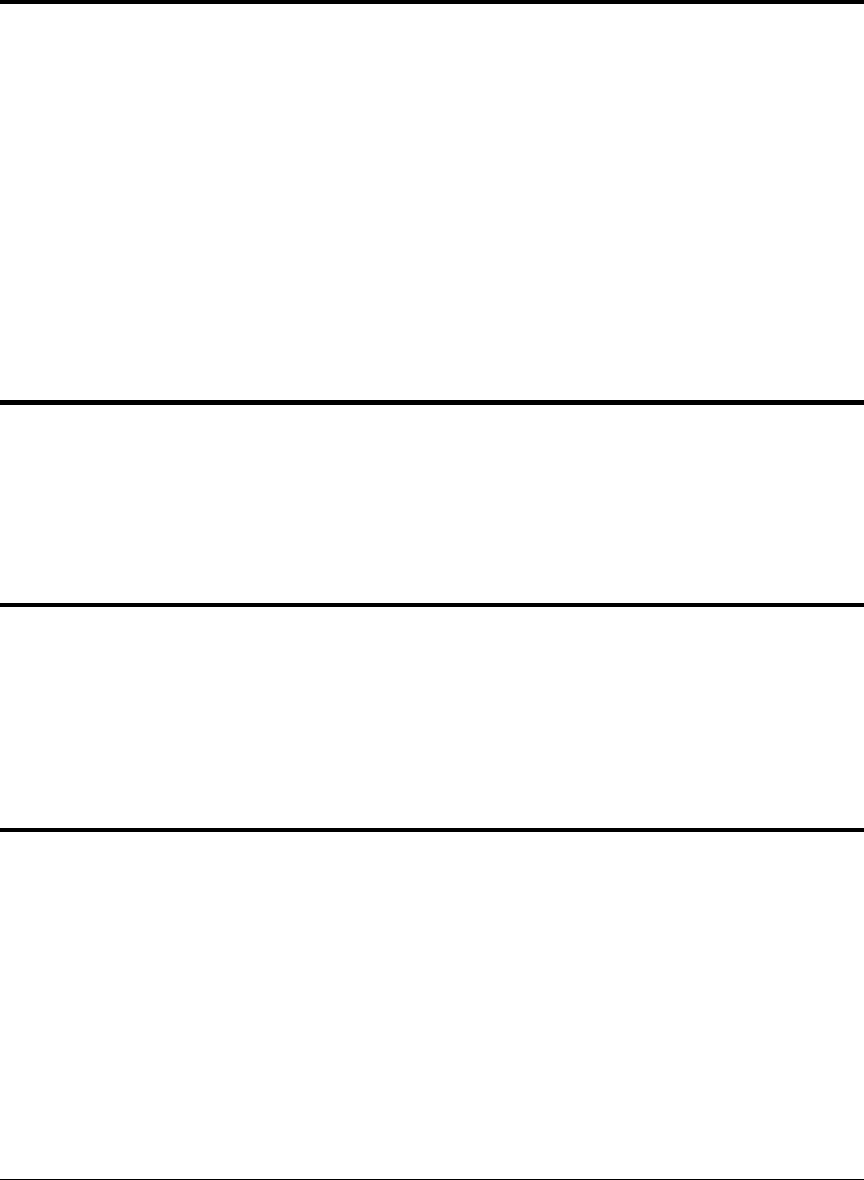
Velox LE Installation and Operations Manual
862-02411 February 04 1-1
Chapter 1 : About this Manual
Welcome
The Velox LE license exempt range (2.4GHz and 5.8GHz) incorporates world leading
performance, carrier class reliability and rapid deployment capability. The range is
specifically designed to allow network and service providers to minimize time and cost
to market while maximizing reach and revenue.
The Velox LE product range is a split-architecture radios system with two installation
options.
• All Indoor option consisting of a DIU and IRFU both 1RU high and 19” rack
mountable.
• Indoor/Outdoor option consisting of a 1RU high 19” rack mountable DIU and a
mas t/pole mountable ORFU.
Purpose
This manual provides information on installing, commissioning and troubleshooting a
Velox LE Microwave Radio system. Technical descriptions are at module and system
level.
Intended Audience
The information in this manual is f or use by trained technicians or engineers. It does not
provide information or instruction on basic technical procedures. Stratex Networks
recommends you read the relevant sections of this manual thoroughly before beginning
any installation or operational procedures on a Velox LE.
What You Need To Know
To install and commission a Velox LE, we recommend you have the following
knowledge and skills:
• A basic understanding of the principles of microwave transmission
• Installation and maintenance experience on digital and radio frequency systems
• Competent in the use of a PC running a Windows operating system

About this Manual
1-2 862-02411 February 04
Organization
Chapter 1 – About this Manual
Chapter 2 – Planning
Chapter 3 – Controls, Indicator s and Connectors on DIU
Chapter 4 – Hardware Installation
Chapter 5 – NCT Installation
Chapter 6 – PC Set-up
Chapter 7 – Maintenance and Radio Upgrades
Chapter 8 – Technical Information
Chapter 9 – Product Range/Product Matrix
Chapter 10 – Ordering Information
Chapter 11 – Domain/Network Management
Chapter 12 – 1+1 Protection System Operation
Chapter 13 – FAQ
Index
Associated Documents
The documents identified below contain additional information to assist in installing,
commissioning and troubleshooting a Velox LE:
• Stratex Networks Microwave Radio System Standard Practices Guide (PN 260-
668029-001).
• Protection Kit User Manual (PN 862-02236). Contains information on the 1+1
Redundancy Protected Payload System.
Conventions and Terminology
Graphical Cues
The following icons function as graphical cues used to characterise particular types of
associated supporting information:
!
CAUTION
This is a caution tip table.
Cautions point out procedures that you must follow p recisely to avoid damage to
equipment, loss of data, or corruption of files in software applications.

Velox LE Installation and Operations Manual
862-02411 February 04 1-3
cc
!
WARNING
This is a warning tip table.
Warnings point out procedures that you must follow precisely to avoid injury to
yourself or others.
This is an idea tip table.
An information icon denotes additional information on a current topic.
This is a note tip table.
A note icon denotes additional information you may require to complete the
procedure or understand the function
Abbreviations
Abbreviations used in this manual are listed below.
Assy Assembly
BW Bandwidth
BIT Built-in -Test
AIS Alarm Indication Signal
PER Packet (or Block) Error Rate
DC Direct Current
DCE Data Communications Equipment
DIU Digital Indoor Unit
DRL Digital Radio Link
DRS Digital Radio Station
DTE Data Terminal Equipment
EIRP Equivalent Isotropically Radiated Power
GUI Graphical User Interface
IP Internet Protocol
IRFU Indoor Radio Frequency Unit
ISM Industrial, Scientific and Medical
LED Light Emitting Diode
LOS Loss of signal
Mbps Megabits per second
MIB Management Information Base
Max Maximum
Min Minimum
NC Normally-closed
NO Normally-open
NCT Network Configuration Tool
ORFU Outdoor Radio Frequency Unit
PC Personal Computer
PPP Point-to-Point Protocol
RF Radio Frequency
RFU Radio Frequency Unit (Prefix I or O for Indoor or Outdoor type)

About this Manual
1-4 862-02411 February 04
RSL Received Signal Level
RSSI Received Signal Strength Indication
RU Rack Unit
SR Scaleable Radio
SNMP Simple Network Management Protocol
Trib Tributary
Support
Stratex Networks has a global network of support personnel located at our regional
offices. The telephone numbers and e-mail addresses of the support personnel
concerned are listed below:
Global Technical Support Manager
Tel: +44 1698 717 203
Fax: +44 1698 717 217
E-mail: dmcglasupport@dmcwave.com
EMEA Technical Helpdesk
DMC Stratex Hamilton UK
Tel: +44 1698 717 203 (o/h)
Fax: +44 1698 717 217
E-mail: dmcglasupport@dmcwave.com
Americas Technical Helpdesk
DMC Stratex San Jose
Tel: +1 408 943 0777 (International) (o/h)
Tel: +1 408 944 3565 (International) (o/h)
Tel: +1-800 362 9283 (US Toll Free) (o/h)
E-mail: SJ_techsupport@stratexnet.com
Asia Pacific Technical Helpdesks
DMC Stratex Clark
Tel: +63 45 599 5192 (o/h)
E-mail: DMC AP SUPPORT@dmcwave.com
DMC Stratex Wellington

Velox LE Installation and Operations Manual
862-02411 February 04 1-5
Tel: +64 4 569 2170 (o/h)
E-mail: DMCNZSUPPORT@dmcwave.com .

Velox LE Installation and Operations Manual
862-02411 February 04 2-1
Chapter 2 : Planning
Introduction
This chapter is aimed at management and planning staff to enable them to assess the
requirements for installing a Velox LE digital radio link.
System Type Selection
The Velox LE 2400, Velox LE 5800, Velox LE 2410 SR, Velox LE 5810 SR, Velox LE
24 10 SRi and Velox LE 5810 SRi are ISM band digital radio systems that provide short
to medium range, point -to-point digital communication with high data security at rates
of T1, 2T1 or 4T1. Alternatively, the radio can be software configured to convey E1,
2E1 or 4E1. The radio can also be configured to bridge or route IP traffic via a 10Base-
T port. The data rates scale depending on the number of enabled T1/E1 tributaries and
whether the data is being bridged or routed. The products make use of spread sp ectrum
technology and may be operated license-free in the 2.4 GHz and 5.8 GHz ISM bands.
The Velox LE 2425 SR, Velox LE 5825 SR, Velox LE 2425 SRi, Velox LE 5825 SRi,
Velox LE 2450 IP, Velox LE 5850 IP, Velox LE 2450 IPi, Velox LE 5850 IPi, Velox
LE 2450 SR, Velox LE 5850 SR, Velox LE 2450 SRi and Velox LE 5850 SRi are
similar radios also operating in the 2.4 and 5.8 GHz ISM bands respectively.
Modulation can be switched between 16 and 32 QAM with digital output scalable up to
16 T1/E1 tributaries depending on the specific radio.
The Velox LE digital radio system is aimed at FCC regulated markets. Each radio in the
system consists of two main parts:
• A Radio Frequency Unit (RFU) operating in the 2.4 GHz or 5.8 GHz ISM
frequency bands. The RFU has an N-type female connector for connection to a
range of antennas and can either be and Outdoor RFU (ORFU) or and Indoor RFU
(IRFU).
RFU units available are the Velox LE 2410, Velox LE 5810, Velox LE 2410i,
Velox LE 5810i, Velox LE 2450, Velox LE 5850, Velox LE 2450i and Velox LE
5850i units. The models with an “i” suffix are 1RU high IRFUs. See RFU Variants
on page 9-1 for further information.
• A Digital Indoor Unit (DIU), available with a Telecommunications interface (0 to
16 T1/E1 tributaries depending on the radio) and a Data interface (10Base-T
Ethernet or 10/100Base-T Ethernet, depending on the radio).
DIU units available are the Velox LE 75/120 Ohm, Velox LE 120 Ohm, Velox LE
10, Velox LE 25 and Velox LE 50 un it. All DIUs operate with the Velox LE
2410/2410i and Velox LE 5810/5810i RFUs. Velox LE 10, 25 and 50 DIUs can
operate only with the Velox LE 2450, 5850, 2450i and 5850i RFUs. With the
exception of the Velox LE 75/120 Ohm and Velox LE 120 Ohm units the number
is a guide to the maximum data capacity of the unit. For example, the maximum
data capacity of the Velox LE 25 is 25 Mbps. DIU Variants on page 9-1.
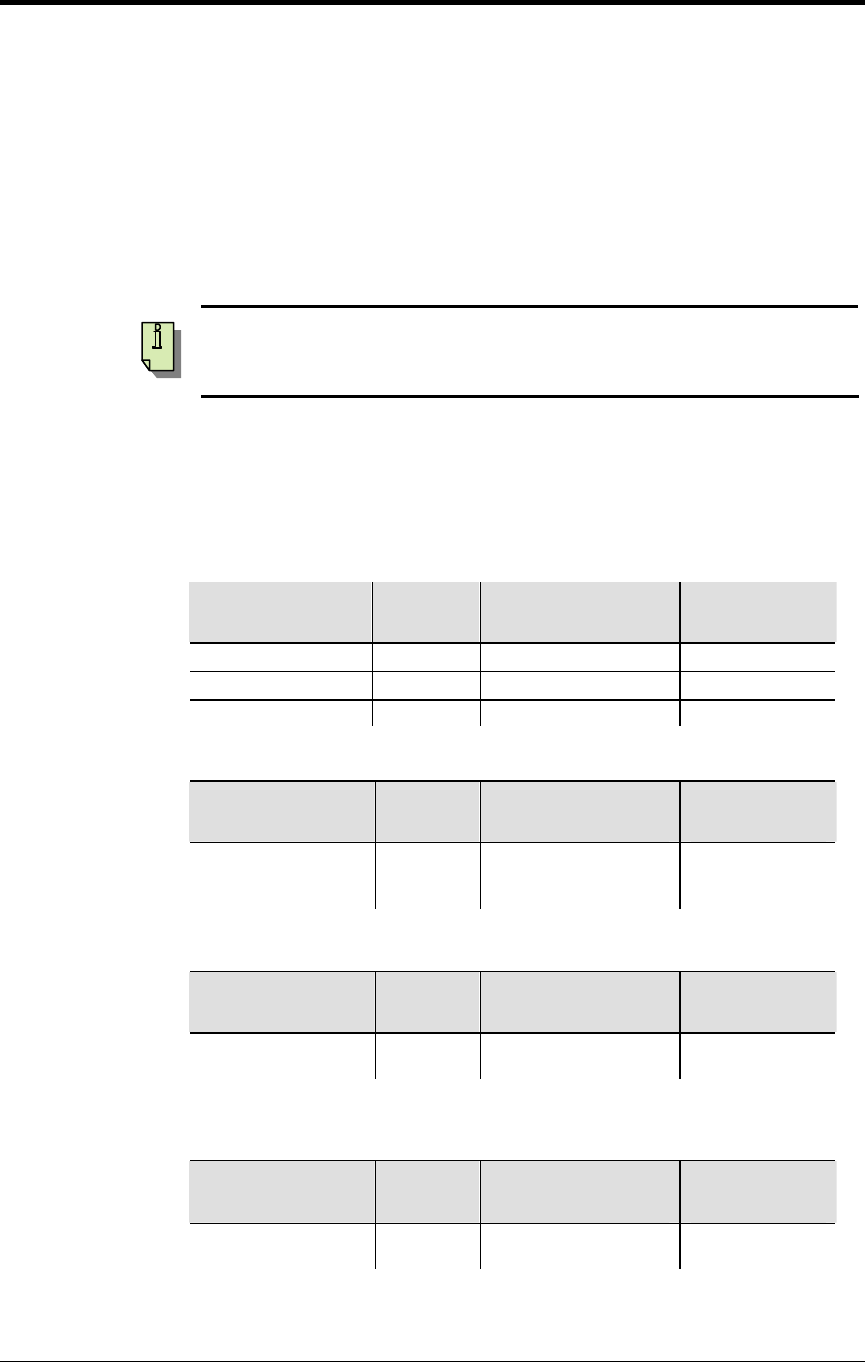
Chapter 2. Planning
2-2 862-02411 February 04
Antenna Selection
General
The antenna type must be selected before the system is installed. The chosen antenna
must enable the system to operate with sufficient link fade margin without excessive
cost and allow the user’s ‘link availability requirements’ to be met. The main
consideration when selecting an antenna is antenna gain measured in dBi. A path loss
analysis is highly recommended to determine the antenna gain needed for adequate fade
margin.
Refer to the Link Planner spreadsheet (LinkPlanner.xls) on the supplied CD for
assistance with planning the link and antenna gain selection.
The Table 2-1 below shows antenna selection guidelines for some configurations. The
distances are calculated for a 20 dB link fade margin. To reduce potential radio
interference to other users, the antenna type and its gain should be chosen so that the
equivalent isotropically radiated power (EIRP) is not more than that required for
successful communication.
Table 2-1. Velox LE 5810 Antenna Selection
Antenna Type Gain (dBi) Velox LE RFU Typical
Distance (Km) Power level
(dBm)
0.15 m Flat panel 18 9 24
0.3 m Flat panel 24 30 24
0.6 m Flat panel 28 80 24
Table 2-2. Velox LE 5810i Antenna Selection
Antenna Type Gain (dBi) Velox LE RFU Typical
Distance (Km) Power level
(dBm)
Gabriel Parabolic
Antenna
(SSP 52B)
29 80 25
Table 2-3. Velox LE 5850 and Velox LE 5850i Antenna Selection
Antenna Type Gain (dBi) Velox LE RFU Typical
Distance (Km) Power level
(dBm)
0.6 m Flat panel (MT -
20004) 28 80 24
Table 2-4. Velox LE 2410, Velox LE 2410i, Velox LE 2450 and Velox LE
2450i Antenna Selection
Antenna Type Gain (dBi) Velox LE RFU Typical
Distance (Km) Power level
(dBm)
1.2 m Parabolic
Antenna 27 80 18
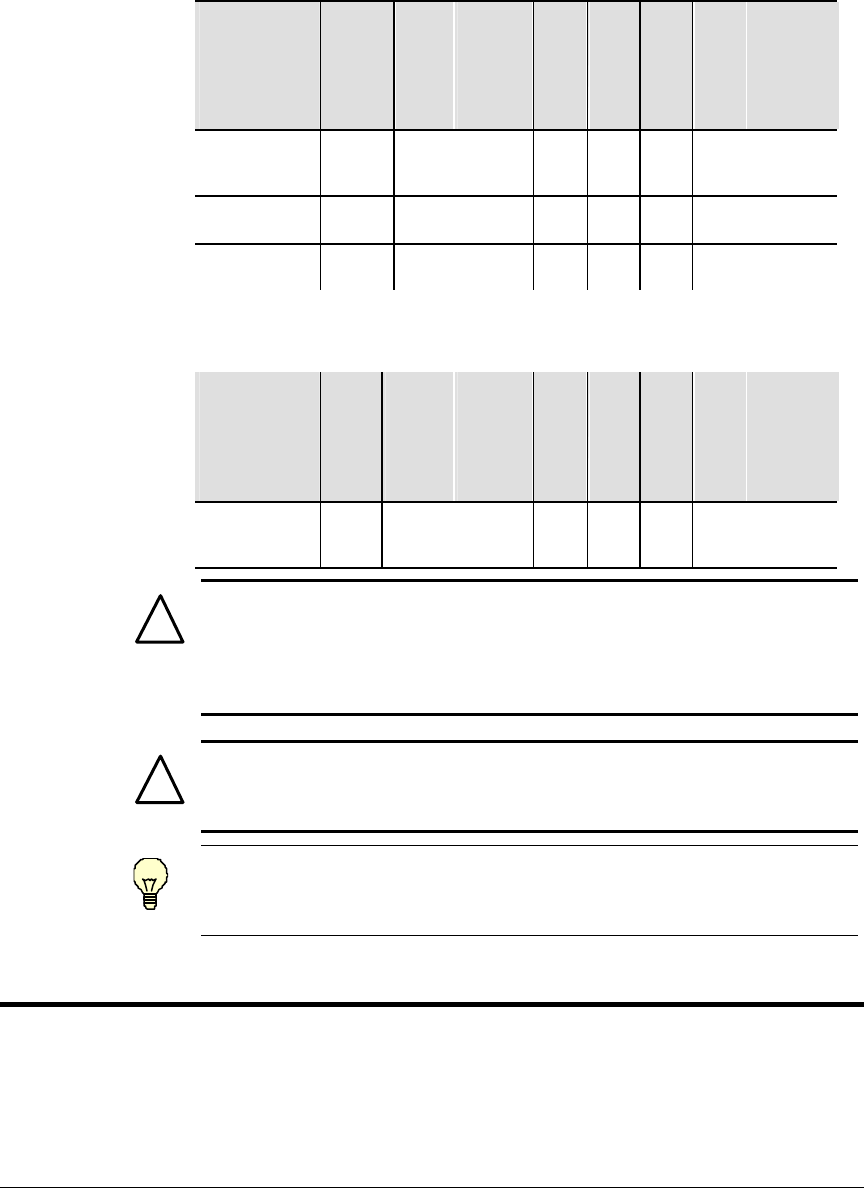
Velox LE Installation and Operations Manual
862-02411 February 04 2-3
Fixed Antennas
The tables below identify the distances where the 1mW/cm2 exposure limits may be
exceeded during continuous transmission using the proposed fixed antennas.
Table 2-5. Velox LE 5810, Velox LE 5810i, Velox LE 5850 and Velox LE
5850i
Product
Manufacturer
Type
Model
Gain (dBi)
Numeric gain
Peak Power
(mW)
Calculated
Distance (m)
Minimum RF
Exposure
Separation
Distance (m)
Velox LE 5800
Velox LE 5810i
Velox LE 5850
Gabriel Dish SSP2 52B
29.0 794.3
239.9
1.2 2
Velox LE 5800 Gabriel Flat
panel DFPD1-
52 23.9 245.5
239.9
0.7 2
Velox LE 5800
Velox LE 5850 MTI Flat
panel MT-
20004 28.0 631.0
239.9
1.1 2
Table 2-6. Velox LE 2410, Velox LE 2410i,Velox LE 2450 and Velox LE
2450i
Product
Manufacturer
Type
Model
Gain (dBi)
Numeric Gain
Peak Power
(mW)
Calculated
Distance (m)
Minimum RF
Exposure
Separation
Distance (m)
Velox LE 2400
Velox LE 2410i
Velox LE 2450
Gabriel
Parabolic
SSG4-23 26.7 467.7 63 0.5 2
!
WARNING
WARNING: It is the responsibility of the professional installer to ensure that when
using the outdoor antenna kits in the United States (or where FCC rules apply), only
these antenna configurations shown in the table above are used. The use of any
antenna ot her than those listed is expressly forbidden in accordance to FCC rules
CFR47 part 15.204.
!
CAUTION
The Velox LE System should be installed and operated with fix-mounted antennas
that are located with a minimum separation distance of 2 meters (6.6 ft) or m ore
from all persons during normal operation to satisfy RF exposure requirements.
FCC Radiation Exposure Statement
This equipment complies with FCC radiation exposure limits set forth for an
uncontrolled environment when installed as directed.
Site Evaluation
When planning a site for a digital radio link, it is important that you take the operational
environment of the proposed site into account.
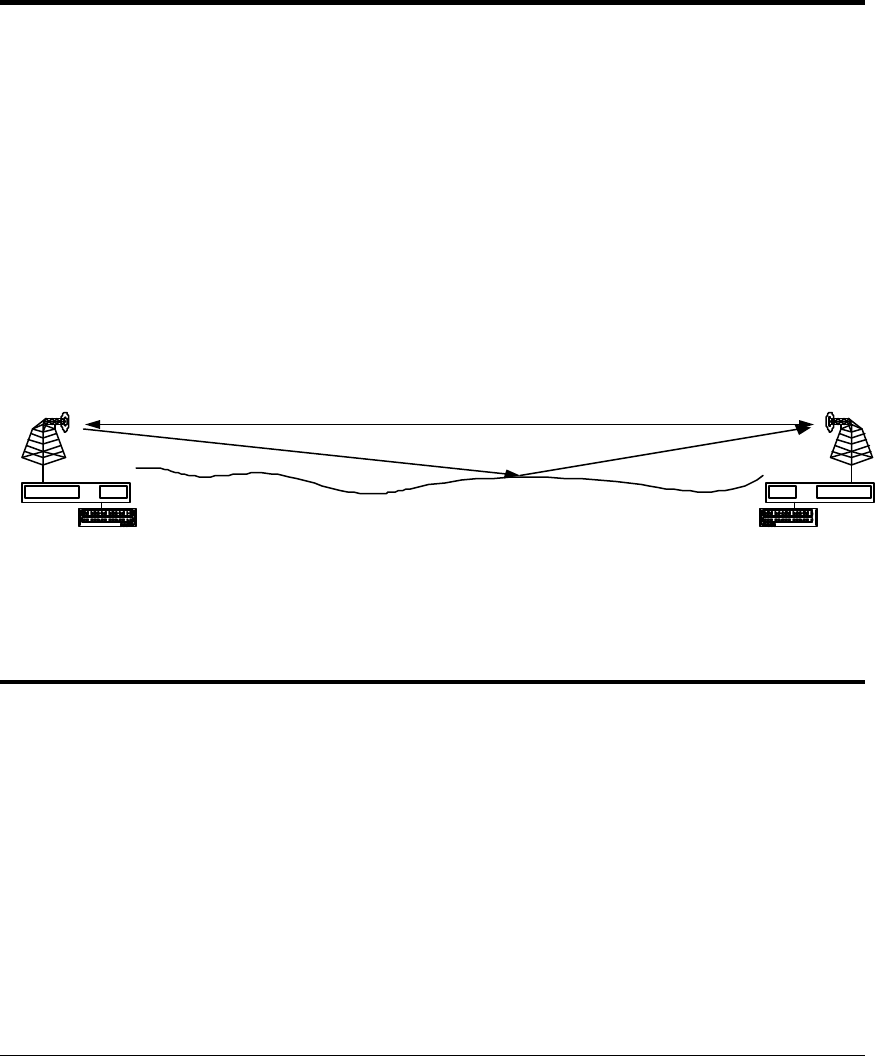
Chapter 2. Planning
2-4 862-02411 February 04
The combined effect of atmospher ic environmental factors such as rain and lightning,
atmospheric attenuation, signal path obstruction, propagation fading, air temperature
gradients, ice build-up, wind and solar radiation can contribute towards reducing the level
of performance of the system. The 2.4 GHz and 5.8 GHz bands are not adversely affected
by rain, ice or snow. Severely cold and excessively warm climatic conditions outside the
scope of the operating temperature range can affect the function of the system, especially
the outdoor equipment (see Environmental Characteristics on page 8-13 of this manual).
Wind force build-up and/or vibration of the mast-mounted equipment can affect the
antenna beam alignment and Outdoor equipment reliability. Ensure that mast used is
rigid enough to withstand the wind forces expected at the install location.
Multipath Effects
The effects of multipath propagation can influence the radio. Understanding these
effects will help when installing a radio link and maximize the reliability of the link.
Multipath fading occurs when the receiving antenna receives not only the direct signal
from the transmitting antenna but also a signal from the transmitting antenna that has
reflected off the ground or nearby obstacles. The reflected signal takes a longer path to
reach the receiver and acts as interference since it is not in-phase with the direct path
signal. The amplitude of the interference can be almost equal to that of the direct path
signal, thus degrading the performance of the link.
Multipath propagation is dependent on transmit frequency and the specific geometry of
the link such as antenna heights, distance between the antennas and the local terrain. To
counteract multipath propagation, the installer can change the frequency at which the
link operates or adjust the height of one or both of the antennas.
User Data
VELOX LE RFU
VELOX LE DIU
User Data
VELOX LE RFU
VELOX LE DIU
Direct RF Path
Reflection Path
Figure 2-1. Multipath Effects
Interference Considerations
Other devices that can cause interference to the Velox LE radio systems use the ISM
frequency bands. Interference can be avoided by careful planning of the system
installation. The available methods for providing isolation from interfering radiators
are the following:
• Frequency diversity
• Antenna polarization
It is recommended to scan the proposed installation areas with a spectrum analyzer prior
to installation to establish the presence of interference. The spectrum analyser feature
available on the NCT/GUI may also be used. If interference is detected on the path, the

Velox LE Installation and Operations Manual
862-02411 February 04 2-5
GUI, via laptop connection, can be used to select a new channel plan (A , B, or C) to
“steer” around the interferer, or to create a new custom channel plan (Plan D) to avoid
the interference. SNMP network architecture, if employed, may also be used to make
the frequency plan changes. The frequency spectrum should be scanned over a
sufficient time period to ensure that periodic transmissions are recorded.
Interferers will cause problems if their amplitudes are less than 20 dB below the
intended receive power level. A link path loss calculation should be performed to
determine the expected receive power level.
The procedure for selecting the optimum antenna polarization and system frequency
plan is the following:
• Perform a spectral analysis at each site in the link direction using a high gain
antenna.
• Repeat the spectral analysis for vertical and horizontal antenna polarization.
• Select the polarization with the lowest interfering levels as the system antenna
polarization.
• Consult the Velox LE frequency channel plans (see Frequency Plans on page 8-5)
and select the frequency plan that would operate in an interference-free band.
• Install the ‘High Band’ and ‘Low Band’ RFUs at the sites where they would
experience the lowest interference in their respective receive bands.
Microcell Backhaul Applications of Velox LE Digital
Radios
General
In applications where more than one independent and separate links, need to radiate
from a central site a number of parameters can be taken advantage of to provide
isolation and minimize interference between these links:
• Frequency multiplexing
• Antenna polarization
• Choice of High Antenna Gain
It is important to note that these methods only provide isolation between two radio
Systems, and that power levels in the separate systems should be balanced to ensure
correct operation (see Transmitted Power Levels below).
Transmitted Power Levels
To minimize interference, received power levels should be balanced between separate
radio links. This means that transmit power levels should be set to provide similar levels
of received power, as indicated by the RSSI values of the adjacent receivers at the
central site. Power levels are easily adjusted via point and click selection utilising the
provided NCT / GUI, installed on your laptop or via SNMP network architecture.

Chapter 2. Planning
2-6 862-02411 February 04
Frequency Multiplexing
The Velox LE 2410, Velox LE 2410i, Velox LE 2450 and Velox LE 2450i each offer
three frequency channel plans, while the Velox LE 5810, Velox LE 5810i, Velox LE
5850 and the Velox LE 5850i offer four frequency channel plans. Refer to Frequency
Plans on page 8-5 for more detail on the frequency channel plans. A radio link requires
two channels (one for transmit and one to receive) to provide full duplex operation.
Each radio has a high and a low sub-band, one that it uses for transmission and another
for reception. Terminology definition: the ‘High -band RFU’ of a system transmits on
the higher of the two sub-bands. The ‘Low-band RFU’ of a system transmits on the
lower of the two sub-bands. A system (link) always has one High Band and one Low
Band RFU. It is important to note that unwanted transmitted signals in adjacent
frequency bands can affect other receivers operating in an adjacent band if insufficient
antenna isolation is provided. A solution is to group high-band or low-band RFUs at the
central site, rather than group high and low-band RFUs together.
Antenna Isolation
Separate links at a central site will have sufficient isolation when radio systems operate
outside the radiation beam width or side lobes of the system antenna. The achievable
isolation can be established by examining the measured radiation patterns of the system
antennas. Directional isolation can be used if the antenna radiation is 15 dB or lower
relative to the adjacent main beam. Antennas with high directionality will allow
reduced angular separation of adjacent systems. Antenna cross-polarization isolation
can be used for adjacent radio links, radiating in the same direction. Typical isolation
of 30 dB can be achieved using high quality antennas.

Velox LE Installation and Operations Manual
862-02411 February 04 3-1
Chapter 3 : Controls, Indicators and
Connectors on the DIU and RFU
Introduction
This Chapter describes the Controls, Indicators and Connectors available of the various
versions of the DIU and RFU (Indoor and Outdoor).
The DIU is designed for mounting in a 19” rack, occupying a 1RU slot. It can also be
used as a tabletop system. The DIU accepts n x T1/nE1 user payload channels and
combines it with Wayside Service Serial Data and IP data to be transmitted across the
radio link.
The ORFU is pole mounted with its antenna whereas the IRFU is designed for 19” rack
or table top mounting and is remote from the antenna.
Control, Indicators and Connectors on the DIU
General
The DIUs available are listed below together with cross-references to the applicable
front panel and back panel illustrations.
• Velox LE (120 Ohm version) (scalable up to 4 T1/E1), (see Figure 3-1 below and
Figure 3-3 on page 3-2).
• Velox LE (75/120 Ohm version) (scalable up to 4 T1/E1), (see Figure 3-2 on page
3-2 and Figure 3-3 on page 3-2).
• Velox LE 10 DIU (scalable up to 4 T1/E1) (see Figure 3-4 on page 3-2. Note that
there are no controls, indicators or connectors on the back panel of this DIU).
• Velox LE 25 DIU (scalable up to 8 T1/E1), (see Figure 3-5 on page 3-2.Note that
there are no controls, indicators or connectors on the back panel of this DIU).
• Velox LE IP DIU (with optional 16 T1/E1 interface card), (see Figure 3-6. Velox
LE IP DIU Front Panel with Payload Interface Panel on page 3-3. Note that there
are no controls, indicators or connectors on the back panel of this DIU).
• Velox LE 50 DIU, (see Figure 3-7 on page 3-3. Note that there are no controls,
indicators or connectors on the back panel of this DIU).
The number in brackets following each heading is the number identifying the
control, indicator or connector on the front/back panel illustration.
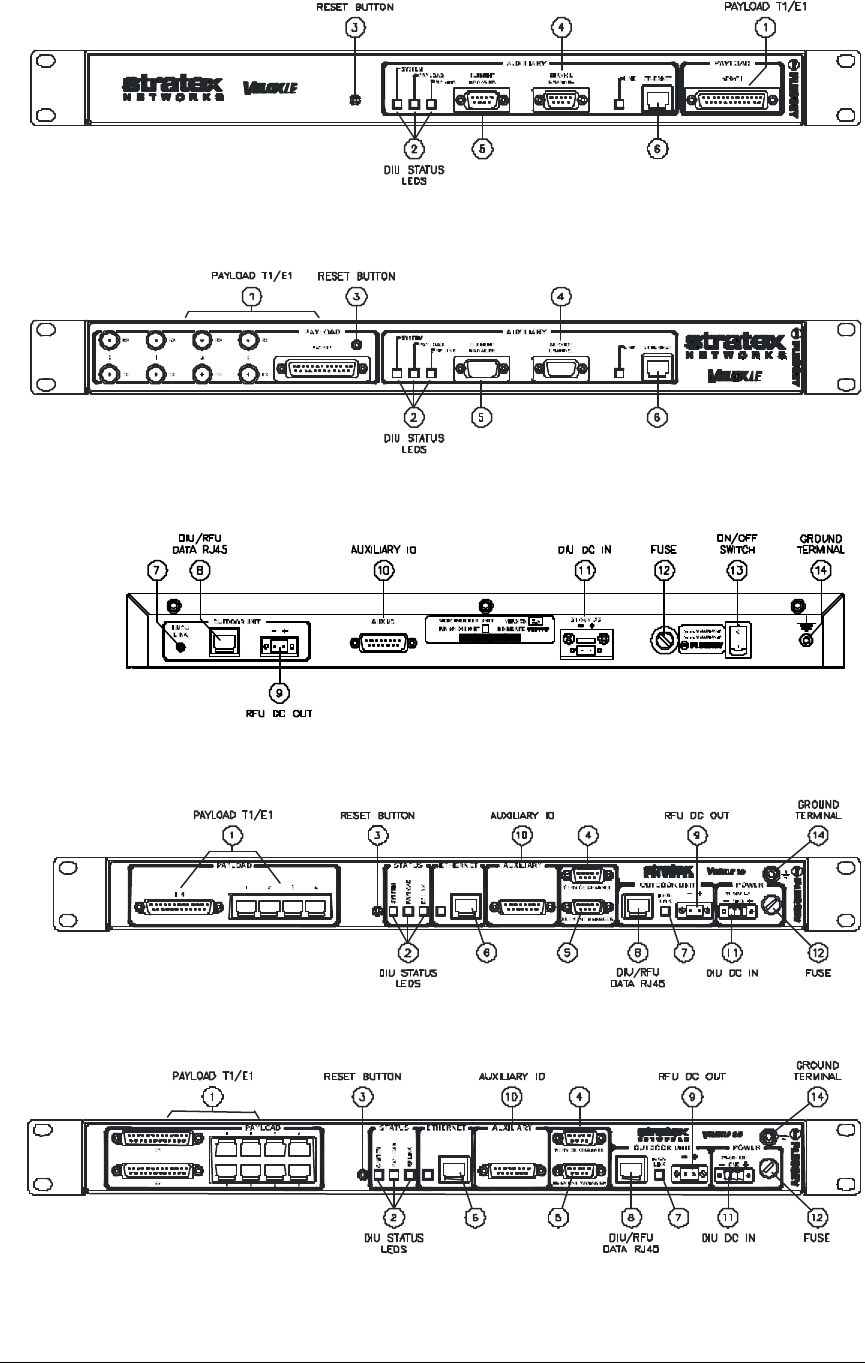
Chapter 3. Controls, Indicators and Connectors on the DIU
3-2 862-02411 February 04
10BASE-T RJ45
CONNECTOR
ELEMENT
MANAGER
SERVICE CHANNEL
Figure 3-1. Velox LE DIU 120 Ohm Front Panel
10BASE-T RJ45
CONNECTOR
ELEMENT
MANAGER
SERVICE
CHANNEL
Figure 3-2. Velox LE 75/120 Ohm DIU Front Panel
Figure 3-3. Velox LE 75/120 OHM DIU Back Panel
10BASE-T
RJ45 CONNECTOR
ELEMENT
MANAGER
DIU/RFU
LINK
SERVICE
CHANNEL
Figure 3-4. Velox LE 10 DIU Front Panel
10BASE-T
RJ45 SOCKET
ELEMENT
MANAGER
DIU/RFU
LINK
SERVICE
CHANNEL
Figure 3-5. Velox LE 25 DIU Front Panel
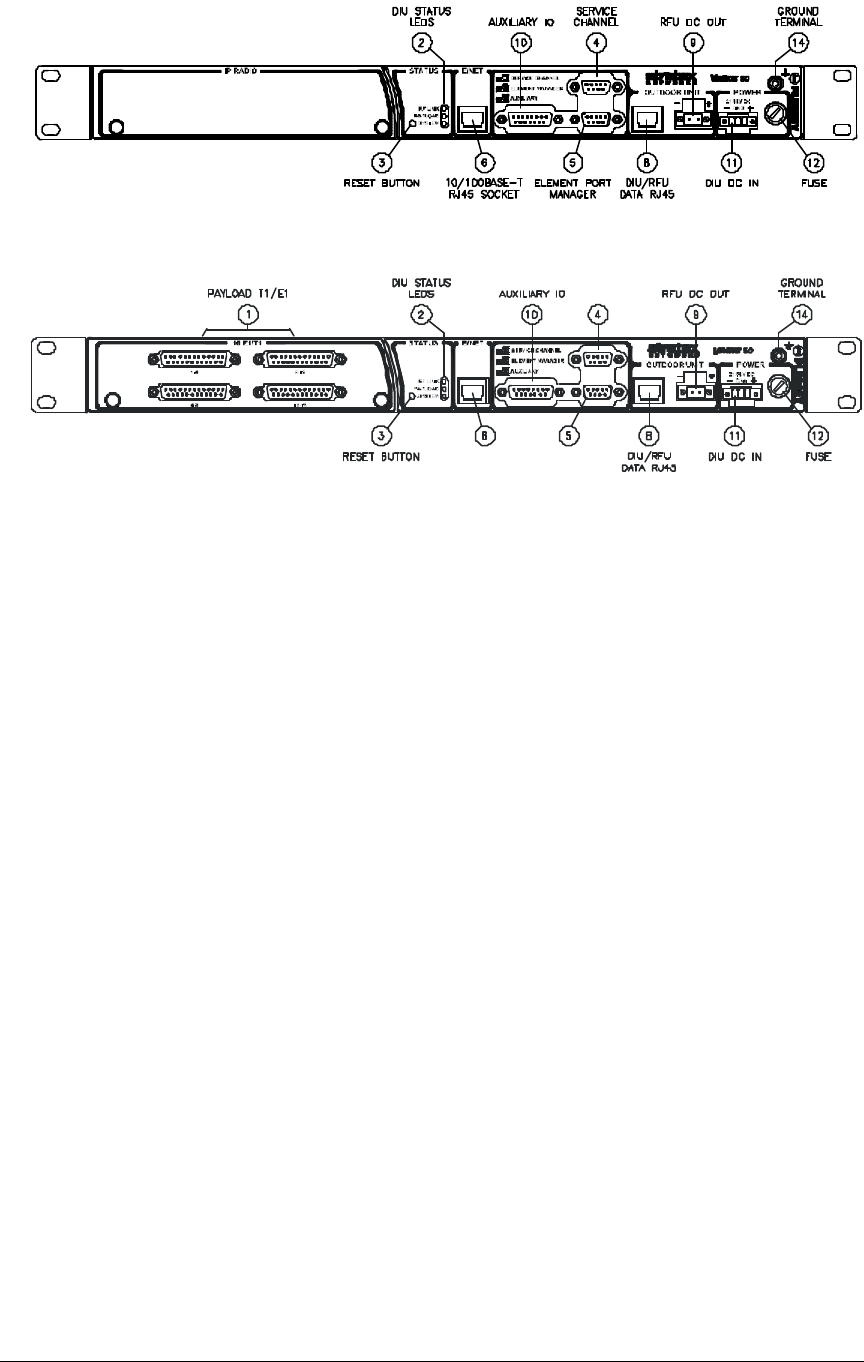
Velox LE Installation and Operations Manual
862-02411 February 04 3-3
Figure 3-6. Velox LE IP DIU Front Panel with Payload Interface Panel
10/100BASE-T
RJ45 SOCKET ELEMENT PORT
MANAGER
SERVICE CHANNEL
Figure 3-7. Velox LE 50 DIU Front Panel with Payload Interface Panel
Payload T1/E1 Connectors (1)
General
The payload can be connected on:
• Unbalanced 75 Ohm BNC connectors, 75/120 Ohm DIU only (RX= In, TX= Out).
• Balanced 120 Ohm, 25 way D-type connectors (see Table 3-1 on page 3-4 for the
pin-outs). Standard termination on the Velox LE 10 and Velox LE 25.
• Unbalanced 75 Ohm, 25 way D -type connectors (see Table 3-2 on page 3-4 for the
pin-outs). Optional termination, which on the Velox LE 10 and Velox LE 25 units
must be requested from the supplier when ordering the system.
• Balanced 120 Ohm, RJ48C connectors on the Velox LE 10 and Velox LE 25 (see
Table 3-3 on page 3-6 for the pin-outs). Standard termination on the Velox LE 10
and Velox LE 25, user configurable on the Velox LE 50.
• Unalanced 75 Ohm, RJ48C connectors on the Velox LE 10 and Velox LE 25 (see
Table 3-3 on page 3-6 for the pin-outs). Optional termination, which on the Velox
LE 10 and Velox LE 25 units must be requested from the supplier when ordering
the system and is user configurable on the Velox LE 50.
25-Way D-type Connections (Balanced 120 Ohm, Unbalanced 75
Ohm)
Balanced 120 Ohm and unbalanced 75 Ohm termination via 25 -way D-type connectors
are available on all Velox LE DIUs. The standard termination is 120 Ohms on all DIUs.
Unbalanced 75 Ohm is an optional termination, which on the Velox LE 10 and Velox
LE 25 units must be requested from the supplier when ordering the system and is user
configurable on the Velox LE 50.

Chapter 3. Controls, Indicators and Connectors on the DIU
3-4 862-02411 February 04
In Table 3-1 Rx means that signal goes INTO the interface), Tx means that the
signal is coming out of the interface.
Tributaries 1-4 are connected on D1 on the Velox LE 120 Ohm, Velox LE 75/120 Ohm,
Velox LE 10 and Velox LE 25 DIU. In a similar fashion tributaries 5-8 are connected
on D2 for the Velox LE 25 radio, that is pin 2 = RTIP6, pin 10 = RTIP5 and so on.
This pattern is repeated for Tributaries 9 – 16 on connectors D3 and D4 for the Velox
LE 50 16 E1/T1 payload interface card.
The pin connections are shown in the following tables:
• Table 3-1 on page 3-4 for balanced 120 Ohms termination.
• Table 3-2 on page 3-4 for unbalanced 75 Ohm termination.
Table 3-1. Pin Connections for Balanced 120 Ohm Termination on 25-
Way D-Type Connector
D-Type Payload Data
Connector Pin # Pin Name Tributary Direction
1 GND / Earth N/A
2 RTIP2 2 RX +
3 RRING2 2 RX -
4 GND / Earth N/A
5 TTIP2 2 TX -
6 TRING2 2 TX +
7 GND / Earth N/A
8 GND / Earth N/A
9 RRING1 1 RX +
10 RTIP1 1 RX -
11 GND / Earth N/A
12 TRING1 1 TX -
13 TTIP1 1 TX +
14 TRING3 3 TX -
15 TTIP3 3 TX +
16 GND / Earth N/A
17 RRING3 3 RX+
18 RTIP3 3 RX -
19 GND / Earth N/A
20 TTIP4 4 TX-
21 TRING4 4 TX+
22 GND / Earth N/A
23 RTIP4 4 RX+
24 RRING4 4 RX -
25 GND / Earth N/A
Table 3-2: Pin Connections for Unbalanced 75 Ohm Termination on 25 -Way
D-Type Connector

Velox LE Installation and Operations Manual
862-02411 February 04 3-5
D-Type Payload
Connector Pin # Pin Name Tributary Direction Remarks
1 Rx GND/Earth N/A
2 RTIP2 2 RX +
3 RRING2 2 RX - Connect to Pin 1
4 Tx GND/Earth N/A
5 TTIP2 2 TX - Connect to Pin 4
6 TRING2 2 TX +
7 GND/Earth N/A
8 Rx GND/Earth N/A
9 RRING1 1 RX +
10 RTIP1 1 RX - Connect to Pin 8
11 Tx GND/Earth N/A
12 TRING1 1 TX - Connect to Pin 11
13 TTIP1 1 TX +
14 TRING3 3 TX - Connect to Pin 16
15 TTIP3 3 TX +
16 Tx GND/Earth N/A
17 RRING3 3 RX+
18 RTIP3 3 RX- Connect to Pin 19
19 Rx GND/Earth N/A
20 TTIP4 4 TX-
21 TRING4 4 TX+ Connect to Pin 22
22 Tx GND/Earth N/A
23 RTIP4 4 RX+
24 RRING4 4 RX- Connect to Pin 25
25 Rx GND/Earth N/A
RJ48 Connections(Balanced 120 Ohm and Unbalanced 75 Ohm )
Balanced 120 Ohm and unbalanced 75 Ohm termination via RJ48 connectors are
available on the Velox LE 10 and Velox LE 25 DIUs. The standard termination is 120
Ohms on both DIUs. Unbalanced 75 Ohm is an optional termination, which must be
requested from the supplier when ordering the system
Although RJ48 Payload connectors are available on only the Velox LE 10 and
Velox LE 25 DIUS, RJ48 connections on the Customer interface can be connected
to the DB25 payload connector on the Velox LE 120 Ohm and 75/120 Ohm units
using the 4 E/T Spider Cable 660-03678, which is supplied as part of the
Accessories kit .
The pin connections for balanced 120 Ohms termination Table 3-3 on page 3-6.
For unbalanced 75 Ohm terminations, pins 2 and 5 should be connected to ground. For
this connection we recommend using a shielded cable together with RJ-48 shielded
connector. If this connector is used, pins 2 and 5 can be connected to the connector
body, which is grounded via the connector body of the mating RJ-48 connector on the
DIU.

Chapter 3. Controls, Indicators and Connectors on the DIU
3-6 862-02411 February 04
Table 3-3. Pin Connections for Balanced RJ48 Connectors on Velox LE,
Velox LE 10 and Velox LE 25 DIUs
RJ48C Socket Pin Description Direction
1 TRING1 TX+
2 TTIP1 TX-
3,6
4 RRING1 RX+
5 RTIP1 RX-
1 8
1 8
7,8 No Connection N/A
Rx means that signal goes INTO the interface, Tx means that the signal is coming
out of the interface.
Use Twisted Pair Cable conductors for pins: 1 & 2, 3 & 6 and 4 & 5.
Unbalanced Payload Data (BNC) (Velox LE 75/120 Ohm Only)
On the Velox LE 75/120 Ohm there are eight 75 Ohm BNC connectors on the front
panel in addition to the DB25 connector, as follows:
• Four Rx connectors - Rx means that the signal goes INTO the interface
• Four Tx connectors - Tx means that the signal is coming OUT of the interface.
Note that Tributaries are numbered 0 to 3 on the front panel of the DIU, but are
identified 1-4/1-8 in the NCT Graphical User Interface (GUI).
DIU Status Diodes (2)
There are three LEDs on the front panel all DIU variants. Their purpose is as follows:
SYSTEM - Green OK, Orange (RFU/DIU Comms Error), Red (RFU/DIU Comms
Down)
PAYLOAD - Green OK, Orange (AIS Detected), Red (LOS Detected), Black (No
T1/E1, DS3/E2 payload.
RF LINK - Green OK, Orange (FEC Correcting Errors), Red (FEC unable to correct
errors)
In ALL cases flashing red and orange LEDs imply historic alarm conditions (The alarm
can be cleared using the Reset Button ‘position 1’ (1 -reset).
Clicking on the “Clear Alarms” button in the Velox LE NCT Main Radio Window will
clear flashing LED’s and yellow indicators (Velox LE NCT).

Velox LE Installation and Operations Manual
862-02411 February 04 3-7
Steady Orange or Steady Red LEDs indicate a fault condition. The fault condition and
the action required are given in Table 3-4 below.
Table 3-4. Interpretation of Status LEDs
LED Colour Interpretation Action
System RED There is a problem with the
communication to the RFU Check cables between DIU and RFU
RF Link RED Continually running bit errors on
tributaries If System LEDs are green then check
RFUs
Payload RED There is no Payload signal present (LOS)
on one or more tributaries Check connections to the BER Tester
System ORANGE There is a problem with the
communication to the RFU Check cables between DIU and RFU
RF Link ORANGE FEC is correcting errors – no problem No problem unless the LED stays
orange
Payload ORANGE The incoming payload signal is AIS Check BER tester
Reset/Configuration Button (3)
You use the Reset button in conjunction with the Status LEDs when configuring the
radio. The LED which is ON and its colour when the button is released determines the
function. When the Reset Button is pressed, the Status LEDs will light in sequence RF,
PAYLOAD and SYSTEM. The LED colour sequence while the button is pressed is
GREEN, ORANGE then RED and then GREEN again, i.e. the sequence will repeat.
The LED colours and their corresponding functions are listed in Table 3-5 below.
If while pressing the Reset Button you “lose” the count, continue pressing until all the
LEDs are out. The sequence is now complete and you can start again from position 1.
Throughout this manual, use of the Reset Button is indicated in text by the LED
sequence number followed by the word RESET. For example, LED sequence 1 (RF
LED GREEN) is indicated 1-RESET, LED sequence 5 (PAYLOAD LED ORANGE) is
indicated 5-RESET, etc.
Table 3-5. Reset Button Functions and Indications
Status LEDs Reset
Number
RF PAYLOAD SYSTEM
Function
1-RESET GREEN OFF OFF Clear Front Panel LEDs (and associated alarms in DIU)
2-RESET OFF GREEN OFF Clear Event Log in the DIU
3-RESET OFF OFF GREEN Reset the DIU (does not reset the non-volatile memory storing the
DIUs configuration parameters)
4-RESET ORANGE OFF OFF Default to Routed Configuration “FAR side” DIU: Reset the DIU
configuration parameters that are stored in non-volatile memory
(BATTERY-BACKED STATIC RAM) and configure as a ‘Far Side
DIU’: i.e. for a ROUTED IP configuration, set the Ethernet IP
address as 10.11.1.2, Element Manager IP address to 10.12.1.2. See
Note 1 below.
5-RESET OFF ORANGE OFF Default to Routed Configuration “NEAR side” DIU: Reset the DIU
configuration parameters that are stored in non-volatile memory and
configure as a ‘Near Side DIU’: i.e. for a ROUTED IP configuration
set the Ethernet IP address as 10.2.1.2, Element Manager IP address
to 10.13.1.2. See Note 1 below.
6-RESET OFF OFF ORANGE Default to Routed Configuration for the side currently configured: If
you are not sure how the DIU is configured (NEAR or FAR side
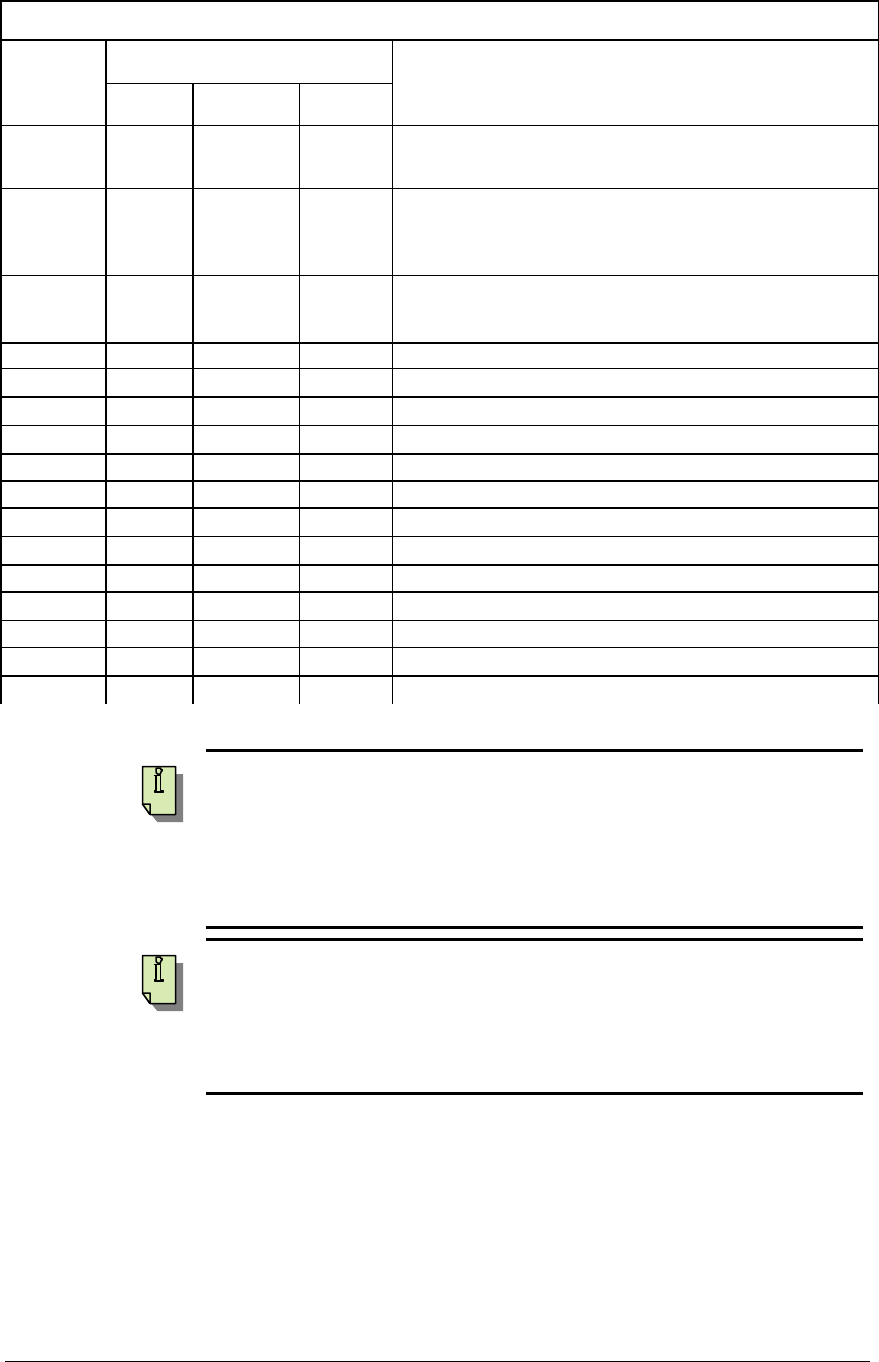
Chapter 3. Controls, Indicators and Connectors on the DIU
3-8 862-02411 February 04
Table 3-5. Reset Button Functions and Indications
Status LEDs Reset
Number
RF PAYLOAD SYSTEM
Function
DIU), reset it AS IS, i.e. reset the ‘Near Side DIU’ or ‘Far Side DIU’
configuration parameters depending on how the DIU is currently
configured. See Note 1 below.
7-RESET RED OFF OFF Default to Bridged Configuration “FAR side” DIU: Reset the DIU
configuration parameters that are stored in non-volatile memory
(BATTERY-BACKED STATIC RAM) and configure as a ‘Far Side
DIU’. See Note 1 below.
8-RESET OFF RED OFF Default to Bridged Configuration “NEAR side” DIU: Reset the DIU
configuration parameters that are stored in non-volatile memory and
configure as a ‘Near Side DIU’. See Note 1 below.
9-RESET OFF OFF RED RESERVED
10-RESET GREEN OFF OFF RESERVED
11-RESET OFF GREEN OFF RESERVED
12-RESET OFF OFF GREEN Set up DIU with E1 tribut aries.
13-RESET ORANGE OFF OFF Set up DIU with T1 tributaries.
14-RESET OFF ORANGE OFF Deactivate buttons 4 onwards.
15-RESET OFF OFF ORANGE Toggle SNMP and FTP Servers ON/OFF (V3.00+ firmware)
16-RESET RED OFF OFF DHCP ON (V3.00+ firmware)
17-RESET OFF RED OFF DHCP OFF (V3.00+ firmware)
18-RESET OFF OFF RED Ethernet MAC learning enabled via front panel
19-RESET GREEN OFF OFF Transparent Ethernet mode enabled via front panel
20-RESET OFF GREEN OFF E2prom erased via front panel (Velox LE Only)
21-RESET OFF OFF GREEN RFU back-to-back enable / disabled toggle via front panel
NOTE 1: The Bridged Configuration is the default configuration and is the preferred
configuration for most networks. For Routed Configuration, the allocation of
Ethernet IP Addresses is more complicated and requires specialist network
knowledge. For information on the IP Addresses used; refer to:
§ BRIDGED Configuration: Input Address Assignment on page 6-7 for Bridged
Net works.
§ ROUTED Configuration : Input Address Assignment on page 6-9 for Routed
Networks.
4-RESET, 5-RESET, 6-RESET, 7-RESET and 8-RESET reset the DIU to factory
defaults – these resets are typically only used once (these choices reset certain
adjustable parameters in non-volatile memory in the DIU). If changes are made to
the configuration parameters and the user does not want these to change when a unit
is reset, the DIU can be power-cycled or ‘3-RESET’ must be used. For example, this
technique is used if the IP addresses associated with the network interfaces are
adjusted – the processor needs to be reset to allow the change/s to be implemented.
Service (Wayside) Serial Data Channel (4)
This port supports asynchronous full duplex, serial data transfer across the link at a
speed of 115200 bps. Data via this channel does not interfere with the payload data
channels.

Velox LE Installation and Operations Manual
862-02411 February 04 3-9
The interface type is RS-232 configured as DCE (Data Communications Equipment).
Note that Handshaking can be "None."
Pin-outs for the Service Channel connector are given in Table 3-6 below.
Table 3-6. Service Channel Connector Pin-outs
DIU connector Pin No Signal
2 TD
3 RD
4 DTR
5 GROUND
6 DSR
7 RTS
9-pin D -type Female Connector
8 CTS
Element Manager Port (5)
This port is used for communication with the NCT software or with an SNMP manager
to control the Velox LE system. The port must be connected to a serial port (configured
for a speed of 115200 bps) on a personal computer to use the NCT software.
The interface type is RS-232 configured as DTE (Data Terminal Equipment).
Hardware handshaking is used.
10Base-T Ethernet RJ45 Port (10/100Base-T on Velox LE
50 DIU) (6)
This port is used for communications with the NCT/GUI software from a laptop/PC or
with an SNMP manger to control the system. It can also be connected to a hub for
10Base-T or 10/100Base-T wayside Ethernet throughput.
The interface type is DTE (Data Terminal Equipment) and can support Full and Half-
Duplex Ethernet connections. Select the Ethernet Duplex mode from the following
MIB element: 1.3.6.1.4.1.1316.1.1.1.4.16 MdrmteEthernetFullDuplex.
Take note that connecting the radio to an Ethernet hub requires the Ethernet interface to
operate in Half Duplex mode.
DIU/RFU Link LED (7)
Normal condition ON indicating that there is communication between the DIU and the
RFU. If it is OFF, check the Data Cable between the DIU and RFU.
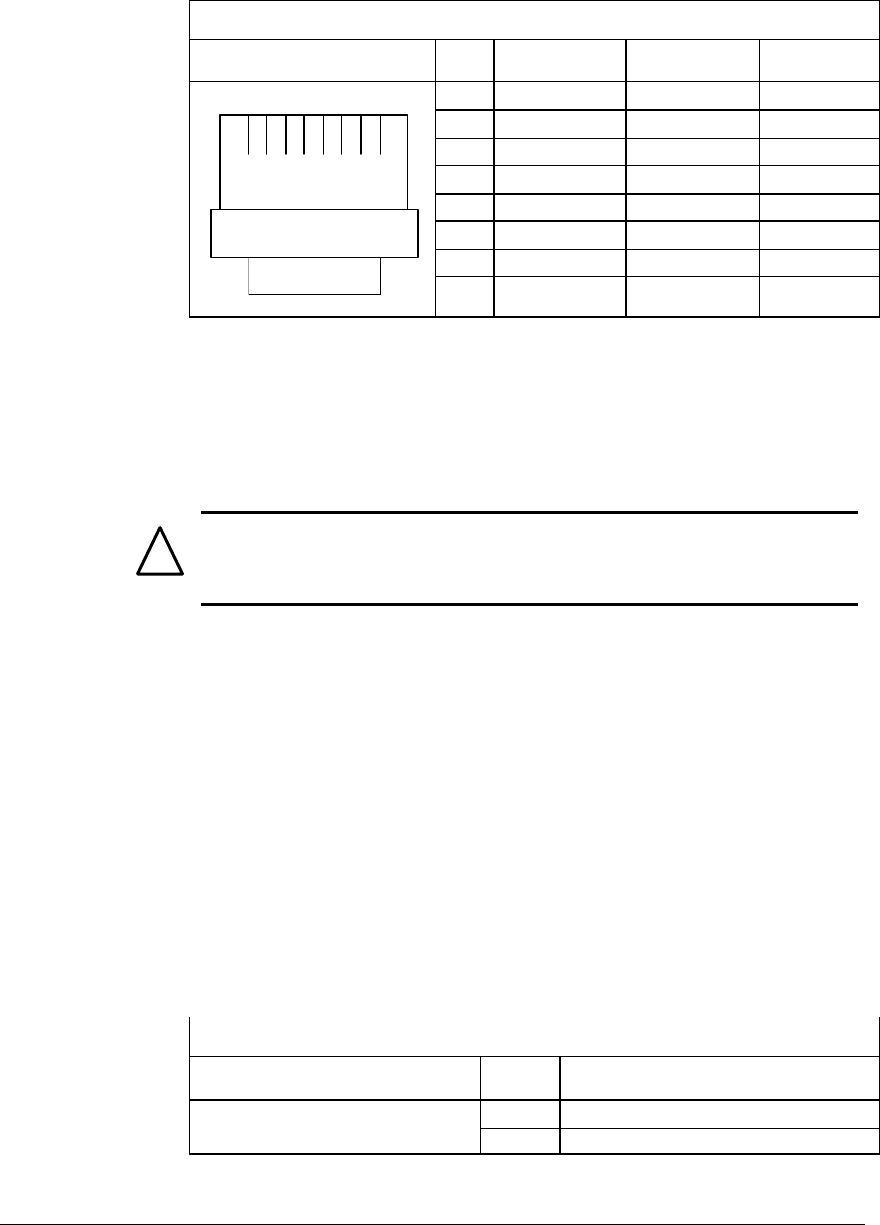
Chapter 3. Controls, Indicators and Connectors on the DIU
3-10 862-02411 February 04
DIU/RFU Data (8)
This receptacle accepts an RJ45 plug that connects to UV-protected STP (Screened
twisted pair) cable used between the DIU and the RFU. Pin-outs for the DIU/RFU Data
cable are given in Table 3-7 below.
Table 3-7. Pin-outs for DIU to RFU Data Cable
RJ45 Pin DTE (on DIU) DCE (on RFU) Wiring
1 TxD+ RxD- Orange/White
2 TxD- RxD+ White/Orange
3 RxD+ TxD+ Green/White
4 NC NC
5 NC NC
6 RxD- TxD- White/Green
7 NC NC
1 8
TOP VIEW (LOCKING
TAB UNDERNEATH)
8 NC NC
RFU DC Out (9)
This connector (socket) is used for power interconnection between the DIU and the
RFU. The connection is made using UV-protected 2-core cable. The cable is
connected to a GREEN, two-pin plug.
!
CAUTION
The polarity sense as labelled must be maintained between the DIU and the RFU.
Auxiliary I/O (10)
The auxiliary in/out port is used for remote monitoring and control. The following are
provided
• Two inputs (for sensing contact closure or opening) are provided to sense site
alarm inputs. The states of these alarm inputs can be monitored with NCT, as well
as from an SNMP Management Station.
• Two relays each with two outputs (one output with the contacts normally open and
the other with the contacts normally closed), are provided as alarm/auxiliary
outputs. Output states are software customised and controlled. The outputs are
used to indicate alarm or other states selected by the operator via the NCT or a
SNMP Management Station.
Pin-outs for the Auxiliary I/O connector are given in Table 3-8 below.
Table 3-8. Auxiliary In/Out Connector Pin-outs
DIU connector Pin No Signal
1 OUTPUT 1 COMMON 15-pin D-type female
2 OUTPUT 1 NORMALLY -OPEN

Velox LE Installation and Operations Manual
862-02411 February 04 3-11
Table 3-8. Auxiliary In/Out Connector Pin-outs
DIU connector Pin No Signal
3 OUTPUT 1 NORMALLY-OPEN
4 OUTPUT 1 NORMALLY-CLOSED
5 OUTPUT 1 NORMALLY-CLOSED
6 OUTPUT 1 COMMON
7 OUTPUT 2 COMMON
8 OUTPUT 2 COMMON
9 OUTPUT 2 NORMALLY-OPEN
10 OUTPUT 2 NORMALLY-OPEN
11 OUTPUT 2 NORMALLY-CLOSED
12 INPUT 1
13 INPUT 1 RETURN
14 INPUT 2
18
915
15 INPUT 2 RETURN
DIU DC Power Input (11)
This connector (socket) is used for power input to the DIU. The connection is made
us ing 2 or 3-core cable. The cable is connected to a two pin GREY connector on the
Velox LE 120 Ohm and Velox LE 75/120 Ohm units and a THREE pin GREEN
connector on the Velox LE 10, Velox LE 25 and Velox LE 50 units - both are plugs.
The polarity-sense (labelled) must be observed and implemented. A ground connection
is available on the three-pin connector. This ground connection is not required if the
Ground Terminal is connected (see page 3-12).
Power Supply and consumption is as follows:
DC power supply: 21 to 56 Vdc or 21 to 58 Vdc dependent on the
version and variant
DC power supply grounding: Positively or negatively grounded
Power consumption:
(Velox LE 2400/5800 120 Ohm &
75/120 Ohm Units and 2410i/5810i)
35 W typical, 45 W maximum
Power consumption:
(all other Velox LE systems)
40 W typical, 45 W maximum
The power supply specification for the current Velox LE 10, Velox LE 25 and all
Velox LE 50 DIUs is 21 to 58 Vdc whereas older Velox LE 10, Velox LE 25 DIUs
and all other older DIUs require 21 to 56 Vdc.
Please ensure that you comply with the power supply specification printed above the
POWER connector on the DIU.
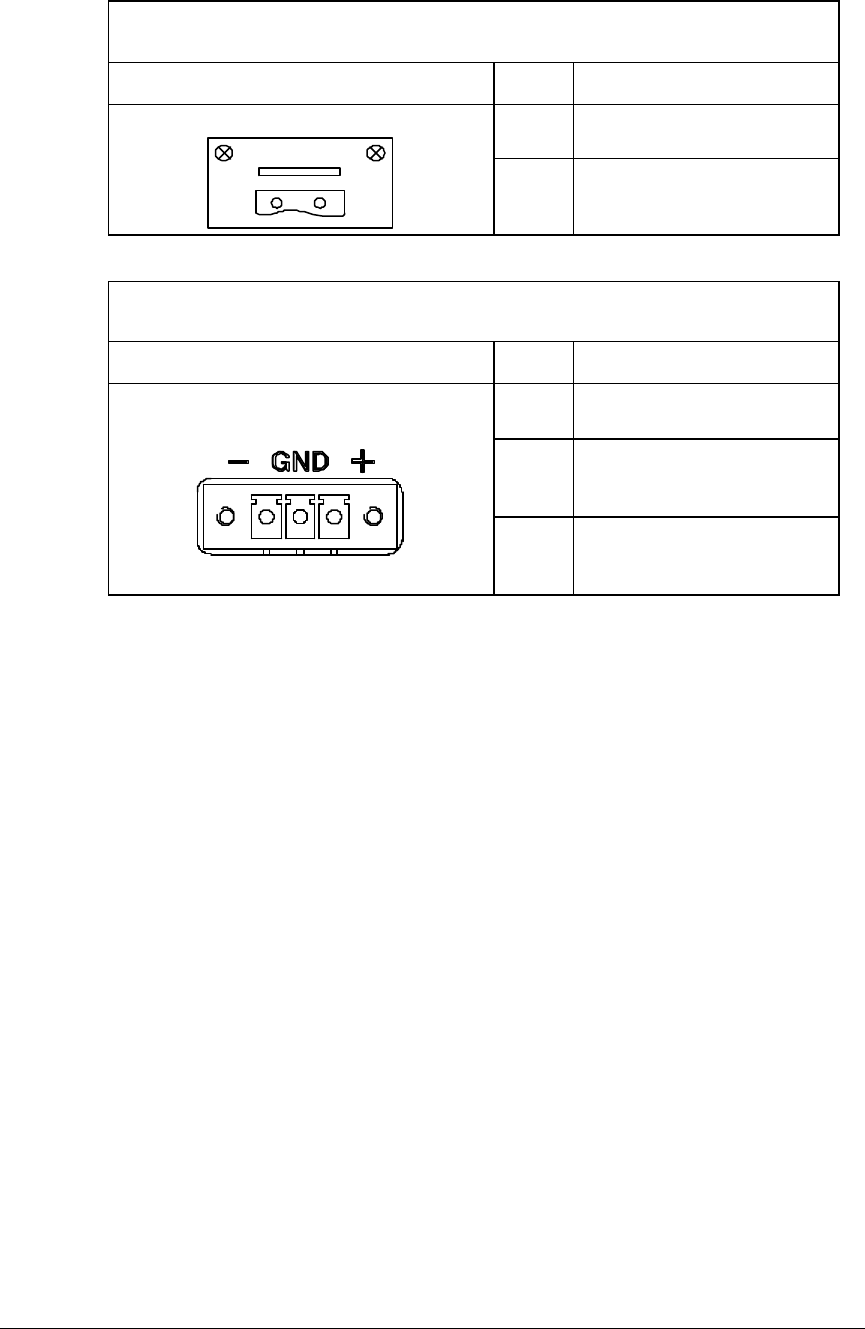
Chapter 3. Controls, Indicators and Connectors on the DIU
3-12 862-02411 February 04
Wiring data are given in Table 3-9 and Table 3-10 below.
Table 3-9. Pin-outs for DC Power Connector (Velox LE DIU 120 Ohm & 75/120
Ohm)
DIU connector: GREY Pin No Signal
+
DC POWER
2-pin Wieland Type 8213 Socket
-+
DC
-
DC POWER RETURN
Table 3-10 . Pin-outs for DC Power Connector (Velox LE 10, Velox LE 25, Velox
LE 50 DIU)
DIU connector: GREEN Pin No Signal
+
DC POWER
GND GROUND PIN
3-pin Phoenix Type 18.27.87.1 Socket
-
DC POWER RETURN
Fuse Holder (12)
This holder is used to hold a fuse (2A, slow blow fuse).
On/Off Switch (13)
This switch is used to control power input to the DIU (and indirectly the RFU). Note
that the ON/OFF switch is NOT fitted to the Velox LE 10, Velox 25 and Velox 50
DIUs. These DIUs will start up as soon as the required DC voltage is applied.
Ground Terminal (14)
This is used to accept connection to an earth strap, terminated with a crimped earth lug.
Refer to the installation chapter for details on wire/earth lug requirements. A ground
connection is also available on the three-pin DIU DC power connector.
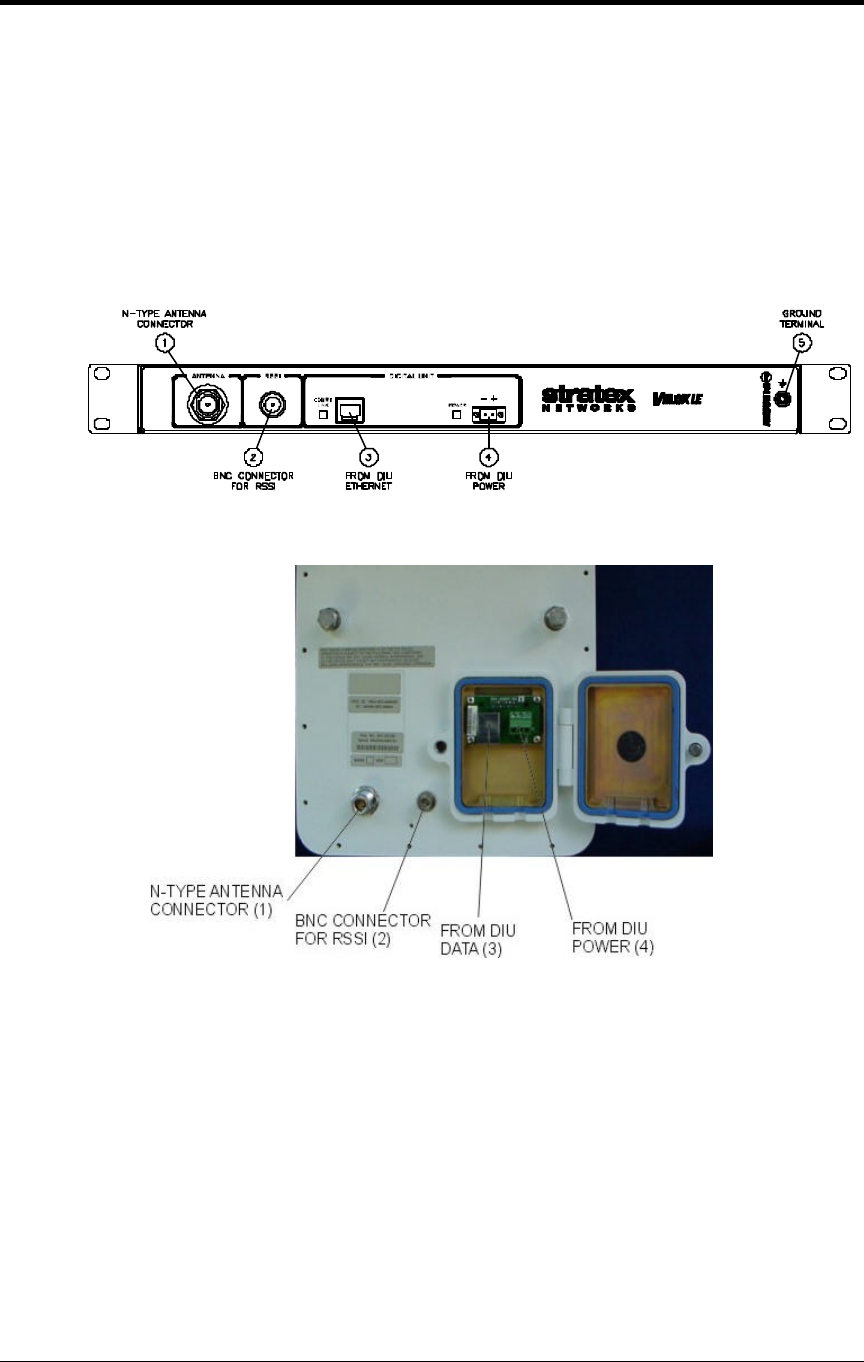
Velox LE Installation and Operations Manual
862-02411 February 04 3-13
Indicators and Connectors on the IRFU and ORFU
General
The Velox LE 2410i, Velox LE 2450i, Velox LE 5810i and Velox LE 5850i ORFUs
have the same indicators and connectors on their front panels.Thus, only one example
the Velox LE 2410i is shown (see Figure 3-8 below.
There are no indicators on the ORFU. The connectors are shown in Figure 3-9 below.
2410i
Figure 3-8. Connectors and Indicators on the Velox LE IRFU Front Panel
Figure 3-9. Connectors and Indicators on the Velox LE ORFU
Antenna Connector (1)
The RFU connects to the antenna using a 50 ohm co-axial cable or flexible waveguide
via a launch/N-type adaptor terminated with male Type N connectors on each end. The
female N -type Antenna connector on the RFU provides termination for this line on the
RFU.
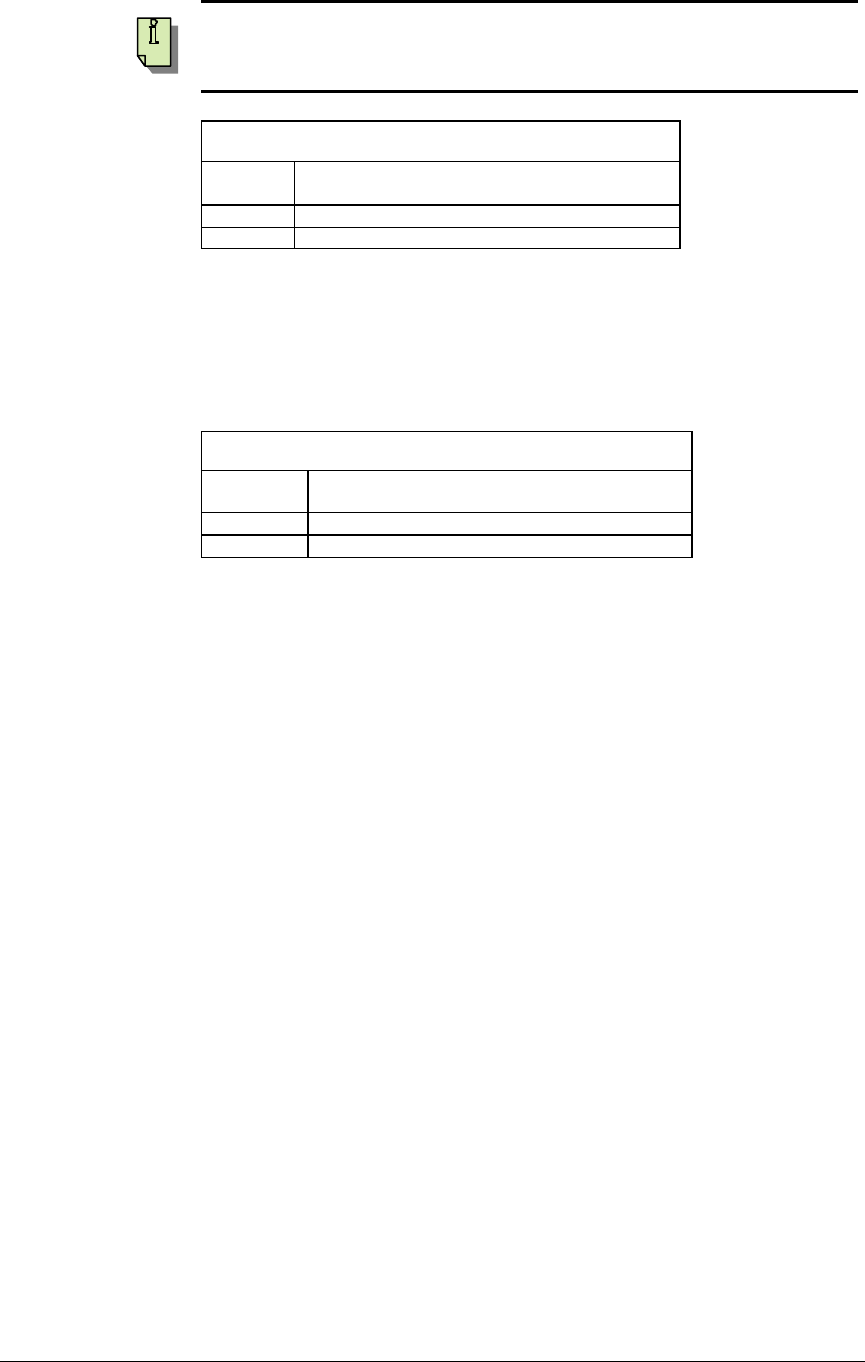
Chapter 3. Controls, Indicators and Connectors on the DIU
3-14 862-02411 February 04
Flexible waveguide connected via a launch/N -type adaptor is recommended for
longer feeder runs to minimize losses.
Table 3-11. RFU Antenna Connector Pin-outs
Pin Description
Centre Transmitter and Receiver RF
Outer Common Signal/Chassis Ground
RSSI (2)
The RSSI connector is a BNC connector that provides DC voltage level corresponding
with the RSL (Received Signal Level) for use in antenna installation and alignment. A
standard DVM (Digital Volt Meter) is used for this purpose.
Table 3-12. RFU RSSI Connector Pin-outs
Pin Description
Centre Transmitter and Receiver RF
Outer Common Signal/Chassis Ground
DIU COMMS
LED on the IRFU only whose normal condition is ON indicating that there is
communication between the DIU and the RFU. If it is OFF, check the Data Cable
between the DIU and RFU.
DIU/RFU Data (3)
This receptacle accepts an RJ45 plug that connects to UV-protected STP (Screened
twisted pair) cable used between the DIU and the RFU. Pin-outs for the DIU/RFU Data
cable are given in Table 3-7 on page 3-10.
DIU Power
LED on the IRFU only whose normal condition is ON indicating that power is being
received from the DIU. If it is OFF, check the DIU is ON and that the Power Cable
between the DIU and RFU is serviceable.
DIU DC In (4)
This connector (socket) is used for power interconnection between the DIU and the
RFU. The connection is made using UV-protected 2-core cable. The connector
depends on the unit as follows:
• IRFU - GREEN, two-pin plug.

Velox LE Installation and Operations Manual
862-02411 February 04 3-15
• ORFU – GREEN, three-pin plug.
Ground Terminal (5)
This is used to accept connection to an earth strap, terminated with a crimped earth lug.
Refer to the installation chapter for details on wire/earth lug requirements.

Velox LE Installation and Operations Manual
862-02411 February 04 4-1
Chapter 4 : Hardware Installation
Introduction
This chapter covers installation procedures for all the Velox LE split-architecture radio
systems. All steps, from unpacking and checking the equipment, through to completion
of the physical installation and antenna alignment are addressed.
For a full description of the Velox LE systems, refer to the System Overview on page 8-
4.
Health and Safety
Velox LE Health and Safety Requirements
Ensure relevant health and safety practices are adhered to at all times, when working on
or around the Velox LE radio equipment. Table 4-1 on page 4-1 details the
recommended general health and safety practices. Table 4-2 on page 4-2 details
recommended operator health and safety practices.
Ensure the general hazards in Table 4-3 on page 4-2 are fully addressed at the planning
and installation stages.
General Health and Safety
Table 4-1. General Health and Safety Practices
Hazardous Materials No hazardous materials are used in the construction of the
equipment and, therefore, no special handling/disposal
procedures are required.
Hazardous Voltages The Velox LE 10 and Velox LE 25 takes up to 56/58V input to
the DIU and convert it to 64V nominal or up to 80V OC for RFU
power feed. The Velox LE 50 DIU meets SELV standards and
the RFU power feed is always be low 60V with a
nominal/average of 53V.
Safety Signs It is not necessary to place external warning signs or other
indications on the equipment.
Surface Temperatures While external surfaces of the equipment do become warm
during operation due to normal heat dissipation, the
temperatures reached are not considered hazardous.
Flammability The equipment is designed and constructed to minimize
the risk of smoke and fumes under fire conditions.

Chapter 4. Hardware Installation
4-2 862-02411 February 04
Operator Health and Safety
Table 4-2. Operator Health and Safety Practices
Protection from RF
Burns:
Velox LE Radios
While the Velox LE radio does not generate RF fields of
intensity sufficient to cause RF burns, it is hazardous to look into
or stand in front of an active antenna aperture while the radio is
active.
Do not stand in front of or look into an antenna without first
ensuring the associated transmitter or transmitters are switched
off.
Protection from RF
Burns:
General
When any of the Velox LE ORFU is to be installed on a structure
or rooftop that has existing antennas fitted, avoid exposure to
potentially harmful levels of RF radiation from these antennas.
Do not proceed with an installation without first determining the
RF expo sure risk. If necessary ask the structure/rooftop owner or
operator. Where necessary, wear a protective suit or have the
required transmitter(s) switched off for the duration of the
installation.
Even where the perceived risk is low, do not stand in front of or
look into other antennas.
Lifting Equipment Care must be taken when hoisting or lifting the RFU or its
antenna during installation or maintenance. The RFU is
nominally 6kg (13.2lbs), but dependent on size, associated
antennas with their mounting hardware can weigh in excess of
100kg (220 lbs.), which will require specialised lifting equipment
and an operator trained and certified in its use.
Equipment Protrusions While the equipment has been ergonomically designed to be free
from unnecessary protrusions or sharp surfaces that may catch or
otherwise cause injury during handling, always take care when
working on or around the equipment.
Safety Warnings When a particular practice or procedure poses implied or
potential harm to the user or to the radio equipment, a warning is
included in this manual.
General Hazards
The General hazards to be addressed when planning and installing a Velox LE system
are detailed in Table 4-3.
Table 4-3. General Hazards
Maximum ambient
temperature The maximum ambient temperature (Tmra) for the Velox LE
DIU is +50° Celsius.
The maximum ambient temperature (Tmra) for the Velox LE
ORFU is +60° Celsius and for the Velox LE IRFU is +50°
Celsius. Compliance to the operational specification is not
guaranteed for higher ambient temperatures. To ensure correct
operation and to maximize long term component reliability,
ambient temperatures must not exceed this figure.
Rack mount
temperature
considerations
If the Velox LE type DIU and IRFU are installed in a closed or
multi-unit rack assembly, the operating ambient temperature of
the rack environment may be greater than room ambient. The
maximum ambient temperature (Tmra) of +50° Celsius applies to
the immediate operating environment of the Velox LE DIU and
IRFU, which if installed in a rack, is the ambient applying within
the rack.
Airflow requirements Rack installations must be made so the airflow required for safe
and correct operation of the Velox LE is not compromised. For
the Velox LE, unobstructed air passage must be maintained to
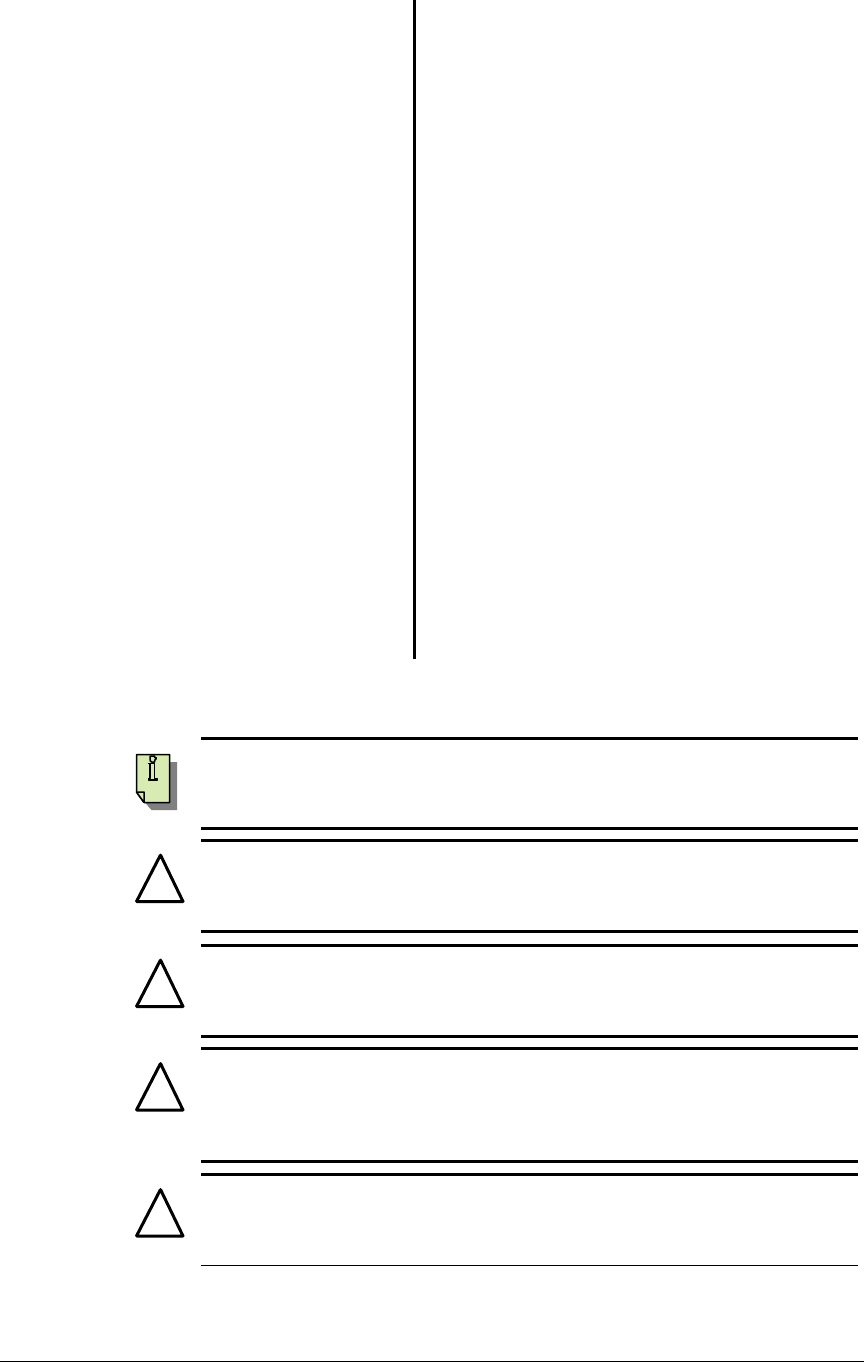
Velox LE Installation and Operations Manual
862-02411 February 04 4-3
each side of the indoor units, which requires a minimum of 50
mm (2 inches) of side spacing to any rack panels, ca ble bundles
or similar.
Circuit overloading Consideration must be given to the connection of a Velox LE to
existing dc supply circuits and the effect that overloading of
circuits might have on the power supply, circuit protection
devices and supply wiring. Check the Velox LE power
consumption specifications and the supply capability of the
power supply system when addressing this concern. This check
of capacity must extend right to the dc power supply and not just
to an intermediate connection point.
Power supply connection The Velox LE radio must be used with correct power supply (21-
56 Vdc power supply or 21 – 58 Vdc power supply as indicated).
The power supply must be located in the same premises as the
Velox LE system.
Earth connection Reliable earthing of the Velox LE system must be maintained.
Refer to instructions in the manual for earthing of the ODU,
ODU cable, lightning surge suppressor and indoor unit.
Lightning surge
suppressor
All Velox LE RFU cables must be fitted with a lightning surge
suppressor.
Refer to instructions in the suppressor supplier’s documentation
for suppressor installation information.
Mechanical loading When installing the DIU and IRFU in a rack, ensure the rack is
securely anchored. Check to ensure that the additional loading of
a Velox LE DIU or units will not cause any reduction in
mechanical stability of the rack.
Restricted access The Velox LE system must be installed in restricted access sites.
The DIU and associated power supply must be installed in
restricted areas, such as dedicated equipment rooms, closets,
cabinets or the like. Similarly, access must be restricted to the
RFU/antenna location.
In particular, install and operate a Velox LE system in accordance with the following
statements and warnings:
An appropriate power supply disconnect device should be provided as part of the
building installation.
!
WARNING
The Velox LE system has been evaluated for safety with the maximum allowed for
the system, i.e. 56 Vdc or 58 Vdc depending on the system.
!
WARNING
The Velox LE type DIU earth must be connected directly to the dc supply system
earthing conductor, or to a bonding jumper from an earthing terminal bar, or bus to
which the dc supply system earthing is connected.
!
WARNING
The Velox LE type system must be located in the immediate area, such as in the
same or adjacent cabinets, of any other equipment that has a connection to the same
earthed conductor of the same dc supply circuit. The Velox LE dc system must not
be earthed elsewhere.
!
WARNING
The dc supply source must be located within the same premises as the Velox LE
system.

Chapter 4. Hardware Installation
4-4 862-02411 February 04
!
WARNING
There must be no switching or disconnecting devices in the earthed circuit and the
point of connection to a Velox LE system.
!
WARNING
Do not look into or stand immediately in front of an active antenna.
!
WARNING
Never install an ORFU on a structure, rooftop or the like where there are existing
antennas without first ascertaining the RF exposure risk from the existing antennas,
and where necessary taking appropriate risk avoidance action.
Refer to Stratex Network’s Microwave Radio Systems Standard Practices Guide for
more information on health and safety when using Stratex Networks products.

Velox LE Installation and Operations Manual
862-02411 February 04 4-5
Hardware Installation Overview
An Overview of the hardware installation is shown in Figure 4-1.
Hardware Installation
Pre-Installation
ŸInstallation tools and equipment
ŸUnpacking the equipment
ŸBench set-up and familiarization
ŸVerifying the system configuration
ŸCheck basic components
ŸCheck kits and accessories
Installation
ŸAntenna
ŸRF Unit
ŸDIU and DIU cabling
ŸDIU / RF Unit cable
ŸCable running and fastening
ŸFitting and waterproofing connectors
ŸRF Unit grounding
ŸCable grounding
ŸInstalling lightning surge suppressor
ŸAC/DC PSU connection
Commissioning
ŸConnect PC
ŸPower on and log into DIU
ŸCheck DIU status
ŸAlign the antenna
ŸSet DIU parameters
Figure 4-1. Hardware Installation – Overview

Chapter 4. Hardware Installation
4-6 862-02411 February 04
!
CAUTION
Failure to check the configuration may result in interference to other links if
frequency and power settings are incorrect for the site.
Pre-Installation
General
This section details the following:
• Tools and equipment to be supplied or manufactured by the installer (see
Installation Tools and Equipment below).
• Unpacking of shipping boxes and verification of contents to ensure that what has
been delivered is what is required (see Unpacking the Equipment on page 4-8).
• Bench set-up to verify the equipment and carry out initial configuration (see Bench
Set-up (First time users) on page 4-10).
All the above should be carried out before going to the installation site.
Installation Tools and Equipment
Before going to site check that you have the recommended tools, materials and
equipment for each equipment as listed in Table 4-4 below, Table 4-5 on page 4-7 and
Table 4-6 on page 4-8.
Table 4-4. Tools and Material for Installation
Antennas Refer to the antenna manufacturer’s data for required and recommended installation tools and
equipment. This data will be included with every antenna.
The following tools and material are not included in the standard Velox LE installation kits and
must be separately sourced or supplied by the installer.
Basic
electrician’s
toolkit.
The kit must include cable cutting and crimp tool for attaching lugs to
stranded copper cable, a multimeter, RJ45 crimp tool, soldering iron and a
set of Allen keys.
Ground cable or
strap
Ground cable or strap rated at 45A with 5 mm ground lug for grounding
the Indoor and RFUs.
Adjustable
wrench
(5-25mm)
Hot-air gun For use on the heat-shrink tubing supplied with the Andrew N-type
connectors.
Protective grease
and zinc-rich
paint
For weather-protecting grounding attachment points on towers and
grounding bars.
Tape UV Protective, self-vulcanising tape for the protection of connectors.
Cable ties Used to secure the cables to the mast at regular intervals.
Velox LE
(General)
Binoculars or
GPS or Compass
Bearing of other station during antenna alignment
Pozi #2
screwdriver
DIU mounting in a 19" rack and the ground lug.
7mm spanner Attaching the earth cable to the DIU.
DIU
2.5mm Allen key To change the position of the DIU mounting brackets.

Velox LE Installation and Operations Manual
862-02411 February 04 4-7
Table 4-4. Tools and Material for Installation
DC power supply
cable
Minimum 2.5 mm square conductor, rated for 10 A. For connection
between the power supply and the DIU DC connector on the rear panel.
(The DC connector is on the front panel of the Velox LE DIU.)
DIU ground lug 10-4 (10 square mm for wire and hole big enough for M4 thread)
13 mm wrench /
spanner
Used for attachment of RFU to mounting bracket and mounting bracket to
pole. Also used to close RFU with hinge type connection box.
2.5 mm Allen key Used to tighten RFU connection box cover fasteners.
RFU ground lug 10-4 (10 square mm for wire and hole big enough for M4 thread)
ORFU
Multimeter
(recommended)
Measure RSSI at RFU during antenna panning. The RSSI level may also
be read from the NCT / GUI via laptop connection to the DIU, indoors
Pozi #2
screwdriver
DIU mounting in a 19" rack and the ground lug.
7mm Spanner Attaching the earth cable to the DIU.
2.5mm Allen key To change the position of the DIU mounting brackets.
RFU ground lug 10-4 (10 square mm for wire and hole big enough for M4 thread)
IRFU
Multimeter
(recommended)
Measure RSSI at RFU during antenna panning. The RSSI level may also
be read from the NCT / GUI via laptop connection to the DIU, indoors
Table 4-5. Cables Assemblies to be Manufactured
Cable Assy Name Connector Type
Remarks
DIU Power Input Cable
2-Pin Wieland
Type 8213 Socket
3-
Pin Phoenix Type
18.27.87.1
Input connector supplied
Velox LE 120 Ohm, Velox 75/120 Ohm
Velox LE 10, Velox LE 25, Velox LE 50
DIU to ORFU Power
Cable Recommended Cable: 1.5mm sq stranded PVC Insulated, PVC FR
UV protected Polifin H2/J263/904 Outer Black 300/500V Temp -
20°C to +85°C. Cable outer diameter: between 7.4mm and 9mm
i.e. 8.2mm ± 0.8mm.
Suggested cable types are:
Superior Essex type SJOOW flexible cable P/N 441821* (7.4mm)
Carol Cable (General Cable) SJOW/SJO P/N 02001 18 gauge 2
conductor (7.8mm)
Note that for IRFU systems DIU to IRFU power cable is supplied.
DIU to ORFU Data Cable Recommended Cable: STP (FTP) 4 Pairs Solid Cat 5, PVC FR UV
protected Polifin H2/J263/904 Outer Black. Outer diameter of
cable: 7.3mm ± 0.5mm. This is a standard FTP Cat 5 cable that is
‘upjacketed’ with suitable plastic for FR/UV (Flame
retardant/Ultra Violet) protection.
Suggested cable types are:
Superior Essex BBDN CAT 5 cable P/N 04-0010-34 (7.8mm)
Superior Essex CAT 5 P/N 18-241-31 18-241-11 (5.1mm)
General Cable CAT 5 P/N 2137113 2137114 (5.6mm)
Belden CAT 5 P/N BC1002 (6.0mm)
Note that for IRFU systems DIU to IRFU data cable is supplied.
IRFU to Antenna RF
Cable N-type Male
Connector High quality ½” or 5/8” coaxial cable or elliptical wave guide for
longer runs to minimize losses.
Balanced Payload Data
Cable DB25
Balanced Payload Data
Cable RJ48 Velox LE 10 and Velox LE 25
Unbalanced Payloa d Data
Cable BNC Velox LE 75/120 Ohm Only
Auxiliary I/O Cable 15-Way D-type
Service Cable 9-Way D-type
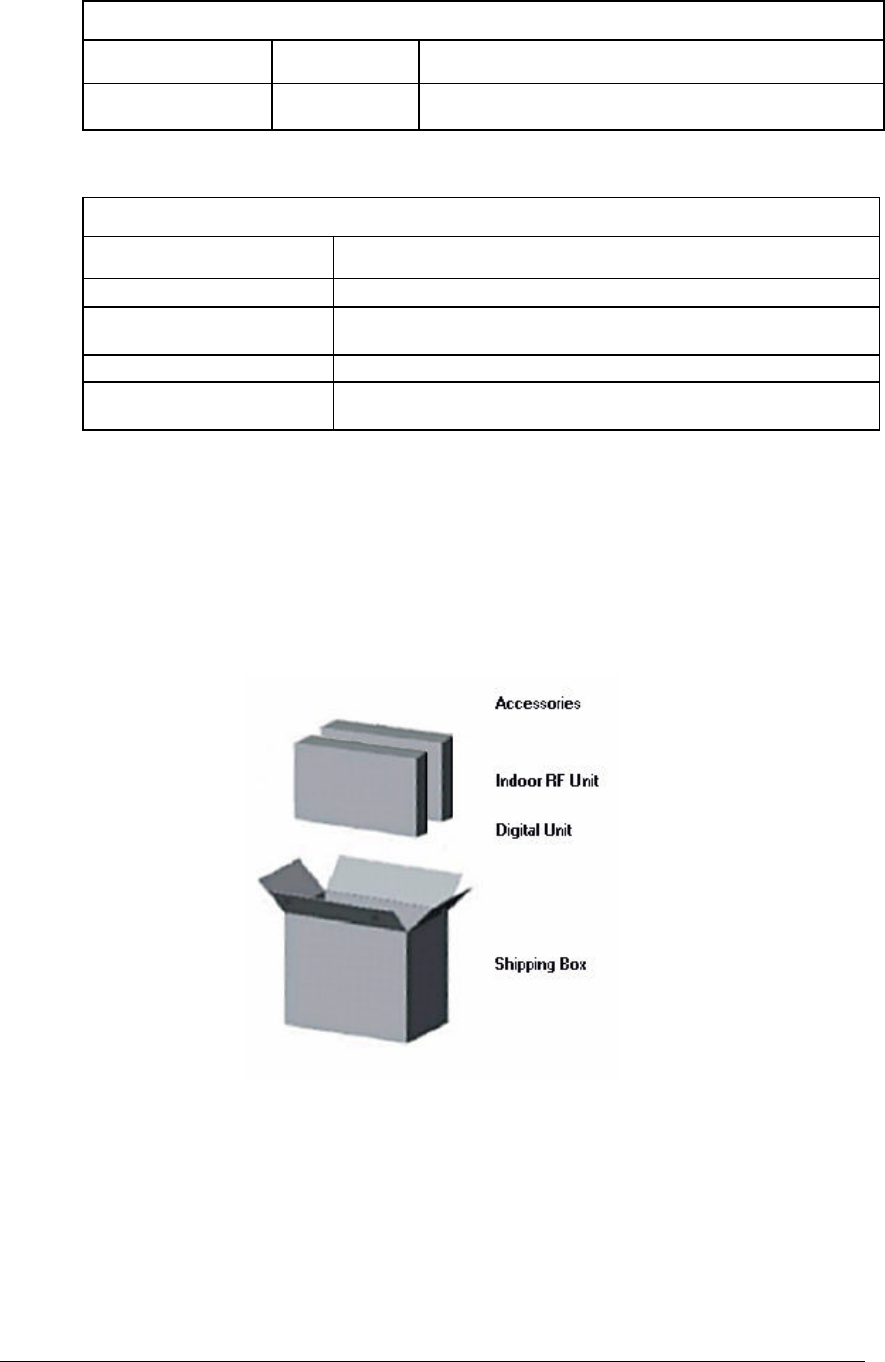
Chapter 4. Hardware Installation
4-8 862-02411 February 04
Table 4-5. Cables Assemblies to be Manufactured
Cable Assy Name Connector Type
Remarks
Loop Back Connector Required for back-to-back testing. Rx connections wired to Tx
connections on the payload connector.
Apart from the Cable Assem blies listed in Table 4-5 the Customer must supply the
installation and test equipment listed in Table 4-6.
Table 4-6. Additional Equipment to be Supplied by the User
Equipment Required Remarks
Inline Lightning Protection Unit A lightning protection unit must be installed at the RFU Antenna connection.
Antenna Refer to Antenna Selection on page 2-2. Note that Stratex Networks can
supply antennas if required.
Power Supply Supply of DC supply to DIU
T1 or E1 BER Tester Required for back-to-back testing. If BER is not connected during back-to-
back testing, then the Payload LED will be Red, i.e. no payload signal.
Unpacking the Equipment
One RFU and one DIU are shipped per packing box. DIUs are shipped with
configuration as ordered. Standard installation items are included and any optional
accessories will also be included, subject to the available space. Additional RFUs and
DIUs are shipped in dedicated ‘satellite’ boxes. The contents of the Accessories Box are
listed in Table 4-7 on page 4-9.
Figure 4-2. All Indoor Radio Packing Configuration

Velox LE Installation and Operations Manual
862-02411 February 04 4-9
Figure 4-3. Indoor/Outdoor Radio packing configuration.
Open the shipping containers using a utility knife carefully remove the equipment and
place it on a clean flat working surface. Save the shipping and packing material in case
the equipment has to be returned.
Table 4-7. Contents of Accessories Box
Description Part Number Qty
Remarks
ORFU Pole Mounting Kit 651-03809 1 Comprises:
Mounting Bracket
Mounting Bracket Clamp
2 x Mounting U-Bolts
4 x Nut M8 Hex Stainless Steel ISO/C
4 x Washer M8 Plain Flat Stainless Steel
4 x Washer M8 Spring Single Coil Type A Stainless
Steel
4 E/T Spider Cable 660-03678 1 For interconnectin g between the DB25 Payload
Connector and 4 x RJ48 lines. Supplied with units
with DB25 Payload connectors only.
RSSI Cable 660-03405 1 BNC Plug to 2 x 4mm Plugs (one black plug & one
red Plug)
Ring Terminal M8 388-00585-N 1 Ring Tongue Lug Crimp 001 10 mm sq Conductor
supplied with ORFUs only. For connecting RFU to
ground.
Connector 002 Block Plug Single Row Straight
Free 5,08mm (Grey)
368-02744-Q 1 DC input connector for Velox LE 120 Ohm and Velox
LE 75/120 Ohm DIUs.
3-pin Phoenix Type 18.27.87.1 Socket 1 DC input connector for Velox LE 10, Velox LE 25,
Velox LE 50 DIU
Connector 002 Block Plug Screw flange
5.08mm (Green) 368-03614 2 Connectors for DIU to RFU Power Cable
Lap Link cable: Dual Header Serial 660-03349 1 (25 & 9 way both ends). For programming the system
via the Element Manager connector.
Software CD 651-04252-02 1 Contains NCT and other system software
Installation and Operations Manual 862-02411 1 This Manual
Combined DIU to IRFU Power/Data Cable 660-03770-01 1 Cable one metre long, which is supplied with IRFU
systems only
DIU/IRFU Rack Mounting Hardware Various A/R
4 x M16 x 18 mm and washers are supplied for each
unit.
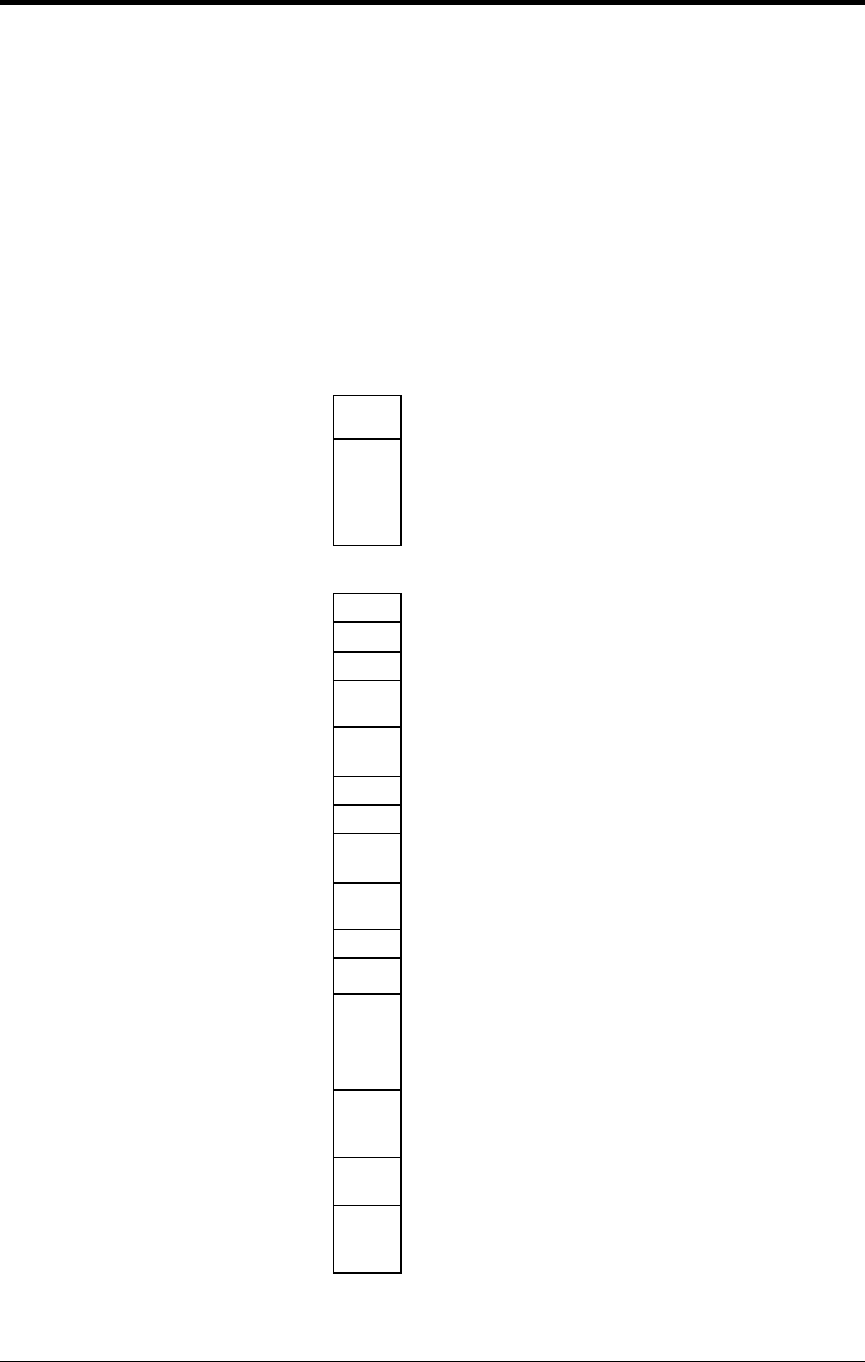
Chapter 4. Hardware Installation
4-10 862-02411 February 04
Bench Set-up (First time users)
Getting started (Without a PC)
This section describes the suggested steps to follow to successfully set-up a Velox LE
link without using a PC.
This section applies to all Velox LE radios with the only difference being the location
of the interface connectors on the various DIUs.
Complete the checklist to ensure that you have the required equipment and information
to continue.
Do not continue until you have read and completed the checklist!
Steps to follow: Check
Additional Information
1.
Velox LE Installation & Operation
Manual (This Manual) Ensure that you understand:
The use of the Reset Button when configuring the Velox LE (see
Reset/Configuration Button (3) on page 3-7.
How to interpret the DIU front panel LEDs (see DIU Status Diodes
(2) on page 3-6 and DIU/RFU Link LED (7) on page 3-9).
2.
Connect the Velox LE System as shown in Figure 4-4 on page 4-12 noting the following (the numbers in brackets
following each note correspond to the numbers given on Figure 4-4):
2 x DIU
2 x RFU 1 low and 1 high band - see L/H stamp near serial number.
2 x Power supplies (1) 21 to 58 Vdc, 35 W typical (40 W, 45 W max).
Make 2 x PSU to DIU power cable (2) For wiring data, see Table 3-9 on page 3-12 or Table 3-10 on page
3-12 depending on the version.
Ground both DIU and RFUs (3) Connect ground cable between ground terminal on units and
ground.
Make 2 x DIU to RFU power cables (4) For wiring data, see RFU DC Out (9) on page 3-10.
Make 2 x DIU to RFU Data cables (5) For wiring data, see Table 3-7 on page 3-10.
N-type male to N -type male (6 GHz) RF
cable to connect RFU (6) Use between 60 dB (min) and 90 dB (max) attenuation and a short
low-loss RF transmission line to connect the two radios.
Connect BER Tester to Payload
Connector (9) (10) The BER Test must be connected for this test.
60 – 90 dB of N-type attenuators (7) Note Max input is –30 dBm, default output power is +24 dBm
3.
Connect attenuator(s) to RFUs
4.
Interconnect the two RFUs with N-Type
RF cable
5.
Connect DIU to RFU x 2 Power and Data. Ensure that DIUs are not powered-up when
connecting.
6.
Connect PSU to DIU x 2 Note that Velox LE 10, Velox LE 25 and Velox LE 50 DO NOT
have Power ON/OFF switches, i.e. if PSU is on and connected to
the source supply, the systems will power-up.
7.
Power-up both DIUs ON/OFF Switch on back panel of Velox LE 120 Ohm & Velox LE
75/120 Ohm Versions. No switch on other versions.
8.
For each system, allow about one
minutes settle time and clear any Alarm
Conditions present
Using front panel Reset Button, carry out a 1-RESET to clear front
panel LEDs and associated alarms in DIU.
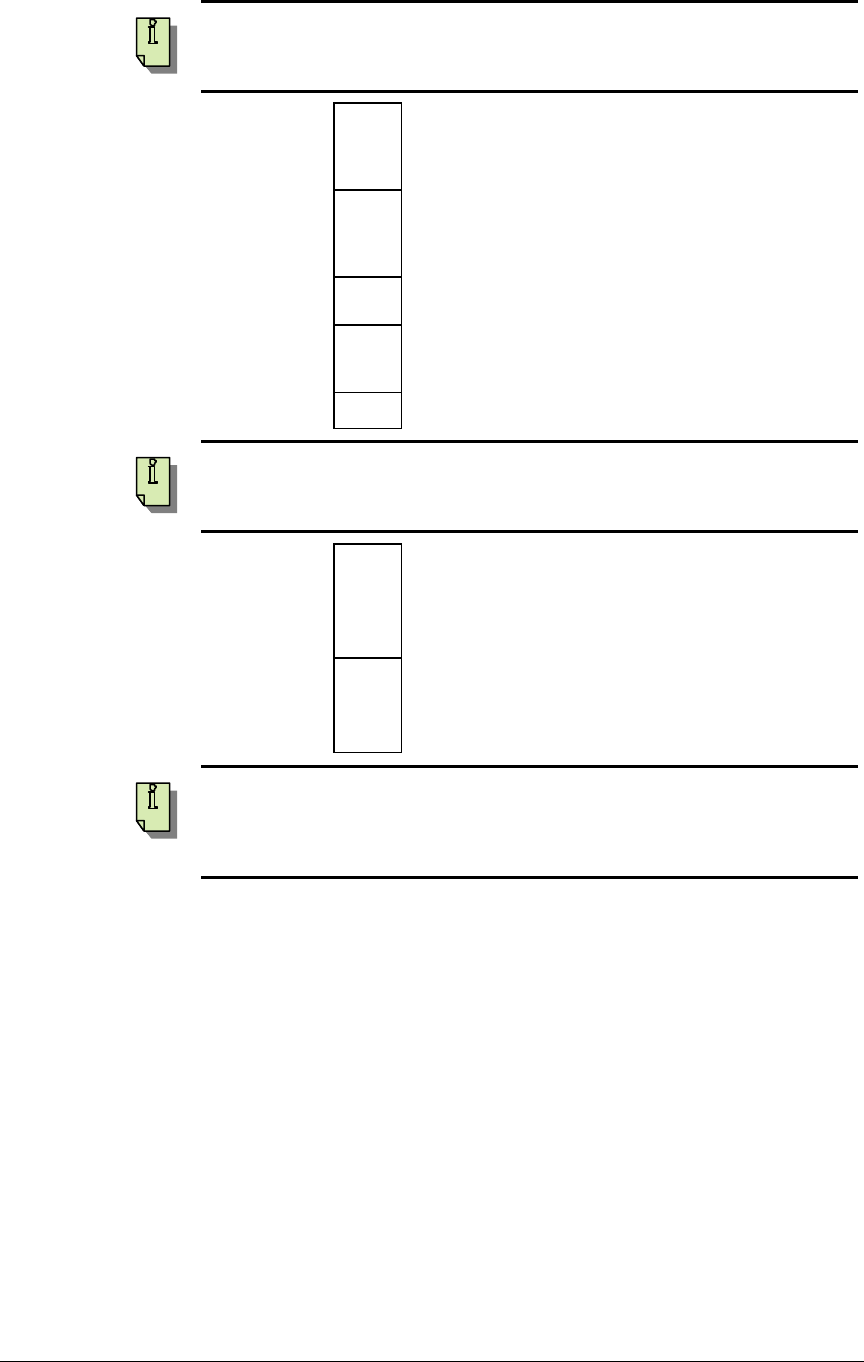
Velox LE Installation and Operations Manual
862-02411 February 04 4-11
Refer to Table 3-5 on page 3-7 for information on using the Reset Button to
configure the Velox LE.
9.
Set one DIU to a NEAR Bridge
configuration Using front panel Reset Button, carry out an 8-RESET (Bridged
Configuration) to set DIU to NEAR Bridge Configuration. Note
that if a Routed configuration is being used a 5-RESET should be
carried out.
10.
Set the other DIU to a FAR Bridge
configuration Using front panel Reset Button, carry out a 7-RESET (Bridged
Configuration) to set DIU to FAR Bridge Configuration. Note that
if a Routed configurat ion is being used, a 4-RESET should be
carried out.
11.
Set the NEAR DIU to the required data
rate (T1 or E1)
12.
Set the FAR DIU to the same data rate as
NEAR DIU (point 11 above) (T1 or E1)
(use front panel Reset button)
Using front panel Reset Button, carry out a 12-RESET (E1
Tributaries) or 13-RESET (T1 Tributaries)
13.
Check the “RF Link” LED status LED Green for working link
Refer to Table 3-4 on page 3-7 for information on Status LED interpretation. Note
that if BER Tester is NOT connected, the Payload LED will be RED indicating No
Payload signal.
14.
Clear DIU errors Using front panel Reset Button, carry out a 1-RESET to clear front
panel LEDs and associated alarms in DIU. If required the EVENT
LOG can be cleared by using 2-RESET (only necessary if viewing
the EVENT LOG on a PC.
Reset BER Tester.
15.
Monitor Status BER Tester should run with no errors
All 3 Front Panel LEDs should be green. Note that “RF Link” LED
may flash orange from time-to-time. See Note below for “Payload”
LED indication.
Unless all tributaries are in use the “Payload” LED will be RED. For example, if
only two tributaries are in use, but all four are active, the “Payload” LED will be
RED, as the two unused tributaries have no signal. This is not important, as the main
purpose of this test is to test the link, i.e. “RF Link” LED GREEN.
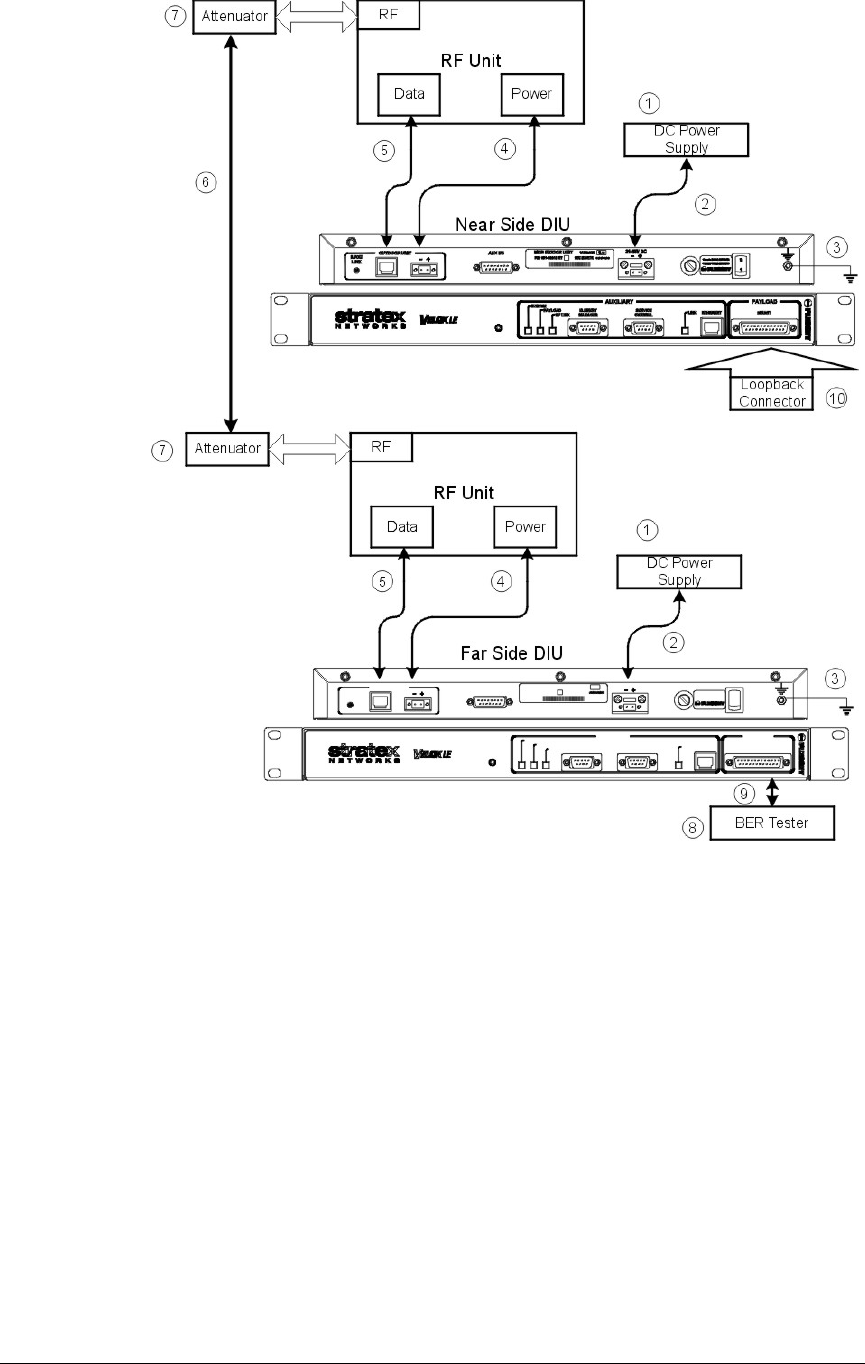
Chapter 4. Hardware Installation
4-12 862-02411 February 04
Figure 4-4. Velox LE System Connection for T1/E1 Bench Test (without
PC)
Getting Started (with a PC)
This section describes the suggested steps to follow to successfully set-up a Velox LE
link using a PC with NCT installed (see Chapter 5: NCT Installation).
This section applies to ALL Velox LE radio series with the only difference being the
location of the interface connectors on the various DIUs.
Complete the checklist to ensure that you have the required equipment and information
to continue.
Do not continue until you have read and completed the checklist!

Velox LE Installation and Operations Manual
862-02411 February 04 4-13
Steps to follow: Check
Additional Information
1.
Velox LE Installation & Operation
Manual (This Manual) Ensure that you understand:
The use of the Reset Button when configuring the Velox LE (see
Reset/Configuration Button (3) on page 3-7.
How to interpret the DIU front panel LEDs (see DIU Status Diodes
(2) on page 3-6 and DIU/RFU Link LED (7) on page 3-9).
2.
NCT Program NCT Program installed on the PC to be used together with an
understanding of how to use NCT t o configure the System (refer to
NCT Program integrated software help).
3.
Connect the Velox LE System as shown in Figure 4-5 on page 4-15 noting the following (the numbers in brackets
following each note correspond to the numbers given on Figure 4-5):
2 x DIU
2 x RFU 1 low and 1 high band - see L/H stamp near serial number
2 x Power supplies (1) 21 to 58 Vdc, 35 W typical, 45 W maximum.
Make 2 x PSU to DIU power cable (2) For wiring data, see Table 3-9 on page 3-12 or Table 3-10 on page
3-12 depending on the version.
Ground both DIU and RFUs (3) Connect ground cable between ground terminal on units and
ground.
Make 2 x DIU to RFU power cables (4) For wiring data, see RFU DC Out (9) on page 3-10.
Make 2 x DIU to RFU Data cables (5) For wiring data, see Table 3-7 on page 3-10.
N-type male to N-type male (6 GHz) RF
cable to connect RFU (6)
Use between 60 dB (min) and 90 dB (max) attenuation and a short
low-loss RF transmission line to connect the two radios.
60 – 90 dB of N-type attenuators (7) Note Max input is –30 dBm, default output power is +24 dBm
Connect BER Tester to Payload
Connector (9) (10)
Connect PC (11) to Near Side DIU to
Element Manager Port via serial cable
(12) or to Ethernet connection (13)
PC must have NCT loaded and either:
§ If using Ethernet – Ethernet channel set -up.
§ If using Element Manager Port, serial connection configured.
Note the configuration required is dependent on the version of
Microsoft Windows installed on the PC (see Element Manager
Point-to-Point Protocol Serial Communications Set-up on page
6-1 for further information).
4.
Connect attenuator (s) to RFUs
5.
Interconnect the two RFUs with N-Type
RF cable
6.
Connect DIU to RFU x 2 Power and Data. Ensure that DIUs are not powered-up when
connecting.
7.
Connect PSU to DIU x 2 Note that Velox LE 10, Velox LE 25 and Velox LE 50 DO NOT
have Power ON/OFF switches, i.e. if PSU is on and connected to
the source supply, the systems will power-up.
8.
Power-up both DIUs ON/OFF Switch on back panel of Velox LE 120 Ohm & Velox LE
75/120 Ohm Versions. No switch on other versions.
9.
For each system, allow about one
minutes settle time and clear any Alarm
Conditions present.
Using front panel Reset Button, carry out a 1-RESET to clear front
panel LEDs and associated alarms in DIU.
Refer to Table 3-5 on page 3-7 for information on using the Reset Button to
configure the Velox LE.
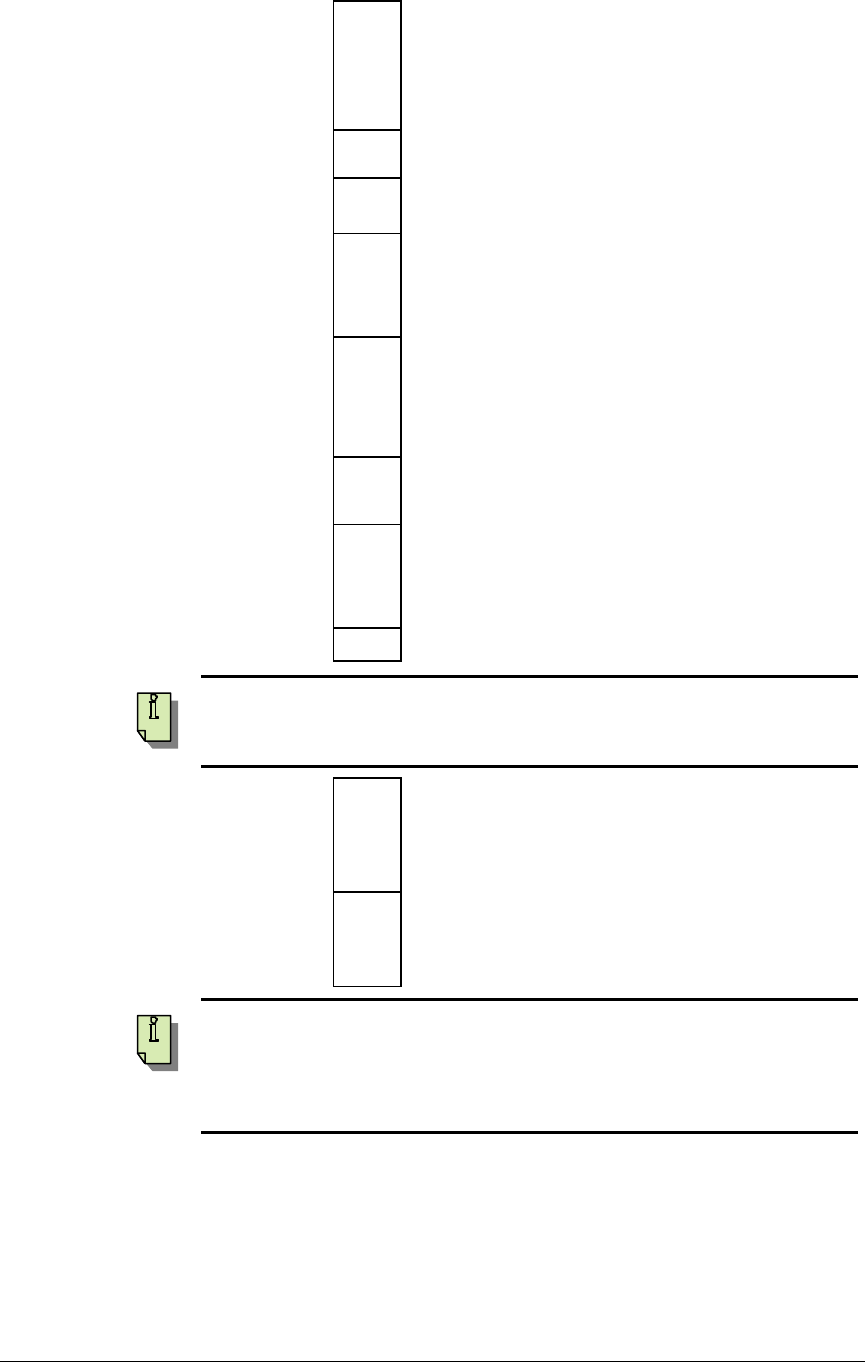
Chapter 4. Hardware Installation
4-14 862-02411 February 04
10.
Set DIU with PC connected to a NEAR
Bridge configuration.
Default IP address:
Ethernet option: 192.168.1.2
Modem option: 192.168.2.2
Using front panel Reset Button, carry out an 8-RESET (Bridged
Configuration) to set DIU to NEAR Bridge Configuration. Note
that if a Routed configuration is being used, a 5-RESET should be
carried out.
11.
Set the NEAR DIU to the required data
rate (T1 or E1) Using front panel Reset Button. carry out a 12-RESET (E1
Tributaries) or 13-RESET (T1 Tributaries)
12.
At the NCT, connect to NEAR side
DIU
If Serial Cable Connection is being used.
13.
Ping NEAR side DIU
Default IP address:
Ethernet option: 192.168.1.2
Serial Cable option: 192.168.2.2
See BRIDGED Configuration: Input Address Assignment on page
6-7 for further information.
14.
Set the other DIU to a FAR Bridge
configuration.
Default IP address:
Ethernet option: 192.168.1.2
Modem option: 192.168.2.2
Using front panel Reset Button, carry out a 7-RESET (Bridged
Configuration) to set DIU to FAR Bridge Configuration. Note that
if a Routed configuration is being used, a 4-RESET should be
carried out.
15.
Set the FAR DIU to the same data rate as
point 19 (T1 or E1) (use front panel
Reset button)
Using front panel Reset Button. carry out a 12-RESET (E1
Tributaries) or 13-RESET (T1 Tributaries)
16.
Ping FAR side DIU
Default IP address:
Ethernet option: 192.168.1.3
Serial Cable option: 192.168.2.3
See BRIDGED Configuration: Input Address Assignment on page
6-7 for further information.
17.
Check the “RF Link” LED status LED Green for working link
Refer to Table 3-4 on page 3-7 for information on Status LED interpretation. Note
that if BER Tester is NOT connected, the “Payload LED” will be RED indicating
No Payload signal.
18.
Clear DIU errors Using front panel Reset Button, carry out a 1-RESET to clear front
panel LEDs and associated alarms in DIU. If required the EVENT
LOG can be cleared by using 2-RESET (only necessary if viewing
the EVENT LOG on a PC).
Reset BER Tester.
19.
Monitor Status BER Tester should run with no errors
All 3 Front Panel LEDs should be green. Note that “RF Link” LED
may flash orange from time-to-time. See Note below for “Payload”
LED indications.
Deactivate all unused tributaries to ensure that the “Payload” LED stays GREEN for
the tributaries used, i.e. if only two tributaries are in use, but all four are active, the
“Payload” LED will be RED as the two unused tributaries have no signal.
Deactivating the two unused tributaries via the NCT/GUI will result in the
“Payload” LED only indicating information for two active tributaries only.
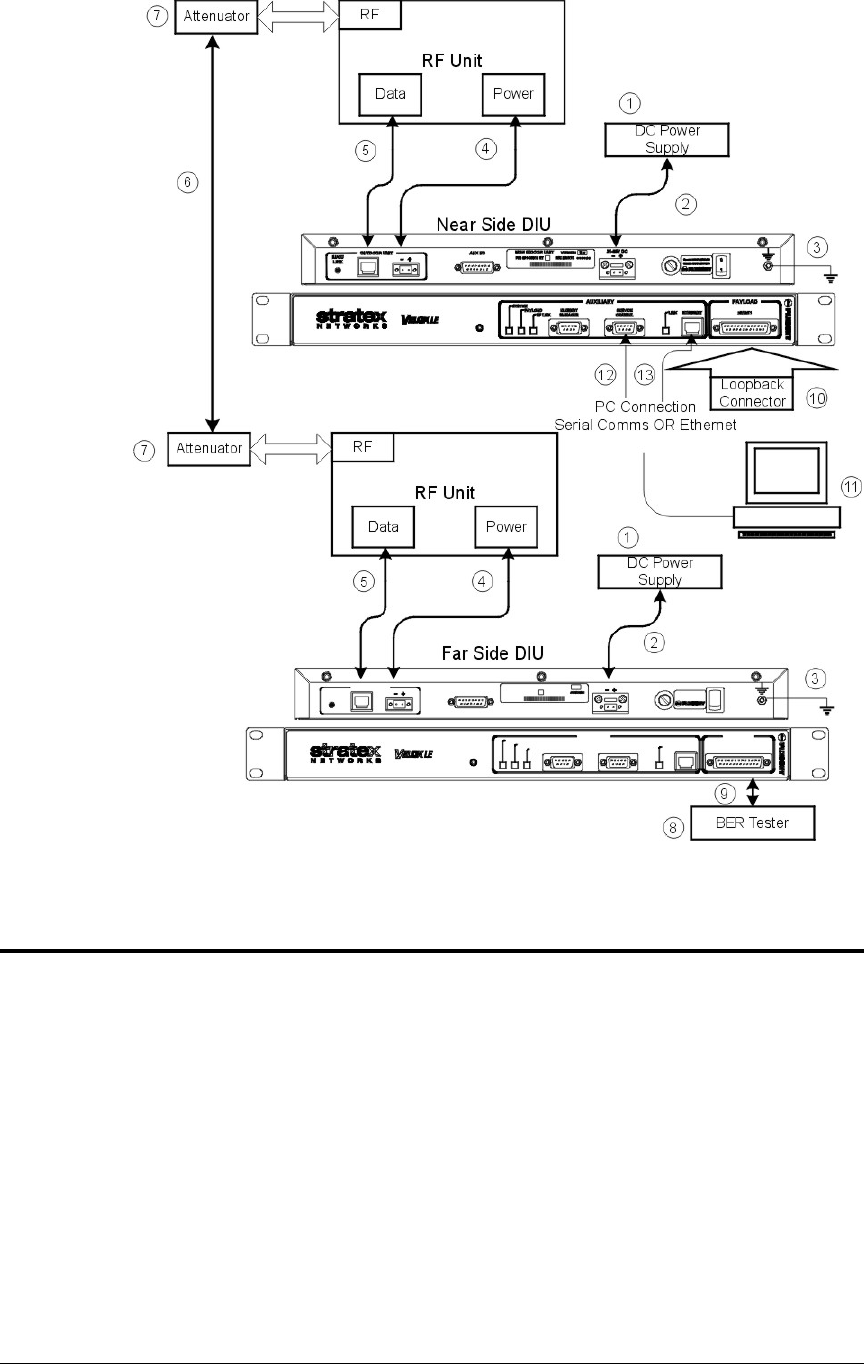
Velox LE Installation and Operations Manual
862-02411 February 04 4-15
Figure 4-5. Velox LE System Connection for T1/E1 Bench Test (with PC)
Site Installation
This section assumes that pre-planning of the link has been completed to ensure correct
location and orientation of antennas and that the antenna support structure
(tower/mast/building) has appropriate cable attachment and grounding connection
points. For more information on pre-planning, refer to the Stratex Networks’
Microwave Radio Systems Standard Practices Guide.
It is suggested that a record of the equipment installed and other installation information
is made. A typical installation record is shown in Table 4-8 on page 4-27.

Chapter 4. Hardware Installation
4-16 862-02411 February 04
Installation procedures are listed in the following order:
1. Installing the antenna.
2. Installing the RFU, which includes:
• Grounding.
• Fitting lightning surge suppressor between the RFU and the antenna.
• Making up the RF Cable between the RFU and the antenna.
3. Installing the DIU, which includes:
• Grounding.
• Making-up and fitting the power supply cables.
4. Making-up and installing the cables between the DIU and the RFU, i.e.:
• DIU/RFU Data Cable.
• DIU/RFU Power Cable.
5. Making-up and installing optional cables, as follows:
• Payload Cables.
• Auxiliary I/O.
• Service Wayside Channel.
• Element Manager.
• RFU RSSI cable.
6. Commissioning, which includes:
• Software set -up.
• Antenna alignment.
!
WARNING
Before proceeding with an installation review the health, safety and hazard
information given in Table 4-1 on page 4-1, Table 4-2 on page 4-2 and Table 4-3 on
page 4-2.
Installing the Antenna
Stratex Networks offers antennas from several major manufacturers.
!
CAUTION
Antennas must be installed in accordance with the manufacturer’s instructions, a copy of
which is incl uded with every antenna.
Before going to site, check that you have all the required installation tools as
recommended by the antenna manufacturer, and that you have the antenna orientation
and initial pointing data.
Installing the ORFU
The ORFU installation comprises the following:
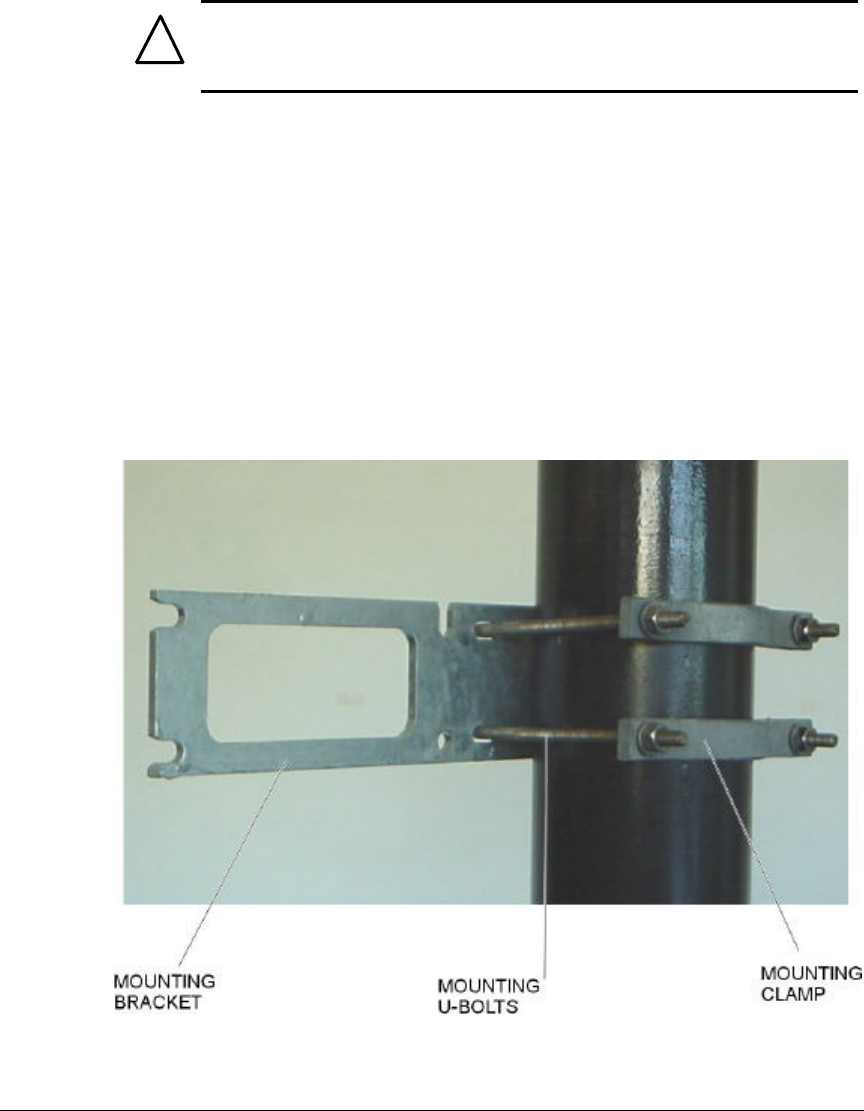
Velox LE Installation and Operations Manual
862-02411 February 04 4-17
• Install the RFU mounting bracket onto the antenna mast. Note that the mast
diameter must be between 50 mm (2”) and 102 mm (4½”).
• Mount and secure the RFU on the mounting plate.
The ORFU may be mounted indoors, utilising an optional rack mount adapter (not
included as a standard item) at the base of a tower for convenient access. However,
before using this method consideration must be given to the distance between the RFU
and the antenna as long lengths of RF cable could have a compromising affect on
system sensitivity. In addition, link costs would increase due to the high cost of such
cable.
!
CAUTION
Ensure that the Antenna Mast is adequately grounded for Lightning Protection.
Follow these steps to install the RFU:
1. Install the system antenna in accordance with the manufacturer’s instructions.
2. Unpack the RFU mounting bracket assembly from the accessories box:
• Remove the nuts, spring washers and flat washers from the Mount U-bolts.
• Assemble the Mounting U-bolts to the the Mounting Bracket Clamp.
3. Referring to Figure 4-6:
• Slide the U-bolts around the mast/pole and fit the Mounting Bracket Clamps.
• Fit the 4 x M8 flat wash ers, spring washers and nuts onto U-bolt threads and
finger tighten.
• Using a 13 mm AF wrench, tighten the M8 nuts until the bracket is secure.
Figure 4-6. Installing the RFU (1)
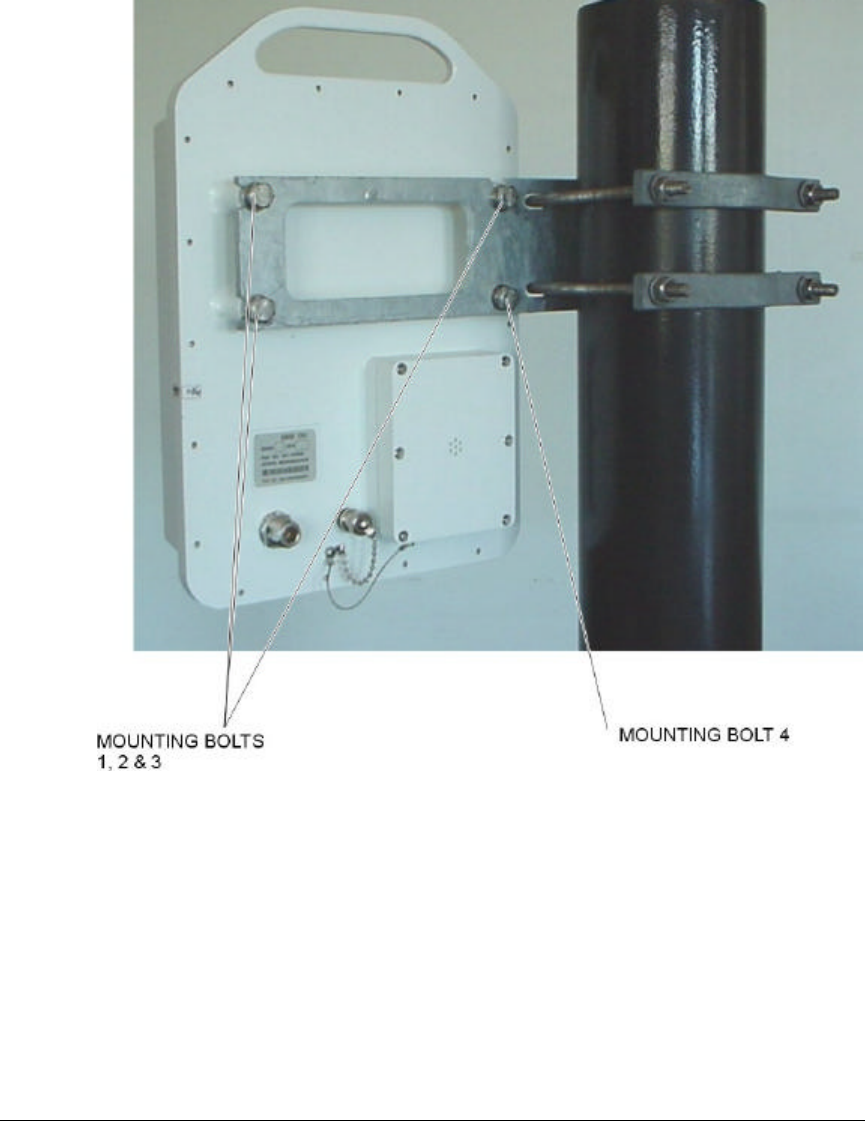
Chapter 4. Hardware Installation
4-18 862-02411 February 04
4. Refer to Figure 4-7:
• Loosen Mounting Bolts (1), (2) and (3) on the back of the RFU.
• Remove Mounting Bolt (4).
• Slide the RFU onto the Mounting Bracket so that the threads of the loosened
bolts engage in the slotted holes in the Mounting Bracket.
• Replace Mounting Bolt (4).
• Secure the RFU by tightening Mounting Bolts (1), (2), (3) and (4).
Figure 4-7. RFU Installation (2)
5. Ground the RFU as follows:
• Connect the RFU to the pole electrically by connecting the earth cable or strap
between the pole earth and the RFU Ground Terminal.
• OU ground lug: 10-8 (10 square mm for wire and hole big enough for M8
thread).
6. Connect the type-N RF output connector to the system antenna through an in-line
lightning protection unit in areas with lightning activity.
7. Weatherproof connectors using an ultra violet protective, self-vulcanising tape.
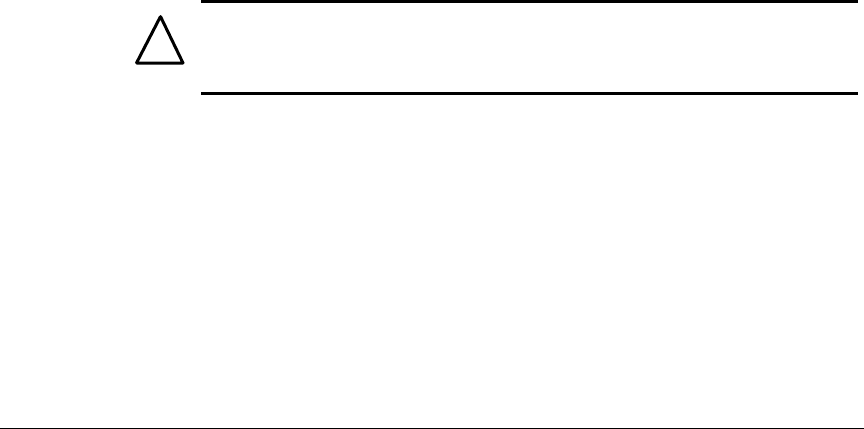
Velox LE Installation and Operations Manual
862-02411 February 04 4-19
Installing the IRFU
The Velox LE 2410, Velox LE 2450, Velox LE 5810 and Velox LE 5850 outdoor
RFUs are also available as 1RU high IRFUs, Velox LE 2410i, Velox LE 2450i, Velox
LE 5810i and Velox LE 5850i, that can be rack mounted in a 19” rack.
Note that when installing an IRFU consideration must be given to the distance between
the IRFU and the antenna as long lengths of RF cable could have a compromising affect
on system sensitivity. In addition, link costs would increase due to the high cost of such
cable.
1. Install the IRFU as follows:
• Slide the IRFU into the 19" rack and secure to the rack using four (4) M6 x 18
mm screws and washers provided.
• Ground the IRFU by connecting the ground cable or strap between the station
ground and the ground terminal on the IRFU front panel.
2. Install the system antenna (see Installing the Antenna on page 4-16). Note that the
RSSI BNC connector is on the front panel of the IRFU.
3. Connect IRFU to antenna noting the following:
• Connect the RF cable or waveguide outer conductor to the pole lightning earth
electrically before it enters the building in which the equipment is housed.
• Connect the type-N RF output connector on the front panel to the system
antenna through an inline lightning protection unit.
• The N -Type connector is used to connect to the antenna, typically using
coaxial transmission line or flexible waveguide via a launch/N-type adaptor.
• 1/2" or 5/8” coaxial cables are recommended. Coaxial cable that is 7/8” or
larger can exhibit "moding" at 5.8 GHz and is not recommended for 5.8 GHz
radios.
• Do not use right angle N-type connectors with the radios: they may present
high loss.
• Do not use low quality cables. Some cable types, such as RG-8, may have too
high a loss at 5.8 GHz.
• Elliptical waveguide is recommended for longer feeder runs to minimize
losses.
4. Weatherproof the connectors using an ultra violet protective, self-vulcanising tape.
!
CAUTION
Ensure that the Antenna Mast is adequately grounded for Lightning Protection.
Installing the DIU
This section describes the recommended installation procedure for the DIU. The DIU is
designed for mounting in the DIN 41494 (19") racking standard and occupies a 1RU
high slot. Desktop mounting is also possible.
The DIUs payload (nT1, nE1 and Ethernet) and Service Channel (‘Wayside serial’) data
interfaces and Element Management interface are located on the front panel. Input
Power, Auxiliary alarm and ‘DIU/RFU Interconnect’ interfaces are located on the rear

Chapter 4. Hardware Installation
4-20 862-02411 February 04
panel for the Velox LE DIU, suitable for rack installations and on the front panel for the
rest of the Velox LE 10, Velox LE 25 and Velox LE 50 DIUs, simplifying accessibility.
Install DIU as follows:
1. Install the DIU in the rack:
• Slide the DIU into the 19" rack.
• Secure to the rack using four (4) M6 x 18 mm screws and washers provided.
2. Ground the DIU by connecting the ground strap between the station ground and the
Ground Terminal on the DIU rear/front panel (depending on product variant). This
is required for safety and to minimize radiated emissions.
3. DC power connectio n:
!
WARNING
The power supply specification for the current Velox LE 10, Velox LE 25 and all
Velox LE 50 DIUs is 21 to 58 Vdc whereas older Velox LE 10, Velox LE 25 DIUs
and all other DIUs require 21 to 56 Vdc.
ENSURE that you comply with the power supply specification printed above the
POWER connector on the DIU.
DC power supply grounding: Positively or negatively grounded
Power consumption 40 W typical (35 W Velox LE 2400/5800), 45 W maximum.
• Prepare DC power supply cable.
Table 3-9 on page 3-12 (Velox LE 120 Ohm and Velox LE 75/120 Ohm).
Table 3-10 on page 3-12 (Velox LE 10, Velox LE 25 and Velox LE 50 ).
• Connect cable to the DC supply (Voltage range as indicated on the DIU)
through a minimum 2 A slow blow circuit breaker. Check the supply voltage
using a multimeter.
• On Velox LE 120 Ohm and Velox LE 75/120 Ohm ensure ON/OFF switch on
rear panel is set to 0 and connect DC power cable to 21-58 Vdc connector on
rear panel. Tighten connector screws.
• Do NOT connect DC power cable to Velox LE 10, Velox LE 25 and Velox LE
50 as these units DO NOT have an ON/OFF switch, i.e. connecting the DC
power supply will power-up the radio.
4. Payload Data Ports:
Balanced 120 Ohm (DB25) – Prepare cable (refer 25-Way D-type
Connections (Balanced 120 Ohm, Unbalanced 75 Ohm)
Balanced 120 Ohm and unbalanced 75 Ohm termination via 25-way D -type connectors
are available on all Velox LE DIUs. The standard termination is 120 Ohms on all DIUs.
Unbalanced 75 Ohm is an optional termination, which on the Velox LE 10 and Velox
LE 25 units must be requested from the supplier when ordering the system and is user
configurable on the Velox LE 50.
• on page 3-3) and connect to front panel connector(s).
Balanced 110 Ohm (RJ48) – Prepare cables (refer
Table 3-2: Pin Connections for Unbalanced 75 Ohm Termination on 25 -Way
D-Type Connector
D-Type Payload
Connector Pin # Pin Name Tributary Direction Remarks
1 Rx GND/Earth N/A
2 RTIP2 2 RX +

Velox LE Installation and Operations Manual
862-02411 February 04 4-21
Table 3-2: Pin Connections for Unbalanced 75 Ohm Termination on 25-Way
D-Type Connector
D-Type Payload
Connector Pin # Pin Name Tributary Direction Remarks
3 RRING2 2 RX - Connect to Pin 1
4 Tx GND/Earth N/A
5 TTIP2 2 TX - Connect to Pin 4
6 TRING2 2 TX +
7 GND/Earth N/A
8 Rx GND/Earth N/A
9 RRING1 1 RX +
10 RTIP1 1 RX - Connect to Pin 8
11 Tx GND/Earth N/A
12 TRING1 1 TX - Connect to Pin 11
13 TTIP1 1 TX +
14 TRING3 3 TX - Connect to Pin 16
15 TTIP3 3 TX +
16 Tx GND/Earth N/A
17 RRING3 3 RX+
18 RTIP3 3 RX- Connect to Pin 19
19 Rx GND/Earth N/A
20 TTIP4 4 TX-
21 TRING4 4 TX+ Connect to Pin 22
22 Tx GND/Earth N/A
23 RTIP4 4 RX+
24 RRING4 4 RX- Connect to Pin 25
25 Rx GND/Earth N/A
• RJ48 Connections(Balanced 120 Ohm and Unbalanced 75 Ohm ) on page 3-4
and connect to front panel connectors.
• Unbalanced 75 Ohm (BNC) – Prepare cables (refer Unbalanced Payload Data
(BNC) (Velox LE 75/120 Ohm Only) on page 3-6 and connect to front panel
connectors.
5. Auxiliary In/Out port (optional). If required prepare cable and connect to DIU front
panel (refer Auxiliary I/O (10) on page 3-10 for cable preparation information).
6. Service Channel (Wayside) Serial Port (optional). ). If required prepare cable and
connect to DIU front panel (refer Service (Wayside) Serial Data Channel (4) on
page 3-8 for cable preparation information).
7. Connect the Element Manager port using the supplied Lap Link Cable (660-
03349).
8. Ensure that all connector locking screws are secured
Installing the DIU to RFU Data and Power Cables
1. Using a 10 mm Allen key open the lid on the RFU connection box (ORFU only).
2. Prepare and install DIU to RFU Data Cable (refer to Table 3-7 on page 3-10 for
wiring data and Table 4-5 on page 4-7 for recommended cables).

Chapter 4. Hardware Installation
4-22 862-02411 February 04
3. Using the two supplied connectors blocks (Green), prepare DIU to RFU Power
Cable refer to Table 4-5 on page 4-7 for recommended cables).
!
CAUTION
DO NOT CONNECT the DIU to RFU Power Cable while power is applied to the
IDU. The DIU can be powered without the RFU connected; however, power should
be removed before the RFU is connected and reapplied only after the Power Cable is
connected and the RFU is properly terminated at the RF port, i.e. antenna connected.
4. Connect the Power Cable to the DIU and RFU connectors.
5. Use cable ties at regular intervals to secure the Data and Power cables to the mast.
6. Close and secure the RFU connection box lid using a 10 mm AF Allen key.
Commissioning
General
This section describes the procedure for software set-up and antenna alignment. The
set-up is done using a laptop/PC running the supplied NCT Graphical User Interface
(GUI) software. See Chapter 5: NCT Installation for details on installing the NCT/GUI.
Use of the NCT/GUI is described in the Online Help file supplied with the software.
Equipment Required for Commissioning
The following tools and instruments are required for software set -up and aligning the
antenna:
• RSSI cable (supplied part number 660-03405)
• Multimeter (measurement of RSSI)
• Wrench/spanner (see appropriate details in installation chapter depending on the
antenna being used)
• PC with NCT software and Lap Link cable (supplied part number 660-03349). PC
should be configured for applicable connection to DIU (serial cable or Ethernet).
• Binoculars (optional) used for locating the far end site. This will assist in the
antenna alignment operation.
• GPS or Standard Compass (optional) used for locating the far end site. This will
assist in the antenna alignment operation.
• Bit Error Rate Tester and connecting leads.
• Cellular phone or two-way radios (for talking too far-end crew and tower crew).
• Loop Back connector.
Information Required
You should know:

Velox LE Installation and Operations Manual
862-02411 February 04 4-23
• The proposed frequency channel plan for each station. Also see section Frequency
Plans on page 8-5.
• The expected receive signal level based on the chosen system configuration and a
path loss analysis.
Antenna Alignment
Introduction
The RFU should be installed on both sites before alignment starts. Perform the
following steps at both stations:
1. Switch the DIU power ON.
2. Run the NCT Soft ware application.
3. Configure the radio channel plan as required.
4. Set the transmitted power to maximum.
5. Perform a RF loop back test at each site before starting the alignment procedure.
Alignment Procedure
1. Locate the far site and point the antenna to the antenna at the far site, as accurately
as possible using selected method (binoculars, compass, GPS).
2. Connect the Multimeter to the RSSI connector on the RFU using the supplied
RSSI cable and set the Multimeter to measure volts.
3. Note the RSSI level and refer to Figure 4-8, Figure 4-9 and Figure 4-10 below for
received power level.
4. Loosen the antenna and align the antenna until the maximum RSSI is attained.
5. Secure the antenna.
6. Measure the RSSI level and record the value.
7. Compare with the value with that calculated for the link, i.e. using the path loss
calculation done when planning the link.
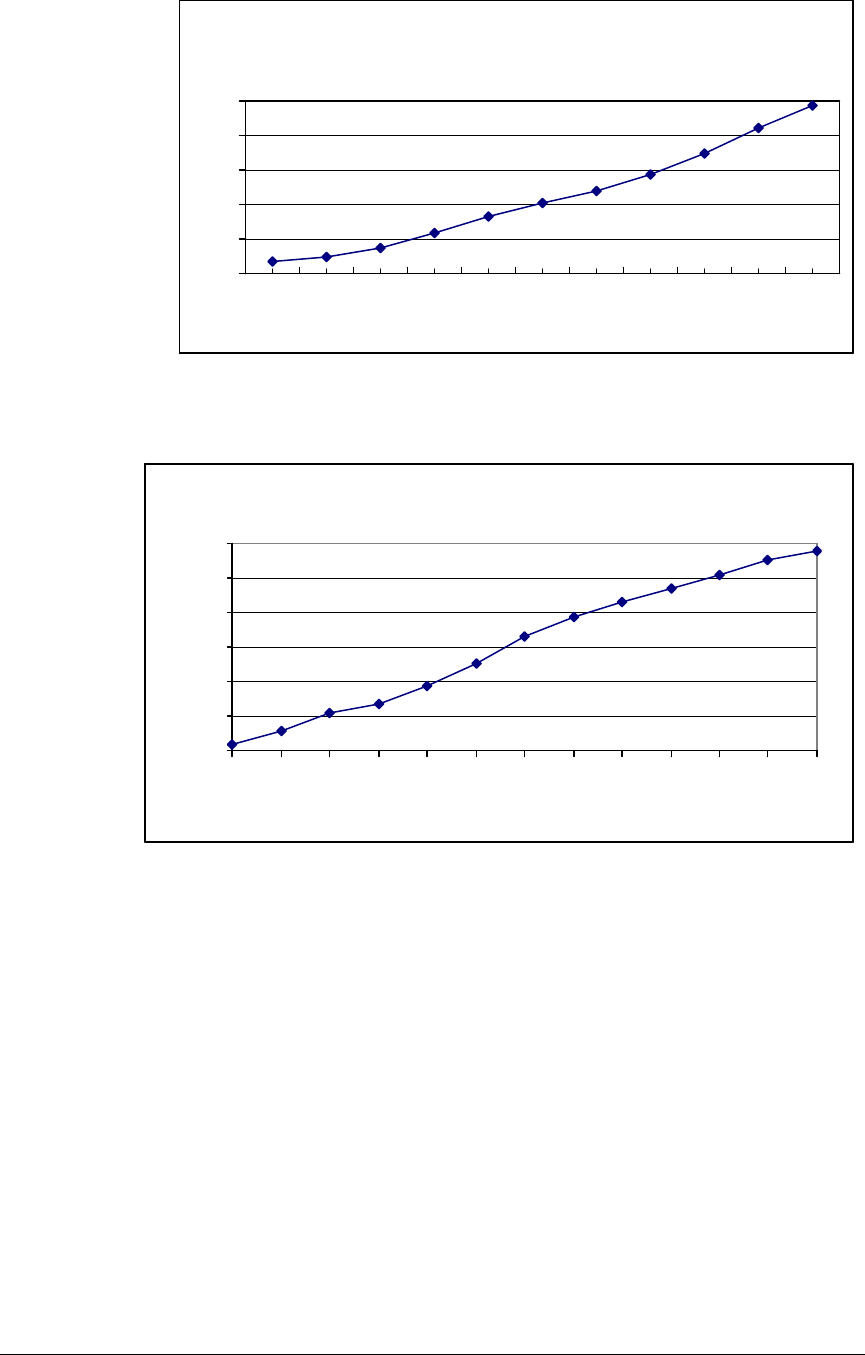
Chapter 4. Hardware Installation
4-24 862-02411 February 04
Typical Velox LE 58xx RFU RSSI Voltage vs
Received Signal Power (5.8GHz)
0.4
0.6
0.8
1
1.2
1.4
-80 -75 -70 -65 -60 -55 -50 -45 -40 -35 -30
Received Signal Power [dBm]
RF Unit RSSI Voltage
Figure 4-8. Typical Velox LE 5810 and Velox LE 5810i RSSI Voltage
versus Received Signal Power
Typical Velox LE 24xx RFU RSSI Voltage vs
Received Signal Power
0.6
0.8
1
1.2
1.4
1.6
1.8
-100 -95 -90 -85 -80 -75 -70 -65 -60 -55 -50 -45 -40
Received Signal Power [dBm]
RF Unit RSSI Voltage
Figure 4-9. Typical Velox LE 2410 and Velox LE 2410i RFU RSSI Voltage
as a function of RF input power level
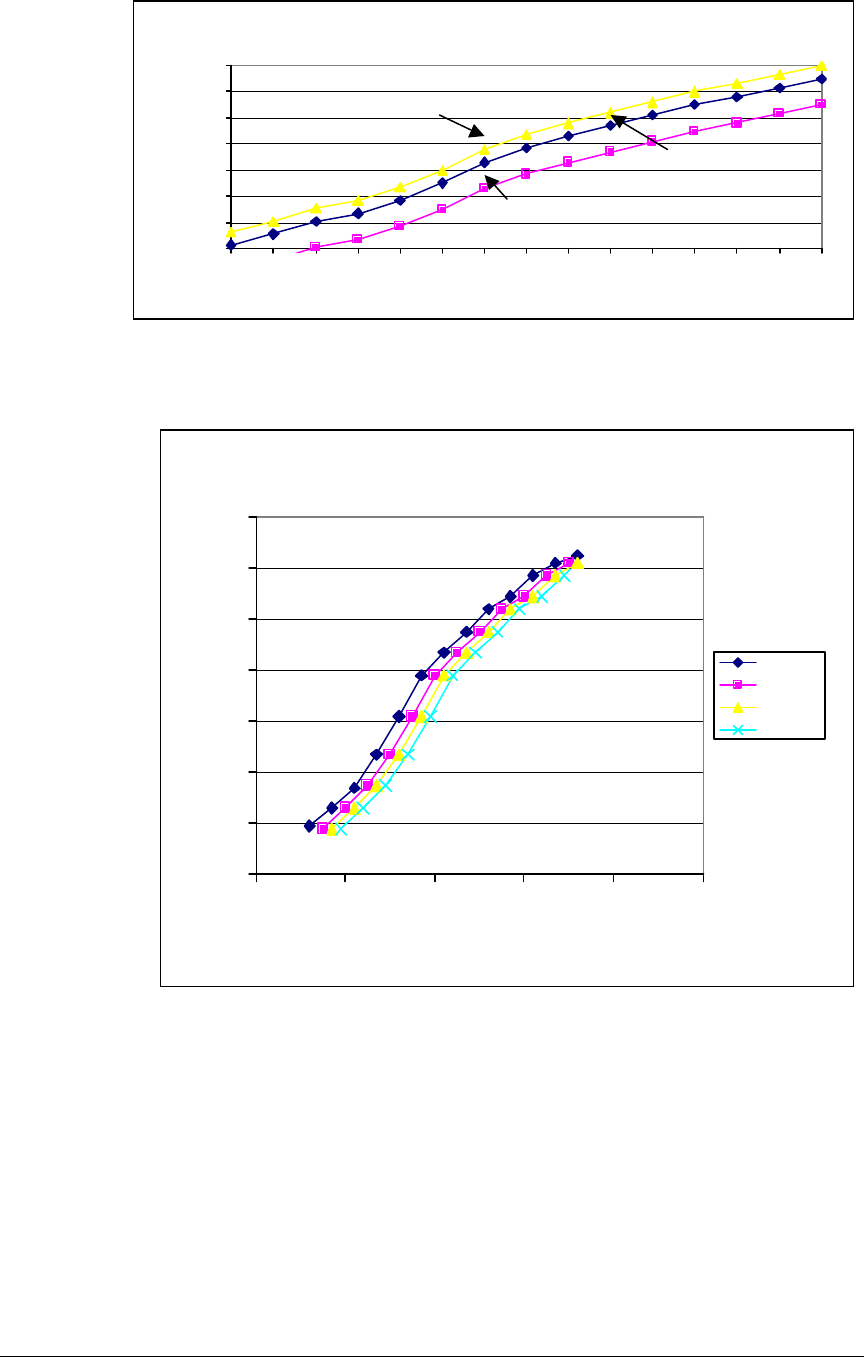
Velox LE Installation and Operations Manual
862-02411 February 04 4-25
Typical Velox LE 5850 and 5850i RFU RSSI Voltage vs
Received Signal Power
0.6
0.8
1
1.2
1.4
1.6
1.8
2
-100 -95 -90 -85 -80 -75 -70 -65 -60 -55 -50 -45 -40 -35 -30
Received Signal Power [dBm]
RF Unit RSSI Voltage
Figure 4-10. Typical Velox LE 5850 and 5850i RFU RSSI Voltage as a
Function of RF Input Power Level (note the different bandwidths)
Typical Velox LE 2450 and 2450i RFU RSSI Voltage
vs Received Signal Power
0.6
0.8
1
1.2
1.4
1.6
1.8
2
-100 -80 -60 -40 -20 0
Received Signal Power [dBm]
RF Unit RSSI Voltage
2.3MHz
4.6MHz
7 MHz
11.2 MHz
Figure 4-11. Typical Velox LE 2450 and 2450i RFU RSSI Voltage as a
Function of RF Input Power Level (note the different bandwidths)
From the Figure 4-8 to Figure 4-11:
• -80 dBm Average 0.436 ± 0.029 V, which relates to a MIB (Management
Information Base) RSSI of 95 ± 1 dBm (see Notes below)
• -30 dBm Average 1.333 ± 0.047 V, which relates to a MIB RSSI of 54 ± 2 dBm
(see Notes below).

Chapter 4. Hardware Installation
4-26 862-02411 February 04
The front panel RF Link LED, the Received Signal Strength Indicators (RSSI: on
NCT, via SNMP or as an Electrical signal on the RFU), Carrier-detect (NCT,
SNMP) and Frame Lock (NCT, SNMP) indicators are available to assist with link
installation and alignment.
NOTE 1 For the Velox LE 2400, Velox LE 5800, Velox LE 2410i and Velox LE
5810i RFUs, the RSSI values displayed in the MIB are representative of the signal
level measured over a 200kHz BW. Add ~20dB to the MIB value for a wanted
spread spectrum signal. The NCT / GUI will do this adjustment automatically and
will therefore always display the correct RSSI value.
NOTE 2 Due to the technique used to calculate the RSSI level of a wanted signal,
the measured RSSI level can differ from the actual value with up to ±3 dB.
Set Transmitted Power Level
• It is good practice to match received power levels by adjusting transmitted powers
if co-located systems are being installed. This is important to avoid interference
between co-located systems. An attenuator can be fitted between the RFU and the
antenna if the power level cannot be sufficiently reduced. The dBm output at the
RFU N-type connector (socket) levels are set-up via the NCT or using a SNMP
Management application.
Diagnostics (Loopback Modes)
This section describes the usage of the loop back modes.The purpose of loop back is to
return the payload data to its sender, thus looping it back. The payload data is never sent
to the other radio in the link. This can be done at two stages in the Velox LE products;
Baseband/IF Loopback
BaseBand loopback loops the payload data back to the sender just before it reaches the
radio’s RF-modem. BaseBand loopback can be used to verify all the data cables and
connectors and the radio’s interface circuitry.
RF Loopback
RF loopback loops the final transmitted microwave signal back to the radio’s
microwave receiver. RF loopback verifies the RF-modem and the transceiver line-ups.
The RF loop back works best in Band Plan B; using it in other band plans is not
guaranteed to work.
!
CAUTION
The signal does reach the antenna connector and is thus still transmitted if an
antenna is connected.
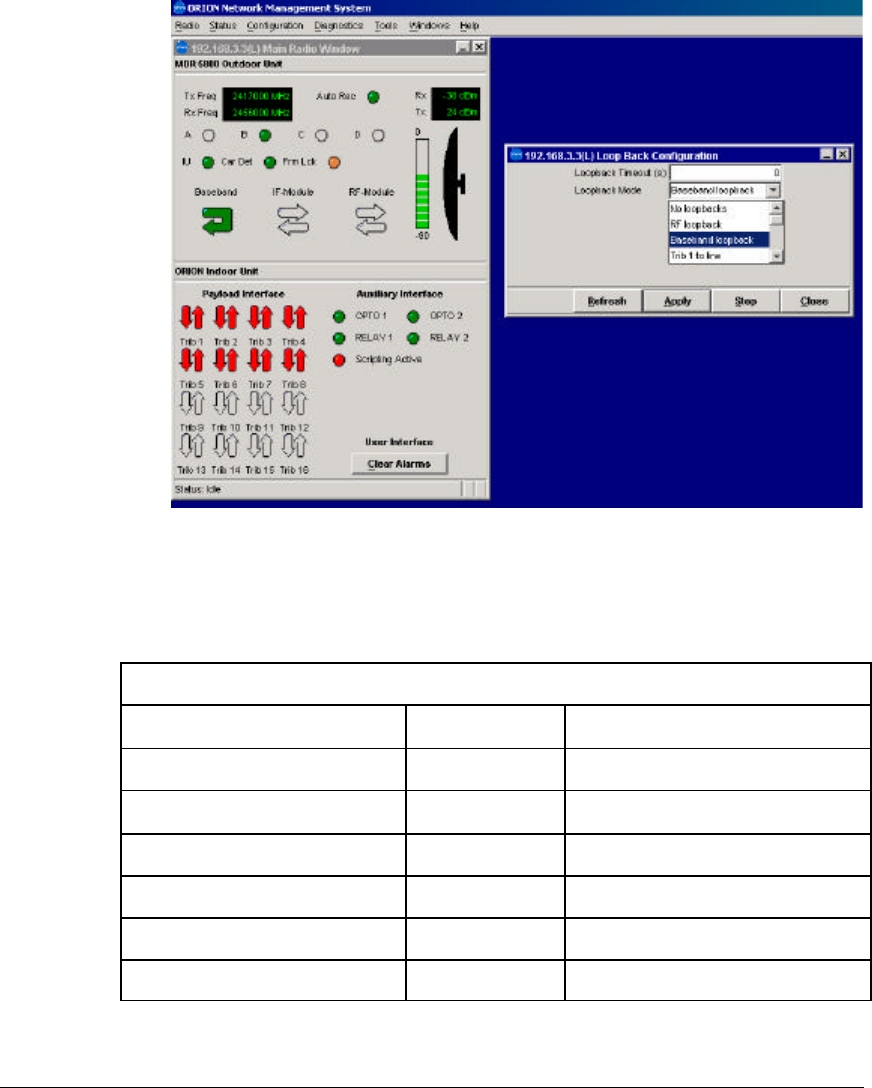
Velox LE Installation and Operations Manual
862-02411 February 04 4-27
Loopback Procedure
• Connect DIU to PC via the Element Manager Port or Ethernet port. Also see : NCT
Installation on page 5-1 and Element Manager Point -to-Point Protocol Serial
Communications Set-up on page 6-1
• Open the NCT application.
• Go to the “Diagnostics” dropdown list and click on the “Loopback Window”.
• Choose the required option from the dropdown list.
eg. Baseband Loopback window.
Figure 4-12. Baseband Loopback window
Velox LE Installation Record
A typical Installation Record is shown below in Table 4-8.
Table 4-8. Velox LE Installation Record
Parameter Unit Site A Site B
Site Name
Antenna Type
RF cable length Meters
Lightening protection unit Yes/No
Interconnecting cable length Meters
RFU serial number NA

Chapter 4. Hardware Installation
4-28 862-02411 February 04
DIU serial number NA
RFU grounded Yes/No
DIU grounded Yes/No
Power Supply Volts DC/AC
Date Name Signature
Installed by
Approved by
Velox LE Test Record
A suggested Test Record sheet is shown in Table 4-9 below.
Table 4-9. Velox LE Test Record Sheet
Parameter Unit Site A Site B
Frequency channel plan:
Transmit
Receive
NOTE 1: C is NOT applicable for the
Velox LE 2400.
NOTE 2: FCC requirements (U.S. only)
page 2.
A/B/C/D
A/B/C/D
If D – List Transmit and
Receive Frequencies [MHz]
Transmitter output power (NOTE 2) dBm
Receiver input level (ON) Volts
Receiver input level (ON) dBm
Receiver input level (OFF) Volts
Receiver input level (OFF) dBm
Calculated input level dBm
Fade margin dB
Frame Lock indicator Colour
Fixed attenuator dB
BER-test
Hours
BER
Alarm Indicators Clear (Yes/No)

Velox LE Installation and Operations Manual
862-02411 February 04 5-1
Chapter 5 : NCT Installation
Connecting to the Velox LE
This can be done by two methods:
• By means of the Ethernet port.
• Serial Cable Connection. See Element Manager Point-to-Point Protocol Serial
Communications Set-up on page 6-1.
NCT Software Installation
Scope
This section provides brief instructions on how to install the Velox LE NCT. A detailed
HTML-based help document can be found on the NCT installation CD supplied with
new radios.
Introduction
The purpose of the Network Configuration Tool, hereafter called the NCT, is to allow
you to configure, manage or interrogate the following primary functional elements of a
Digital Radio Link:
• DIU
• RFU
The NCT is a PC-based software package that provides you with a graphical interface
that is used to perform on-site element management of a digital radio system. It allows
you to configure, manage and interrogate the system by selecting various menus and
options.
The NCT comprises hardware and software, whichis known as the NCT Terminal.
The NCT Terminal is the principal system support equipment associated with the radio
for system installation and commissioning.
The NCT connects to a designated NCT Terminal port (ELEMENT MANAGER) on
the front panel of the DIU, by means of a serial data interface (supplied Lap Link
Cable). It can also connect to any number of DIUs interconnected through an IP
network.
The NCT communicates with SNMP agent software that is contained in each DIU. The
NCT communicates with the agent’s software: the software enables a unit to interpret

Chapter 5. NCT Installation
5-2 862-02411 February 04
MIB (Management Information Base) commands via SNMP (Simple Network
Management Protocol).
The NCT application supplied with older Velox LE radios have been replaced with
the Java-based Velox LE NCT. The o lder NCT does not support the new Velox LE
series radios and it is highly recommended to replace the old NCT with the new
NCT version.
System Requirements
The system requirements for the Velox LE NCT PC are as follows:
• P III 450 MHz or higher CPU
• 128 MB RAM
• 20 MB Free Hard disk space
• CD-ROM Drive
• Win 98, 2000, NT or XP Operating System (Linux optional)
Installing the NCT
General
The NCT has been developed on the Java platform from Sun Micro Systems. This
requires the installation of a Java Runtime Environment (JRE) on the PC from where
the NCT will be used.
The installation files for the NCT and the JRE are provided on the installation CD that
is shipped with the Accessories that accompany each Velox LE Radio (DIU and RFU).
The supplied installation files allow the NCT to be set up on any WIN32 system
(Windows 98, NT, 2000, XP). If required, a special installation can also be provided
which would allow the NCT to be installed on a system using a Linux operating system.
Note that the NCT updates are available from the following Web Site:
• www.stratexnet.co.za/updates
JRE Installation
Complete the following steps to set up the required JRE on the required PC:
1. Browse to the //Velox LE NCT/JRE folder in the root of the installation CD
2. Run the j2re-1_3_1_02-win.exe installation application
3. Follow the user prompts in the JRE installation application to set up the JRE in the
preferred folder on the PC
NCT Installation
After installing the JRE on the PC, complete the following steps to install the NCT on
the PC:

Velox LE Installation and Operations Manual
862-02411 February 04 5-3
1. If a previous version of the Velox LE NCT have been installed on the target PC,
first uninstall the previous version
2. Browse to the //Velox LE NCT/Setup folder in the root of the installation CD
3. Execute the Stratex_Velox LE NCT_vXpXX.exe installation application
4. Follow the user prompts in the NCT installation application to set up the NCT in
the preferred folder on the PC
The NCT should now be installed on the target PC and should be available for selection
through the Start Programs menu option.
NCT Uninstall
Access Start/Velox LE NCT and select the Uninstall option to uninstall the NCT from
the PC. This action removes all installed files, menu items and registry entries from the
PC.
Help documentation
The HTML based help documents for the Velox LE NCT application are available on
the installation CD at the following path: //Velox LE NCT/help/Velox LE NCT
Help.htm. Open the Help using an Internet browser, e.g. MS Internet Explorer.
The Help can also be opened from the Windows Start folder created for the Velox LE
NCT or through the Help/Contents menu in the Velox LE NCT application.
Configure Radio using NCT
Use the NCT help files for information on how to set -up the Velox LE system. Follow
“Getting Started” in the dropdown menu Help/Contents of the Velox LE NCT.

Velox LE Installation and Operations Manual
862-02411 February 04 6-1
Chapter 6 : NCT PC Set-up
Element Manager Point-to-Point Protocol Serial
Communications Set-up
Introduction
This section summarises how to set up a network connection using Point-to-Point
Protocol (PPP) between a PC and the Element Manager port on the Velox LE DIU. It
lists how the connection can be set -up and configured to allow data transfer and SNMP-
based control of the Velox LE DIU.
The procedures given act as guidelines only and may differ from one version of
Windows to the next. If further assistance is required, consult Help for your
particular MS Version.
Adding Dial-up Networking : Windows 2000
The installation procedure documented here is based on the procedure that should be
followed for Windows 2000.
1. Click on “Start” on the desktop “Start bar”.
2. Select “Settings” menu item.
3. Select “Network and Dial-up Connections” menu item.
4. Select “Make New Connection” menu item.
5. The “Network Connection Wizard” window will open.
6. Click “Next” button.
7. Select “Connect directly to another computer” and press the “Next” button.
8. Set the dialup connection to connect as “Guest” and click the “Next” button.
9. Select the COM port that you intend to use to connect to the radio from the “Select
a Device” dropdown box and click the “Next” button.
10. Select the users that must be able to use this dialup connection and click the “Next”
button.
Enter the name of this dialup connection and click the “Finish” button. This name may
be any name of your choice. The connection is now installed, but its properties must
still be configured.

Chapter 6. PC Set-up
6-2 862-02411 February 04
Adding Dial-up Networking : Windows XP
The installation procedure documented here is based on the procedure that should be
followed for Windows XP.
1. Click “Start” on the desktop “Start bar”.
2. Select “Connect to” menu item.
3. Select “Show all connections” menu item.
4. Select “Create a new connection” menu item in the “Network Tasks” section.
5. The “New Connection Wizard” window will open.
6. Click “Next” button.
7. Select “Set up an advanced connection” and press the “Next” button.
8. Select “Connect directly to another computer” and press the “Next” button.
9. Set the dialup connection to connect as “Guest” and click the “Next” button.
10. Enter the name of this dialup connection and click the “Next” button. This name
may be any name of your choice.
11. Select the COM port that you intend to use to connect to the radio from the “Select
a Device” dropdown box and click the “Next” button.
12. Select the users that must be able to use this dialup connection and click the “Next”
button.
13. Click the “Finish” button. The connection is now installed, but its properties must
still be configured.
Set-up of Dial-up Connection Properties for Windows
2000/Windows XP
1. Click on “Start” on the desktop “Start bar”.
2. Select “Settings” menu item.
3. Browse to the newly added connection under the “Network and Dial-up
Connections” menu item and right click on the connection with your mouse.
4. Select the “Properties” item from the pop -up menu to bring up the properties
window.
5. Click on the “Configure” button below the “Select a Device” combo box in the
“General” properties tab window to bring up the “Modem Configuration” box.
6. Select “115200” form the “Maximum speed (bps):” drop down box and click
“Enabled hardware flow control” option. All other options must be deselected.
Click the “OK” button.
7. Click on the “Options” properties tab, select “Redial if line is dropped” and press
the “OK” button.
8. Browse to the newly added conn ection under the “Network and Dial-Up
connections”, and click on the connection with your mouse. This will bring up the
connection window. The values of the “Username” and “Password” fields does
not matter, press “Connect” to dial into the radio once the dialup cable has been
plugged into the DIU and the PC.

Velox LE Installation and Operations Manual
862-02411 February 04 6-3
For PCs with Windows NT, 95 or 98, check that a Network Adapter is installed.
9. Consult the Windows Help for assistance on setting up a serial comms network
adapter.
10. Double click “My Computer” icon.
11. Click on the “Help” dropdown box in “My Computer” window and choose the
“Help Topics” option.
12. Click the “Index” tab.
13. Enter “network adapters” in the search field box.
14. Follow the instructions to set up the adapter.
Adding a Modem for Windows NT
When working with a PC running a Windows NT, add a modem using the following
procedure:
1. On the desktop, double click “My Computer” icon.
2. Double click the “Modems” icon in t he “My Computer” window.
3. The “Modems Properties” window will open.
4. Click the “Add.” button in the “Modem Properties” window.
5. The “Install New Modem” window will open.
6. Click the checkbox labelled “Don’t detect my modem; I will select it from a list.”
7. Click the “Next” button.
8. Select the “(Standard Modem Types)” option in the “Manufacturers:” selection
box.
9. Select the “Dial -Up Networking Serial Cable between 2 PCs” option in the
“Models” selection box.
10. Select the COM port to use – click the “Next” button when the COM port has been
selected.
11. Click the “Finish” button to complete the installation.
Adding Dial-up Networking for Windows NT
1. On the desktop, double click “My Computer” icon.
2. Double click the “Dial-up Networking” icon in the “My Computer” window.
3. The “Add RAS Devices:” window will open.
4. Select the “COM1 – Dial-Up Networking Serial Cable” or “COM2 – Dial-Up
Networking Serial Cable” option in the “RAS Capable Devices:” selection box.
5. Click “OK” button.
6. The “Remote Access Setup” window will open.
7. Click on the “Continue” button.

Chapter 6. PC Set-up
6-4 862-02411 February 04
8. Whether COM1 or COM2 is selected, the window “Dial Idu – comX.rnk
Properties” will open. The set-up from here allows establishment of a PPP
connection between the computer and the DIUs Element Manager port.
9. Select the “Settings” tab and click the “Edit” button.
10. The “Edit Phonebook Entry” window will open.
11. Select the “Basic” tab in the “Edit Phonebook Entry” window.
12. Clear all fields and select “Dial-Up Networking Serial Cable be….” in the “Dial
using:” edit box.
13. Select the “Server” tab and “Edit Phonebook Entry” window.
14. Select “PPP: Windows NT, Windows 95 Plus, Internet” option in the “Dial-up
server type:” edit box. Select TCP/IP option in the “Networks protocols” group
box. All other fields should be clear.
15. Click the “TCP/IP Settings…” button.
16. The “PPP TCP/IP Settings” window will open.
17. Select “Server assigned IP address”, “Server assigned name server address” and
“Use IP header compression”.
18. Click the “OK” button.
19. The “Edit Phonebook Entry” window will be displayed.
20. Select the “Script” tab.
21. Select the “None” option in the “After dialling (login)” group box.
22. Select the “Security” tab.
23. Select “Accept any authentication including clear text” option.
24. Click the “OK” button.
Adding a Modem: Windows 95/98
1. When working with a PC running Windows 95/98, add a modem using the
following procedure:
2. On the desktop, double click “My Computer” icon.
3. Double click the “Modems” icon in the “My Computer” window.
4. The “Modems Properties” window will open.
5. Click the “Add.” button in the “Modem Properties” window.
6. The “Install New Modem” window will open.
7. Select “Other” option.
8. Click the “Next” button.
9. Click the checkbox labelled “Don’t detect my modem; I will select it from a list.”
10. Click the “Next” button.
11. Use the mdrnull.inf to add a serial cable modem connection capability to the PC or
laptop.
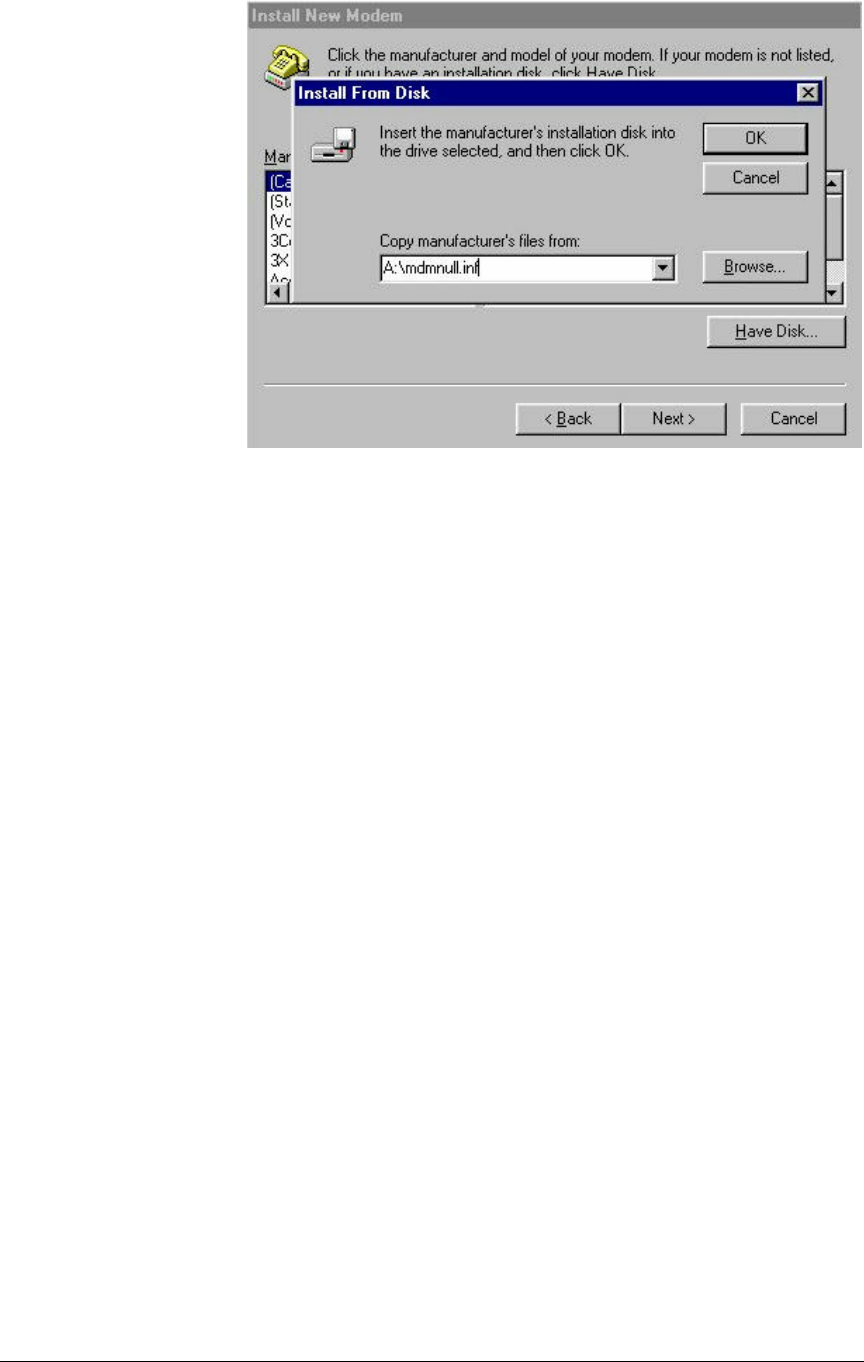
Velox LE Installation and Operations Manual
862-02411 February 04 6-5
Figure 6-1. Selecting t he Modem (Windows 95/98)
1. Once set-up, use the “Direct Connection Properties” window to set up the COM
port’s parameters.
2. Select the required COM port in the “Port” edit box.
3. Select “115200” and “Only connect at this speed” in the “Maximum speed” group
box.
4. Click the “OK” button.
5. The “Direct Connection Properties” window will open.
6. In the “Connection preferences” group box, select:
Data bits = 8
Parity = None
Stop bits = 1
All other option should be de-selected.
7. Click the “OK” button to finish.
Adding Dial-up Networking : Windows 95/98
After adding the modem, set up the connection properties using the following steps as a
guideline. This will allow establishment of a PPP connection between the computer
and the DIU s Element Manager port.
1. A Null_Modem connection should be available. If one doesn’t exist, double click
on the “Make New Connection” icon.
2. The “Null_Modem” window will open.
3. Select the “General” tab.
4. Select “Use country code and area code” and enter telephone number information.
5. Select “Direct Connection” option in the “Connect using:” group box.
6. Select “Server Types” tab.

Chapter 6. PC Set-up
6-6 862-02411 February 04
7. Select “PPP: Windows 95, Windows NT 3.5, Internet” option in the “Type of Dial-
up Server” edit box. Select TCP/IP option in the “Allowed networks protocols”
group box. All other fields should be clear.
8. Click the “TCP/IP Settings…” button.
9. The “PPP TCP/IP Settings” window will open.
10. Select “Server assigned IP address”, “Server assigned name server address”, “Use
IP header compression” and “Use default gateway on remote network”.
11. Click the “OK” button.
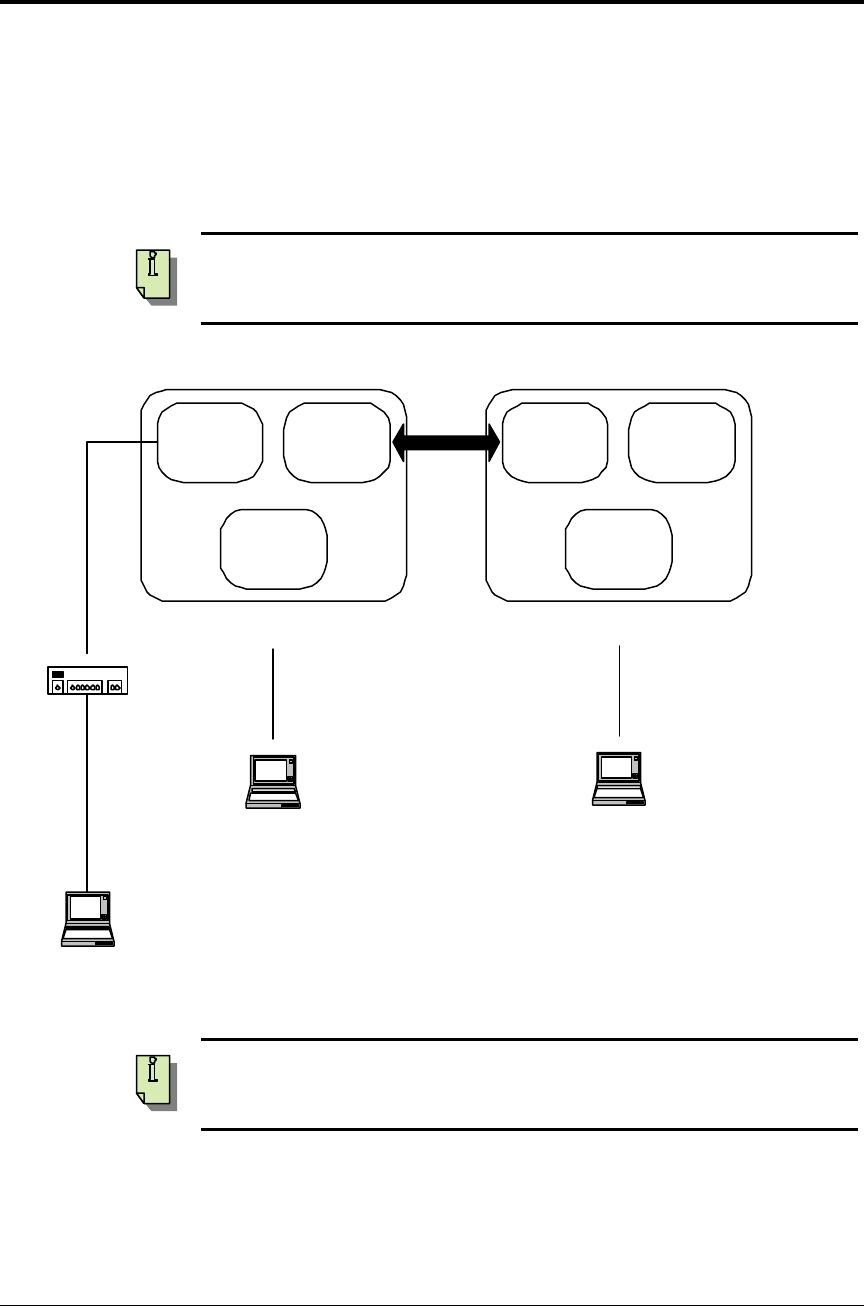
Velox LE Installation and Operations Manual
862-02411 February 04 6-7
IP Configuration of the Velox LE
BRIDGED Configuration: Input Address Assignment
Figure 6-2 shows the default (factory) network IP addresses assigned to the various
network ports on the Velox LE System: BRIDGED CONFIGURATION.
For most networks, the Bridged Configuration is the preferred IP configuration.
HUB
LAPTOP COMPUTER
192.168.1.2
192.168.2.2
192.168.4.2 192.168.4.3
192.168.3.3
192.168.1.3
PPP WIRELESS
ETHERNET
10BASE-T ETHERNET
10BASE-T
LAPTOP COMPUTER
PPP RS232
"NEAR"
LAPTOP COMPUTER
PPP RS232
"FAR"
BROWSER/NCT
192.168.3.2
(IP AUTO ASSIGNED)
"SERVER ASSIGNED"
BROWSER/NCT
192.168.1.4
(IP USER ASSIGNED)
BROWSER/NCT
192.168.2.3
(IP AUTO ASSIGNED)
"SERVER ASSIGNED"
Figure 6-2. Velox LE Bridging Configuration
Note that the netmask for all the 192.168.x.x addresses is 255.255.255.0.
Carrying out a Ping on a Bridged Network
To carry out a Ping, connect to DIU by using the modem dial-up connection. Once a
connection is established, open a Dos window and type ping 192.168.x.x. Where x.x is
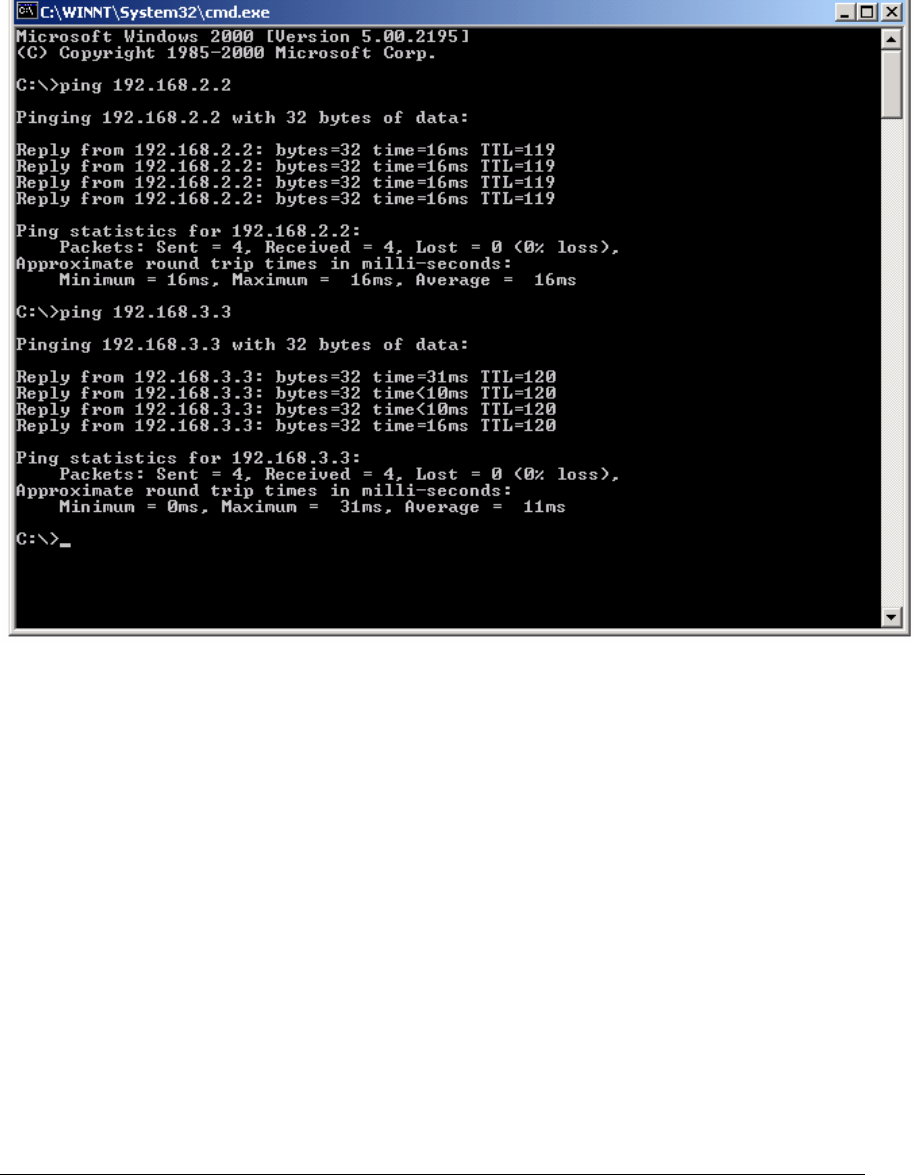
Chapter 6. PC Set-up
6-8 862-02411 February 04
the last two digits of the Ethernet IP Address of the equipment you want to ping. For
example in Figure 6-3 there are two Ping commands as follows:
• Ping 192.168.2.2, which is the Ethernet IP Address of the Element Manager in
“NEAR” system.
• Ping 192.168. 3.3, which is the Ethernet IP Address of the Element Manager in
“FAR” system.
Figure 6-3. Screen showing Example Pings
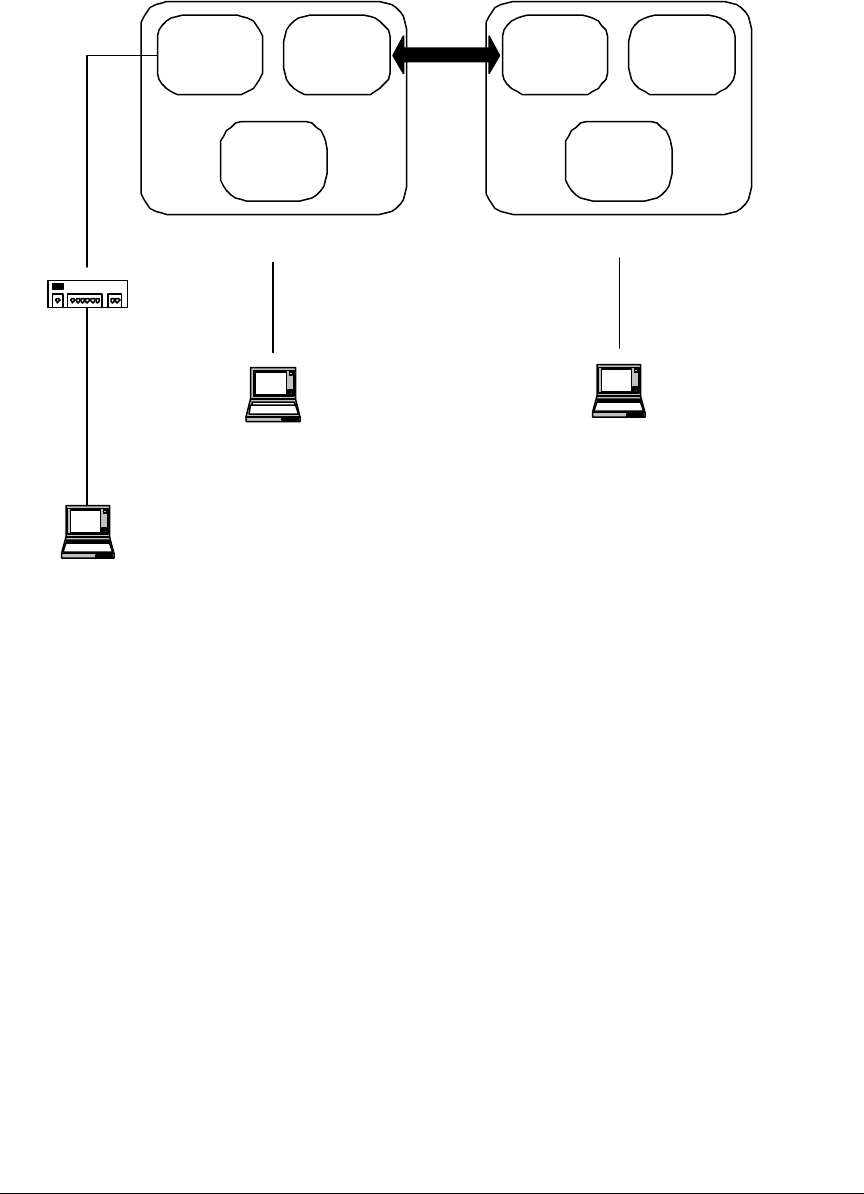
Velox LE Installation and Operations Manual
862-02411 February 04 6-9
ROUTED Configuration: Input Address Assignment
Figure 6-4 shows the default (factory) network IP addresses assigned to the various
network ports on the Velox LE System: ROUTED CONFIGURATION.
HUB
LAPTOP COMPUTER
10.2.1.2
10.13.1.1
10.10.9.9 10.10.9.10
10.12.1.1
10.11.1.2
PPP WIRELESS
ETHERNET
10BASE-T ETHERNET
10BASE-T
LAPTOP COMPUTER
PPP RS232
"NEAR"
LAPTOP COMPUTER
PPP RS232
"FAR"
BROWSER/NCT
10.12.1.2
(IP AUTO ASSIGNED)
"SERVER ASSIGNED"
BROWSER/NCT
10.2.1.3
(IP USER ASSIGNED)
BROWSER/NCT
10.13.1.2
(IP AUTO ASSIGNED)
"SERVER ASSIGNED"
Figure 6-4. Velox LE Routed Configuration

Velox LE Installation and Operations Manual
862-02411 February 04 7-1
Chapter 7 : Maintenance and Radio
Upgrades
Velox LE FTP Firmware Upload
Firmware Upload
Firmware can be uploaded to Velox LE DIUs using FTP uploads as well as by using the
"CVF Loader" or NCT software, available on the software CD or from the distributor.
Note the following:
• Username : anonymous
• Password : guest
The relevant MIB info is in the "mdrmteConfiguration" GROUP
• 1.3.6.1.4.1.1316.1.1.1.2.5 mdrmteFirmware.
• 1.3.6.1.4.1.1316.1.1.1.2.5.1 mdrmteFTPServerStatus. By default the DIU FTP
server is active.
• 1.3.6.1.4.1.1316.1.1.1.2.5.2 mdrmteFlashNewFirmware. By default the upgrade is
immediate (it can also be timed).
We recommend that the user ALWAYS verifies that the new version has been uploaded
and is being used by the DIU. To do this verification, check the following element:
• 1.3.6.1.4.1.1316.1.1.1.2.4.3 mdrmteIUFirmwareVersion
This OID (object ID) is part of:
• 1.3.6.1.4.1.1316.1.1.1.2.4 mdrmteGeneral, part of the "mdrmteConfiguration"
GROUP
When updating the DIU firmware by means of FTP, note that the choice of IP address is
very important. You must always choose the IP address of the interface "closest" to
you. In other words if you are using Ethernet to connect, then use the IP address of the
Ethernet Interface, e.g. 192.168.1.2 for NEAR DIU in a Bridged configuration. See

Chapter 7. Maintenance and Radio Upgrades
7-2 862-02411 February 04
IP Configuration of the Velox LE on page 6-7 for information on IP addresses.
If you are updating the firmware on the FAR unit, use the IP address of the
"overhead" PPP link - NOT the Ethernet interface of the FAR unit. For example,
use 192.168.4.3 when uploading to the FAR side and using the Bridged
configuration. If by mistake you use the wrong address, you will create a "half-
established" FTP session, and NO FURTHER SESSIONS will be permitted until the
session times out after some minutes.
Set-up for Full Duplex Mode (at Maximum Transfer Rate)
Set-up the Velox LE radio in Full Duplex mode as follows:
1. Upload the radio Firmware by following the aforementioned procedure. Full
duplex Ethernet operation is supported from version 2 of the firmware.
2. Using the Rest Button set the required default configuration. 7-RESET and 8-
RESET for Bridged Configuration and 4-RESET, 5-RESET and 6-RESET for
Routed Configuration (see Table 3-5 on page 3-7 for full details of default
configurations).
3. Ensure that the PCB revision of the DIU is issue_2_mod_a(3) by reading the
following MIB element: 1.3.6.1.4.1.1316.1.1.1.2.4.15
mdrmteIndoorUnitPCBrevision. If the PCB revision is issue_2(2) the radio
hardware does not support Full Duplex Ethernet mode.
4. Disable all tributary channels to make the maximum user bandwidth available for
Ethernet traffic.
5. Enable Full Duplex mode via the MIB using element: 1.3.6.1.4.1.1316.1.1.1.4.16
mdrmteEthernetFullDuplex.
6. Set the data rate to T1 if required using MIB element: 1.3.6.1.4.1.1316.1.1.1.2.1.1
mdrmteDataRate.

Velox LE Installation and Operations Manual
862-02411 February 04 7-3
Tributary Upgrading
The tributary configuration code determines the software capabilities of the radio and is
unique to every radio. This code has a very specific structure and must be entered
exactly the same as was provided by the manufacturer. The preferred way to enter this
tributary configuration code is to copy and paste it from the document in which it was
provided, by using the Ctrl-C and Ctrl -V shortcut keys for copy and paste. A tributary
configuration code may be entered only once. If an invalid code is entered, and the
Apply button is pressed, the radio will appear t o accept the code. The code will
however, not take effect and will be replaced by the previous valid code when the radio
is reset.
Install a new tributary configuration code as follows:
1. Open the document that contains the tributary configuration code and copy the
code.
2. From NCT, access the NCT drop-down menu and select the Configuration/Station
Properties option.
3. Paste the tributary code in the Configuration Code box.
4. Click Apply.

Velox LE Installation and Operations Manual
862-02411 February 04 8-1
Chapter 8 : Technical Information
Radio Description
Introduction
The Velox LE 24/5800, Velox LE24/5810 SR and Velox LE24/5810 SRi are ISM band
digital radio systems that provide short to medium range, point-to-point digital
communication with high data security at rates of T1, 2T1 or 4T1. Alternatively, the
radio can be software configured to convey E1, 2E1 or 4E1. The radio can also be
configured to bridge or route IP via a 10Base-T port. The data rates scale depending on
the number of enabled T1/E1 tributaries and whether the data is being bridged or
routed. The products make use of spread spectrum technology and may be operated
license-free in the 2.4 GHz and 5.8 GHz ISM bands.
The Velox LE 24/5825 SR, Velox LE 24/5825 SRi, Velox LE 24/5850 IP, Velox LE
24/5850 IPi, Velox LE 24/5850 SR and Velox LE 24/5850 SRi are similar radios also
operating in the 2.4 and 5.8 GHz ISM bands respectively. Modulation can be switched
between 16 and 32 QAM with digital output scalable up to 16 T1/E1 tributaries
depending on the specific radio.
The radios are ideal for applications such as:
• Cellular/PCS base station interconnects.
• Telecommunications companies, cellular operators and private carriers.
• State Local and Federal Government communication systems.
• Video surveillance data distribution.
• Power utilities.
• Petroleum/gas collection companies.
• Rural communications.
• Emergency/disaster telephone service restoration.
• Internet distribution.
Control and Management
There are two options to control the Velox LE products via SNMP:
• Using any open-standard -compliant SNMP Management package, e.g. HP
OpenView, SNMPc etc. Using a MIB Browser provides access to the full
compliment of the MIB elements of the Velox LE.
• Using the Network Configuration Tool (NCT) application package supplied. The
NCT provides control and management of the product although not to the full
complement of the MIB element. SNMP support via an SNMP agent in the DIU
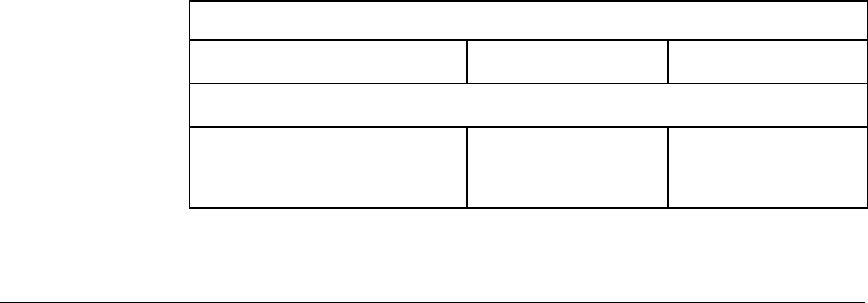
Chapter 8. Technical Information
8-2 862-02411 February 04
ensures open network management compatibility. The NCT has a Graphical User
Interface (GUI) carefully designed to assist installation and maintenance staff.
Comprehensive data and RF loop-back functions ensure that the system is easy to install
and maintain.
Velox LE Models
Each radio in the system consists of two main parts:
• A Radio Frequency Unit (RFU) operating in the 2.4 GHz or 5.8 GHz ISM
frequency bands. The RFU has an N -type female connector for connection to a
range of antennas and can either be and Outdoor RFU (ORFU) or and Indoor RFU
(IRFU).
RFU units available are the Velox LE 2410, Velox LE 5810, Velox LE 2410i,
Velox LE 5810i, Velox LE 2450, Velox LE 5850, Velox LE 2450i and Velox
5850i units. The models with an “i” suffix are 1RU high IRFUs. See RFU Variants
on page 9-1 for further inform ation.
• A Digital Indoor Unit (DIU), available with a Telecommunications interface (0 to
16T1/E1 tributaries depending on the radio)and a Data interface (10Base-T
Ethernet or 10/100Base-T Ethernet, depending on the radio).
DIU units available are the Velox LE 75/120 Ohm, a Velox LE 120 Ohm, Velox
LE 10, Velox LE 25 or a Velox LE 50 unit. All DIUs operate with the Velox LE
2410/2410i and Velox LE 5810/5810i RFUs. Velox LE 10, 25 and 50 DIUs can
operate only with the Velox LE type 2450 and 5850 RFUs. With the exception of
the Velox LE 75/120 Ohm and Velox LE 120 Ohm units the number is a guide to
the maximum data capacity of the unit. For example, the maximum data capacity of
the Velox LE 25 is 25 Mbps. DIU Variants on page 9-1.
Interconnection between the RFU and DIU is achieved using a low-cost UV-protected
STP (Screened Twisted Pair: 4 pairs) data cable and an UV-protected 2-core power
cable. The split DIU and RFU configuration is used for the lowest loss between the
antenna and the transceiver, thereby ensuring optimal long-range performance.
The RFUs use a Type-N RF (female) output connector for connection to a coaxial cable
jumper when co-located with a 2.4 GHz or a 5.8 GHz antenna for applications where
long range is required.
The RFU can also be located remote from the antenna (tower base or indoor mounted).
The RF connector is then connected to the antenna via either a coaxial transmission line
or a flexible waveguide.
The system is available for use in FCC regulated countries.
For more detailed information on models available see System Variants on page 9-4.
For Ordering Information refer to Chapter 10.
Table 8-1. Velox LE Models
Model Number Interfaces Antenna Coupling
Velox LE 24/5800, Velox LE24/5810 SR and Velox LE24/5810 SRi Model Variants
Velox LE 2400
Velox LE 2410 SR
Velox LE 2410 SRi
N x T1/E1
10Base-T Ethernet
(N = 1, 2 or 4)
N-type Female

Velox LE Installation and Operations Manual
862-02411 February 04 8-3
Table 8-1. Velox LE Models
Model Number Interfaces Antenna Coupling
Velox LE 5800
Velox LE 5810 SR
Velox LE 5810 SRi
N x T1/E1
10Base-T Ethernet
(N = 1, 2 or 4)
N-type Female
Velox LE 24/5825 SR Model Variants
Velox LE 2425 SR
Velox LE 2425 SRi
8 x T1/8 x E1 and
10Base-T Ethernet N-type Female
Velox LE 5825 SR
Velox LE 5825 SRi
8 x T1/8 x E1 and
10Base-T Ethernet N-type Female
Velox LE 24/5850 IP Model Variants
Velox LE 2450 IP
Velox LE 2450 IPi
10/100Base-T Ethernet
only N-type Female
Velox LE 5850 IP
Velox LE 5850 IPi
10/100Base-T Ethernet
only N-type Female
Velox LE 24/5850 SR model variants
Velox LE 2450 SR
Velox LE 2450 SRi
10/100Base-T Ethernet
and 1 - 16 E1/T1 N-type Female
Velox LE 5850 SR
Velox LE 5850 SRi
10/100Base-T Et hernet
and 1 - 16 E1/T1 N-type Female
The abbreviation SR indicate that the model is a scaleable radio, which means that
to increase the number of tributaries, e.g. from 1 to 4 requires only a software
upgrade.
The abbreviation IP indicates that the system is suitable for IP data only.
Velox LE SR 8 x T1/8 x E1 and 10Base-T Ethernet functionality:
Depending on the radio model and RFU configuration, the Velox LE radio can
simultaneously support 1 to 8 E1 or T1 tributary channels, with the balance of the
available user BW made up by Ethernet packet data, up to a maximum aggregate
Ethernet throughput no greater than 9.5 Mbps (Combined up - and downstream
throughput). The unidirectional Ethernet throughput of the radios is limited to a
maximum of 8 Mbps, which decreases as more tributary channels are activated.
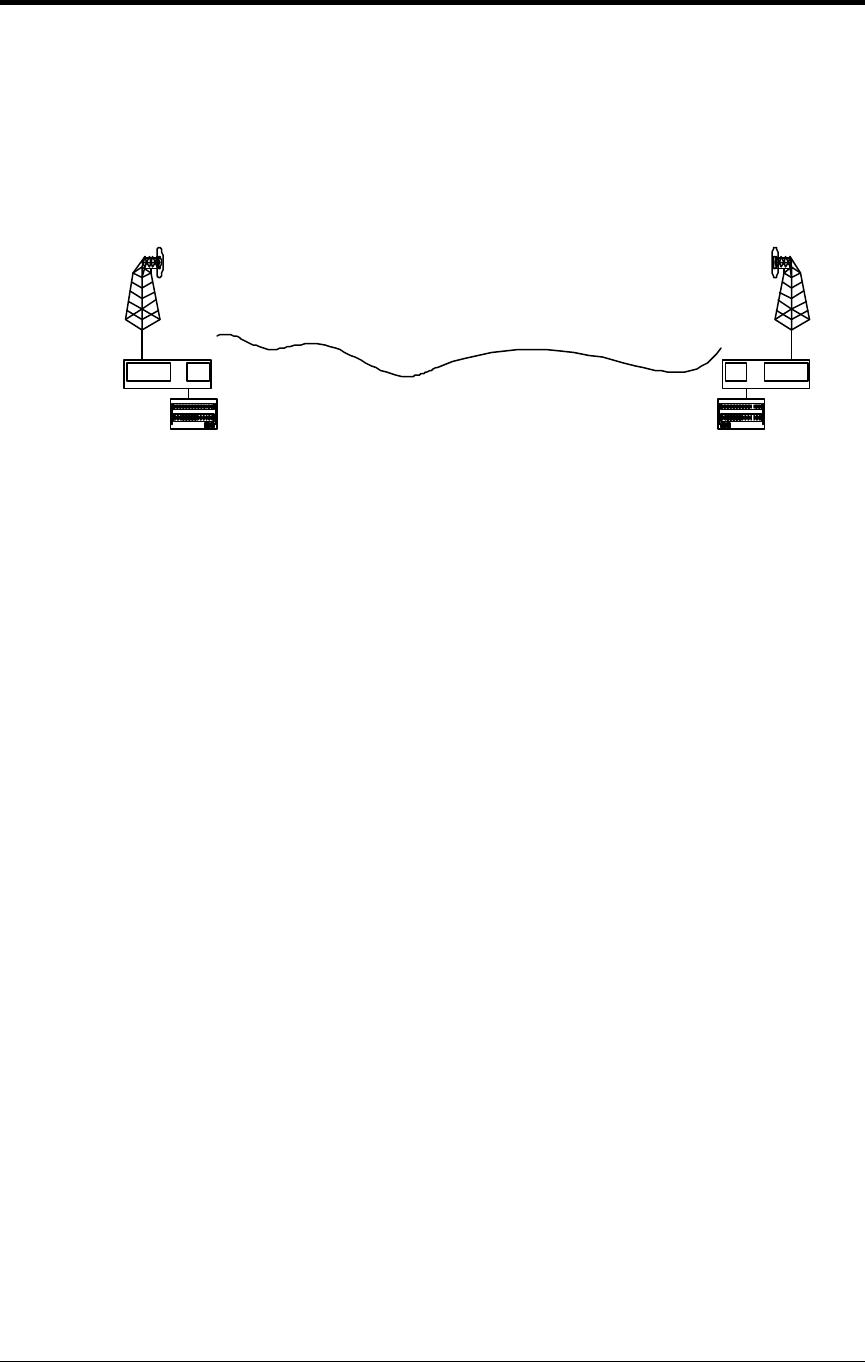
Chapter 8. Technical Information
8-4 862-02411 February 04
Technical Description
System Overview
A digital radio link (DRL) consists of a pair of Velox LE radio stations as shown in
Figure 8-1 below.
USER DATA
VELOX LE 2410, VELOX LE
5810 or VELOX LE 5850 RFU
VELOX LE DIU
USER DATA
VELOX LE 2410, VELOX LE
5810 or VELOX LE 5850 RFU
VELOX LE DIU
Figure 8-1. Velox LE Digital Radio Link
The radio station consists of two main parts:
• An RFU operating in the 2.4GHz or 5.8 GHz ISM frequency bands. The RFU
provides t he radio transceiver functionality by accepting radio link data from the
DIU and converting it to the 2.4GHz or 5.8 GHz ISM frequency band using spread
spectrum or QAM modulation. The received signal is de-modulated and
transmitted to the DIU in a digital format.
• A DIU, available with 0, 1, 2, 4, 8 or 16 T1 or E1 data interfaces (choice of T1 or
E1 is software selectable). The DIU combines nT1 or nE1 data with Wayside
Service Channel serial data and link IP data to be transmitted across the radio link.
The DIU also provides power to the RFU. In the Velox LE 50, the E1/T1 data
interface is provided through an optional Interface Card.
Interconnection between RFU and DIU is achieved using low cost data and power
cables.
RFU
The Velox LE 2410, Velox LE 5810, Velox LE 2410i and Velox LE 5810i RFUs make
use of Spread Spectrum modulation technology for license-free operation in the 2.4GHz
and 5.8 GHz ISM bands.
The Velox LE 2450 RFU uses three software selectable bandwidths for license-free
operation in the 2.4 GHz ISM band. The Velox LE 5850 RFU uses three software
selectable bandwidths for license-free operation in the 5.8 GHz ISM band.
All the RFUs with the postfix “i” (e.g. Velox LE 2410i and Velox LE 5810i) have been
repackaged into 1RU units that should be used in indoor unit applications only. Please
refer to Installing the IRFU on page 4-19 for more detail.
For operation, the ISM bands are divided into upper and lower frequency sub-bands. A
‘High Band’ RFU transmits in the higher frequency sub-band and receives in the lower
frequency sub-band, while a ‘Low Band’ RFU transmits in the lower sub-band and
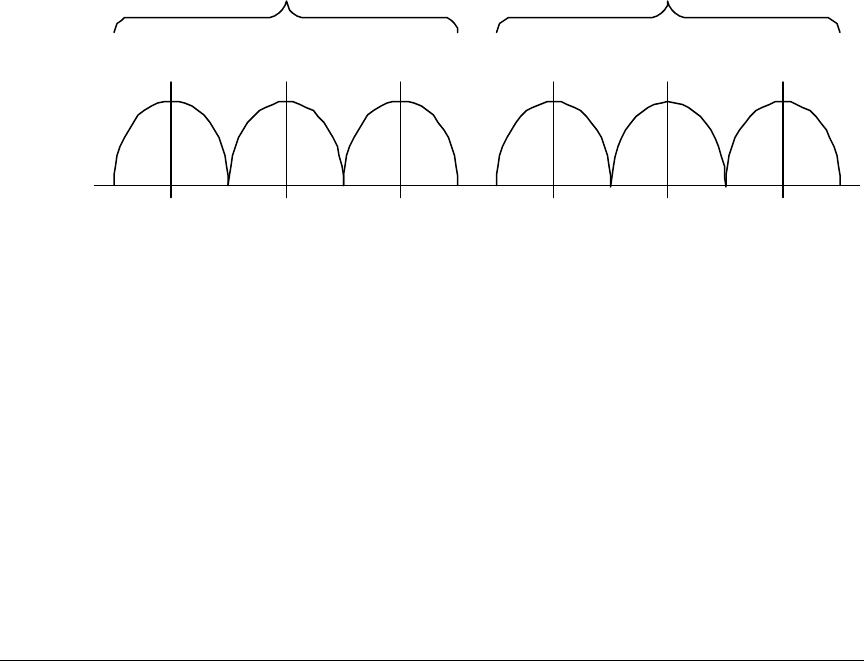
Velox LE Installation and Operations Manual
862-02411 February 04 8-5
receives in the higher sub-band. A Velox LE radio link will use a ‘Low Band’ RFU on
one end of the link to communicate with a ‘High Band’ RFU on the other end.
The RFUs use a Type-N RF output connector for connection to suitable 2.4GHz and
5.8GHz antennas for applications where long range is required.
The system is available for use in FCC regulated countries.
Frequency Plans
General
The Velox LE 5810, Velox LE 5810i, Velox LE 5850 and the Velox LE 5850i RFUs
operate in the 5.725 GHz to 5.850 GHz ISM frequency band with predefined frequency
channel plans (termed A, B, C and D). Channel plan D is user selectable/adjustable.
The Velox LE 2410, Velox LE 2410i Velox LE 2450 and the Velox LE 2450i RFUs
operate in the 2.400 GHz to 2.4835 GHz ISM frequency band with p redefined
frequency channel plans (termed A, B and D). Channel plan D is user
selectable/adjustable.
Velox LE 5810 and Velox LE 5810i Frequency Channel Plan A, B and C
Refer to Figure 8-2 below. The channel spacing is based on the bandwidth occupied by
the spread spectrum signal (approximately 17 MHz) and is used to optimize link
performance. Note that for plan A, plan B and C, both RFUs in a link must be set-up to
the same frequency channel plan (i.e. A, B or C).
C
H
B
H
Frequency (MHz)
LOW BAND TRANSMIT HIGH BAND TRANSMIT
A
H
A
L
B
L
C
L
5735 5753 5771 5804 5822 5840
Figure 8-2. Velox LE 5810 and Velox LE 5810i Frequency channel plans A,
B and C
Velox LE 2410 and Velox LE 2410i FCC Compliant Frequency Channels for the
USA only
In countries where FCC compliance is required, only the following frequencies may be
used (see Figure 8-3 below):
• Low band RFU – 2412MHz to 2426MHz,
• High band RFU – 2458MHz.
Use frequency plan D (variable frequency) to set the RFU.
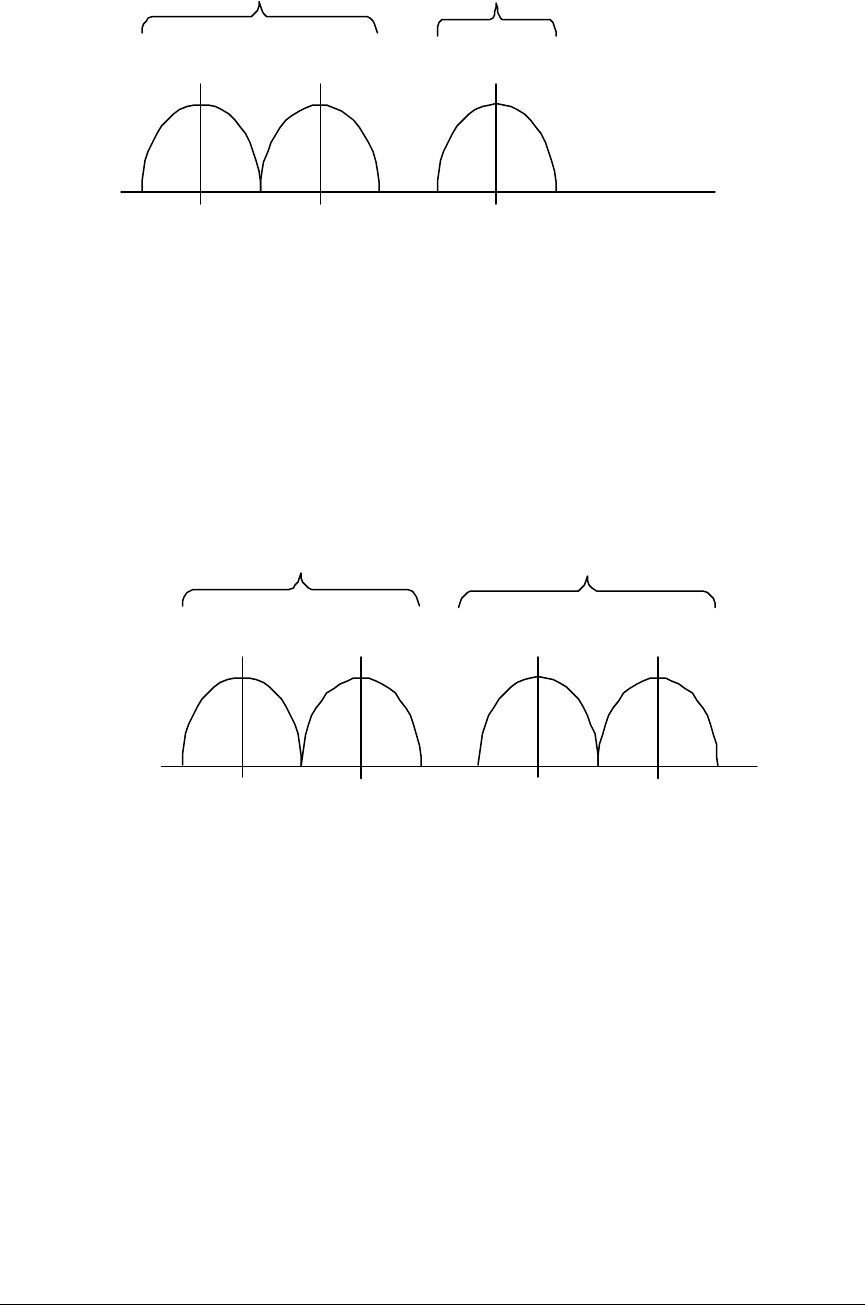
Chapter 8. Technical Information
8-6 862-02411 February 04
DH
Frequency (MHz)
LOW BAND TRANSMIT HIGH BAND
TRANSMIT
DLDL
2412 2426 2458
Figure 8-3. Velox LE 2410 and Velox LE 2410i FCC Compliant Frequency
Channels for the USA only
Velox LE 2410 and Velox LE 2410i Frequency Channel Plan A, B (non-FCC)
Refer to Figure 8-4 below. The channel spacing is based on the bandwidth occupied by
the spread spectrum signal (approximately 17 MHz) and is used to optimize link
performance. In the case of plan A and B, note that both RFUs of a link must be set up
to the same frequency channel plan (i.e. A or B).
A
H
B
H
Frequency (MHz)
LOW BAND
TRANSMIT
HIGH BAND
TRANSMIT
A
L
B
L
2410 2426 2458 2474
Figure 8-4. Velox LE 2410 and Velox LE 2410i Frequency channel plans A
and B
Velox LE 5850 and Velox LE 5850i Frequency Channels Plan A, B and C (FCC
Compliant)
The channel spacing is based on the transmit bandwidth and can be either 3 MHz, 6
MHz, 10 MHz or 14 MHz, software selectable. Different bandwidths can be selected
dependent on the optimum link performance; required system sensitivity versus data
transfer rate.
Only channel frequencies that are FCC compliant can be selected through the
configuration software. The channel frequency ranges are programmed into the radio
firmware and cannot be adjusted by the user.
The radios were tested and approved for FCC compliance with the frequency ranges as
listed in Table 8-2 below, (see also Figure 8-5 on page 8-7).
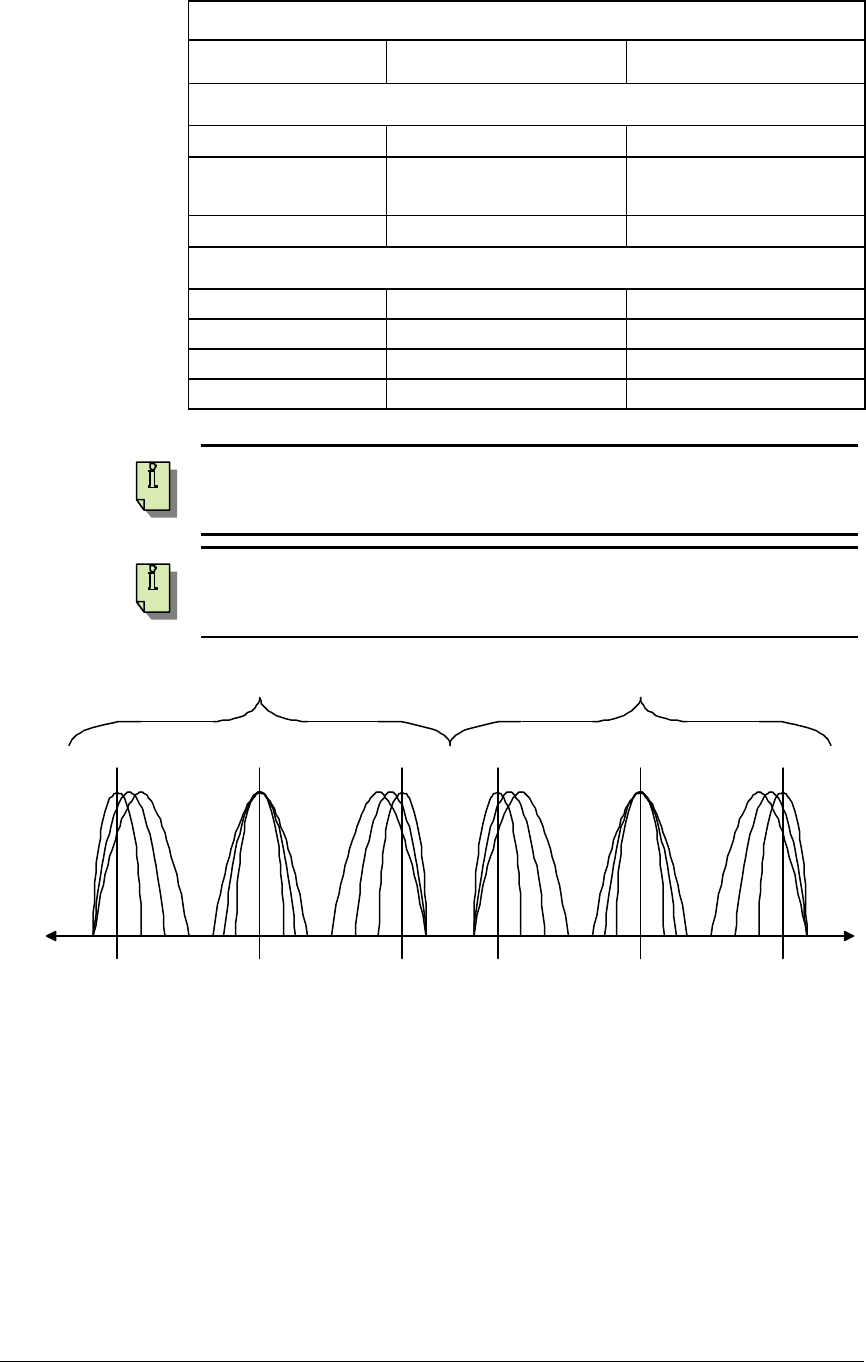
Velox LE Installation and Operations Manual
862-02411 February 04 8-7
Table 8-2. Frequency Ranges for Velox LE 5850 and Velox LE 5850i
Modulation Type Lowest Centre Freq. (MHz) Highest Centre Freq. (MHz)
Low band RFU:
8.46Mbps / 16 -QAM 5731 5774
16.93 Mbps / 16-QAM 5732 5773
25.39 Mbps / 16-QAM 5734 5771
50.78 Mbps / 32-QAM 5736 5769
High band RFU:
8.46Mbps / 16 -QAM 5801 5844
16.93 Mbps / 16-QAM 5802 5843
25.39 Mbps / 16-QAM 5804 5841
50.78 Mbps / 32-QAM 5806 5839
NOTE 1: Both RFUs in a link must be set to the same frequency channel plan (i.e.
A, B, C or D) and modulator type. Also note that the frequencies differ for different
transmit bandwidths, i.e. the frequency of channel A changes according to the
transmit bandwidth.
NOTE 2: Figure 8-5 below reflects all the frequency bands that could be obtained
with the Velox LE 5850 and Velox LE 5850i RFU. Pre-programmed frequency
ranges in the radio firmware prevent the user from selecting transmission options
that will not meet FCC requirements.
Frequency [MHz]
5731 5774 5801 5844
ABCABC
Low Transmit Band High Transmit Band
Figure 8-5. Velox LE 5850 and Velox LE 5850i Frequency channel plans A,
B and C.
Refer to NOTE 2 above with regards to FCC standards compliance of the different
band plans.
Velox LE 2450 and Velox LE 2450i Frequency Channels Plan A, B and C (FCC
Compliant)
The channel spacing is based on the transmit bandwidth and can be either 3 MHz, 6
MHz, 10 MHz or 14 MHz, software selectable. Different bandwidths can be selected
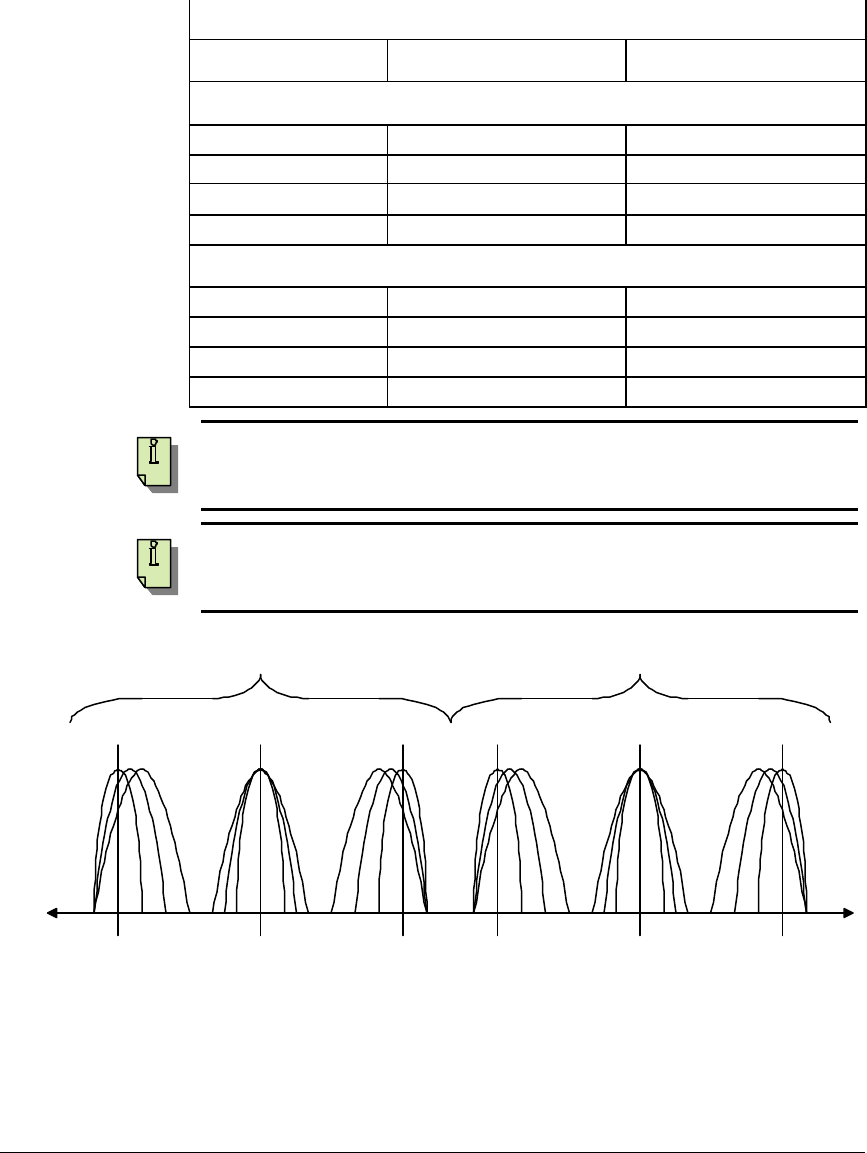
Chapter 8. Technical Information
8-8 862-02411 February 04
dependent on the optimum link performance; required system sensitivity versus data
transfer rate.
Only channel frequencies that are FCC compliant can be selected through the
configuration software. The channel frequency ranges are programmed into the radio
firmw are and cannot be adjusted by the user.
The radios were tested and approved for FCC compliance with the frequency ranges
Table 8-3 below (see also Figure 8-6 on page 8-8).
Table 8-3. Frequency Ranges for Velox LE 2450 and Velox LE 2450i
Modulation Type Lowest Centre Freq. (MHz) Highest Centre Freq. (MHz)
Low band RFU:
8.46Mbps / 16-QAM 2405 2429
16.93 Mbps / 16 -QAM 2406 2428
25.39 Mbps / 16 -QAM 2408 2426
50.78 Mbps / 32 -QAM 2410 2424
High band RFU:
8.46Mbps / 16-QAM 2444 2469
16.93 Mbps / 16 -QAM 2445 2468
25.39 Mbps / 16 -QAM 2447 2466
50.78 Mbps / 32 -QAM 2451 2463
NOTE 1: Both RFUs in a link must be set to the same f requency channel plan (i.e.
A, B, C or D) and modulator type. Also note that the frequencies differ for different
transmit bandwidths, i.e. the frequency of channel A changes according to the
transmit bandwidth.
NOTE 2: Figure 8-6 below reflects all the frequency bands that could be obtained
with the Velox LE 2450 RFU. Pre-programmed frequency ranges in the radio
firmware prevent the user from selecting transmission options that will not meet
FCC requirements.
Frequency [MHz]
2405 2429 2444 2469
A B CA B C
Low Transmit Band High Transmit Band
Figure 8-6. Velox LE 2450 and Velox LE 2450i Frequency channel plans A,
B and C

Velox LE Installation and Operations Manual
862-02411 February 04 8-9
Frequency Channel Plan D (FCC Compliant)
Fr equency plan D allows independent control of transmit and receive frequencies. This
allows a flexible frequency plan and can be used to overcome interference in the
2.4GHz and 5.8 GHz ISM bands.
The frequencies that can be used in the lower or upper sub-bands can be selected in 1
MHz increments. Performance degradation can be expected when operating using
channel plan D mode with the chosen frequencies close to the sub-band edges, i.e. a
choice of one of the high frequencies in the lower sub-band and one of the lower
frequencies in the upper sub-band.
The allocation of Channel plan D frequencies is shown in Table 8-4, Table 8-5, Table
8-6 and Table 8-7 below. The Velox LE 24/5850 RFUs have up to four different sets of
minimum and maximum frequencies, which are determined by the data rate setting of
the RFU.
Only channel frequencies that are FCC compliant can be selected through the
configuration software. The channel frequency ranges are programmed into the radio
firmware and cannot be adjusted by the user.
The radios were tested and approved for FCC compliance with the frequency ranges in
Table 8-4 below.
Table 8-4. Velox LE 2410 and Velox LE 2410i Channel plan D
channel frequencies
Sub-band Centre Frequency (MHz)
L 2410-2426
H 2458-2474
NOTE: See Velox LE 2410 and Velox LE 2410i FCC Compliant Frequency
Channels for the USA only on page 8-5 for the allowable operation range in FCC
countries.
Table 8-5. Velox LE 5810 and Velox LE 5810i Channel plan D channel
frequencies
Sub-band Centre Frequency (MHz)
L 5735-5771
H 5804-5840
Table 8-6. Velox LE 5850 Velox LE 5850i and Channel plan D channel
frequencies
Centre Frequency (MHz) RF BW [MHz] /
Data Rate [kbps]
Lower Sub-band Upper / Higher Sub-band
2.6 / 8464 5731-5774 5801-5844
5.4 / 16928 5732-5773 5802-5843
8.0 / 25392 5734-5771 5804-5841
14.0 / 50784314 5769-5769 5806-5839
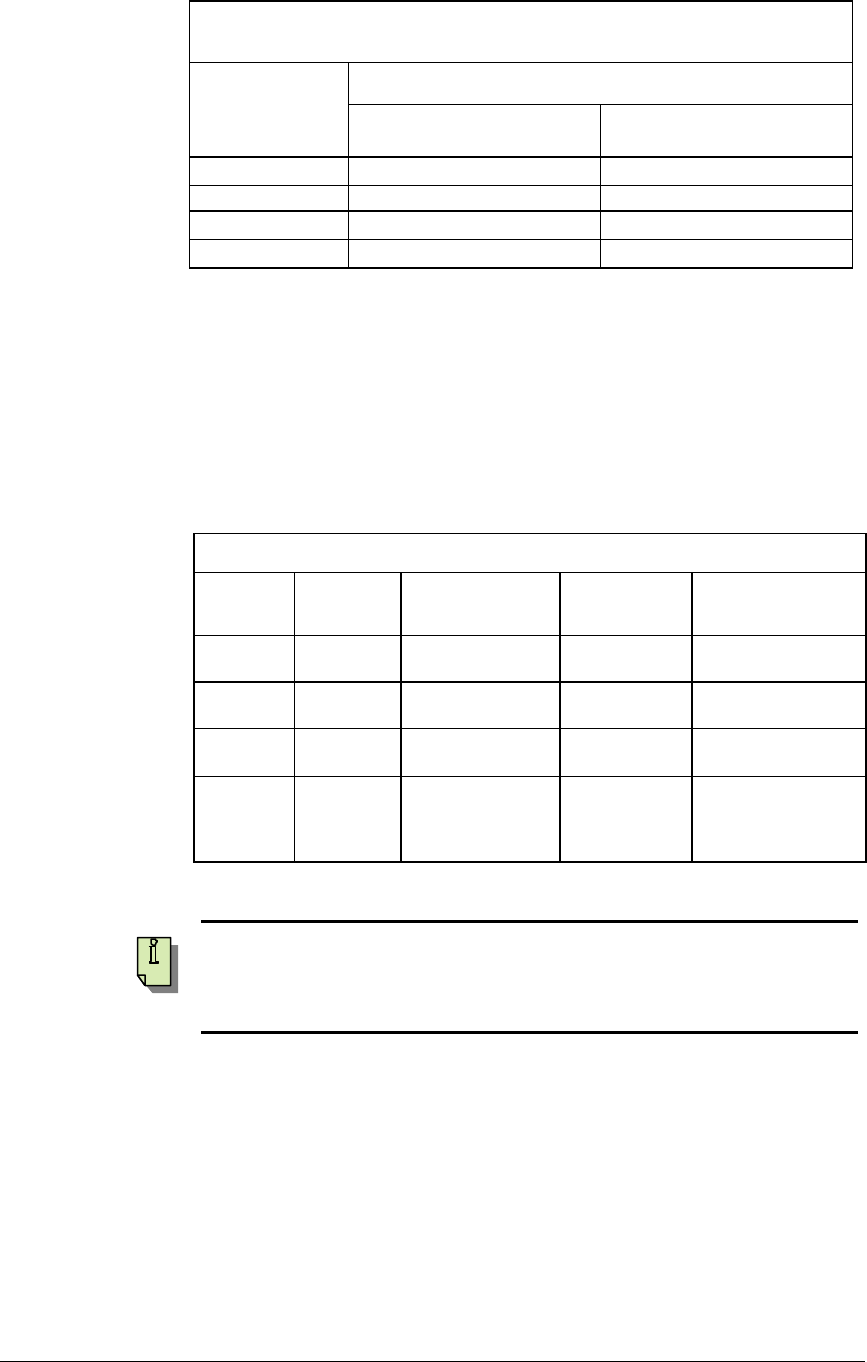
Chapter 8. Technical Information
8-10 862-02411 February 04
Table 8-7. Velox LE 2450 and Velox LE 2450i Channel plan D channel
frequencies
Centre Frequency (MHz) RF BW [MHz] /
Data Rate [kbps]
Lower Sub-band Upper / Higher Sub-band
2.6 / 8464 2405-2429 2444-2469
5.4 / 16928 2406-2428 2445-2468
8.0 / 25392 2408-2426 2447-2466
14.0 / 50784314 2410-2424 2451-2463
Velox LE 2450 and Velox LE 5850 Modulator Types
The Velox LE 2450 and Velox LE 5850 can operate with different modulator types (see
Table 8-8 below), the trade-off being better radio performance versus higher data
throughput. The changes can be made via software using the Velox LE NCT/GUI or an
SNMP client application.
Modulator types and frequency bands that were tested and approved for compliance
with FCC regulations (see Velox LE 5850 and Velox LE 5850i Frequency Channels
Plan A, B and C (FCC Compliant) on page 8-6 and Velox LE 2450 and Velox LE 2450i
Frequency Channels Plan A, B and C (FCC Compliant) on page 8-7.
Table 8-8. Velox LE 24/5850 Modulator Types
Data Rate
[kbps] Modulation
Type Raw data
Throughput (bps)
Typical
Payload App
rox. RFU output
spectrum BW
8464 16-QAM 8 464 052 4T1/E1 + 150
kbit Ethernet 2.6 MHz
16928 16-QAM 16 928 105 8T1/E1 + 150
kbit Ethernet 5.4 MHz
25392 16-QAM 25 392 157 8T1/E1 + 9.5
Mbit Ethernet 8 MHz
50784 32-QAM 50 784 314 46 Mbit/s
Ethernet or 16
T1/E1 + 14
Mbit/s Ethernet
14 MHz
NOTE: Changing the modulator type of a Velox LE 24/5850 RFU may take up to
30 seconds. During this period, the link will not be available. Changing the RFU
modulator type does not support Auto Recovery thus; the modulator type of the
remote station must be changed before the modulator type of the local station is
changed.
RF Power Output Options
The RFU is designed for use in countries that have adopted FCC standards. It is
possible to adjust the output power on the RFU using the supplied NCT software or a
SNMP Management application. The FCC standards for the Velox LE 2410 unit
require a limited output power as stated in the FCC Notice (USA only) in the front
matter of the manual.
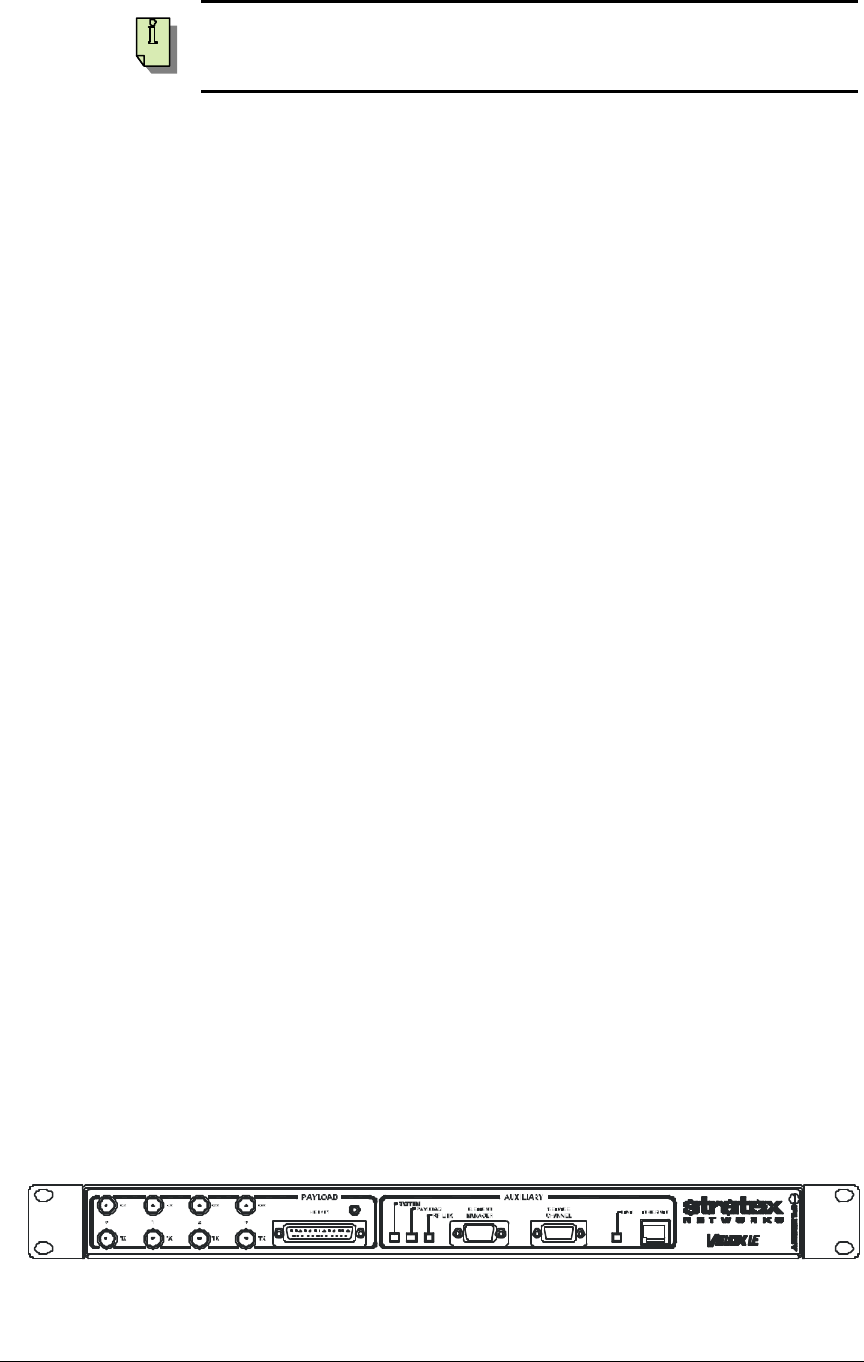
Velox LE Installation and Operations Manual
862-02411 February 04 8-11
NOTE: The Velox LE type RFU firmware will not accept power level settings that
fall outside the FCC compliant levels.
Velox LE 24/5810, Velox LE 24/5810i, Velox LE 24/5850 and Velox
LE 24/5850i RFUs
The RFUs transmit and receive RF signals through a diplexer interfaced via a RF cable
to an external antenna. The unit has a type-N connector for connection to the RF cable
used between the RFU and the antenna.
The RFU houses the following main parts:
a. Transmit/Receive Modules
b. Baseband Modulator/Demodulator Circuitry
c. Microcontroller/Framing & Buffering Circuitry
d. Power Amplifier
e. Diplexer
Velox LE, Velox LE 10, Velox LE 25, Velox LE 50 Digital
Indoor Unit
General
The Digital Indoor Unit (DIU) is designed for mounting in a 19” rack, occupying a 1RU
slot. It can also be used as a tabletop system.
The DIU accepts n x T1/nE1 user payload channels and combines it with Wayside
Service Serial Data and IP data to be transmitted across the radio link.
The DIU is fitted with a DC power supply.
There are five types of DIUs:
• Velox LE (120 Ohm) (scaleable up to 4 T1/E1) (see Figure 8-8 below).
• Velox LE (75 / 120 Ohm) (scaleable up to 4 T1/ E1) (see Figure 8-7 below).
• Velox LE 10 (scaleable up to 4 T1/E1) (see Figure 8-9 below).
• Velox LE 25 (scaleable up to 8 T1/E1) (see Figure 8-10 below).
• Velox LE 50 (with optional 16 T1/E1 interface card) (see Figure 8-11 below).
The Velox LE DIUs can operate with the Velox LE 2400, Velox LE 5800, Velox LE
2410i and Velox LE 5810i RFUs.
The Velox LE 10 / 25 and 50 DIU is used with the Velox LE 24/5850 RFU, but can
also support the Velox LE 24/5800, and Velox LE 24/5810i RFUs if the appropriate
firmware version is loaded on the DIU.
Figure 8-7. Velox LE (75 Ohm) DIU
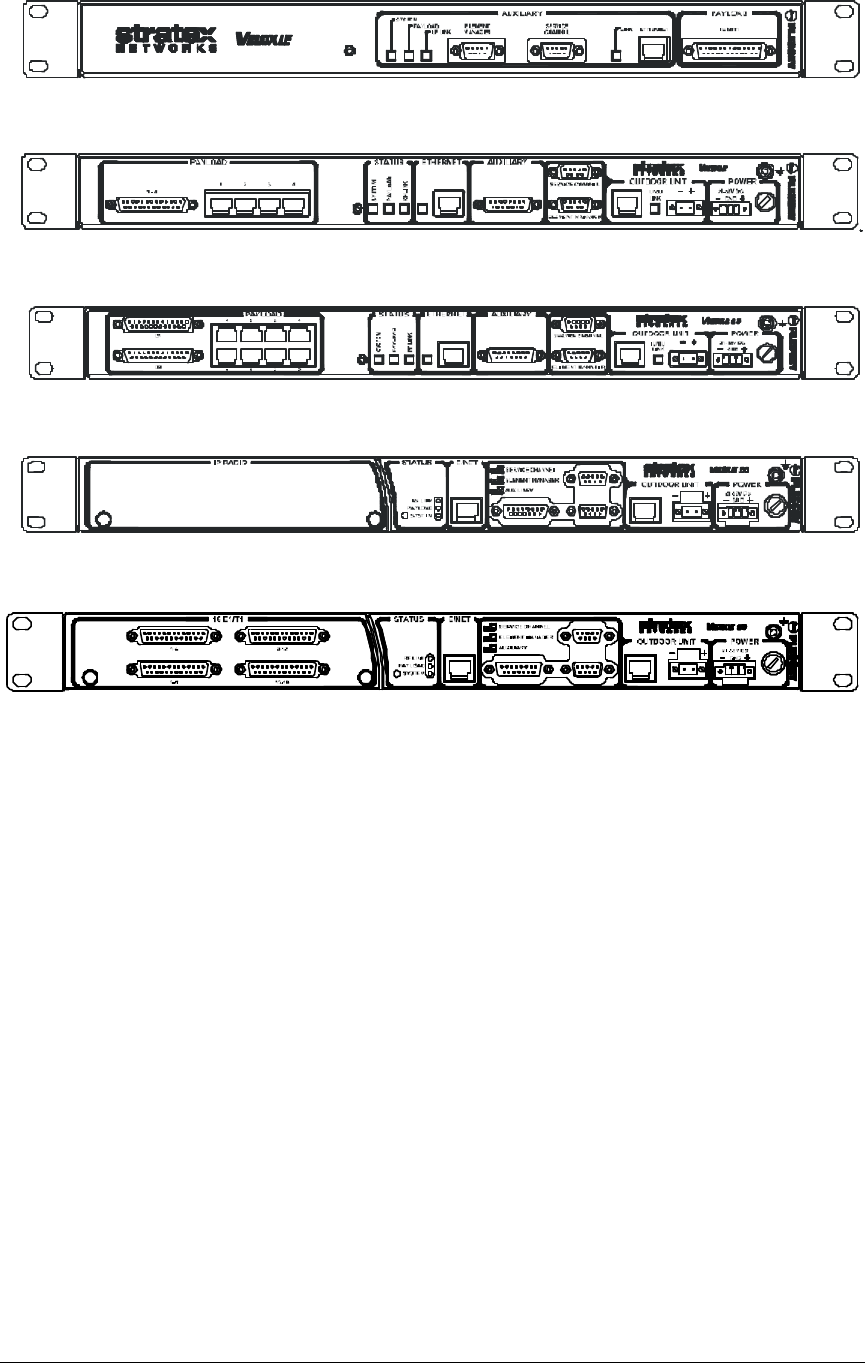
Chapter 8. Technical Information
8-12 862-02411 February 04
Figure 8-8. Velox LE (120 Ohm) DIU
10
Figure 8-9. Velox LE 10 DIU
Figure 8-10 . Velox LE 25 DIU
Figure 8-11 . Velox LE IP DIU
Figure 8-12 . Velox LE 50 DIU
Payload Interface Options
Tributary Payload
The DIU can be configured for T1 or E1 operation, as follows:
• Velox LE-Type and Velox LE 10 type DIU:
1, 2, or 4 x T1 (1.544 Mbps) or E1 (2.048 Mbps).
• Velox LE 25 type DIU:
1, 2, 4 or 8 x T1 (1.544 Mbps) or E1 (2.048 Mbps).
• Velox LE 50 type DIU:
None (10Base-T/100Base-T Ethernet only).
1 - 16 x T1 (1.544 Mbps) or E1 (2.048 Mbps)
For T1 connectivity, bipolar AMI or B8ZS line coding is software selectable.
For E1 connectivity, bipolar AMI or HDB3 line coding is software selectable.
Line coding on the Velox LE 25 DIU may be selected separately for tributary channels
1 to 4 and 5 to 8 when used with a Velox LE 24/5850 RFU.
Line coding and impedance may be selected on a per tributary basis for the Velox LE
50 DIU with a tributary data interface.

Velox LE Installation and Operations Manual
862-02411 February 04 8-13
The payload can be connected on:
• Unbalanced 75 Ohm BNC connectors, 75/120 Ohm DIU only (RX= In, TX= Out).
• Balanced 120 Ohm or unbalanced 75 Ohm, 25 way D-type connectors.
• Balanced 120 Ohm or unbalanced 75 Ohm, RJ48C connectors on the Velox LE 10
and Velox LE 25.
NOTE A special version of the Velox LE DIU exists that allows the user to select
AMI or B8ZS line encoding on a per-tributary basis for T1 connectivity. These
DIUs are indentified by the letters AT following the version number.
Line codes can be selected on a per-tributary basis using the Velox LE NCT
software application. In the Payload Configuration window:
1. Set the DIU Payload interface to T1 mode and Apply.
2. Refresh the information displayed in the window.
3. Select the desired Line Code next to each tributary and Apply.
Hardware modified to implement this feature can ONLY work with special
DIU firmware – contact the distributor for details.
Ethernet Payload
Velox LE-Type and Velox LE 10 type DIU:
• 10Base-T RJ45
Velox LE 25 type DIU:
• 10Base-T RJ45
Velox LE 50 type DIU:
• 10/100Base-T RJ45
1+1 Redundancy Protected Payload System
The Velox LE radios can be used in a 1+1 redundant mode system to protect the
tributary payload data carried over a radio link. This system detects the quality of the
link over which it is receiving data and allows switching between two parallel radio
links to protect the user data against link failures.
Please refer to Chapter 12: 1+1 Protection System Operation, or the Protection Kit user
manual, publication number 862 -02236 for functional information.
Technical Data
Environmental
RFU
Operating temperature: -33°C to +60°C
Relative humidity: 8-100%
Atmospheric pressure: 0.7 to 1.06 kPa
Lightning protection ITU-T K.20

Chapter 8. Technical Information
8-14 862-02411 February 04
DIU and IRFU
Operating temperature: -5°C to +50°C
Relative humidity: 5-90%
Lightning protection: ITU-T K.20
Physical
RFU
Dimensions (H x W x D): 335mm x 231mm x 124mm
Weight: ~ 5.9 Kg
DIU and IRFU
Dimensions (H x W x D): 45mm x 480 mm x 265mm
Mounting: 19” Rack, 1RU high or Table top
Weight: ~ 2.9 Kg
Power Supply
DC power supply: 21 to 56 Vdc or 21 to 58 Vdc dependent on the
version and variant
DC power supply grounding: Positively or negatively grounded
Power consumption (Velox LE
2400/5800 and 2410i/5810i) 35 W typical, 45 W maximum.
Power consumption (All other
Velox LE radios)
40 W typical, 45 W maximum.
The power supply specification for the current Velox LE 10, Velox LE 25 and all
Velox LE 50 DIUs is 21 to 58 Vdc whereas older Velox LE 10, Velox LE 25 DIUs
and all other DIUs require 21 to 56 Vdc.
Please ensure that you comply with the power supply specification printed above the
POWER connector on the DIU.
Electrical Performance
General Characteristics
Velox LE 2400, Velox LE 2410 SR and Velox LE 2410 SRi
Frequency Range: 2400 to 2483.5 MHz
Payload Data Capacity: T1 (1.544 Mbps/s) / E1 (2.048 Mbps)
2T1 / 2E1
4T1 / 4E1
RF Channel Bandwidth: 17 MHz
Go/Return spacing: Can be adjusted as fixed go-return spacing.
NOT mandatory in the ISM licence-free bands.
Modulation: CCK
Processing Gain: 11 dB
Frequency Channel Plan A: 2410 and 2460 MHz
Frequency Channel Plan B: 2426 and 2476 MHz
Transmission Delay: 600 us maximum for radios only (one-way)

Velox LE Installation and Operations Manual
862-02411 February 04 8-15
Velox LE 2425 SR and Velox LE 2425 SRi
Frequency Range : 2405 to 2469 MHz
Payload Data Capacity: 1 - 4T1 (1.544 Mbps/s) /
1 - 4E1 (2.048 Mbps) (2.6MHz BW)
1 - 8T1 (1.544 Mbps/s) /
1 - 8E1 (2.048 Mbps) (5.4MHz, 8.0MHz BW)
RF Channel Bandwidth:
(Selectable) 2.6MHz
5.4MHz
8.0MHz
Go/Return spacing: Can be adjusted as fixed go-return spacing.
NOT mandatory in the ISM licence-free bands.
Modulation: 16 -QAM
Frequency Channel Plan A: 2405 and 2444 MHz (2.6MHz BW)
2406 and 2445 MHz (5.4MHz BW)
2408 and 2447 MHz (8.0MHz BW)
Frequency Channel Plan B: 2417 and 2456 MHz (all bandwidths)
Frequency Channel Plan C: 2429 and 2469 MHz (2.6MHz BW)
2428 and 2468 MHz (5.4MHz BW)
2426 and 2466 MHz (8.0MHz BW)
Transmission Delay: 600 us maximum for radios only (one-way)
Velox LE 2450 SR, Velox LE 2450 SRi, Velox LE 2450 IP and Velox LE 2450 IPi
Frequency Range: 2405 to 2469 MHz
Payload Data Capacity: Ethernet Only (Max 46 Mb/s bi-directional)
Optional through interface card:
1 - 16T1/E1 (1.544 Mbps/s) / (2.048 Mbps)
RF Channel Bandwidth:
(Selectable) 2.6MHz
5.4MHz
8.0MHz
14.0 MHz
Go/Return spacing: Can be adjusted as fixed go-return spacing.
NOT mandatory in the ISM licence-free bands.
Modulation: 16 -QAM / 32-QAM
Frequency Channel Plan A: 2405 and 2444 MHz (2.6MHz BW)
2406 and 2445 MHz (5.4MHz BW)
2408 and 2447 MHz (8.0MHz BW)
2410 and 2451 MHz (14.0MHz BW)
Frequency Channel Plan B: 2417 and 2457 MHz (all bandwidths except 14
MHz)
Frequency Channel Plan C: 2429 and 2469 MHz (2.6MHz BW)
2428 and 2468 MHz (5.4MHz BW)
2426 and 2466 MHz (8.0MHz BW)
2424 and 2463 MHz (14.0MHz BW)
Transmission Delay: 600 us maximum for radios only (one-way)
Velox LE 5800, Velox LE 5810 SR and Velox LE 5810 SRi
Frequency Range: 5731 to 5844 MHz
Payload Data Capacity: T1 (1.544 Mbps/s) / E1 (2.048 Mbps)
2T1 / 2E1
4T1 / 4E1
RF Channel Bandwidth: 17 MHz
Go/Return spacing: Can be adjusted as fixed go-return spacing.
NOT mandatory in the ISM licence-free bands.
Modulation: CCK
Processing Gain: 11 dB
Frequency Channel Plan A: 5735 and 5804 MHz
Frequency Channel Plan B: 5753 and 5822 MHz
Frequency Channel Plan C: 5771 and 5840 MHz
Transmission Delay: 600 us maximum for radios only (one-way)

Chapter 8. Technical Information
8-16 862-02411 February 04
Velox LE 5825 SR and Velox LE 5825 SRi
Frequency Range: 5731 to 5844 MHz
Payload Data Capacity: 1 – 4T1 (1.544 Mbps/s) /
1 - 4E1 (2.048 Mbps) (2.6MHz BW)
1 - 8T1 (1.544 Mbps/s) /
1 - 8E1 (2.048 Mbps) (5.4MHz, 8.0MHz BW)
RF Channel Bandwidth:
(Selectable) 2.6MHz
5.4MHz
8.0MHz
Go/Return spacing: Can be adjusted as fixed go-return spacing.
NOT mandatory in the ISM licence-free bands.
Modulation: 16-QAM
Frequency Channel Plan A: 5731 and 5801 MHz (2.6MHz BW)
5732 and 5802 MHz (5.4MHz BW)
5734 and 5804 MHz (8.0MHz BW)
Frequency Channel Plan B: 5752 and 5822 MHz (all bandwidths)
Frequency Channel Plan C: 5774 and 5844 MHz (2.6MHz BW)
5773 and 5843 MHz (5.4MHz BW)
5771 and 5841 MHz (8.0MHz BW)
Transmission Delay: 600 us maximum for radios only (one-way)
Velox LE 5850 SR, Velox LE 5850 SRi, Velox LE 5850 IP and Velox LE 5850 IPi
Frequency Range: 5731 to 5844 MHz
Payload Data Capacity: Ethernet Only (Max 46 Mb/s bi-directional)
Optional through interface card:
1 - 16T1/E1 (1.544 Mbps/s) / (2.048 Mbps)
RF Channel Bandwidth:
(Selectable) 2.6MHz
5.4MHz
8.0MHz
14MHz
Go/Return spacing: Can be adjusted as fixed go-return spacing.
NOT mandatory in the ISM licence-free bands.
Modulation: 16-QAM / 32-QAM
Frequency Channel Plan A: 5731 and 5801 MHz (2.6MHz BW)
5732 and 5802 MHz (5.4MHz BW)
5734 and 5804 MHz (8.0MHz BW)
5736 and 5806 MHz (14.0MHz BW)
Frequency Channel Plan B: 5752 and 5822 MHz (all bandwidths)
Frequency Channel Plan C: 5774 and 5844 MHz (2.6MHz BW)
5773 and 5843 MHz (5.4MHz BW)
5771 and 5841 MHz (8.0MHz BW)
5769 and 5839 MHz (14.0MHz BW)
Transmission Delay: 600 us maximum for radios only (one-way)
Transceiver Characteristics
Frequency Band: Velox LE 2410 and Velox LE 2410i Low Band RFUs
Transmit band: 2410 – 2426 MHz (Centre frequency)
Receive band: 2458 – 2474 MHz (Centre frequency)
Frequency Band: Velox LE 2410 and Velox LE 2410i High Band RFUs
Transmit band: 2458 – 2474 MHz (Centre frequency)
Receive band: 2410 – 2426 MHz (Centre frequency)
Frequency Band: Velox LE 2450 and Velox LE 2450i Low Band RFUs
Transmit band: 2405 – 2429 MHz (Centre frequency)
Receive band: 2444 – 2469 MHz (Centre frequency)

Velox LE Installation and Operations Manual
862-02411 February 04 8-17
Frequency Band: Velox LE 2450 and Velox LE 2450i High Band RFUs
Transmit band: 2444 – 2469 MHz (Centre frequency)
Receive band: 2405 – 2429 MHz (Centre frequency)
Frequency Band: Velox LE 5810 and Velox LE 5810i Low Band RFUs
Transmit band: 5725 – 5787 MHz (Band edge)
Receive band: 5787 – 5850 MHz (Band edge)
Frequency Band: Velox LE 5810 and Velox LE 5810i High Band RFUs
Transmit band: 5787 – 5850 MHz (Band edge)
Receive band: 5725 – 5787 MHz (Band edge)
Frequency Band: Velox LE 5850 and Velox LE 5850i Low Band RFUs
Transmit band: 5731 – 5774 MHz (Centre frequency)
Receive band: 5801 – 5844 MHz (Centre frequency)
Frequency Band: Velox LE 5850 and Velox LE 5850i High Band RFUs
Transmit band: 5801 – 5844 MHz (Centre frequency)
Receive band: 5731 – 5774 MHz (Centre frequency)
RF Interface
Transmitted Power +2 to+24 dBm – Velox LE 2410, Velox LE
5810, Velox LE 2410i
+2 to+25 dBm – Velox LE 5810i
+2 to +24 dBm – Velox LE 5850 high output
power, software adjustable (incl. mute)
Receiver Sensitivity: Up to 4T1/4E1 :
-88dBm for BER = 10-6 (Velox LE 2400)
-86dBm for BER = 10-6 (Velox LE 5800)
Up to 16T1/E1: Velox LE 5850, 16/32 QAM
-88dBm for BER = 10-6 (2.6 MHz BW)
-85dBm for BER = 10-6 (5.4 MHz BW)
-83dBm for BER = 10-6 (8 MHz BW)
-78dBm for BER = 10-6 (14 MHz BW)
Maximum Receive Level: -30dBm
Payload Data Interfaces
1, 2, 4 or 8 (i.e. n x E1) Interface (Velox LE 10, Velox LE 25)
Data Rate: Full duplex E1 (2.048Mbit/s), 2E1, 4E1 or 8E1
Digital Interface: ITU-T G.703
Connectors: Balanced 110 ohm on DB25
Balanced 110 ohm on RJ45 (Velox LE 10/25
DIU only)
Unbalanced 75 ohm on BNC connectors
(Available on one of the Velox LE 2400/5800
DIU variants)
Line code: HDB3 or AMI selectable, refer to Payload
Interface Options on page 8-12.
Jitter and Wander: ITU-T G.823
1, 2, 4 or 8 (i.e. n x T1) Interface (Velox LE 10, Velox LE 25)
Data Rate: Full duplex T1 (1.544Mbit/s), 2T1, 4T1 or 8T1
Digital Interface: DSX-1, G.703 compliant
Connectors: Balanced 110 ohm on DB25
Balanced 110 ohm on RJ45 (Velox LE 10/25
DIU only)

Chapter 8. Technical Information
8-18 862-02411 February 04
Unbalanced 75 ohm on BNC connectors
(Available on one of the Velox LE 2400/5800
DIU variants)
Line code: AMI or B8ZS selectable, refer to Payload
Interface Options on p age 8-12.
Jitter and Wander: ITU-T G.823
1-16 (i.e. nT1) Interface Card (Available on Velox LE 50 as optional I/F card)
Data Rate: Full duplex T1 (1.544Mbit/s) up to 16T1
Digital Interface: DSX -1, G.703 compliant
Connectors: Balanced on DB25, Termination impedance
selectable per tributary channel through
software (75, 100, 110, 120 Ohm)
Line code: AMI or B8ZS selectable per tributary channel
through software
Jitter and Wander: ITU-T G.823
1-16 (i.e. nE1) Interface Card (Available on Velox LE 50 as optional I/F card)
Data Rate: Full duplex E1 (2.048Mbit/s) up to 16E1
Digital Interface: ITU-T G.703
Connectors: Balanced on DB25, Termination impedance
selectable per tributary channel through
software (75, 100, 110, 120 Ohm)
Line code: AMI or B8ZS selectable per tributary channel
through software
Jitter and Wander: ITU-T G.823
Ethernet Traffic Interface
All DIU except Velox LE 50 DIU:
Data Rate: < 8 Mbps Half / full duplex software selectable
(Refer to note on Velox LE Scaleable 1-to-4/8
E/T1/10Base-T Ethernet functionality on page
8-3.
Digital Interface: 10Base-T, Half / full duplex, DTE
Connector: RJ45
Velox LE 50 DIU:
Data Rate: < 46 Mbps Half / full duplex software selectable
limited by RF data capacity
Digital Interface: 10/100Base-T, Half / full duplex, DTE
Connector: RJ45
Auxiliary Input Interface (Contact Closure)
Number of Inputs: 2
Maximum voltage: 12V
Logical zero: Short from input to return pin
Logical one: Open input to return pin
Auxiliary Output Interface
Number of outputs: 2
States: Normally-open and normally-closed
Contact rating: DC: 220 V, 1 A, 60 W
AC: 250 V, 1 A, 125 VA

Velox LE Installation and Operations Manual
862-02411 February 04 8-19
Wayside Channel Interface
Interface standard: RS232, DCE
Handshaking: None, Hardware
Port rate: 115,200 bps
Element Manager Port Interface
Interface standard: RS232, DTE
Handshaking: Hardware
Data rate: 115,200 bps
Indoor/RFU Interface
The physical interface between the Indoor and RFU is IEEE802.3 Ethernet. As such,
the same considerations that apply between standard routers/switches/hubs and PC
LAN cards should be adhered to when selecting lengths of cables between the RFU and
the DIU. Cable lengths of up to 120 meters have been tested in a laboratory
environment.

Velox LE Installation and Operations Manual
862-02411 February 04 9-1
Chapter 9 : Product Range/Product
Matrix
DIU Variants
The available DIU variants are listed in Table 9-1 below.
Table 9-1. DIU Variants
Variant Name Description
Velox LE DIU only - no RF circuitry 9.5Mbps data capacity, fully scalable
between 10Base-T Ethernet and up to 4xE1(4x2Mbps) or
4xT1(4x1.5Mbps) data interface
Velox LE 10 DIU only - no RF circuitry 9.5Mbps data capacity, fully scalable
between 10Base-T Ethernet and up to 4xE1(4x2Mbps) or
4xT1(4x1.5Mbps) data interface
Velox LE 25 DIU only - no RF circuitry 25Mbps data capacity, 10Base-T Ethernet
and up to 8xE1(8x2Mbps) or 8xT1(8x1.5Mbps) data interface
Velox LE IP DIU only - no RF circuitry Up to 46 Mbps full duplex 10/100Base-T
Ethernet data interface
Velox LE 50 DIU only - no RF circuitry 46Mbps data capacity, fully scalable
between 10/100Base-T Ethernet and up to 16xE1(16x2Mbps) or
16xT1(16x1.5Mbps) data interface
RFU Variants
The available RFU variants are listed in Table 9-2. RFU Variants below.
Table 9-2. RFU Variants
Variant Name Description
2.4 GHz RF Variants
Velox LE 2410 High or Low band ORFU, mast mountable, Type-N RF output, high
power output for FCC and unregulated, 9.5Mbps data capacity
Velox LE 2410i High or Low band IRFU, 1 RU 19" rack mountable, Type-N RF
output, high power output for FCC and unregulated, 9.5Mbps data
capacity
Velox LE 2450 High or Low band ORFU, mast mountable, Type-N RF output, high
power output for FCC and unregulated, Up to 46 Mbps full duplex
data capacity
Velox LE 2450i High or Low band ORFU, 1 RU 19" rack mountable, Type-N RF
output, high power output for FCC and unregulated, Up to 46 Mbps
full duplex data capacity

Chapter 9. Product Range/Product Matrix
9-2 862-02411 February 04
Table 9-2. RFU Variants
Variant Name Description
5.8 GHz Variants
Velox LE 5810 High or Low band ORFU, mast mountable, Type-N RF output, high
power output for FCC and unregulated, 9.5Mbps data capacity
Velox LE 5810i High or Low band IRFU, 1 RU 19" rack mountable, Type-N RF
output, high power output for FCC and unregulated, 9.5Mbps data
capacity
Velox LE 5850 High or Low band ORFU, mast mountable, Type-N RF output, high
power output for FCC and unregulated, Up to 46 Mbps full duplex
data capacity
Velox LE 5850i High or Low band ORFU, 1 RU 19" rack mountable, Type-N RF
output, high power output for FCC and unregulated, Up to 46 Mbps
full duplex data capacity
System Matrix
The system matrix is shown Figure 9-1 below. The combination of the selected DIU
and the selected RFU gives the system name. For example, using a Velox LE 10 DIU
together with Velox LE 5810 RFU forms a Velox LE 5810 SR System.
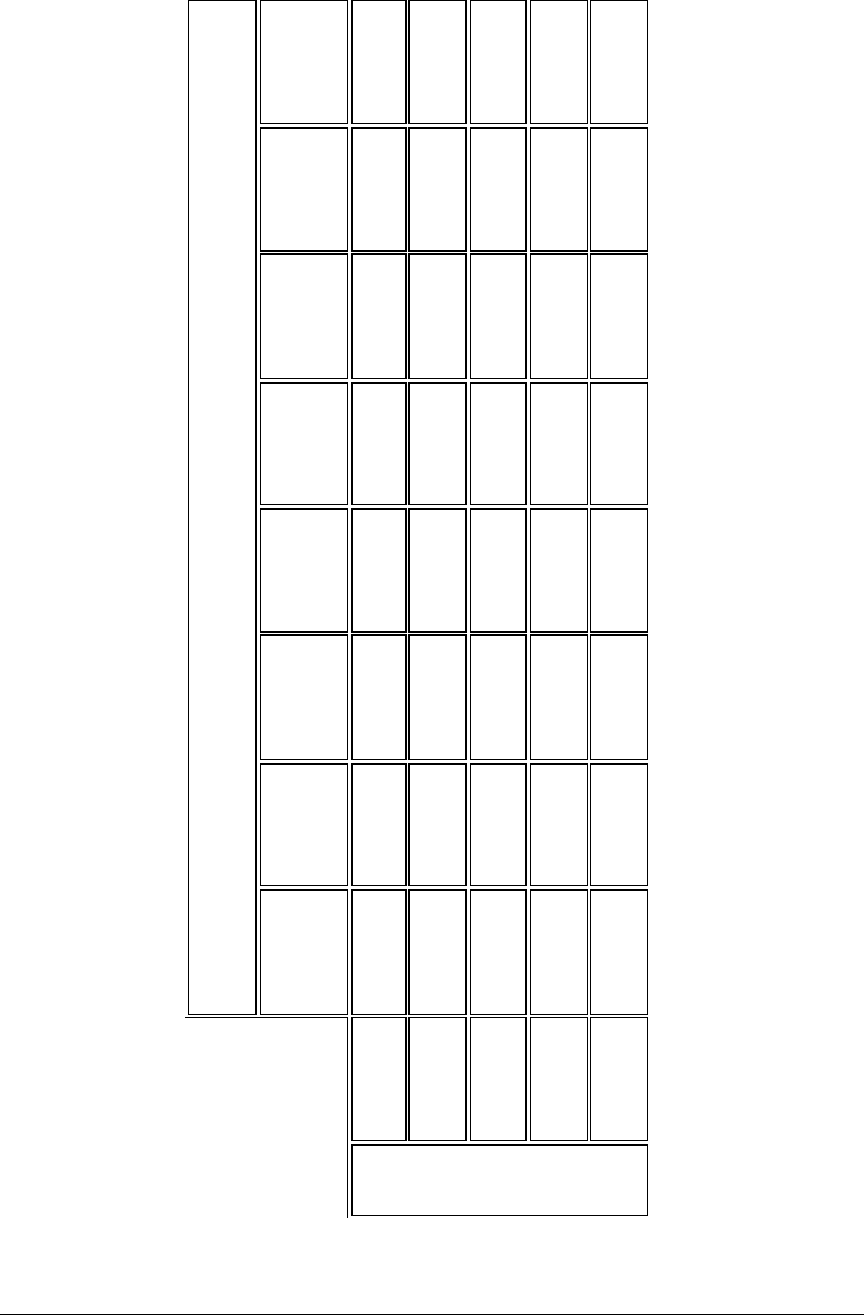
Velox LE Installation and Operations Manual
862-02411 February 04 9-3
Velox LE 5850i
Velox LE 5825 SRi
Velox LE 5850 IPi
Velox LE 5850 SRi
Velox LE 5850
Velox LE 5825 SR
Velox LE 5850 IP
Velox LE 5850 SR
Velox LE 5810i
Velox LE 5810 SRi
Velox LE 5810
Velox LE 5800
Velox LE 5810 SR
Velox LE 2450i
Velox LE 2425 SRi
Velox LE 2450 IPi
Velox LE 2450 SRi
Velox LE 2450
Velox LE 2425 SR
Velox LE 2450 IP
Velox LE 2450 SR
Velox LE 2410i
Velox LE 2410 SRi
RF Units
Velox LE 2410
Velox LE 2400
Velox LE 2410 SR
Velox LE
Velox LE 10
Velox LE 25
Velox LE 50 IP
Velox LE 50
DIU
Figure 9-1. System Matrix

Chapter 9. Product Range/Product Matrix
9-4 862-02411 February 04
System Variants
The system variants are listed in Table 9-3 below.
Table 9-3. System Variants
System Name Description
Velox LE 2400 One DIU and One High or Low band ORFU, Type-N RF
output, high power output for FCC and unregulated,
9.5Mbps link data capacity, fully scalable between 10Base-
T Ethernet and up to 4xE1(4x2Mbps) or 4xT1(4x1.5Mbps)
data interface
Velox LE 2410 SR One DIU and One High or Low band ORFU, Type-N RF
output, high power output for FCC and unregulated,
9.5Mbps link data capacity, fully scalable between 10Base-
T Ethernet and up to 4xE1(4x2Mbps) or 4xT1(4x1.5Mbps)
data interface
Velox LE 2410 SRi One DIU and One High or Low band IRFU, Type-N RF
output, high power output for FCC and unregulated,
9.5Mbps link data capacity, fully scalable between 10Base-
T Ethernet and up to 4xE1(4x2Mbps) or 4xT1(4x1.5Mbps)
data interface
Velox LE 2425 SR One DIU and One High or Low band ORFU, Type-N RF
output, high power output for FCC and unregulated,
25Mbps link data cap acity, 10Base-T Ethernet and up to
8xE1(8x2Mbps) or 8xT1(8x1.5Mbps) data interface
Velox LE 2425 SRi One DIU and One High or Low band IRFU, Type-N RF
output, high power output for FCC and unregulated,
25Mbps link data capacity, 10Base-T Ethernet and up to
8xE1(8x2Mbps) or 8xT1(8x1.5Mbps) data interface
Velox LE 2450 IP One DIU and One High or Low band ORFU, Type-N RF
output, high power output for FCC and unregulated, Up to
46 Mbps full duplex 10/100Base-T Ethernet data interface
Velox LE 2450 IPi One DIU and One High or Low band IRFU, Type-N RF
output, high power output for FCC and unregulated, Up to
46 Mbps full duplex 10/100Base-T Ethernet data interface
Velox LE 2450 SR One DIU and One High or Low band ORFU, Type-N RF
output, high power output for FCC and unregulated,
46Mbps link data capacity, fully scalable between
10/100Base-T Ethernet and up to 16xE1(16x2Mbps) or
16xT1(16x1.5Mbps) data interface
Velox LE 2450 SRi One DIU and One High or Low band IRFU, Type-N RF
output, high power output for FCC and unregulated,
46Mbps link data capacity, fully scalable between
10/100Base-T Ethernet and up to 16xE1(16x2Mbps) or
16xT1(16x1.5Mbps) data interface
Velox LE 5800 One DIU and One High or Low band ORFU, Type-N RF
output, high power output for FCC and unregulated,
9.5Mbps link data capacity, fully scalable between 10Base-
T Ethernet and up to 4xE1(4x2Mbps) or 4xT1(4x1.5Mbps)
data interface
Velox LE 5810 SR One DIU and One High or Low band ORFU, Type-N RF
output, high power output for FCC and unregulated,
9.5Mbps link data capacity, fully scalable between 10Base-
T Ethernet and up to 4xE1(4x2Mbps) or 4xT1(4x1.5Mbps)
data interface

Velox LE Installation and Operations Manual
862-02411 February 04 9-5
Velox LE 5810 SRi One DIU and One High or Low band IRFU, Type-N RF
output, high power output for FCC and unregulated,
9.5Mbps link data capacity, fully scalable between 10Base-
T Ethernet and up to 4xE1(4x2Mbps) or 4xT1(4x1.5Mbps)
data interface
Velox LE 5825 SR One DIU and One High or Low band ORFU, Type-N RF
output, high power output for FCC and unregulated,
25Mbps link data capacit y, 10Base-T Ethernet and up to
8xE1(8x2Mbps) or 8xT1(8x1.5Mbps) data interface
Velox LE 5825 SRi One DIU and One High or Low band IRFU, Type-N RF
output, high power output for FCC and unregulated,
25Mbps link data capacity, 10Base-T Ethernet and up to
8xE1(8x2Mbps) or 8xT1(8x1.5Mbps) data interface
Velox LE 5850 IP One DIU and One High or Low band ORFU, Type-N RF
output, high power output for FCC and unregulated, Up to
46 Mbps full duplex 10/100Base-T Ethernet data interface
Velox LE 5850 IPi One DIU and One High or Low band IRFU, Type-N RF
output, high power output for FCC and unregulated, Up to
46 Mbps full duplex 10/100Base-T Ethernet data interface
Velox LE 5850 SR One DIU and One High or Low band ORFU, Type-N RF
output, high power output for FCC and unregulated,
46Mbps link data capacity, fully scalable between
10/100Base-T Ethernet and up to 16xE1(16x2Mbps) or
16xT1(16x1.5Mbps) data interface
Velox LE 5850 SRi One DIU and One High or Low band IRFU, Type-N RF
output, high power output for FCC and unregulated,
46Mbps link data capacity, fully scalable between
10/100Base-T Ethernet and up to 16xE1(16x2Mbps) or
16xT1(16x1.5Mbps) data interface

Velox LE Installation and Operations Manual
862-02411 February 04 10-1
Chapter 10 : Ordering Information
Velox LE 2400 Digital Radio System
The Part Numbers for Velox LE 2400 Systems and Spare Parts available for these
systems are given in Table 10-1 below.
Table 10-1. Microwave Digital Radio System, 2.4GHz ISM Frequency Band, Spread Spectrum
Ordering Code Description
Velox LE 2400 Radio: 1 DIU and 1 High or Low band ORFU, Type-N RF output, high power
output for FCC and unregulated, 9.5Mbps link data capacity, fully scalable between 10Base-T
Ethernet and up to 4xE1(4x2Mbps) or 4xT1(4x1.5Mbps) data interface
Velox LE 2400 Microwave Digital Radios Complete
Balanced Interface - DB25 (specify - E1 or T1, Bridge or Router)
651-03994-01-H1-PT Velox LE 2400 Radio:1 DIU and 1 High Band ORFU - 1E1 /1T1
651-03994-01-L1-PT Velox LE 2400 Radio:1 DIU and 1 Low Band ORFU - 1E1 /1T1
651-03994-01-H2-PT Velox LE 2400 Radio:1 DIU and 1 High Band ORFU - 2E1 /2T1
651-03994-01-L2-PT Velox LE 2400 Radio:1 DIU and 1 Low Band ORFU - 2E1 /2T1
651-03994-01-H4-PT Velox LE 2400 Radio:1 DIU and 1 High Band ORFU - 4E1 /4T1
651-03994-01-L4-PT Velox LE 2400 Radio:1 DIU and 1 Low Band ORFU - 4E1 /4T1
Unbalanced Interface - BNC (specify - E1 or T1, Bridge or Router)
651-04106-01-H1-PT Velox LE 2400 Radio:1 DIU and 1 High Band ORFU - 1E1 /1T1
651-04106-01-L1-PT Velox LE 2400 Radio:1 DIU and 1 Low Band ORFU - 1E1 /1T1
651-04106-01-H2-PT Velox LE 2400 Radio:1 DIU and 1 High Band ORFU - 2E1 /2T1
651-04106-01-L2-PT Velox LE 2400 Radio:1 DIU and 1 Low Band ORFU - 2E1 /2T1
651-04106-01-H4-PT Velox LE 2400 Radio:1 DIU and 1 High Band ORFU - 4E1 /4T1
651-04106-01-L4-PT Velox LE 2400 Radio:1 DIU and 1 Low Band ORFU - 4E1 /4T1
Velox LE 2400 operates from 21-56Vdc, optional 110-220 Vac power supply available below.
A complete link requires two radios, one must be High Band (HB) and the other a Low Band (LB)
Spares Package for Velox LE 2400 Microwave Digital Radio System
Ordering Code Description
Velox LE 2400 Sp -Pkg: 1 DIU and 1 High and 1 Low band ORFU, Type-N RF output, high
power output for FCC and unregulated, 9.5Mbps link data capacity, fully scalable between
10Base-T Ethernet and up to 4xE1(4x2Mbps) or 4xT1(4x1.5Mbps) data interface
Balanced Interface - DB25 (specify - E1 or T1, Bridge or Router)
651-03994-01-S1-PT Velox LE 2400 Sp -Pkg:1 DIU and 1 HB and 1 LB ORFU - 1E1 /1T1
651-03994-01-S2-PT Velox LE 2400 Sp -Pkg:1 DIU and 1 HB and 1 LB ORFU - 2E1 /2T1
651-03994-01-S4-PT Velox LE 2400 Sp -Pkg:1 DIU and 1 HB and 1 LB ORFU - 4E1 /4T1

Chapter 10. Ordering Information
10-2 862-02411 February 04
Unbalanced Interface - BNC (specify - E1 or T1, Bridge or Router)
651-04106-01-S1 -PT Velox LE 2400 Sp-Pkg:1 DIU and 1 HB and 1 LB ORFU - 1E1 /1T1
651-04106-01-S2 -PT Velox LE 2400 Sp-Pkg:1 DIU and 1 HB and 1 LB ORFU - 2E1 /2T1
651-04106-01-S4 -PT Velox LE 2400 Sp-Pkg:1 DIU and 1 HB and 1 LB ORFU - 4E1 /4T1
RFU Spare Parts
651-03905-01L-PT Velox LE 2410 Low Band ORFU - Spare Part
651-03905-01H-PT Velox LE 2410 High Band ORFU - Spare Part
DIU Spare Part
Balanced Interface - DB25 (specify - E1 or T1)
651-04104-02-1-PT Velox LE DIU 1xE1/T1 - Spare Part
651-04104-02-2-PT Velox LE DIU 2xE1/T1 - Spare Part
651-04104-02-4-PT Velox LE DIU 4xE1/T1 - Spare Part
Unbalanced Interface - BNC (specify - E1 or T1)
651-04105-02-1-PT Velox LE DIU 1xE1/T1 - Spare Part
651-04105-02-2-PT Velox LE DIU 2xE1/T1 - Spare Part
651-04105-02-4-PT Velox LE DIU 4xE1/T1 - Spare Part
The Velox LE 2400 uses standard CAT5 Ethernet cable and RJ-45 connectors for connecting the DIU to the ORFU.
A two-wire power cable is also required between the DIU and the ORFU.
Note Screened Cat5 cable, and UV resistant cables are recommended for long term outdoor use.
Velox LE 2410 SR Digital Radio System
The Part Numbers for Velox LE 2410 SR Systems and Spare Parts available for these
systems are given in Table 10-2 below.
Table 10 -2. Microwave Digital Radio System, 2.4 GHz ISM Frequency Band, Spread Spectrum
Ordering Code Description
Velox LE 2410 SR Radio: 1 DIU and 1 High or Low band ORFU, Type-N RF output, high
power output for FCC and unregulated, 9.5Mbps link data capacity, fully scalable between
10Base-T Ethernet and up to 4xE1(4x2Mbps) or 4xT1(4x1.5Mbps) data interface
Velox LE 2410 SR Microwave Digital Radios Complete
Balanced Interface - DB25 (specify - E1 or T1, Bridge or Router)
651-04373-01-H1-PT Velox LE 2410 SR Radio:1 DIU and 1 High Band ORFU - 1E1 /1T1
651-04373-01-L1-PT Velox LE 2410 SR Radio:1 DIU and 1 Low Band ORFU - 1E1 /1T1
651-04373-01-H2-PT Velox LE 2410 SR Radio:1 DIU and 1 High Band ORFU - 2E1 /2T1
651-04373-01-L2-PT Velox LE 2410 SR Radio:1 DIU and 1 Low Band ORFU - 2E1 /2T1
651-04373-01-H4-PT Velox LE 2410 SR Radio:1 DIU and 1 High Band ORFU - 4E1 /4T1
651-04373-01-L4-PT Velox LE 2410 SR Radio:1 DIU and 1 Low Band ORFU - 4E1 /4T1
Unbalanced Interface - DB25 (specify - E1 or T1, Bridge or Router)
651-04376-01-H1-PT Velox LE 2410 SR Radio:1 DIU and 1 High Band ORFU - 1E1 /1T1
651-04376-01-L1-PT Velox LE 2410 SR Radio:1 DIU and 1 Low Band ORFU - 1E1 /1T1

Velox LE Installation and Operations Manual
862-02411 February 04 10-3
651-04376-01-H2-PT Velox LE 2410 SR Radio:1 DIU and 1 High Band ORFU - 2E1 /2T1
651-04376-01-L2-PT Velox LE 2410 SR Radio:1 DIU and 1 Low Band ORFU - 2E1 /2T1
651-04376-01-H4-PT Velox LE 2410 SR Radio:1 DIU and 1 High Band ORFU - 4E1 /4T1
651-04376-01-L4-PT Velox LE 2410 SR Radio:1 DIU and 1 Low Band ORFU - 4E1 /4T1
Velox LE 2410 SR operates from 21-58 Vdc (21-56Vdc where indicated), optional 110-220 Vac power supply available
below.
A complete link requires two radios, one must be High Band (HB) and the other a Low Band (LB)
Spares Package for Velox LE 2410 SR Microwave Digital Radio System
Ordering Code Description
Velox LE 2410 SR Sp -Pkg: DIU and 1 High and 1 Low band ORFU, Type-N RF output, high
power output for FCC and unregulated, 9.5Mbps link data capacity, fully scalable between
10Base-T Ethernet and up to 4xE1(4x2Mbps) or 4xT1(4x1.5Mbps) data interface
Balanced Interface - DB25 (specify - E1 or T1, Bridge or Router)
651-04373-01-S1-PT Velox LE 2410 SR Sp -Pkg:1 DIU and 1 HB and 1 LB ORFU - 1E1 /1T1
651-04373-01-S2-PT Velox LE 2410 SR Sp -Pkg:1 DIU and 1 HB and 1 LB ORFU - 2E1 /2T1
651-04373-01-S4-PT Velox LE 2410 SR Sp -Pkg:1 DIU and 1 HB and 1 LB ORFU - 4E1 /4T1
Unbalanced Interface - DB25 (specify - E1 or T1, Bridge or Router)
651-04376-01-S1-PT Velox LE 2410 SR Sp -Pkg:1 DIU and 1 HB and 1 LB ORFU - 1E1 /1T1
651-04376-01-S2-PT Velox LE 2410 SR Sp -Pkg:1 DIU and 1 HB and 1 LB ORFU - 2E1 /2T1
651-04376-01-S4-PT Velox LE 2410 SR Sp -Pkg:1 DIU and 1 HB and 1 LB ORFU - 4E1 /4T1
RFU Spare Part
651-03905-01L-PT Velox LE 2410 SR Low Band ORFU - Spare Part
651-03905-01H -PT Velox LE 2410 SR High Band ORFU - Spare Part
DIU Spare Part
Balanced Interface - DB25 (specify - E1 or T1)
651-04316-01-01-P Velox LE 10 DIU 1xE1/T1 - Spare Part
651-04316-01-02-P Velox LE 10 DIU 2xE1/T1 - Spare Part
651-04316-01-04-P Velox LE 10 DIU 4xE1/T1 - Spare Part
Unbalanced Interface - DB25 (specify - E1 or T1)
651-04378-01-01-P Velox LE 10 DIU 1xE1/T1 - Spare Part
651-04378-01-02-P Velox LE 10 DIU 2xE1/T1 - Spare Part
651-04378-01-04-P Velox LE 10 DIU 4xE1/T1 - Spare Part
The Velox LE 2410 SR uses standard CAT5 Ethernet cable and RJ-45 connectors for connecting the DIU to the ORFU.
A two -wire power cable is also required between the DIU and the ORFU.
Note Screened Cat5 cable, and UV resistant cables are recommended for long term outdoor use.
Velox LE 2410 SRi Digital Radio System
The Part Numbers for Velox LE 2410 SRi Systems and Spare Parts available for these
systems are given in Table 10-3 below.

Chapter 10. Ordering Information
10-4 862-02411 February 04
Table 10 -3. Microwave Digital Radio System, 2.4GHz ISM Frequency Band, Spread Spectrum -
All indoor radio
Ordering Code Description
Velox LE 2410 SRi Radio: 1 DIU and 1 High or Low band IRFU, Type-N RF output, high power
output for FCC and unregulated, 9.5Mbps link data capacity, fully scalable between 10Base-T
Ethernet and up to 4xE1(4x2Mbps) or 4xT1(4x1.5Mbps) data interface
Velox LE 2410 SRi Microwave Digital Radios Complete
Balanced Interface - DB25 (specify - E1 or T1, Bridge or Router)
651-04317-01-H1-PT Velox LE 2410 SRi Radio:1 DIU and 1 High Band IRFU - 1E1 /1T1
651-04317-01-L1-PT Velox LE 2410 SRi Radio:1 DIU and 1 Low Band IRFU - 1E1 /1T1
651-04317-01-H2-PT Velox LE 2410 SRi Radio:1 DIU and 1 High Band IRFU - 2E1 /2T1
651-04317-01-L2-PT Velox LE 2410 SRi Radio:1 DIU and 1 Low Band IRFU - 2E1 /2T1
651-04317-01-H4-PT Velox LE 2410 SRi Radio:1 DIU and 1 High Band IRFU - 4E1 /4T1
651-04317-01-L4-PT Velox LE 2410 SRi Radio:1 DIU and 1 Low Band IRFU - 4E1 /4T1
Unbalanced Interface - DB25 (specify - E1 or T1, Bridge or Router)
651-04381-01-H1-PT Velox LE 2410 SRi Radio:1 DIU and 1 High Band IRFU - 1E1 /1T1
651-04381-01-L1-PT Velox LE 2410 SRi Radio:1 DIU and 1 Low Band IRFU - 1E1 /1T1
651-04381-01-H2-PT Velox LE 2410 SRi Radio:1 DIU and 1 High Band IRFU - 2E1 /2T1
651-04381-01-L2-PT Velox LE 2410 SRi Radio:1 DIU and 1 Low Band IRFU - 2E1 /2T1
651-04381-01-H4-PT Velox LE 2410 SRi Radio:1 DIU and 1 High Band IRFU - 4E1 /4T1
651-04381-01-L4-PT Velox LE 2410 SRi Radio:1 DIU and 1 Low Band IRFU - 4E1 /4T1
Velox LE 2410 SRi operates from 21-58 Vdc (21-56Vdc where indicated), optional 110-220 Vac power supply available
below.
A complete link requires two radios, one must be High Band (HB) and the other a Low Band (LB)
Spares Package for Velox LE 2410 SRi Microwave Digital Radio System
Ordering Code Description
Velox LE 2410 SRi Sp -Pkg: DIU and 1 High and 1 Low band IRFU, Type-N RF output, high
power output for FCC and unregulated, 9.5Mbps link data capacity, fully scalable between 10Base-
T Ethernet and up to 4xE1(4x2Mbps) or 4xT1(4x1.5Mbps) data interface
Balanced Interface - DB25 (specify - E1 or T1, Bridge or Router)
651-04317-01-S1 -PT Velox LE 2410 SRi Sp -Pkg:1 DIU and 1 HB and 1 LB IRFU - 1E1 /1T1
651-04317-01-S2 -PT Velox LE 2410 SRi Sp -Pkg:1 DIU and 1 HB and 1 LB IRFU - 2E1 /2T1
651-04317-01-S4 -PT Velox LE 2410 SRi Sp -Pkg:1 DIU and 1 HB and 1 LB IRFU - 4E1 /4T1
Unbalanced Interface - DB25 (specify - E1 or T1, Bridge or Router)
651-04381-01-S1 -PT Velox LE 2410 SRi Sp -Pkg:1 DIU and 1 HB and 1 LB IRFU - 1E1 /1T1
651-04381-01-S2 -PT Velox LE 2410 SRi Sp -Pkg:1 DIU and 1 HB and 1 LB IRFU - 2E1 /2T1
651-04381-01-S4 -PT Velox LE 2410 SRi Sp -Pkg:1 DIU and 1 HB and 1 LB IRFU - 4E1 /4T1
RFU Spare Part
651-04353-01L-P Velox LE 2410 SRi Low Band IRFU - Spare Part
651-04353-01H-P Velox LE 2410 SRi High Band IRFU - Spare Part
DIU Spare Part

Velox LE Installation and Operations Manual
862-02411 February 04 10-5
Balanced Interface - DB25 (specify - E1 or T1)
651-04316-01-01-P Velox LE 10 DIU 1xE1/T1 - Spare Part
651-04316-01-02-P Velox LE 10 DIU 2xE1/T1 - Spare Part
651-04316-01-04-P Velox LE 10 DIU 4xE1/T1 - Spare Part
Unbalanced Interface - DB25 (specify - E1 or T1)
651-04378-01-01-P Velox LE 10 DIU 1xE1/T1 - Spare Part
651-04378-01-02-P Velox LE 10 DIU 2xE1/T1 - Spare Part
651-04378-01-04-P Velox LE 10 DIU 4xE1/T1 - Spare P art
The Velox LE 2410 SRi uses standard CAT5 Ethernet cable and RJ-45 connectors for connecting the DIU to the IRFU.
A two -wire power cable is also required between the DIU and the IRFU.
Note Screened Cat5 cable, and UV resistant cables are recommended for long term outdoor use.
Velox LE 2425 SR Digital Radio System
The Part Numbers for Velox LE 2425 SR Systems and Spare Parts available for these
systems are given in Table 10-4 below.
Table 10-4. Microwave Digital Radio System, 2.4GHz ISM Frequency Band, Spread Spectrum
Ordering Code Description
Velox LE 2425 SR Radio: 1 DIU and 1 High or Low band ORFU, Type-N RF output, high power
output for FCC and unregulated, 25Mbps link data capacity, 10Base-T Ethernet and up to
8xE1(8x2Mbps) or 8xT1(8x1.5Mbps) data interface
Velox LE 2425 Microwave Digital Radios Complete
Balanced Interface - DB25 (specify - E1 or T1, Bridge or Router)
651-04367-01-H08-P Velox LE 2425 SR Radio:1 DIU and 1 High Band ORFU - 8E1 /8T1
651-04367-01-L08-P Velox LE 2425 SR Radio:1 DIU and 1 Low Band ORFU - 8E1 /8T1
Unbalanced Interface - DB25 (specify - E1 or T1, Bridge or Router)
651-04390-01-H08-P Velox LE 2425 SR Radio:1 DIU and 1 High Band ORFU - 8E1 /8T1
651-04390-01-L08-P Velox LE 2425 SR Radio:1 DIU and 1 Low Band ORFU - 8E1 /8T1
Velox LE 2425 SR Radio operates from 21-58 Vdc (21-56Vdc where indicated), optional 110-
220 Vac power supply available
below.
A complete link requires two radios, one must be High Band (HB) and the other a Low Band (LB)
Spares Package for Velox LE 2425 SR Microwave Digital Radio System
Ordering Code Description
Velox LE 2425 SR Sp -Pkg: 1 DIU and 1 High and 1 Low band ORFU, Type-N RF output, high
power output for FCC and unregulated, 25Mbps link data capacity, 10Base-T Ethernet and up to
8xE1(8x2Mbps) or 8xT1(8x1.5Mbps) data interface
Balanced Interface - DB25 (specify - E1 or T1, Bridge or Router)
651-04367-01-S08-P Velox LE 2425 SR Sp -Pkg:1 DIU and 1 HB and 1 LB ORFU - 8E1 /8T1
Unbalanced Interface - DB25 (specify - E1 or T1, Bridge or Router)
651-04390-01-S08-P Velox LE 2425 SR Sp -Pkg:1 DIU and 1 HB and 1 LB ORFU - 8E1 /8T1

Chapter 10. Ordering Information
10-6 862-02411 February 04
RFU Spare Part
651-04368-01L-P Velox LE 2450 Low Band ORFU - Spare Part
651-04368-01H-P Velox LE 2450 High Band ORFU - Spare Part
DIU Spare Part
Balanced Interface - DB25 (specify - E1 or T1)
651-04313-01-08-P Velox LE 25 DIU 8xE1/T1 - Spare Part
Unbalanced Interface - DB25 (specify - E1 or T1)
651-04386-01-08-P Velox LE 25 DIU 8xE1/T1 - Spare Part
Velox LE 2425 SRi Digital Radio System
The Part Numbers for Velox LE 2425 SRi Systems and Spare Parts available for these
systems are given in Table 10-5 below.
Table 10 -5. Microwave Digital Radio System, 2.4GHz ISM Frequency Band, Spread Spectrum -
All indoor radio
Ordering Code Description
Velox LE 2425 SRi Radio: 1 DIU and 1 High or Low band IRFU, Type-N RF output, high power
output for FCC and unregulated, 25Mbps link data capacity, 10Base-T Ethernet and up to
8xE1(8x2Mbps) or 8xT1(8x1.5Mbps) data interface
Velox LE 2425 SRi Microwave Digital Radios Complete
Balanced Interface - DB25 (specify - E1 or T1, Bridge or Router)
651-04369-01-H08-P Velox LE 2425 SRi Radio:1 DIU and 1 High Band IRFU - 8E1 /8T1
651-04369-01-L08-P Velox LE 2425 SRi Radio:1 DIU and 1 Low Band IRFU - 8E1 /8T1
Unbalanced Interface - DB25 (specify - E1 or T1, Bridge or Router)
651-04403-01-H08-P Velox LE 2425 SRi Radio:1 DIU and 1 High Band IRFU - 8E1 /8T1
651-04403-01-L08-P Velox LE 2425 SRi Radio:1 DIU and 1 Low Band IRFU - 8E1 /8T1
Velox LE 2425 SRi Radio operates from 21-58 Vdc (21-56Vdc where indicated), optional 110-220 Vac power supply
available below.
A complete link requires two radios, one must be High Band (HB) and the other a Low Band (LB)
Spares Package for Velox LE 2425 SRi Microwave Digital Radio System
Ordering Code Description
Velox LE 2425 SRi Sp -Pkg: 1 DIU and 1 High and 1 Low band IRFU, Type-N RF output, high
power output for FCC and unregulated, 25Mbps link data capacity, 10Base-T Ethernet and up to
8xE1(8x2Mbps) or 8xT1(8x1.5Mbps) data interface
Balanced Interface - DB25 (specify - E1 or T1, Bridge or Router)
651-04369-01-S08-P Velox LE 2425 SRi Sp -Pkg:1 DIU and 1 HB and 1 LB IRFU - 8E1 /8T1
Unbalanced Interface - DB25 (specify - E1 or T1, Bridge or Router)
651-04403-01-S08-P Velox LE 2425 SRi Sp -Pkg:1 DIU and 1 HB and 1 LB IRFU - 8E1 /8T1
RFU Spare Part

Velox LE Installation and Operations Manual
862-02411 February 04 10-7
651-04370-01L-P Velox LE 2450i Low Band IRFU - Spare Part
651-04370-01H -P Velox LE 2450i High Band IRFU - Spare Part
DIU Spare Part
Balanced Interface - DB25 (specify - E1 or T1)
651-04313-01-08-P Velox LE 25 DIU 8xE1/T1 - Spare Part
Unbalanced Interface - DB25 (specify - E1 or T1)
651-04386-01-08-P Velox LE 25 DIU 8xE1/T1 - Spare Part
Velox LE 2450 IP Digital Radio System
The Part Numbers for Velox LE 2450 IP Systems and Spare Parts available for these
systems are given in Table 10-6 below.
Table 10-6. Microwave Digital Radio System, 2.4GHz ISM Frequency Band, Spread Spectrum
Ordering Code Description
Velox LE 2450 IP Microwave Digital Radios Complete
Velox LE 2450 IP Radio: 1 DIU and 1 High or Low band ORFU, Type-N RF output, high power
output for FCC and unregulated, Up to 46 Mbps full duplex 10/100Base-T Ethernet data interface
651-04371-01-HE-P Velox LE 2450 IP Radio:1 DIU and 1 High Band ORFU - IP only
651-04371-01-LE-P Velox LE 2450 IP Radio:1 DIU and 1 Low Band ORFU - IP only
Velox LE 2450 IP Radio operates from 21-58 Vdc, optional 110-220 Vac power supply available below.
A complete link requires two radios, one must be High Band (HB) and the other a Low Band (LB)
Spares Package for Velox LE 2450 IP Microwave Digital Radio System
Ordering Code Description
Velox LE 2450 IP Sp -Pkg: 1 DIU and 1 High and 1 Low band ORFU, Type-N RF output, high
power output for FCC and unregulated, Up to 46 Mbps full duplex 10/100Base-T Ethernet data
interface
651-04371-01-SE-P Velox LE 2450 IP Sp -Pkg:1 DIU and 1 HB and 1 LB ORFU - IP only
RFU Spare Part
651-04368-01L-P Velox LE 2450 Low Band ORFU - Spare Part
651-04368-01H -P Velox LE 2450 High Band ORFU - Spare Part
DIU (specify - E1 or T1) Spare Part
651-04322-01-E-P Velox LE IP DIU IP only - Spare Part
Velox LE 2450 IPi Digital Radio System
The Part Numbers for Velox LE 2450 IPi Systems and Spare Parts available for these
systems are given in Table 10-7 below.

Chapter 10. Ordering Information
10-8 862-02411 February 04
Table 10 -7. Microwave Digital Radio System, 2.4GHz ISM Frequency Band, Spread Spectrum -
All indoor radio
Ordering Code Description
Velox LE 2450 IPi Radio: 1 DIU and 1 High or Low band IRFU, Type-N RF output, high power
output for FCC and unregulated, Up to 46 Mbps full duplex 10/100Base-T Ethernet data interface
Velox LE 2450 IPi Microwave Digital Radios Complete
651-04374-01-HE-P Velox LE 2450 IPi Radio:1 DIU and 1 High Band IRFU - IP only
651-04374-01-LE-P Velox LE 2450 IPi Radio:1 DIU and 1 Low Band IRFU - IP only
Velox LE 2450 IPi Radio operates from 21-58 Vdc, optional 110-220 Vac power supply available below.
A complete link requires two radios, one must be High Band (HB) and the other a Low Band (LB)
Spares Package for Velox LE 2450 IPi Microwave Digital Radio System
Ordering Code Description
Velox LE 2450 IPi Sp -Pkg: 1 DIU and 1 High and 1 Low band IRFU, Type-N RF output, high
power output for FCC and unregulated, Up to 46 Mbps full duplex Ethernet 10/100Base-T data
interface
651-04374-01-SE -P Velox LE 2450 IPi Sp -Pkg:1 DIU and 1 HB and 1 LB IRFU - IP only
RFU Spare Part
651-04370-01L-P Velox LE 2450i Low Band IRFU - Spare Part
651-04370-01H-P Velox LE 2450i High Band IRFU - Spare Part
DIU (specify - E1 or T1) Spare Part
651-04322-01-E-P Velox LE IP DIU IP only - Spare Part
Velox LE 2450 SR Digital Radio System
The Part Numbers for Velox LE 2450 SR Systems and Spare Parts available for these
systems are given in Table 10-8 below.
Table 10 -8. Microwave Digital Radio System, 2.4GHz ISM Frequency Band, Spread Spectrum
Velox LE 2450 SR Microwave Digital Radios Complete
Ordering Code Description
Velox LE 2450 SR Radio: 1 DIU and 1 High or Low band ORFU, Type-N RF output, high power
output for FCC and unregulated, 46Mbps link data capacity, fully scalable between 10/100Base-T
Ethernet and up to 16xE1(16x2Mbps) or 16xT1(16x1.5Mbps) data interface
651-04377-01-H16-P Velox LE 2450 SR Radio:1 DIU and 1 High Band ORFU - 16E1 /16T1
651-04377-01-L16-P Velox LE 2450 SR Radio:1 DIU and 1 Low Band ORFU - 16E1 /16T1
Velox LE 2450 SR Radio operates from 21-58 Vdc, optional 110-220 Vac power supply available below.
A complete link requires two radios, one must be High Band (H B) and the other a Low Band (LB)
Microwave Digital Radio System Spare Parts for Velox LE 2450 SR
Ordering Code Description

Velox LE Installation and Operations Manual
862-02411 February 04 10-9
Velox LE 2450 SR Sp -Pkg: 1 DIU and 1 High and 1 Low band ORFU, Type-N RF output, high
power output for FCC and unregulated, 46Mbp s link data capacity, fully scalable between
10/100Base-T Ethernet and up to 16xE1(16x2Mbps) or 16xT1(16x1.5Mbps) data interface
651-04377-01-S16-P Velox LE 2450 SR Sp -Pkg:1 DIU and 1 HB and 1 LB ORFU - 16E1 /16T1
RFU Spare Part
651-04368-01L-P Velox LE 2450 Low Band ORFU - Spare Part
651-04368-01H -P Velox LE 2450 High Band ORFU - Spare Part
DIU (specify - E1 or T1) Spare Part
651-04379-01-16-P Velox LE 50 DIU 16xE1/T1 - Spare Part
Velox LE 2450 SRi Digital Radio System
The Part Numbers for Velox LE 2450 Sri Systems and Spare Parts available for these
systems are given in Table 10-9 below.
Table 10-9. Microwave Digital Radio System, 2.4GHz ISM Frequency Band, Spread Spectrum -
All indoor radio
Ordering Code Description
Velox LE 2450 SRi Radio: 1 DIU and 1 High or Low band IRFU, Type-N RF output, high power
output for FCC and unregulated, 46Mbps link data capacity, fully scalable between 10/100Base-T
Ethernet and up to 16xE1(16x2Mbps) or 16xT1(16x1.5Mbps) data interface
Velox LE 2450 SRi Microwave Digital Radios Complete
651-04380-01-H16-P Velox LE 2450 SRi Radio:1 DIU and 1 High Band IRFU - 16E1 /16T1
651-04380-01-L16-P Velox LE 2450 SRi Radio:1 DIU and 1 Low Band IRFU - 16E1 /16T1
Velox LE 2450 SRi Radio operates from 21-58 Vdc, optional 110-220 Vac power supply available below.
A complete link requires two radios, one must be High Band (HB) and the other a Low Band (LB)
Spares Package for Velox LE 2450 SRi Microwave Digital Radio System
Ordering Code Description
Velox LE 2450 SRi Sp-Pkg: 1 DIU and 1 High and 1 Low band IRFU, Type-N RF output, high
power output for FCC and unregulated, 46Mbps link data capacity, fully scalable between
10/100Base-T Ethernet and up to 16xE1(16x2Mbps) or 16xT1(16x1.5Mbps) data interface
651-04380-01-S16-P Velox LE 2450 SRi Sp-Pkg:1 DIU and 1 HB and 1 LB IRFU - 16E1 /16T1
RFU Spare Part
651-04370-01L-P Velox LE 2450i Low Band IRFU - Spare Part
651-04370-01H -P Velox LE 2450i High Band IRFU - Spare Part
DIU (specify - E1 or T1) Spare Part
651-04379-01-16-P Velox LE 50 DIU 16xE1/T1 - Spare Part
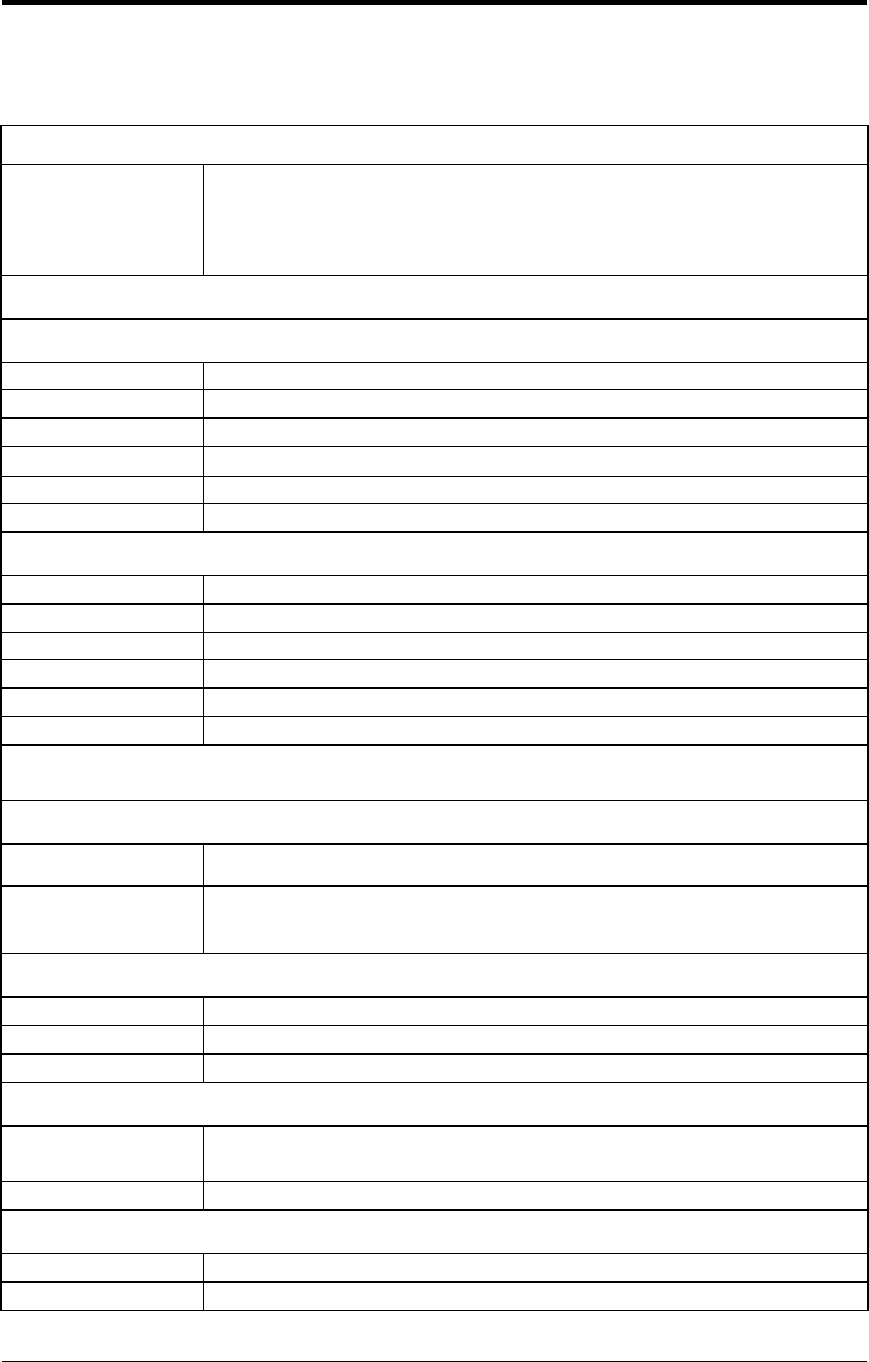
Chapter 10. Ordering Information
10-10 862-02411 February 04
Velox LE 5800 Digital Radio System
The Part Numbers for Velox LE 5800 Systems and Spare Parts available for these
systems are given in Table 10-10 below.
Table 10 -10. Microwave Digital Radio System, 5.8GHz ISM Frequency Band, Spread Spectrum
Ordering Code Description
Velox LE 5800 Radio: 1 DIU and 1 High or Low band ORFU, T ype-N RF output, high power
output for FCC and unregulated, 9.5Mbps link data capacity, fully scalable between 10Base-T
Ethernet and up to 4xE1(4x2Mbps) or 4xT1(4x1.5Mbps) data interface
Velox LE 5800 Microwave Digital Radios Complete
Balanced Interface - DB25 (specify - E1 or T1, Bridge or Router)
651-03853-02-H1-PT Velox LE 5800 Radio:1 DIU and 1 High Band ORFU - 1E1 /1T1
651-03853-02-L1-PT Velox LE 5800 Radio:1 DIU and 1 Low Band ORFU - 1E1 /1T1
651-03853-02-H2-PT Velox LE 5800 Radio:1 DIU and 1 High Band ORFU - 2E1 /2T1
651-03853-02-L2-PT Velox LE 5800 Radio:1 DIU and 1 Low Band ORFU - 2E1 /2T1
651-03853-02-H4-PT Velox LE 5800 Radio:1 DIU and 1 High Band ORFU - 4E1 /4T1
651-03853-02-L4-PT Velox LE 5800 Radio:1 DIU and 1 Low Band ORFU - 4E1 /4T1
Unbalanced Interface - BNC (specify - E1 or T1, Bridge or Router)
651-04055-02-H1-PT Velox LE 5800 Radio:1 DIU and 1 High Band ORFU - 1E1 /1T1
651-04055-02-L1-PT Velox LE 5800 Radio:1 DIU and 1 Low Band ORFU - 1E1 /1T1
651-04055-02-H2-PT Velox LE 5800 Radio:1 DIU and 1 High Band ORFU - 2E1 /2T1
651-04055-02-L2-PT Velox LE 5800 Radio:1 DIU and 1 Low Band ORFU - 2E1 /2T1
651-04055-02-H4-PT Velox LE 5800 Radio:1 DIU and 1 High Band ORFU - 4E1 /4T1
651-04055-02-L4-PT Velox LE 5800 Radio:1 DIU and 1 Low Ba nd ORFU - 4E1 /4T1
Velox LE 5800 operates from 21-56 Vdc, optional 110-220 Vac power supply available below.
A complete link requires two radios, one must be High Band (HB) and the other a Low Band (LB)
Spares Package for Velox LE 5800 Microwave Digital Radio System
Ordering Code Description
Velox LE 5800 Sp-Pkg: 1 DIU and 1 High and 1 Low band ORFU, Type-N RF output, high
power output for FCC and unregulated, 9.5Mbps link data capacity, fully scalable between
10Base-T Ethernet and up to 4xE1(4x2Mbp s) or 4xT1(4x1.5Mbps) data interface
Balanced Interface - DB25 (specify - E1 or T1, Bridge or Router)
651-03853-02-S1 -PT Velox LE 5800 Sp-Pkg:1 DIU and 1 HB and 1 LB ORFU - 1E1 /1T1
651-03853-02-S2 -PT Velox LE 5800 Sp-Pkg:1 DIU and 1 HB and 1 LB ORFU - 2E1 /2T1
651-03853-02-S4 -PT Velox LE 5800 Sp-Pkg:1 DIU and 1 HB and 1 LB ORFU - 4E1 /4T1
Unbalanced Interface - BNC (specify - E1 or T1, Bridge or Router)
651-04055-02-S1 -PT Velox LE 5800 Sp-Pkg:1 DIU and 1 HB and 1 LB ORFU - 1E1 /1T1
651-04055-02-S2 -PT Velox LE 5800 Sp-Pkg:1 DIU and 1 HB and 1 LB ORFU - 2E1 /2T1
651-04055-02-S4 -PT Velox LE 5800 Sp-Pkg:1 DIU and 1 HB and 1 LB ORFU - 4E1 /4T1
RFU Spare Part
651-03806-02L-PT Velox LE 5810 Low Band ORFU - Spare Part
651-03806-02H-PT Velox LE 5810 High Band ORFU - Spare Part

Velox LE Installation and Operations Manual
862-02411 February 04 10-11
DIU Spare Part
Balanced Interface - DB25 (specify - E1 or T1)
651-04104-02-1-PT Velox LE DIU 1xE1/T1 - Spare Part
651-04104-02-2-PT Velox LE DIU 2xE1/T1 - Spare Part
651-04104-02-4-PT Velox LE DIU 4xE1/T1 - Spare Part
Unbalanced Interface - BNC (specify - E1 or T1)
651-04105-02-1-PT Velox LE DIU 1xE1/T1 - Spare Part
651-04105-02-2-PT Velox LE DIU 2xE1/T1 - Spare Part
651-04105-02-4-PT Velox LE DIU 4xE1/T1 - Spare Part
The Velox LE 5800 uses standard CAT5 Ethernet cable and RJ-45 connectors for connecting the DIU to the ORFU.
A two -wire power cable is also required between the DIU and the ORFU.
Note Screened Cat5 cable, and UV resistant cables are recommended for long term outdoor use.
Velox LE 5810 SR Digital Radio System
The Part Numbers for Velox LE 5810 SR Systems and Spare Parts available for these
systems are given in Table 10-11 below.
Table 10-11. Microwave Digital Radio System, 5.8GHz ISM Frequency Band, Spread Spectrum
Ordering Code Description
Velox LE 5810 SR Radio: 1 DIU and 1 High or Low band ORFU, Type-N RF output, high power
output for FCC and unregulated, 9.5Mbps link data capacity, fully scalable between 10Base-T
Ethernet and up to 4xE1(4x2Mbps) or 4xT1(4x1.5Mbps) data interface
Velox LE 5810 SR Microwave Digital Radios Complete
Balanced Interface - DB25 (specify - E1 or T1, Bridge or Router)
651-04375-02-H1-PT Velox LE 5810 SR Radio:1 DIU and 1 High Band ORFU - 1E1 /1T1
651-04375-02-L1-PT Velox LE 5810 SR Radio:1 DIU and 1 Low Band ORFU - 1E1 /1T1
651-04375-02-H2-PT Velox LE 5810 SR Radio:1 DIU and 1 High Band ORFU - 2E1 /2T1
651-04375-02-L2-PT Velox LE 5810 SR Radio:1 DIU and 1 Low Band ORFU - 2E1 /2T1
651-04375-02-H4-PT Velox LE 5810 SR Radio:1 DIU and 1 High Band ORFU - 4E1 /4T1
651-04375-02-L4-PT Velox LE 5810 SR Radio:1 DIU and 1 Low Band ORFU - 4E1 /4T1
Unbalanced Interface - DB25 (specify - E1 or T1, Bridge or Router)
651-04382-02-H1-PT Velox LE 5810 SR Radio:1 DIU and 1 High Band ORFU - 1E1 /1T1
651-04382-02-L1-PT Velox LE 5810 SR Radio:1 DIU and 1 Low Band ORFU - 1E1 /1T1
651-04382-02-H2-PT Velox LE 5810 SR Radio:1 DIU and 1 High Band ORFU - 2E1 /2T1
651-04382-02-L2-PT Velox LE 5810 SR Radio:1 DIU and 1 Low Band ORFU - 2E1 /2T1
651-04382-02-H4-PT Velox LE 5810 SR Radio:1 DIU and 1 High Band ORFU - 4E1 /4T1
651-04382-02-L4-PT Velox LE 5810 SR Radio:1 DIU and 1 Low Band ORFU - 4E1 /4T1
Velox LE 5810 SR operates from 21-58 Vdc (21-56Vdc where indicated), optional 110-220 Vac power supply available
below.
A complete link requires two radios, one must be High Band (HB) and the other a Low Band (LB)
Spares Package for Velox LE 5810 SR Microwave Digital Radio System

Chapter 10. Ordering Information
10-12 862-02411 February 04
Ordering Code Description
Velox LE 5810 SR Sp -Pkg: 1 DIU and 1 High and 1 Low band ORFU, Type-N RF output, high
power output for FCC and unregulated, 9.5Mbps link data capacity, fully scalable between 10Base-
T Ethernet and up to 4xE1(4x2Mbps) or 4xT1(4x1.5Mbps) data interface
Balanced Interface - DB25 (specify - E1 or T1, Bridge or Router)
651-04375-02-S1 -PT Velox LE 5810 SR Sp -Pkg:1 DIU and 1 HB and 1 LB ORFU - 1E1 /1T1
651-04375-02-S2 -PT Velox LE 5810 SR Sp -Pkg:1 DIU and 1 HB and 1 LB ORFU - 2E1 /2T1
651-04375-02-S4 -PT Velox LE 5810 SR Sp -Pkg:1 DIU and 1 HB and 1 LB ORFU - 4E1 /4T1
Unbalanced Interface - DB25 (specify - E1 or T1, Bridge or Router)
651-04382-02-S1 -PT Velox LE 5810 SR Sp -Pkg:1 DIU and 1 HB and 1 LB ORFU - 1E1 /1T1
651-04382-02-S2 -PT Velox LE 5810 SR Sp -Pkg:1 DIU and 1 HB and 1 LB ORFU - 2E1 /2T1
651-04382-02-S4 -PT Velox LE 5810 SR Sp -Pkg:1 DIU and 1 HB and 1 LB ORFU - 4E1 /4T1
RFU Spare Part
651-03806-02L-PT Velox LE 5810 SR Low Band ORFU - Spare Part
651-03806-02H-PT Velox LE 5810 SR High Band ORFU - Spare Part
DIU Spare Part
Balanced Interface - DB25 (specify - E1 or T1)
651-04316-01-01-P Velox LE 10 DIU 1xE1/T1 - Spare Part
651-04316-01-02-P Velox LE 10 DIU 2xE1/T1 - Spare Part
651-04316-01-04-P Velox LE 10 DIU 4xE1/T1 - Spare Part
Unbalanced Interface - DB25 (specify - E1 or T1)
651-04378-01-01-P Velox LE 10 DIU 1xE1/T1 - Spare Part
651-04378-01-02-P Velox LE 10 DIU 2xE1/T1 - Spare Part
651-04378-01-04-P Velox LE 10 DIU 4xE1/T1 - Spare Part
The Velox LE 5810 SR uses standard CAT5 Ethernet cable and RJ-45 connectors for connecting the DIU to the ORFU.
A two-wire power cable is also required between the DIU and the ORFU.
Note Screened Cat5 cable, and UV resistant cables are recommended for long term outdoor use.
Velox LE 5810 SRi Digital Radio System
The Part Numbers for Velox LE 5810 SRi Systems and Spare Parts available for these
systems are given in Table 10-12 below.
Table 10 -12. Microwave Digital Radio System, 5.8GHz ISM Frequency Band, Spread Spectrum -
All indoor radio
Ordering Code Description
Velox LE 5810 SRi Radio: 1 DIU and 1 High or Low band IRFU, Type-N RF output, high power
output for FCC and unregulated, 9.5Mbps link data capacity, fully scalable between 10Base-T
Ethernet and up to 4xE1(4x2Mbps) or 4xT1(4x1.5Mbps) data interface
Velox LE 5810 SRI Microwave Digital Radios Complete
Balanced Interface - DB25 (specify - E1 or T1, Bridge or Router)

Velox LE Installation and Operations Manual
862-02411 February 04 10-13
651-04318-02-H1-PT Velox LE 5810 SRi Radio:1 DIU and 1 High Band IRFU - 1E1 /1T1
651-04318-02-L1-PT Velox LE 5810 SRi Radio:1 DIU and 1 Low Band IRFU - 1E1 /1T1
651-04318-02-H2-PT Velox LE 5810 SRi Radio:1 DIU and 1 High Band IRFU - 2E1 /2T1
651-04318-02-L2-PT Velox LE 5810 SRi Radio:1 DIU and 1 Low Band IRFU - 2E1 /2T1
651-04318-02-H4-PT Velox LE 5810 SRi Radio:1 DIU and 1 High Band IRFU - 4E1 /4T1
651-04318-02-L4-PT Velox LE 5810 SRi Radio:1 DIU and 1 Low Band IRFU - 4E1 /4T1
Unbalanced Interface - DB25 (specify - E1 or T1, Bridge or Router)
651-04383-02-H1-PT Velox LE 5810 SRi Radio:1 DIU and 1 High Band IRFU - 1E1 /1T1
651-04383-02-L1-PT Velox LE 5810 SRi Radio:1 DIU and 1 Low Band IRFU - 1E1 /1T1
651-04383-02-H2-PT Velox LE 5810 SRi Radio:1 DIU and 1 High Band IRFU - 2E1 /2T1
651-04383-02-L2-PT Velox LE 5810 SRi Radio:1 DIU and 1 Low Band IRFU - 2E1 /2T1
651-04383-02-H4-PT Velox LE 5810 SRi Radio:1 DIU and 1 High Band IRFU - 4E1 /4T1
651-04383-02-L4-PT Velox LE 5810 SRi Radio:1 DIU and 1 Low Band IRFU - 4E1 /4T1
Velox LE 5810 SRi operates from 21-58 Vdc (21-56Vdc where indicted), optional 110-220 Vac power supply available below.
A complete link requires two radios, one must be High Band (HB) and the other a Low Band (LB)
Spares Package for Velox LE 5810 SRi Microwave Digital Radio System
Ordering Code Description
Velox LE 5810 SRi Sp-Pkg: 1 DIU and 1 High and 1 Low band IRFU, Type-N RF output, high
power output for FCC and unregulated, 9.5Mbps link data capacity, fully scalable between 10Base-
T Ethernet and up to 4xE1(4x2Mbps) or 4xT1(4x1.5Mbps) data interface
Balanced Interface - DB25 (specify - E1 or T1, Bridge or Router)
651-04318-02-S1-PT Velox LE 5810 SRi Sp-Pkg:1 DIU and 1 HB and 1 LB IRFU - 1E1 /1T1
651-04318-02-S2-PT Velox LE 5810 SRi Sp-Pkg:1 DIU and 1 HB and 1 LB IRFU - 2E1 /2T1
651-04318-02-S4-PT Velox LE 5810 SRi Sp-Pkg:1 DIU and 1 HB and 1 LB IRFU - 4E1 /4T1
Unbalanced Interface - DB25 (specify - E1 or T1, Bridge or Router)
651-04383-02-S1-PT Velox LE 5810 SRi Sp-Pkg:1 DIU and 1 HB and 1 LB IRFU - 1E1 /1T1
651-04383-02-S2-PT Velox LE 5810 SRi Sp-Pkg:1 DIU and 1 HB and 1 LB IRFU - 2E1 /2T1
651-04383-02-S4-PT Velox LE 5810 SRi Sp-Pkg:1 DIU and 1 HB and 1 LB IRFU - 4E1 /4T1
RFU Spare Part
651-04354-01L-PT Velox LE 5810 SRi Low Band IRFU - Spare Part
651-04354-01H -PT Velox LE 5810 SRi High Band IRFU - Spare Part
DIU Spare Part
Balanced Interface - DB25 (specify - E1 or T1)
651-04316-01-01-P Velox LE 10 DIU 1xE1/T1 - Spare Part
651-04316-01-02-P Velox LE 10 DIU 2xE1/T1 - Spare Part
651-04316-01-04-P Velox LE 10 DIU 4xE1/T1 - Spare Part
Unbalanced Interface - DB25 (specify - E1 or T1)
651-04378-01-01-P Velox LE 10 DIU 1xE1/T1 - Spare Part
651-04378-01-02-P Velox LE 10 DIU 2xE1/T1 - Spare Part
651-04378-01-04-P Velox LE 10 DIU 4xE1/T1 - Spare Part
The Velox LE 5810 SRi uses standard CAT5 Ethernet cable and RJ-45 connectors for connecting the DIU to the IRFU.

Chapter 10. Ordering Information
10-14 862-02411 February 04
A two-wire power cable is also required between the DIU and the IRFU.
Note Screened Cat5 cable, and UV resistant cables are recommended for long term outdoor use.
Velox LE 5825 SR Digital Radio System
The Part Numbers for Velox LE 5825 SR Systems and Spare Parts available for these
systems are given in Table 10-13 below.
Table 10 -13. Microwave Digital Radio System, 5.8GHz ISM Frequency Band, Spread Spectrum
Ordering Code Description
Velox LE 5825 SR Radio: 1 DIU and 1 High or Low band ORFU, Type-N RF output, high power
output for FCC and unregulated, 25Mbps link data capacity, 10Base-T Ethernet and up to
8xE1(8x2Mbps) or 8xT1(8x1.5Mbps) data interface
Velox LE 5825 SR Microwave Digital Radios Complete
Balanced Interface - DB25 (specify - E1 or T1, Bridge or Router)
651-04253-01-H08-P Velox LE 5825 SR Radio:1 DIU and 1 High Band ORFU - 8E1 /8T1
651-04253-01-L08-P Velox LE 5825 SR Radio:1 DIU and 1 Low Band ORFU - 8E1 /8T1
Unbalanced Interface - DB25 (specify - E1 or T1, Bridge or Router)
651-04384-01-H08-P Velox LE 5825 SR Radio:1 DIU and 1 High Band ORFU - 8E1 /8T1
651-04384-01-L08-P Velox LE 5825 SR Radio:1 DIU and 1 Low Band ORFU - 8E1 /8T1
Velox LE 5825 SR Radio operates from 21-58 Vdc (21-56Vdc where indicted), optional 110-220 Vac power supply available
below.
A complete link requires two radios, one must be High Band (HB) and the other a Low Band (LB)
Spares Package for Velox LE 5825 SR Microwave Digital Radio System
Ordering Code Description
Velox LE 5825 SR Sp-Pkg: 1 DIU and 1 High and 1 Low band ORFU, Type-N RF output, high
power output for FCC and unregulated, 25Mbps link data capacity, 10Base-T Ethernet and up to
8xE1(8x2Mbps) or 8xT1(8x1.5Mbps) data interface
Balanced Interface - DB25 (specify - E1 or T1, Bridge or Router)
651-04253-01-S08-P Velox LE 5825 SR Sp-Pkg:1 DIU and 1 HB and 1 LB ORFU - 8E1 /8T1
Unbalanced Interface - DB25 (specify - E1 or T1, Bridge or Router)
651-04384-01-S08-P Velox LE 5825 SR Sp-Pkg:1 DIU and 1 HB and 1 LB ORFU - 8E1 /8T1
RFU Spare Part
651-04254-01L-P Velox LE 5850 Low Band ORFU - Spare Part
651-04254-01H-P Velox LE 5850 High Band ORFU - Spare Part
DIU Spare Part
Balanced Interface - DB25 (specify - E1 or T1)
651-04313-01-08-P Velox LE 25 DIU 8xE1/T1 - Spare Part
Unbalanced Interface - DB25 (specify - E1 or T1)
651-04386-01-08-P Velox LE 25 DIU 8xE1/T1 - Spare Part

Velox LE Installation and Operations Manual
862-02411 February 04 10-15
Velox LE 5825 SRi Digital Radio System
The Part Numbers for Velox LE 5825 SRi Systems and Spare Parts available for these
systems are given in Table 10-14 below.
Table 10-14. Microwave Digital Radio System, 5.8GHz ISM Frequency Band, Spread Spectrum -
All indoor radio
Ordering Code Description
Velox LE 5825 SRi Radio: 1 DIU and 1 High or Low band IRFU, Type-N RF output, high power
output for FCC and unregulated, 25Mbps link data capacity, 10Base-T Ethernet and up to
8xE1(8x2Mbps) or 8xT1(8x1.5Mbps) data interface
Velox LE 5825 SRi Microwave Digital Radios Complete
Balanced Interface - DB25 (specify - E1 or T1, Bridge or Router)
651-04342-01-H08-P Velox LE 5825 SRi Radio:1 DIU and 1 High Band IRFU - 8E1 /8T1
651-04342-01-L08-P Velox LE 5825 SRi Radio:1 DIU and 1 Low Band IRFU - 8E1 /8T1
Unbalanced Interface - DB25 (specify - E1 or T1, Bridge or Router)
651-04388-01-H08-P Velox LE 5825 SRi Radio:1 DIU and 1 High Band IRFU - 8E1 /8T1
651-04388-01-L08-P Velox LE 5825 SRi Radio:1 DIU and 1 Low Band IRFU - 8E1 /8T1
Velox LE 5825 SRi Radio operates from 21-58 Vdc (21-56Vdc where indicted), optional 110-220 Vac power supply available
below.
A complete link requires two radios, one must be High Band (HB) and the other a Low Band (LB)
Ordering Code Description
Velox LE 5825 SRi Sp-Pkg: 1 DIU and 1 High and 1 Low band IRFU, Type-N RF output, high
power output for FCC and unregulated, 25Mbps link data capacity, 10Base-T Ethernet and up to
8xE1(8x2Mbps) or 8xT1(8x1.5Mbps) data interface
Spares Package for Velox LE 5825 SRi Microwave Digital Radio System
Balanced Interface - DB25 (specify - E1 or T1, Bridge or Router)
651-04342-01-S08-P Velox LE 5825 SRi Sp-Pkg:1 DIU and 1 HB and 1 LB IRFU - 8E1 /8T1
Unbalanced Interface - DB25 (specify - E1 or T1, Bridge or Router)
651-04388-01-S08-P Velox LE 5825 SRi Sp-Pkg:1 DIU and 1 HB and 1 LB IRFU - 8E1 /8T1
RFU Spare Part
651-04358-01L-P Velox LE 5850i Low Band IRFU - Spare Part
651-04358-01H -P Velox LE 5850i High Band IRFU - Spare Part
DIU Spare Part
Balanced Interface - DB25 (specify - E1 or T1)
651-04313-01-08-P Velox LE 25 DIU 8xE1/T1 - Spare Part
Unbalanced Interface - DB25 (specify - E1 or T1)
651-04386-01-08-P Velox LE 25 DIU 8xE1/T1 - Spare Part

Chapter 10. Ordering Information
10-16 862-02411 February 04
Velox LE 5850 IP Digital Radio System
The Part Numbers for Velox LE 5850 IP Systems and Spare Parts available for these
systems are given in Table 10-15 below.
Table 10 -15. Microwave Digital Radio System, 5.8GHz ISM Frequency Band, Spread Spectrum
Ordering Code Description
Velox LE 5850 IP Radio: 1 DIU and 1 High or Low band ORFU, Type-N RF output, high power
output for FCC and unregulated, Up to 46 Mbps full duplex 10/100Base-T Ethernet data interface
Velox LE 5850 IP Microwave Digital Radios Complete
651-04305-01-HE-P Velox LE 5850 IP Radio:1 DIU and 1 High Band ORFU - IP only
651-04305-01-LE-P Velox LE 5850 IP Radio:1 DIU and 1 Low Band ORFU - IP only
Velox LE 5850 IP Radio operates from 21-58 Vdc, optional 110-220 Vac power supply available below.
A complete link requires two radios, one must be High Band (HB) and the other a Low Band (LB)
Spares Package for Velox LE 5850 IP Microwave Digital Radio System
Ordering Code Description
Velox LE 5850 IP Sp-Pkg: 1 DIU and 1 High and 1 Low band ORFU, Type-N RF output, high
power output for FCC and unregulated, Up to 46 Mbps full duplex 10/100Base-T Ethernet data
interface
651-04305-01-SE -P Velox LE 5850 IP Sp-Pkg:1 DIU and 1 HB and 1 LB ORFU - IP only
RFU Spare Part
651-04254-01L-P Velox LE 5850 Low Band ORFU - Spare Part
651-04254-01H-P Velox LE 5850 High Band ORFU - Spare Part
DIU (specify - E1 or T1) Spare Part
651-04322-01-E-P Velox LE IP DIU IP only - Spare Part
Velox LE 5850 IPi Digital Radio System
The Part Numbers for Velox LE 5850 IPi Systems and Spare Parts available for these
systems are given in Table 10-16 below.
Table 10 -16. Microwave Digital Radio System, 5.8GHz ISM Frequency Band, Spread Spectrum -
All indoor radio
Velox LE 5850 IPi Microwave Digital Radios Complete
Ordering Code Description
Velox LE 5850 IPi Radio: 1 DIU and 1 High or Low band IRFU, Type-N RF output, high power
output for FCC and unregulated, up to 46 Mbps full duplex 10/100Base-T Ethernet data interface
651-04385-01-HE-P Velox LE 5850 IPi Radio:1 DIU and 1 High Band IRFU - IP only
651-04385-01-LE-P Velox LE 5850 IPi Radio:1 DIU and 1 Low Band IRFU - IP only
Velox LE 5850 IPi Radio operates from 21-58 Vdc, optional 110-220 Vac power supply available below.
A complete link requires two radios, one must be High Band (HB) and the other a Low Band (LB)
Spares Package for Velox LE 5850 IPi Microwave Digital Radio System

Velox LE Installation and Operations Manual
862-02411 February 04 10-17
Ordering Code Description
Velox LE 5850 IPi Sp-Pkg: 1 DIU and 1 High and 1 Low band IRFU, Type-N RF output, high
power output for FCC and unregulated, up to 46 Mbps full duplex 10/100Base-T Ethernet data
interface
651-04385-01-SE-P Velox LE 5850 IPi Sp-Pkg:1 DIU and 1 HB and 1 LB IRFU - IP only
RFU Spare Part
651-04358-01L-P Velox LE 5850i Low Band IRFU - Spare Part
651-04358-01H -P Velox LE 5850i High Band IRFU - Spare Part
DIU (specify - E1 or T1) Spare Part
651-04322-01-E-P Velox LE IP DIU IP only - Spare Part
Velox LE 5850 SR Digital Radio System
The Part Numbers for Velox LE 5850 SR Systems and Spare Parts available for these
systems are given in Table 10-17 below.
Table 10-17. Microwave Digital Radio System, 5.8GHz ISM Frequency Band, Spread Spectrum
Ordering Code Description
Velox LE 5850 SR Radio: 1 DIU and 1 High or Low band ORFU, Type-N RF output, high power
output for FCC and unregulated, 46Mbps link data capacity, fully scalable between 10/100Base-T
Ethernet and up to 16xE1(16x2Mbps) or 16xT1(16x1.5Mbps) data interface
Velox LE 5850 SR Microwave Digital Radios Complete
651-04387-01-H16-P Velox LE 5850 SR Radio:1 DIU and 1 High Band ORFU - 16E1 /16T1
651-04387-01-L16-P Velox LE 5850 SR Radio:1 DIU and 1 Low Band ORFU - 16E1 /16T1
Velox LE 5850 SR Radio operates from 21-58 Vdc, optional 110-220 Vac power supply available below.
A complete link requires two radios, one must be High Band (HB) and the other a Low Band (LB)
Spares Package for Velox LE 5850 SR Microwave Digital Radio System
Ordering Code Description
Velox LE 5850 SR Sp -Pkg: 1 DIU and 1 High and 1 Low band ORFU, Type-N RF output, high
power output for FCC and unregulated, 46Mbps link data capacity, fully scalable between
10/100Base-T Ethernet and up to 16xE1(16x2Mbps) or 16xT1(16x1.5Mbps) data interface
651-04387-01-S16-P Velox LE 5850 SR Sp -Pkg:1 DIU and 1 HB and 1 LB ORFU - 16E1 /16T1
RFU Spare Part
651-04254-01L-P Velox LE 5850 Low Band ORFU - Spare Part
651-04254-01H -P Velox LE 5850 High Band ORFU - Spare Part
DIU (specify - E1 or T1) Spare Part
651-04379-01-16-P Velox LE 50 DIU 16xE1/T1 only - Spare Part

Chapter 10. Ordering Information
10-18 862-02411 February 04
Velox LE 5850 SRi Digital Radio System
The Part Numbers for Velox LE 5850 SRi Systems and Sp are Parts available for these
systems are given in Table 10-18 below.
Table 10 -18. Microwave Digital Radio System, 5.8GHz ISM Frequency Band, Spread Spectrum -
All indoor radio
Orde ring Code Description
Velox LE 5850 SRi Radio: 1 DIU and 1 High or Low band IRFU, Type-N RF output, high power
output for FCC and unregulated, 46Mbps link data capacity, fully scalable between 10/100Base-T
Ethernet and up to 16xE1(16x2Mbps) or 16xT1(16x1.5Mbps) data interface
Velox LE 5850 SRi Microwave Digital Radios Complete
651-04389-01-H16-P Velox LE 5850 SRi Radio:1 DIU and 1 High Band IRFU - 16E1 /16T1
651-04389-01-L16-P Velox LE 5850 SRi Radio:1 DIU and 1 Low Band IRFU - 16E1 /16T1
Velox LE 5850 SRi Radio operates from 21-58 Vdc, optional 110-220 Vac power supply available below.
A complete link requires two radios, one must be High Band (HB) and the other a Low Band (LB)
Spares Package for Velox LE 5850 SRi Microwave Digital Radio System
Ordering Code Description
Velox LE 5850 SRi Sp -Pkg: 1 DIU and 1 High and 1 Low band IRFU, Type-N RF output, high
power output for FCC and unregulated, 46Mbps link data capacity, fully scalable between
10/100Base-T Ethernet and up to 16xE1(16x2Mbps) or 16xT1(16x1.5Mbps) data interface
651-04389-01-S16-P Velox LE 5850 SRi Sp -Pkg:1 DIU and 1 HB and 1 LB IRFU - 16E1 /16T1
RFU Spare Part
651-04358-01L-P Velox LE 5850i Low Band IRFU - Spare Part
651-04358-01H-P Velox LE 5850i High Band IRFU - Spare Part
DIU (specify - E1 or T1) Spare Part
651-04379-01-16-P Velox LE 50 DIU 16xE1/T1 only - Spare Part
Velox LE Accessories, Spares and Upgrades
Table 10 -19. Velox LE Accessories & Upgrades
Ordering Code Description
651 -04226 Velox LE 4B 1+1 hot standby combiner/splitter (4 tribs - Balanced)
651 -04227 Velox LE 8B 1+1 hot standby combiner/splitter (8 tribs - Balanced)
651 -04347 Velox LE 8U 1+1 hot standby combiner/splitter (8 tribs - Unbalanced)
651 -03987 75/120 Ohm Patch Panel Assembly
478 -07865 19" Rack Mount for Outdoor Unit (4u high)
651 -03864 Bench Power Supply 110-220VAC to 24VDC
651 -03868-02 Velox LE 2400 & Velox LE 5800 NMS Software Disk - Spare Part
651 -04252-02 Velox LE NMS Software CD - Spare Part
651 -03809 ODU Pole Mounting Kit - Spare Part
862 -01881 Velox LE User Manual - Spare Part
660 -03405 Cable Assembly: RSSI Test Loom - Spare Part
651 -03865 Velox LE Upgrade 1xE1/T1 to 2xE1/T1

Velox LE Installation and Operations Manual
862-02411 February 04 10-19
651-03866 Velox LE Upgrade 2xE1/T1 to 4xE1/T1
651-03867 Velox LE Upgrade 1xE1/T1 to 4xE1/T1

Velox LE Installation and Operations Manual
862-02411 February 04 11-1
Chapter 11 : Domain/Network
Management of the Velox LE Product
Range
Introduction
All management of the Velox LE products are implemented using SNMP (Simple
Network Management Protocol), an open standard. The products can be managed by:
a. Standard SNMP managers such as HP OpenView or SNMPc, i.e. there is Open
Network Management compatibility.
For rapid product installation, the NCT GUI Application (hereafter referred to as the
NCT-GA) provides extensive management functions on site and, via the microwave
radio link, can be used to access the Velox LE station on the opposite side of the link.
The NCT -GA is a software application that runs on a PC workstation such as a laptop
or notebook computer that is connected to a Velox LE DIU serial port (DB9 DTE) or an
Ethernet connection (10Base-T DTE), both accessed via the DIU front-panel.
NOTE: The lates NCT can be downloaded from www.stratexnet.co.za/updates
SNMP and the Velox LE
Use of SNMP within the product allows remote: configuration, monitoring of
performance, notification of alarms and firmware upgrades via an IP-network. Within
an IP network supporting routing of IP data, the radios can be supported from any
remote location. The product can be accessed via the Internet if the necessary gateways
are provided. A GSM/PCS modem dial-up capability provides another remote
management option.
The DIUs have built-in SNMP agents and an extensive MIB (Management Information
Base). The Velox LE product uses SNMP V1 (RFC1155, 1157). The user has access
to an Enterprise MIB (obtainable Stratex Support – see Support on page 1-4 for details)
and MIB II (RFC 1213).
Access to the MIB via the DIU SNMP agent is via Ethernet (10Base-T interface on the
product's front panel) or PPP (RFC 1661) via the product's serial channel Element
Manager Port. The use of SNMP provides flexibility for operators with central
equipment monitoring. It provides management access to radio configuration (all data
interfaces), interface status and statistics, fault and maintenance information.
Using a login and password to give the user “administrator” or “standard user” rights (if
enabled) ensures SNMP security. The "standard user rights" option limits the ability to
SET MIB variables.

Chapter 11. Domain/Network Management of the Velox LE Product Range
11-2 862-02411 February 04
NOTE: Secure SNMP is not supported.
The product has threshold-based alarm generation (there is an extensive SNMP trap list
with a trap filter that is adjustable via SNMP). Network access (wired or wireless i.e.
GSM/PCS Modem) allows over-the-air remote firmware uploading (FTP) with a load
verification (and reversion) capability.
There are three principle requirements to use SNMP with the Velox LE Radio Stations:
a. A Management Station that runs a SNMP Management Software package that is
installed on a networked or stand-alone PC that can be connected to a DIU either
using a serial connection or an Ethernet connection. From the Management
station, the agents within the DIUs can be configured or polled for information.
b. Agent: The agent accepts SNMP GET, SET or GET-NEXT commands from the
Management Application software and collects or adjusts information from the
DIUs MIB.
c. Management Information Base (MIB): the MIB is a database that is accessed
based on the OID (object ID) the SNMP Manager has chosen. The DIU uses an
Enterprise MIB and a standard MIB (MIB II) to store or allow access to
information relevant to the Velox LE link.
MIB Elements – OID (Object ID) Descriptions
NOTE: The MIB database is updated on a regular basis. Information on the latest
additions can be obtained from www.stratexnet.co.za/firmware.
Table 11-1. OID Descriptions for the MIB Elements
Object ID Object name Object
Type Access
Rights Description
.1316 Stratex
.1316.1 products
.1316.1.1 digitalradio
.1316.1.1.1 Mdrmte
.1316.1.1.1.1 MdrmtePerformance
.1316.1.1.1.2 MdrmteConfiguration
.1316.1.1.1.3 MdrmteFault
.1316.1.1.1.4 MdrmteAccess
.1316.1.1.1.5 MdrmteRelayOutputs
.1316.1.1.1.6 MdrmteOptoInputs
.1316.1.1.1.1.1 MdrmtePayloadPerf
.1316.1.1.1.1.1.1 MdrmtePpTable SEQUENCE not-
accessible
.1316.1.1.1.1.1.1.1 MdrmtePpEntry MdrmtePpEnt
ry not-
accessible
.1316.1.1.1.1.1.1.1.1 MdrmtePpIndex INTEGER read-only

Velox LE Installation and Operations Manual
862-02411 February 04 11-3
Table 11-1. OID Descriptions for the MIB Elements
Object ID Object name Object
Type Access
Rights Description
.1316.1.1.1.1.1.1.1.2 MdrmtePpLOS INTEGER read-only
A Loss of Signal has been
detected on the input to a
tributary - there is one for each
tributary (0, 1, 2, 3, ...).
.1316.1.1.1.1.1.1.1.3 MdrmtePpAIS INTEGER read-only
An Alarm Indication Signal has
been detected on the input to a
tributary - there is one for each
tributary (0, 1, 2, 3, ...).
.1316.1.1.1.1.1.2 MdrmteCrcErrors INTEGER read-only
The number of CRC4 or CRC6
errors seen on the selected
tributary since the last time errors
were cleared.
.1316.1.1.1.1.1.3 MdrmteCrcTribSelect INTEGER read-write The tributary selected for CRC
checking.
.1316.1.1.1.1.1.4 MdrmteCrcLock INTEGER read-only
Indication of whether the CRC
checking algorithm has locked
onto a CRC frame signature in
the payload data.
.1316.1.1.1.1.1.5 MdrmteCrcEbitCnt INTEGER read-only
Reflects the number of assertions
of the 'E' bits in selected
tributary.
.1316.1.1.1.1.2 MdrmteRFLinkPerf
.1316.1.1.1.1.2.1 MdrmteCarrierDetect INTEGER read-only
Indicates if a RF Carrier has been
detected by the RFU - if so, the
header in the RF Packet has been
identified as a potential valid
packet - note however, that it
could be received from another
transmitter that uses the same
header format.
.1316.1.1.1.1.2.2 MdrmteRSSI Gauge read-only
A dBm value representative of
the received signal level. The
value detected is representative
of the level that would be
measured should a spread
spectrum signal be input at the
RFUs Diplexer RF Port - a CW
(Continuous Wave) signal will
appear to be 20 dB higher.
.1316.1.1.1.1.2.3 MdrmteCurrentPER DisplayString
read-only
This is the current Packet Error
Rate and is based on the number
of “uncorrectable” packets/blocks
being detected by the FEC
(Forward Error Correction)
circuitry within the DIU (based
of the number of errored packets
divided by the total number of
packets transmitted in a
measurement period of
250msec).
.1316.1.1.1.1.2.4 MdrmteMaximizedPER DisplayString
read-only
This is the maximum Packet
Error Rate detected during the
last measurement period, based
number of maximum number.
.1316.1.1.1.1.2.5 MdrmteLinkUnavailable INTEGER read-only
Based on G.826 criteria, this
MIB element indicates RF Link
Availability/Non-availability

Chapter 11. Domain/Network Management of the Velox LE Product Range
11-4 862-02411 February 04
Table 11-1. OID Descriptions for the MIB Elements
Object ID Object name Object
Type Access
Rights Description
.1316.1.1.1.1.2.6 MdrmteFrameUnlock INTEGER read-only
The data that is transmitted
across the RF Link is conveyed
in a frame, compiled within.
.1316.1.1.1.1.2.7 MdrmteRemoteFrameUnlock INTEGER read-only
Frame-lock
(MdrmteFrameUnlock) as seen
by the other end of the link is fed
back here.
.1316.1.1.1.1.2.8 MdrmteErrSecRatioExceeded INTEGER read-only
The ESR is a ratio of the number
of Errored seconds (one second
periods within.
.1316.1.1.1.1.2.9 MdrmteSevErrSecRatioExceeded INTEGER read-only
The SESR is a ratio of the
number of Severely Errored
seconds (one second periods
within.
.1316.1.1.1.1.2.10 MdrmteBkgrndBlkErrRatioExceeded
INTEGER read-only
The BBER is a ratio of the
number of uncorrectable
blocks/packets received.
.1316.1.1.1.1.2.11 MdrmteMinorPERExceede d INTEGER read-only
This parameter indicates if the
minor packet (uncorrectable by
FEC) error rate has been
exceeded based on the defined.
.1316.1.1.1.1.2.12 MdrmteMajorPERExceeded INTEGER read-only
This parameter indicates if the
major packet (uncorrectable by
FEC) error rate has been
exceeded based on the defined.
.1316.1.1.1.1.2.13 MdrmteCriticalPERExceeded INTEGER read-only
This parameter indicates if the
critical packet (uncorrectable by
FEC) error rate has been
exceeded based on the defined.
.1316.1.1.1.1.2.14 MdrmtePrevParamsRestored INTEGER read-only Indicates if autorecovery for the
RFU settings had to be invoked.
.1316.1.1.1.1.2.15 MdrmteAveragePER DisplayString
read-only
This is the current Average
Packet Error Rate and is based on
the number of.
.1316.1.1.1.1.2.16 MdrmteStartSweep INTEGER read-write This is used to start the spectral
RSSI sweep.
.1316.1.1.1.1.2.17 MdrmteRssiSpectrum DisplayString
read-only This contains the results of the
sweep through the spectrum of.
.1316.1.1.1.1.3 MdrmteG826
.1316.1.1.1.1.3.1 MdrmteStatus INTEGER read-only Indicates if 'G.826-like' errored,
severely errored and unavailable.
.1316.1.1.1.1.3.2 MdrmteTotalSeconds Counter read-only
Indicates the total number of
seconds, both available and
unavailable.
.1316.1.1.1.1.3.3 MdrmteAvailableSeconds Counter read-only
A period of unavailable time
begins at the onset of ten
consecutive SES events.
.1316.1.1.1.1.3.4 MdrmteUnavailableSeconds Counter read-only
A period of unavailable time
begins at the onset of ten
consecutive SES events.
.1316.1.1.1.1.3.5 MdrmteErroredSeconds Counter read-only
A one second period with one or
more errored packets(not
correctable packets) or at least
one defect.

Velox LE Installation and Operations Manual
862-02411 February 04 11-5
Table 11-1. OID Descriptions for the MIB Elements
Object ID Object name Object
Type Access
Rights Description
.1316.1.1.1.1.3.6 MdrmteSeverelyErroredSeconds Counter read-only
A one-second period which
contains > 30% errored blocks or
at least one defect. SES is a
subset of ES.
.1316.1.1.1.1.3.7 MdrmteErroredBlocks Counter read-only
A packet which has been
identified as containing not
correctable bits by the FEC
circuitry
.1316.1.1.1.1.3.8 MdrmteBackgroundBlockErrors Counter read-only
An errored block not occurring as
part of a SES.
.1316.1.1.1.1.3.9 MdrmteErroredSecondsRatio DisplayString
read-only
The ratio of ES to total seconds
in available time during a fixed
measurement interval.
.1316.1.1.1.1.3.10 MdrmteSeverelyErroredSecondsRati
o DisplayString
read-only
The ratio of SES to total seconds
in available time during a fixed
measurement interval.
.1316.1.1.1.1.3.11 MdrmteBackgroundBlockErrorRatio DisplayString
read-only
The ratio of Background Block
Errors (BBE) to total blocks in
available time
.1316.1.1.1.1.3.12 MdrmteDeprecated2 INTEGER write-only Deprecated
.1316.1.1.1.1.3.13 MdrmteCorrectedSymbols INTEGER read-only
This parameter lists the number
of corrected symbols i.e. those
corrected by the FEC
.1316.1.1.1.1.4 MdrmteCounters
.1316.1.1.1.1.4.1 MdrmteLostEthRxPkts Counter read-only
Indicates the total number of
times an Ethernet packet could
not be buffered
.1316.1.1.1.1.4.2 MdrmteLostLinkRxPkts Counter read-only
Indicates the total number of
times a link packet could not be
buffered
.1316.1.1.1.1.4.3 MdrmteLostWaySideTxPkts Counter read-only
Indicates the total number of
times a wayside packet could not
be buffered
.1316.1.1.1.1.4.4 MdrmteScc1FullCnt Counter read-only Indicates the total number of
times SCC1 was full to capacity
.1316.1.1.1.1.4.5 MdrmteScc2FullCnt Counter read-only Indicates the total number of
times SCC2 was full to capacity
.1316.1.1.1.1.4.6 MdrmteScc1UnderrunCnt Counter read-only Indicates the total number of
times SCC1 ran out of BDs
.1316.1.1.1.1.4.7 MdrmteScc2UnderrunCnt Counter read-only Indicates the total number of
times SCC2 ran out of BDs
.1316.1.1.1.1.4.8 MdrmteScc2RxBdAbortCnt Counter read-only
Indicates the total number of
times SCC2 received an aborted
frame
.1316.1.1.1.1.4.9 MdrmteScc2RxBdNonOctCnt Counter read-only
Indicates the total number of
times SCC2 received a Non octet
aligned frame
.1316.1.1.1.1.4.10 MdrmteScc2RxBdCrcCnt Counter read-only
Indicates the total number of
times SCC2 received a frame
with a CRC error
.1316.1.1.1.1.4.11 MdrmteEtherTxRetries Counter read-only
Indicates the total number of
(collisions) packets that were
retransmitted on Ethernet

Chapter 11. Domain/Network Management of the Velox LE Product Range
11-6 862-02411 February 04
Table 11-1. OID Descriptions for the MIB Elements
Object ID Object name Object
Type Access
Rights Description
.1316.1.1.1.1.4.12 MdrmteEtherTxDeferCnt Counter read-only
Indicates the total number of
frames deferred due to early
collisions on Ethernet
.1316.1.1.1.1.4.13 MdrmteEtherTxHeartBeatCnt Counter read-only
Indicates the total number of
times the collision inup was not
asserted on Ethernet
.1316.1.1.1.1.4.14 MdrmteEtherTxLateCollisions Counter read-only Indicates the total number of late
collisions on Ethernet
.1316.1.1.1.1.4.15 MdrmteEtherReTxLimit Counter read-only
Indicates the total number of
times the retransmission limit
was reached on Ethernet
.1316.1.1.1.1.4.16 MdrmteEtherTxUnderrun Counter read-only Indicates the total number of
buffer under runs on Ethernet
.1316.1.1.1.1.4.17 MdrmteEtherTxCarrierLost Counter read-only Indicates the total number of
times carrier was lost on Ethernet
.1316.1.1.1.1.4.18 MdrmteEtherRxLenErr Counter read-only
Indicates the total number of
frame length violations received
on Ethernet
.1316.1.1.1.1.4.19 MdrmteEtherRxNonOctet Counter read-only
Indicates the total number of
non-octet aligned frames
received on Ethernet
.1316.1.1.1.1.4.20 MdrmteEtherRxShort Counter read-only
Indicates the total number of
(too) short frames received on
Ethernet
.1316.1.1.1.1.4.21 MdrmteEtherRxCRCerr Counter read-only
Indicates the total number of
CRC errored frames received on
Ethernet
.1316.1.1.1.1.4.22 MdrmteEtherRxOverrun Counter read-only
Indicates the total number of
receiver overruns received on
Ethernet
.1316.1.1.1.1.4.23 MdrmteEtherRxCollision Counter read-only
Indicates the total number of
"collision" frames received on
Ethernet
.1316.1.1.1.1.4.24 MdrmteEtherJunkFrames Counter read-only
Indicates the total number of
invalid frames received on
Ethernet
.1316.1.1.1.1.4.25 MdrmteEtherShortFrames Counter read-only
Indicates the total number of
times the Ethernet frame received
was too short .
.1316.1.1.1.1.4.26 MdrmteEtherTxBdsFull Counter read-only
Indicates the total number of
times the Ethernet Tx BD queue
was too full to insert data
.1316.1.1.1.1.4.27 MdrmteEtherRxPauseCnt Counter read-only
Indicates the total number of
times the Ethernet receiver was
disabled due to lack of buffers.
.1316.1.1.1.1.4.28 MdrmteIdma1InUse Counter read-only
Indicates the total number of
times IDMA controller 1 was
already in use. memcpy() was
used instead.
.1316.1.1.1.1.4.29 MdrmteIdma2InUse Counter read-only
Indicates the total number of
times IDMA controller 2 was
already in use. memcpy() was
used instead.

Velox LE Installation and Operations Manual
862-02411 February 04 11-7
Table 11-1. OID Descriptions for the MIB Elements
Object ID Object name Object
Type Access
Rights Description
.1316.1.1.1.1.4.30 MdrmteLinkKnQueueFull Counter read-only
Indicates the total number of
times a Kwiknet frame was
deferred due to a lack of space in
the AMX link queue.
.1316.1.1.1.1.4.31 MdrmteLinkTxBdsFull Counter read-only
Indicates the total number of
times the RF Link Tx BD queue
was too full to insert data
.1316.1.1.1.1.4.32 MdrmteKnEtherFramesLost Counter read-only
Indicates the total number of
times the Kwiknet queue was too
full to insert Ethernet data
.1316.1.1.1.1.4.33 MdrmteKnCraftFramesLost Counter read-only
Indicates the total number of
times the Kwiknet queue was too
full to insert SCC4 data
.1316.1.1.1.1.4.34 MdrmteKnLinkFramesLost Counter read-only
Indicates the total number of
times the Kwiknet queue was too
full to insert SCC2 data
.1316.1.1.1.1.4.35 MdrmteKnFramesTooShort Counter read-only
Indicates the total number of
times the Kwiknet buffer
allocated was too short.
.1316.1.1.1.1.4.36 MdrmteLinkVoidFrames Counter read-only
Indicates the total number of
overwritten frames received on
the wireless PPP link
.1316.1.1.1.1.4.37 MdrmteLinkRxPauseCnt Counter read-only
Indicates the total number of
times the link receiver was
disabled due to lack of buffers.
.1316.1.1.1.1.4.38 MdrmteRelayServerRestarts Counter read-only
Indicates the total number of
times the Relay scripting server
restarted.
.1316.1.1.1.1.4.39 MdrmteRelayClientRestarts Counter read-only
Indicates the total number of
times the Relay scripting client
restarted.
.1316.1.1.1.1.4.40 MdrmteMuxEtherErrors Counter read-only The number of Ethernet errors
reported by the FPGA
.1316.1.1.1.1.4.41 MdrmteMuxBlockErrors Counter read-only The number of Block errors
reported by the FPGA
.1316.1.1.1.1.4.42 MdrmteOuRxEtherCRCerrors Counter read-only
The number of Ethernet errors
reported by the FPGA on the
RFU
.1316.1.1.1.1.5 MdrmteResetAllPerfData INTEGER write-only
Reset all parameters associated
with Packet Error and G.826
measurements for the RF Link
.1316.1.1.1.2.1 MdrmtePayloadConf
.1316.1.1.1.2.1.1 MdrmteDataRate INTEGER read-write Configure the tributary data
interface rate - either E1 or T1
.1316.1.1.1.2.1.2 MdrmteLineCodeType INTEGER read-only Deprecated
.1316.1.1.1.2.1.3 MdrmtePcTable SEQUENCE not-
accessible
.1316.1.1.1.2.1.3.1 MdrmtePcEntry MdrmtePcEnt
ry not-
accessible
.1316.1.1.1.2.1.3.1.1 MdrmtePcIndex INTEGER read-only
.1316.1.1.1.2.1.3.1.2 MdrmtePcLabel DisplayString
read-write E1/T1 Payload configuration
tributary label

Chapter 11. Domain/Network Management of the Velox LE Product Range
11-8 862-02411 February 04
Table 11-1. OID Descriptions for the MIB Elements
Object ID Object name Object
Type Access
Rights Description
.1316.1.1.1.2.1.3.1.3 MdrmtePcActive INTEGER read-write Defines whether tributaries are
active or inactive
.1316.1.1.1.2.1.4 MdrmteLineEncodingTable SEQUENCE not-
accessible
.1316.1.1.1.2.1.4.1 MdrmteLineEncodingEntry MdrmteLineE
ncodingEntry not-
accessible
.1316.1.1.1.2.1.4.1.1 MdrmteLineEncodingIndex INTEGER read-only
.1316.1.1.1.2.1.4.1.2 MdrmteLineEncodingTribSelect INTEGER read-only
Selects the tributary, or group of
tributaries to which encoding
applies
.1316.1.1.1.2.1.4.1.3 MdrmteLineEncoding INTEGER read-write
Defines the line code types for
the tributaries, either HDB3 or
AMI for E1
.1316.1.1.1.2.2 MdrmteRFLinkConf
.1316.1.1.1.2.2.1 MdrmteTxPower INTEGER read-write
Allows set-up of the output
power available at the diplexer
port of the RFU
.1316.1.1.1.2.2.2 MdrmteBandPlan INTEGER read-write
The Velox LE5800 RFUs operate
in the 5.725 GHz to 5.850 GHz
ISM frequency band.
.1316.1.1.1.2.2.3 MdrmteTxFrequencyPlanD INTEGER read-write
Frequency plan D allows
independent control of transmit
and receive frequencies.
.1316.1.1.1.2.2.4 MdrmteRxFrequencyPlanD INTEGER read-write
Refer to the
MdrmteTxFrequencyPlanD
description
.1316.1.1.1.2.2.5 MdrmteTransmitBand INTEGER read-only
This value is read from the RFU
via the DIU and defines whether
it transmits in the
.1316.1.1.1.2.2.6 MdrmteReserved2 INTEGER read-write
.1316.1.1.1.2.2.7 MdrmteRegulations INTEGER read-only
This parameter is read from the
RFU via the DIU and defines
regulatory compliance of the
RFU
.1316.1.1.1.2.2.8 MdrmteAutoRecovery INTEGER read-write
This feature is used if the user is
installing a link from one side
and there is no assistance on the
opposite side of the link. It
mitigates against the link failing
and not being able to be
.1316.1.1.1.2.2.9 MdrmteOURateOverride INTEGER read-write Deprecated
.1316.1.1.1.2.2.10 MdrmteOUDataRate INTEGER read-write
A setable rate that allows a
reduced transfer data rate over
the RF Link
.1316.1.1.1.2.2.11 MdrmteTxFrequencyCurrent INTEGER read-only
This value [MHz] is read back
from the RFU and defines the
transmit frequency of the RFU
.1316.1.1.1.2.2.12 MdrmteRxFrequencyCurrent INTEGER read-only
This value [MHz] is read back
from the RFU and defines the
receive frequency of the RFU

Velox LE Installation and Operations Manual
862-02411 February 04 11-9
Table 11-1. OID Descriptions for the MIB Elements
Object ID Object name Object
Type Access
Rights Description
.1316.1.1.1.2.2.13 MdrmteNonAutoBandPlan INTEGER read-write
Same as MdrmteBandPlan
setting in this MIB group except
Autorecovery is not enabled -
this allows control of the Outdoor
.1316.1.1.1.2.2.14 MdrmteNonAutoTxFreqPlanD INTEGER read-write
Same as Velox
LETxFrequencyPlanD setting in
this MIB group except
autorecovery is not enabled - this
allows control of the Outdoor
.1316.1.1.1.2.2.15 MdrmteNonAutoRxFreqPlanD INTEGER read-write
Same as Velox
LERxFrequencyPlanD setting in
this MIB group except
autorecovery is not enabled - this
allows control of the Outdoor
.1316.1.1.1.2.2.16 MdrmteNonAutoTxPower INTEGER read-write
Same as Velox LETxPower
setting in this MIB group except
autorecovery is not enabled - this
allows control of the Outdoor
.1316.1.1.1.2.2.17 MdrmteRadioType INTEGER read-only This value is read from the RFU
via the DIU and defines
.1316.1.1.1.2.2.18 MdrmteSevereErrorMargin INTEGER read-write
Defines the percentage threshold
(1-99) used when calculating in a
one second period
.1316.1.1.1.2.2.19 MdrmteTimedMute INTEGER write-only
Initiates muting of transmitted
signal for a short period to
facilitate spectral analysis.
.1316.1.1.1.2.3 MdrmteServiceChannel
.1316.1.1.1.2.3.1 MdrmteScDataRate INTEGER read-write Bit rate used across the wayside
service channel link
.1316.1.1.1.2.3.2 MdrmteScDataBits INTEGER read-write The data width - can be 7 or 8
bits
.1316.1.1.1.2.3.3 MdrmteScParity INTEGER read-write Serial channel - set to none, odd
or even
.1316.1.1.1.2.3.4 MdrmteScStopBits INTEGER read-write The number of stop bits can be
set to 1 or 2
.1316.1.1.1.2.3.5 MdrmteScFlowControl INTEGER read-write Either hardware or no flow
control is used
.1316.1.1.1.2.3.6 MdrmteScStatusDump INTEGER read-write
Allows the wayside service
(serial) channel to be used as a
diagnostics port
.1316.1.1.1.2.4 MdrmteGeneral
.1316.1.1.1.2.4.1 MdrmteStationName DisplayString
read-write The station name is stored in the
DIU in non-volatile memory
.1316.1.1.1.2.4.2 MdrmteIUSerialNumber DisplayString
read-only
An electronic serial number is
read from the DIU - this number
is unique
.1316.1.1.1.2.4.3 MdrmteIUFirmwareVersion DisplayString
read-only
The DIU firmware number is the
version of application firmware
that is loaded into
.1316.1.1.1.2.4.4 MdrmteIUBootkernelVersion DisplayStrin g
read-only
The DIU boot kernel version is
the version of boot firmware that
is loaded into

Chapter 11. Domain/Network Management of the Velox LE Product Range
11-10 862-02411 February 04
Table 11-1. OID Descriptions for the MIB Elements
Object ID Object name Object
Type Access
Rights Description
.1316.1.1.1.2.4.5 MdrmteOUBarCode INTEGER read-only
The RFU bar-code number is
programmed into the RFU at
time of manufacture and is read
via the
.1316.1.1.1.2.4.6 MdrmteOUPICFirmwareVersion DisplayString
read-only
The RFU PIC firmware number
is programmed into the RFU at
time of manufacture and is read
via the
.1316.1.1.1.2.4.7 MdrmteOUPayloadSupport INTEGER read-only Deprecated
.1316.1.1.1.2.4.8 MdrmteDate DisplayString
read-write
This is a date record that is
recovered from the DIUs Real
Time Clock
.1316.1.1.1.2.4.9 MdrmteTime DisplayString
read-write
This is a time record that is
recovered from the DIUs Real
Time Clock
.1316.1.1.1.2.4.10 MdrmteNOVRAMInit INTEGER read-write
If activated, the Non-volatile
memory is initialised to a set of
default parameters
.1316.1.1.1.2.4.11 MdrmteFECBypass INTEGER read-write
This is primarily a laboratory test
entry used to control whether the
FEC circuitry within the
.1316.1.1.1.2.4.12 MdrmteFECCorrectableSymbols INTEGER read-write
This is primarily a laboratory test
entry used to control the FEC
correction power - 20 parity
symbols
.1316.1.1.1.2.4.13 MdrmteTribCode DisplayString
read-write
This is a text entry code (80
characters i.e. 40 bytes) used to
allow activation of tributaries on
the DIUs.
.1316.1.1.1.2.4.14 MdrmteIndoorUnitBarCodeNumber DisplayString
read-write
This is a text entry code used to
allow storage of the DIUs bar
code serial number (as seen on
the outside of the
.1316.1.1.1.2.4.15 MdrmteIndoorUnitPCBrevision INTEGER read-write
This is a numeric entry code used
to reflect the PCB revision
number and modification status.
.1316.1.1.1.2.4.16 MdrmteLocation DisplayString
read-write The station location is stored in
the DIU in non-volatile memory
.1316.1.1.1.2.4.17 MdrmteOnePlusOne INTEGER read-write Enables 'one-plus-one' dual-
redundant (non-hitless) operation
.1316.1.1.1.2.4.18 MdrmteMaxTribs INTEGER read-only
The number of tributaries that
can be used with the current
tributary code.
.1316.1.1.1.2.4.19 MdrmteDefaultConfig INTEGER write-only Allows one to set one of four
default-configurations.
.1316.1.1.1.2.4.20 MdrmteTotalTribs INTEGER read-only How many Tribs in total on this
version of IDU motherboard.
.1316.1.1.1.2.4.21 MdrmteCustomConfigSet INTEGER read-write
Changes the way in which the
default configurations work by
pre-loading
.1316.1.1.1.2.4.22 MdrmteFpgaVersion INTEGER read-only Firmware version of the FPGA.
.1316.1.1.1.2.4.23 MdrmteOuCommsRate INTEGER read-write Data-rate of the Ethernet link
between the DIU and the RFU.

Velox LE Installation and Operations Manual
862-02411 February 04 11-11
Table 11-1. OID Descriptions for the MIB Elements
Object ID Object name Object
Type Access
Rights Description
.1316.1.1.1.2.4.24 MdrmteHdlcRateCap INTEGER read-write
Maximum Data-rate of the
HDLC link between the DIUs
(Mbit/sec + 1)
.1316.1.1.1.2.4.25 MdrmteOUSerialNo DisplayString
read-only
The RFU serial number is
programmed into the RFU at
time of manufacture and is read
via the
.1316.1.1.1.2.4.26 MdrmteApVersion DisplayString
read-only The Firmware version number of
the Atmel processor
.1316.1.1.1.2.5 MdrmteFirmware
.1316.1.1.1.2.5.1 MdrmteFTPServerStatus INTEGER read-write
This allows
activation/deactivation of the
FTP server that runs in the DIU
and is
.1316.1.1.1.2.5.2 MdrmteFlashNewFirmware INTEGER read-write
This entry determines the time
when the new version of
firmware will be activated
.1316.1.1.1.2.5.3 MdrmtePlatformSupport DisplayString
read-only This indicates the hardware types
supported by the firmware:
.1316.1.1.1.2.6 MdrmteOutdoorUnit
.1316.1.1.1.2.6.1 MdrmteOuPersonalityTable SEQUENCE not-
accessible
.1316.1.1.1.2.6.1.1 MdrmteOuPersonalityEntry
MdrmteOuPe
rsonalityEntr
y not-
accessible
.1316.1.1.1.2.6.1.1.1 MdrmteOuPersonalityIndex INTEGER read-only
.1316.1.1.1.2.6.1.1.2 MdrmteOuPersonalityActive INTEGER read-write Indicates whether this particular
RFU personality is selected.
.1316.1.1.1.2.6.1.1.3 MdrmteOuPersonalityDataRate INTEGER read-only Maximum raw data rate of the
personality.
.1316.1.1.1.2.6.1.1.4 MdrmteOuPersonalityModulation INTEGER read-only Modulation type.
.1316.1.1.1.2.6.1.1.5 MdrmteOuPersonalityFpgaVersion INTEGER read-only FPGA version.
.1316.1.1.1.2.6.1.1.6 MdrmteOuPersonalityRssiComp INTEGER read-only RSSI compensation factor used
by the RFU
.1316.1.1.1.2.6.1.1.7 MdrmteOuPersonalityMinTxFreq INTEGER read-only Lowest allo wed Tx frequency
.1316.1.1.1.2.6.1.1.8 MdrmteOuPersonalityMaxTxFreq INTEGER read-only Highest allowed Tx frequency
.1316.1.1.1.2.6.1.1.9 MdrmteOuPersonalityMinRxFreq INTEGER read-only Lowest allowed Rx frequency
.1316.1.1.1.2.6.1.1.10 MdrmteOuPersonalityMaxRxFreq INTEGER read-only Highest allowed Rx frequency
.1316.1.1.1.2.6.1.1.11 MdrmteOuPersonalityPlanATxFreq INTEGER read-only Band plan A Tx frequency
.1316.1.1.1.2.6.1.1.12 MdrmteOuPersonalityPlanARxFreq INTEGER read-only Band plan A Tx frequency
.1316.1.1.1.2.6.1.1.13 MdrmteOuPersonalityPlanBTxFreq INTEGER read-only Band plan B Tx frequency
.1316.1.1.1.2.6.1.1.14 MdrmteOuPersonalityPlanBRxFreq INTEGER read-only Band plan B Rx frequency
.1316.1.1.1.2.6.1.1.15 MdrmteOuPersonalityPlanCTxFreq INTEGER read-only Band plan C Rx frequency
.1316.1.1.1.2.6.1.1.16 MdrmteOuPersonalityPlanCRxFreq INTEGER read-only Band plan C Rx frequency
.1316.1.1.1.2.6.1.1.17 MdrmteOuPersonalityMaxTxPower INTEGER read-only Maximum allowed Transmit
Power
.1316.1.1.1.2.6.1.1.18 MdrmteOuPersonalityMinTxPower INTEGER read-only Minimum allowed Transmit
Power
.1316.1.1.1.2.6.1.1.19 MdrmteOuPersonalityDefTxPower INTEGER read-only Default Transmit Power

Chapter 11. Domain/Network Management of the Velox LE Product Range
11-12 862-02411 February 04
Table 11-1. OID Descriptions for the MIB Elements
Object ID Object name Object
Type Access
Rights Description
.1316.1.1.1.2.6.1.1.20 MdrmteOuPersonalityDescription DisplayString
read-only Verbal description of this
personality
.1316.1.1.1.2.6.2 MdrmteOuPersonalities INTEGER read-only
The number of FPGA
personalities that the RFU has
programmed
.1316.1.1.1.2.6.3 MdrmteOuActivePersonality INTEGER read-write The currently active FPGA
personality
.1316.1.1.1.3.1 MdrmteInfo
.1316.1.1.1.3.1.1 MdrmteLEDTable SEQUENCE not-
accessible A group of LEDs on the front
panel of the DIU.
.1316.1.1.1.3.1.1.1 MdrmteLEDEntry MdrmteLED
Entry not-
accessible An LED entry containing objects
describing a particular LED.
.1316.1.1.1.3.1.1.1.1 MdrmteLEDIndex INTEGER read-only A unique value for each LED in
the DIU. Its value
.1316.1.1.1.3.1.1.1.2 MdrmteLEDLabel DisplayString
read-only
SYSTEM Green OK, Orange
(RFU/DIU Comms Error), Red
(RFU/DIU Comms Down).
.1316.1.1.1.3.1.1.1.3 MdrmteLEDState INTEGER read-only
The current state of the LED - for
a detailed description of
functionality, see the
MdrmteLEDLabel entry
.1316.1.1.1.3.1.1.1.4 MdrmteLEDColour INTEGER read-only
The current colour of the LED -
for a detailed description of
functionality, see the
MdrmteLEDLabel entry
.1316.1.1.1.3.1.1.1.5 MdrmteLEDHistoricAmberWarning INTEGER read-only The number of Amber 'blips' that
the LED is flashing
.1316.1.1.1.3.1.1.1.6 MdrmteLEDHistoricRedError INTEGER read-only The number of Red 'blips' that
the LED is flashing
.1316.1.1.1.3.1.2 MdrmteOutdoorUnitComms INTEGER read-only Describes the state of DIU
communication with the RFU.
.1316.1.1.1.3.1.3 MdrmteOutdoorUnitResetType INTEGER read-only
This message is read from the
RFU and identifies the last
reason for a reset within the
.1316.1.1.1.3.1.4 MdrmteOutdoorUnitLockDetect INTEGER read-only
The transmit RF synthesiser,
receive RF synthesiser and IF
phased locked loop lock detect
signals
.1316.1.1.1.3.1.5 MdrmtePayloadDrive INTEGER read-only
In a One-Plus-One configuration,
this tells you if this DIU is
driving the
.1316.1.1.1.3.1.6 MdrmteLock INTEGER read-only
In a One-Plus-One configuration,
this tells you if this DIU is
driving the
.1316.1.1.1.3.1.7 MdrmtePeerPayloadDrive INTEGER read-only
In a One-Plus-One configuration,
this tells you if the peer (standby)
is driving the
.1316.1.1.1.3.1.8 MdrmtePeerLock INTEGER read-only
In a One-Plus-One configuration,
this tells you if the peer (standby)
is driving the
.1316.1.1.1.3.1.9 MdrmteOuEtherRate INTEGER read-only
The current (actual) Data-rate of
the Ethernet link between the
DIU and the RFU.

Velox LE Installation and Operations Manual
862-02411 February 04 11-13
Table 11-1. OID Descriptions for the MIB Elements
Object ID Object name Object
Type Access
Rights Description
.1316.1.1.1.3.2 MdrmteSelfTest
.1316.1.1.1.3.2.1 MdrmteFlash INTEGER read-only Identifies pass/fail status of the
DIUs application flash
.1316.1.1.1.3.2.2 MdrmteDRAM INTEGER read-only Identifies pass/fail status of the
DIUs Dynamic RAM
.1316.1.1.1.3.2.3 MdrmteSRAM INTEGER read-only Identifies pass/fail status of the
DIUs Static RAM
.1316.1.1.1.3.2.4 MdrmteLineInterface INTEGER read-only Identifies pass/fail status of the
DIUs Line Interface IC
.1316.1.1.1.3.2.5 MdrmteFPGA INTEGER read-only
Identifies pass/fail status of the
DIUs FPGA interface registers to
the microprocessor
.1316.1.1.1.3.2.6 MdrmteFEC INTEGER read-only Identifies pass/fail status of the
DIUs FEC IC electrical interface
.1316.1.1.1.3.2.7 MdrmteRealTimeClock INTEGER read-only Identifies pass/fail status of the
DIUs Real Time Clock
.1316.1.1.1.3.2.8 MdrmteIndoorUnitResetType INTEGER read-only
This message is read from the
DIU and identifies the last reason
for a reset within the
.1316.1.1.1.3.2.9 MdrmteLoopbackMode INTEGER read-write
Entry defines the loopback mode
of a radio station in terms of
loopback at either
.1316.1.1.1.3.2.10 MdrmteLoopbackTimeOut INTEGER read-write
This is the number of seconds the
loopback will run for until it
times out
.1316.1.1.1.3.2.11 MdrmteOuTemperature DisplayString
read-only
This is the measured temperature
in the Out-door unit (if
supported) in degrees Celsius
.1316.1.1.1.3.2.12 MdrmteOuEtherPhy INTEGER read-only Identifies pass/fail status of the
Ethernet phy to the RFU
.1316.1.1.1.3.2.13 MdrmteEEprom INTEGER read-only Identifies pass/fail status of the
DIUs EEPROM
.1316.1.1.1.3.3 MdrmteTrapManagement
.1316.1.1.1.3.3.1 MdrmteTrapFilter INTEGER read-write
Alarms within the Velox LE
product are classified as critical,
major, minor or informational.
The trap
.1316.1.1.1.3.3.2 MdrmteNumberTrapManagers INTEGER read-only This entry shows the number of
trap managers allowed
.1316.1.1.1.3.3.3 MdrmteTrapManagerTable SEQUENCE not-
accessible
.1316.1.1.1.3.3.3.1 MdrmteTrapManagerEntry
MdrmteTrap
ManagerEntr
y
not-
accessible
.1316.1.1.1.3.3.3.1.1 MdrmteTrapManagerIndex INTEGER read-only
.1316.1.1.1.3.3.3.1.2 Mdr mteTrapManagerIP IPAddress read-write
This is the IP address of the
management station that is set up
to detect and act upon
.1316.1.1.1.3.3.3.1.3 MdrmteTrapManagerComm DisplayString
read-write This is the 'SNMP community
name' used for dispatch of traps

Chapter 11. Domain/Network Management of the Velox LE Product Range
11-14 862-02411 February 04
Table 11-1. OID Descriptions for the MIB Elements
Object ID Object name Object
Type Access
Rights Description
.1316.1.1.1.3.3.3.1.4 MdrmteTrapManagerActive INTEGER read-write Defines whether a particular Trap
Manager is active or inactive
.1316.1.1.1.3.4 MdrmtePerfTrapThreshold
.1316.1.1.1.3.4.1 MdrmteMinorPERThreshold DisplayString
read-write
Defines the threshold used as a
checking criterion for the Minor
PER (Packet Error Rate)
.1316.1.1.1.3.4.2 MdrmteMajorPERThreshold DisplayString
read-write
Defines the threshold used as a
checking criterion for the Major
PER (Packet Error Rate)
.1316.1.1.1.3.4.3 MdrmteCriticalPERThreshold DisplayString
read-write
Defines the threshold used as a
checking criterion for the Critical
PER (Packet Error Rate)
.1316.1.1.1.3.4.4 MdrmteErrSecRatioThreshold DisplayString
read-write
Defines the threshold used as a
checking criterion for the Errored
Second Ratio
.1316.1.1.1.3.4.5 MdrmteSevErrSecRatioThreshold DisplayString
read-write
Defines the threshold used as a
checking criterion for the
Severely Errored Second Ratio
.1316.1.1.1.3.4.6 MdrmteBkgrndBlkErrRatioThreshol
d DisplayString
read-write
Defines the threshold used as a
checking criterion for the
Background Block Error Ratio
.1316.1.1.1.3.5 MdrmteEventLogTable SEQUENCE not-
accessible
.1316.1.1.1.3.5.1 MdrmteEventLogEntry MdrmteEvent
LogEntry not-
accessible
.1316.1.1.1.3.5.1.1 MdrmteEventIndex INTEGER read-only
.1316.1.1.1.3.5.1.2 MdrmteEventDate DisplayString
read-only Lists the date on which the event
occurred
.1316.1.1.1.3.5.1.3 MdrmteEventTime DisplayString
read-only Lists the time when the event
occurred
.1316.1.1.1.3.5.1.4 MdrmteEventType INTEGER read-only
Lists the type of event -
informational, minor, major or
critical
.1316.1.1.1.3.5.1.5 MdrmteEventDescription DisplayString
read-only Textual description of the logged
event
.1316.1.1.1.3.6 MdrmteClearEventLog INTEGER write-only This entry is used to clear the
Event Log
.1316.1.1.1.3.7 MdrmteResetAllFaults INTEGER write-only This entry is used to
.1316.1.1.1.3.8 MdrmteEnableDebug INTEGER read-write This entry is used to enable test
and debugging features
.1316.1.1.1.3.9 MdrmteErrorWindow INTEGER read-write This entry is used to set the time
period in minutes during
.1316.1.1.1.3.10 MdrmteTrapData DisplayString
read-only Textual description or data
relating to a trap
.1316.1.1.1.3.11 MdrmteLogCorrectedSymbols INTEGER read-write Enable or disable periodic
logging of corrected symbols
.1316.1.1.1.3.13 MdrmteHideHistoricLeds INTEGER read-write Enable or disable the 'historic'
flashing on the LEDs
.1316.1.1.1.3.12 MdrmteEngineering
.1316.1.1.1.3.12.1 MdrmteDataStreamStatus INTEGER read-only Status bits for the RFU and Tribs
during production tests.

Velox LE Installation and Operations Manual
862-02411 February 04 11-15
Table 11-1. OID Descriptions for the MIB Elements
Object ID Object name Object
Type Access
Rights Description
.1316.1.1.1.3.12.2 MdrmteFramingSchedule INTEGER read-only The current framing schedule
selected on the FPGA
.1316.1.1.1.3.12.3 MdrmteFrameTribCnt INTEGER read-only The number of Tribs supported
by the framing structure in use
.1316.1.1.1.3.12.4 MdrmteIuBackToBack INTEGER read-write Loop one DIU to another without
RFUs for production tests
.1316.1.1.1.3.12.5 MdrmteWaysideFeedsOu INTEGER read-write Feed the Wayside channel to the
RFU for production tests
.1316.1.1.1.4.1 MdrmteEthernetIPAddress IpAddress read-write The IP address associated with
product's Ethernet port.
.1316.1.1.1.4.2 MdrmteEthernetNetMask IpAddress read-write The netmask associated with the
Ethernet port
.1316.1.1.1.4.3 MdrmteMaxNumUsers INTEGER read-only If the firmware is compiled with
the security feature
.1316.1.1.1.4.4 MdrmteMaxNumActiveUsers INTEGER read-only
If the firmware is built with the
security feature switched on,
users
.1316.1.1.1.4.5 MdrmteNumActiveUsers Gauge read-only
If the firmware is built with the
security feature switched on,
users
.1316.1.1.1.4.6 MdrmteUserTable SEQUENCE not-
accessible Deprecated
.1316.1.1.1.4.6.1 MdrmteUserEntry MdrmteUser
Entry not-
accessible Deprecated
.1316.1.1.1.4.6.1.1 MdrmteUserIndex INTEGER read-only Deprecated
.1316.1.1.1.4.6.1.2 MdrmteUserName DisplayString
read-write
If the firmware is built with the
security feature switched on,
users
.1316.1.1.1.4.6.1.3 MdrmteUserPassword DisplayString
write-only
If the firmware is built with the
security feature switched on,
users
.1316.1.1.1.4.6.1.4 MdrmteUserAccessLevel INTEGER read-write
If the firmware is built with the
security feature switched on,
users
.1316.1.1.1.4.6.1.5 MdrmteUserActive INTEGER read-write Indicates if a user is active or not
based on password entry
.1316.1.1.1.4.6.1.6 MdrmteUserAdd INTEGER write-only In security-enabled mode, allows
an administrator to add users
.1316.1.1.1.4.6.1.7 MdrmteUserDelete INTEGER write-only In security-enabled mode, allows
an administrator to delete users
.1316.1.1.1.4.7 MdrmteRFLinkIPAddress IpAddress read-write
PPP IP address for the RF Link.
The user need not adjust this
parameter
.1316.1.1.1.4.8 MdrmteRFLinkNetMask IpAddress read-write
PPP IP netmask for the RF Link.
The user need not adjust this
parameter
.1316.1.1.1.4.9 MdrmteRemoteIPAddress IpAddress read-write
Default PPP IP address for the
other end of the link. The user
need not adjust this parameter
.1316.1.1.1.4.10 MdrmteElementManagerIPAddress IpAddress read-write
Default PPP IP address for the
element manager port - 10.13.1.1

Chapter 11. Domain/Network Management of the Velox LE Product Range
11-16 862-02411 February 04
Table 11-1. OID Descriptions for the MIB Elements
Object ID Object name Object
Type Access
Rights Description
.1316.1.1.1.4.11 MdrmteElementManagerNetMask IpAddress read-write IP netmask for the Element
Manager PPP port
.1316.1.1.1.4.12 MdrmteIPNegotiable INTEGER read-write
Determines if the local PPP IP
address is negotiable or not -
does not need to be adjusted by
.1316.1.1.1.4.13 MdrmtePPPisDefaultRoute INTEGER read-write
Determines if PPP interface is the
default route - does not need to
be adjusted by
.1316.1.1.1.4.14 MdrmteStaticRouteTable SEQUENCE not-
accessible
Manually added static routes.
(Only activated after system
reset)
.1316.1.1.1.4.14.1 MdrmteStaticRouteEntry MdrmteStatic
RouteEntry
not-
accessible
.1316.1.1.1.4.14.1.1 MdrmteStaticRouteIndex INTEGER read-only
.1316.1.1.1.4.14.1.2 MdrmteStaticRouteIPAddressDestina
tion IpAddress read-write Ultimate destination
.1316.1.1.1.4.14.1.3 MdrmteStaticRouteIPAddressMask IpAddress read-write net mask, 255.255.255.255 if
destination is host address
.1316.1.1.1.4.14.1.4 MdrmteStaticRouteIPAddressNextH
op IpAddress read-write Where to forward to
.1316.1.1.1.4.14.1.5 MdrmteStaticRouteInterfaceForNext
Hop INTEGER read-write Interface (net) for next hop
.1316.1.1.1.4.15 MdrmteBridgeEnable INTEGER read-write
Determines if the system is to act
as a transparent bridge for all
Ethernet packets received.
.1316.1.1.1.4.16 MdrmteEthernetFullDuplex INTEGER read-write Determines if the Ethernet
interface is full or half-duplex.
.1316.1.1.1.4.17 MdrmteDefaultGat eway IpAddress read-write Default Gateway (Only activated
after system reset)
.1316.1.1.1.4.18 MdrmteDefaultGWInterface INTEGER read-write Default Gateway interface
.1316.1.1.1.4.19 MdrmteElementManagerPeerIP IpAddress read-write
Default PPP IP address for the
PC connected to the element
manager serial port.
.1316.1.1.1.4.20 MdrmteMacLearning INTEGER read-write
Enable or disable the ability to
learn what MAC addresses are
present locally.
.1316.1.1.1.4.21 MdrmteEnableDHCP INTEGER read-write
Enable or disable the DHCP
client on Ethernet. If enabled, the
locally stored IP
.1316.1.1.1.4.22 MdrmteClearArpCache INTEGER read-write Delete all cached MAC addresses
in the ARP table
.1316.1.1.1.4.23 MdrmteMacAddress DisplayString
read-write
3-octet sub-string of the Ethernet
MAC address excluding the
Plessey RFUI.
.1316.1.1.1.4.24 MdrmteSnmpSetCommunity DisplayString
write-only
Up to 31 octets defining the
SNMP Write community string
for READ/WRITE access.
.1316.1.1.1.4.25 MdrmteSnmpGetCommunity DisplayString
write-only
Up to 31 octets defining the
SNMP Read community string
for READ access.
.1316.1.1.1.5.1 MdrmteRelay1

Velox LE Installation and Operations Manual
862-02411 February 04 11-17
Table 11-1. OID Descriptions for the MIB Elements
Object ID Object name Object
Type Access
Rights Description
.1316.1.1.1.5.1.1 MdrmteRelay1Label DisplayString
read-write
A short, descriptive name
indicating the primary function
of the relay,
.1316.1.1.1.5.1.2 MdrmteRelay1OpenStateLabel DisplayString
read-write
A short, descriptive name
indicating the primary function
of the relay
.1316.1.1.1.5.1.3 MdrmteRelay1ClosedStateLabel DisplayString
read-write
A short, descriptive name
indicating the primary function
of the relay
.1316.1.1.1.5.1.4 MdrmteRelay1Reserved INTEGER read-write Reserved.
.1316.1.1.1.5.1.5 MdrmteRelay1CurrentState INTEGER read-write
The current state of the relay.
Used to activate/deactivate a
relay.
.1316.1.1.1.5.1.7 MdrmteRelay1Latching INTEGER read-write
Indicates whether the relay will
be latched by Scripting events, or
will follow the state.
.1316.1.1.1.5.1.6 MdrmteRelay1ScriptTable SEQUENCE not-
accessible
.1316.1.1.1.5.1.6.1 MdrmteRelay1ScriptEntry MdrmteRelay
1ScriptEntry not-
accessible
.1316.1.1.1.5.1.6.1.1 MdrmteRelay1ScriptIndex INTEGER read-only
.1316.1.1.1.5.1.6.1.2 MdrmteRelay1ScriptID INTEGER read-only
Defines which of the listed
alarms can cause a relay to
activate
.1316.1.1.1.5.1.6.1.3 MdrmteRelay1ScriptActiveLocal INTEGER read-write Defines if the script is active or
not for local relay activation
.1316.1.1.1.5.1.6.1.4 MdrmteRelay1ScriptActiveRemote INTEGER read-write Defines if the script is active or
not for remote relay activation
.1316.1.1.1.5.2 MdrmteRelay2
.1316.1.1.1.5.2.1 MdrmteRelay2Label DisplayString
read-write
A short, descriptive name
indicating the primary function
of the relay.
.1316.1.1.1.5.2.2 MdrmteRelay2OpenStateLabel DisplayString
read-write
A short, descriptive name
indicating the primary function
of the relay
.1316.1.1.1.5.2.3 MdrmteRelay2ClosedStateLabel DisplayString
read-write
A short, descriptive name
indicating the primary function
of the relay
.1316.1.1.1.5.2.4 MdrmteRelay2Reserved INTEGER read-write Reserved.
.1316.1.1.1.5.2.5 MdrmteRelay2CurrentState INTEGER read-write
The current state of the relay.
Used to activate/deactivate a
relay.
.1316.1.1.1.5.2.7 MdrmteRelay2Latching INTEGER read-write
Indicates whether the relay will
be latched by Scripting events, or
will follo w the state.
.1316.1.1.1.5.2.6 MdrmteRelay2ScriptTable SEQUENCE not-
accessible
.1316.1.1.1.5.2.6.1 MdrmteRelay2ScriptEntry MdrmteRelay
2ScriptEntry not-
accessible
.1316.1.1.1.5.2.6.1.1 MdrmteRelay2ScriptIndex INTEGER read-only

Chapter 11. Domain/Network Management of the Velox LE Product Range
11-18 862-02411 February 04
Table 11-1. OID Descriptions for the MIB Elements
Object ID Object name Object
Type Access
Rights Description
.1316.1.1.1.5.2.6.1.2 MdrmteRelay2ScriptID INTEGER read-only
Defines which of the listed
alarms can cause a relay to
activate
.1316.1.1.1.5.2.6.1.3 MdrmteRelay2ScriptActiveLocal INTEGER read-write Defines if the script is active or
not for local relay activation
.1316.1.1.1.5.2.6.1.4 MdrmteRelay2ScriptActiveRemote INTEGER read-write Defines if the script is active or
not for remote relay activation
.1316.1.1.1.5.3 MdrmteRelayScriptServerPort INTEGER read-write
This specifies the IP port number
to be used by the Relay scripting
server
.1316.1.1.1.5.4 MdrmteRelayClientComms INTEGER read-only
This indicates the state of the
Relay Scripting client-server
socket.
.1316.1.1.1.5.5 MdrmteRelayScriptRemotePollTime INTEGER read-write
This specifies the poll interval for
remote scripting updates in
seconds.
.1316.1.1.1.5.6 MdrmteActiveEventsTable SEQUENCE not-
accessible
Show all the currently active
events (even if scripting on the
event is disabled.)
.1316.1.1.1.5.6.1 MdrmteActiveEventsEntry MdrmteActiv
eEventsEntry not-
accessible
.1316.1.1.1.5.6.1.1 MdrmteActiveEventsIndex INTEGER read-only Index
.1316.1.1.1.5.6.1.2 MdrmteActiveEventsLabel INTEGER read-only Name of the event
.1316.1.1.1.5.6.1.3 MdrmteActiveEvents INTEGER read-only Defines whether events are active
or inactive
.1316.1.1.1.5.6.1.4 MdrmteActiveRemoteEvents INTEGER read-only Defines whether remote events
are active or inactive
.1316.1.1.1.5.7 MdrmteRelayScriptingEnable INTEGER read-write
This enables or disables relay
scripting. Both near and far units
must have the same setting.
.1316.1.1.1.6.1 MdrmteOptoInput1
.1316.1.1.1.6.1.1 MdrmteOptoInput1Label DisplayString
read-write
A short, descriptive name
indicating the primary function
of the contact -closure input
.1316.1.1.1.6.1.2 MdrmteOptoInput1State INTEGER read-only
Indicates if the opto input
contact-closure input is active
(on) or not (off)
.1316.1.1.1.6.2 MdrmteOptoInput2
.1316.1.1.1.6.2.1 MdrmteOptoInput2Label DisplayString
read-write
A short, descriptive name
indicating the primary function
of the contact -closure input
.1316.1.1.1.6.2.2 MdrmteOptoInput2State INTEGER read-only
Indicates if the opto input
contact-closure input is active
(on) or not (off)

Velox LE Installation and Operations Manual
862-02411 February 04 11-19
MIB Elements – Trap Descriptions
Table 11-2. Trap Descriptions for MIB Elements
No Trap Description
1 MdrmteTrapUndefined : Informational
2 MdrmteTrapPayloadLOS : Critical Indicates a Loss of Signal identified on the INPUT TO a
tributary
3 MdrmteTrapPayloadAIS : Critical Indicates an Alarm Indication Signal ' all 1's '
identified/sensed on the INPUT TO a tributary
4 MdrmteTrapLinkUnavailable : Critical Indicates, based on G.826 criteria if the RF Link has become
unavailable
5 MdrmteTrapLinkFrameUnlock :
Critical Indicates a Frame Unlock condition associated with the DIU
6 MdrmteTrapLinkOuSynthUnlock :
Critical
Indicates if a synthesiser unlock condition was identified in
the RFU
7 MdrmteTrapLinkMinorPERExceeded :
Minor Indicates the minor packet error rate threshold was exceeded
8 MdrmteTrapLinkMajorPERExceeded :
Major Indicates the major packet error rate threshold was exceeded
9 MdrmteTrapLinkCriticalPERExceeded
: Critical
Indicates the critical packet error rate threshold was exceeded
10 MdrmteTrapLinkESRExceeded :
Minor Indicates the Link Error Second Ratio Threshold limit was
exceeded
11 MdrmteTrapLinkSESRExceeded :
Critical Indicates the Link Severely Error Second Ratio threshold limit
was exceeded
12 MdrmteTrapLinkBBERExceeded :
Minor
Indicates the Link Background Block Error Rate threshold
limit was exceeded
13 MdrmteTrapFTPUploadDone :
Informational Indicates FTP Upload done
14 MdrmteTrapFlashEraseFail :
Informational Indicates failure to erase Application flash
15 MdrmteTrapFirmwareUpgradePass :
Informational
Indicates that firmware was uploaded successfully
16 MdrmteTrapFirmwareUpgradeFail :
Informational Indicates that there was a firmware upload failure
17 MdrmteTrapInterstationCommsTimeO
ut : Major Indicates an inter-station communications timeout
18 MdrmteTrapInterstationCommsInvalid
Response : Minor
Indicates a communications error on the inter-station overhead
link
19 MdrmteTrapOUCommsTimeOut :
Major Indicates an RFU communications timeout
20 MdrmteTrapOUCommsInvalidRespons
e : Minor Indicates an RFU communications error - an invalid response
was received
21 MdrmteTrapOUCommsTxFail Indicates RFU communications transmit failure
22 MdrmteTrapSSPCRCError : Minor Simple Serial Protocol CRC error identified
23 MdrmteTrapSSPLengthError : Min or Simple Serial Protocol Length error identified
24 MdrmteTrapOptoInput1Off : Major Contact closure input off state detected - Opto 1
25 MdrmteTrapOptoInput1On : Major Contact closure input off state detected- Opto 1
26 MdrmteTrapOptoInput2Off : Major Contact closure input off state detected - Opto 2
27 MdrmteTrapOptoInput2On : Major Contact closure input on state detected - Opto 2
28 MdrmteTrapUserLoginFailed :
Informational
With security MODE ON - indicates a user attempted to log
on and the attempt failed
29 MdrmteTrapUserLogoutFailed :
Informational
With security MODE ON - indicates a user attempted to log
out and the attempt failed
30 MdrmteTrapUserAddFailed :
Informational With security MODE ON - indicates there was an attempt to
add a user, but the attempt failed.

Chapter 11. Domain/Network Management of the Velox LE Product Range
11-20 862-02411 February 04
Table 11 -2. Trap Descriptions for MIB Elements
No Trap Description
31 MdrmteTrapUserDeleteFailed :
Informational With security MODE ON - indicates there was an attempt to
remove/delete a user, but the attempt failed.
32 MdrmteTrapUserLogIn : Informational With security MODE ON - indicates a user logged in.
33 MdrmteTrapUserLogOut :
Informational With security MODE ON - indicates a user logged out.
34 MdrmteTrapUserAdd : Informational With security MODE ON - indicates a user was added
successfully.
35 MdrmteTrapUserDelete : Informational With security MODE ON - indicates a user was deleted
successfully.
36 MdrmteTrapOUSetBandPlan :
Informational
Indicates the RFU channel/band plan was changed.
37 MdrmteTrapOUSetTxChannel :
Informational
Indicates the RFU transmit frequency was changed.
38 MdrmteTrapOUSetRxChannel :
Informational Indicates the RFU receive frequency was changed.
39 MdrmteTrapOUEepromWrite : Minor Indicates there was an attempt to write to the RFU EEPROM.
40 MdrmteTrapOUSetTxPower :
Informational Indicates there was an attempt to change the transmit power.
41 MdrmteTrapOUSetPNCode Deprecated
42 MdrmteTrapOUSetAutoRecovery Indicates there was an attempt to change the 'auto recovery'
setting.
43 MdrmteTrapOUProgramConfig Deprecated
44 MdrmteTrapOUChangeRFLoopback :
Informational Indicates a change the RFU RF Loopback setting was
implemented.
45 MdrmteTrapOUChangeBBPLoopback
: Informational Indicates a change the Baseband Processor Loopback setting
was implemented.
46 MdrmteTrapOUWriteBBP : Minor Indicates there was an attempt to write to the Baseband
Processor.
47 MdrmteTrapSetDate : Informational Indicates the DIU date was adjusted.
48 MdrmteTrapSetTime : Informational Indicates the DIU time was adjusted.
49 MdrmteTrapSynchronizeSwRTC :
Informational Indicates the DIUs time was synchronised with its real-time
clock.
50 MdrmteTrapSetRelayLabel A relay label was changed.
51 MdrmteTrapSetRelayOpenStateLabel A relay open-state label was changed.
52 MdrmteTrapSetRelayClosedStateLabel A relay closed-state label was changed.
53 MdrmteTrapSetRelayDefaultState :
NA Deprecated
54 MdrmteTrapSetRelayCurrentState :
Informational
Relay's current state has changed
55 MdrmteTrapRelayScriptEnable Relay scripting is enabled.
56 MdrmteTrapRelayScriptDisable Relay scripting is disabled.
57 MdrmteTrapGetEventLog :
Informational DIUs event log is being accessed.
58 MdrmteTrapClearEventLog :
Informational DIUs event log is being cleared.
59 MdrmteTrapSelfTestFailure : Major DIUs self test failed.
60 MdrmteTrapProcessorReset : Critical There was a DIU processor reset.
61 MdrmteTrapEtherRx There was a DIU Receive Ethernet buffer error.
62 MdrmteTrapTest : Informational Test trap
63 MdrmteTrapGenericText Test trap
64 MdrmteTrapGenericText_Data Test trap
65 MdrmteTrapGenericText_DecData Tes t trap
66 MdrmteTrapSocket_Error Test trap
67 MdrmteLog_Link_Status :
Informational
The Event Log was cleared, so a summary of the status has
been logged.

Velox LE Installation and Operations Manual
862-02411 February 04 11-21
Table 11-2. Trap Descriptions for MIB Elements
No Trap Description
68 MdrmteLog_Link_Errors :
Informational One or more packet errors occurred in the last error window.
69 MdrmteLog_Link_Corrections :
Informational One or more corrected symbols occurred in the last error
window.
70 MdrmteLocRelayScriptOpen : Minor A relay opened as a result of a local relay -scripting event.
71 MdrmteLocRelayScriptClose : Minor A re lay closed as a result of a local relay -scripting event.
72 MdrmteRemRelayScriptOpen : Minor A relay opened as a result of a remote relay -scripting event.
73 MdrmteRemRelayScriptClose : Minor A relay closed as a result of a remote relay-scripting event.
74 MdrmteRemScriptEvent : Minor A remote event occurred which will be processed by relay
scripting.
75 MdrmteTrapLinkFrameUnlockAgain Indicates a Frame Unlock condition associated with the DIU
76 MdrmteTrapOUSetFrequencies Indicates the RFU receive frequencies were changed.
77 MdrmteTrapOUSetPersonality Indicates the RFU FPGA personality was changed.

Velox LE Installation and Operations Manual
862-02411 February 04 12-1
Chapter 12 : 1+1 Protection System
Operation
System Description
When a single radio link is used to convey user data, any number of unexpected events
may cause the link to fail resulting in user data being lost. This would require
immediate corrective actions from the network operator responsible for maintaining the
radio link. Since such a failure may occur at any time and possibly at a remote location,
corrective actions may be very costly, both in terms of downtime and human resources.
Common reasons for radio links to fail are:
• Signal fading on the radio link
• The presence of strong in-band interference
• Equipment failure
One possible solution to this problem is to install a second redundant radio link that can
automatically take over the function of the primary radio link. This not only reduces
the downtime of the link, but also provides the network operator with the opportunity to
repair the faulty link at a convenient time.
This document describes the one-plus-one redundancy system that can be used with the
radio products of Stratex Networks. Radio systems that are currently supported by the
system are:
• Velox LE 2400, Velox LE 2410 SR, Velox LE 2410 SRi
• Velox LE 5800, Velox LE 5810 SR, Velox LE 5810 SRi
• Velox LE 2425 SR, Velox LE 2425 SRi
• Velox LE 5825 SR, Velox LE 5825 SRi
This document includes a detailed technical description of the redundancy system and
contains informat ion on its installation.
Technical Description
System Overview
General
The functionality required to provide a protected radio link is built into the Velox LE-
type Software Radios. This implies that the user can set up a protected radio link by
interconnecting the equipment for two parallel radio links through a 1RU-protection
panel and a dedicated communications cable.

Chapter 12. 1+1 Protection System Operation
12-2 862-02411 February 04
Each DIU in a protected radio system continuously monitors the status of the radio link
it uses, as well as the radio link provided through the redundant system running in
parallel. DIUs forming part of a redundant link at each end of the radio link share status
information through a cable connecting the two Auxiliary ports of the DIUs.
Only the tributary payload data channels are protected by the redundant link i.e. there is
no protection for Ethernet data. Tributary payload data is split and combined between
links through a 1RU-protection panel that connects to the user network equipment as
well as the two DIUs used at each end of the redundant link. Although both radio links
are functioning continuously, only one of the DIUs is actively driving the tributary
channels of the user network at any given time.
Each DIU continuously monitors the level of t he Packet Error Ratio (PER) for the radio
link on which it is receiving user data. When the PER exceeds a predefined ratio of 10
consecutive seconds, the DIU driving the tributary channels of the user network will
signal the redundant DIU to take over processing the data it receives over the radio link.
The value of the PER threshold is configurable and can be changed through the Velox
LE NCT if required. The default value is set at 30%.
There is no notion of a primary and secondary link in this redundancy system. The first
link to be configured successfully will start driving the tributary payload channels.
Switch over will only take place when the aforementioned condition occurs. In the
event where the link to which the data was switched over fails at a later stage, the
system will attempt to switch the data back to the original link.
NOTE 1: A situation can arise where the up - and downstream user tributary data is
carried by separate radio links, i.e. link A carries the upstream data, and link B
carries the downstream data.
NOTE 2: Due to the architecture of the redundancy system, the process of
switching over from one link to another is not hitless and user tributary data will be
lost for a few seconds (< 10).
System Configuration
The block diagram in Figure 12 -1 on page 12-3 illustrates a typical redundancy system
configuration. Note that this system is managed over an Ethernet LAN, where the two
local DIUs are connected to the LAN using a hub. It is important to note that the IP
addresses for each DIU should be unique. It is however possible to configure each link
in the redundant system separately through the Element-Manager port of each local
DIU, in which case it is not necessary to assign unique IP addresses to the DIUs.
The block diagram in Figure 12 -1 also illustrates the following interfaces:
• DIU A to DIU B connection through the respective Auxiliary ports of the four
DIUs
• The Protection Panel interfaces on each side of the link that combines and splits the
tributary payload channels between the two radio links
• The single user network interfaces provided by the Protection Panel
• The two radio links that provide the redundancy required for user data protection
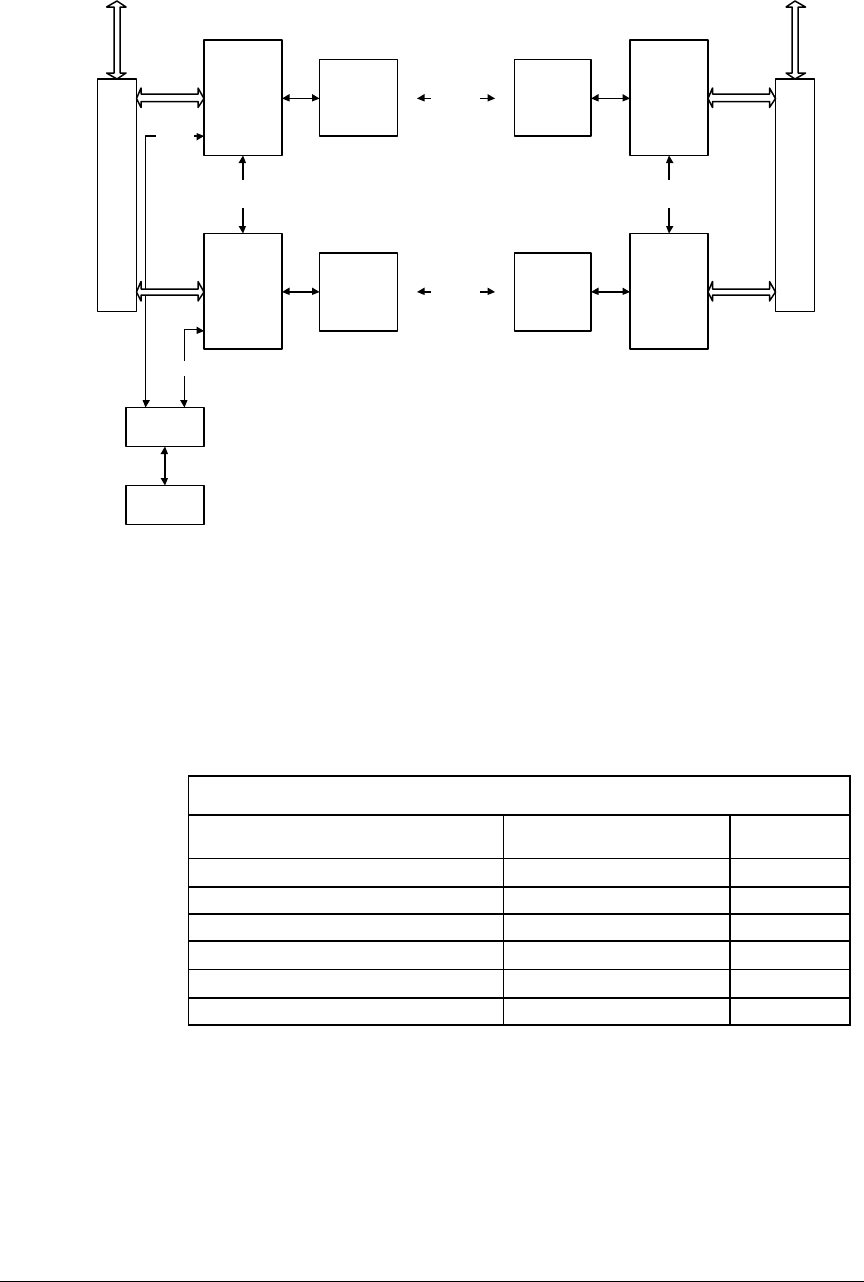
Velox LE Installation and Operations Manual
862-02411 February 04 12-3
DIU 1 A
DIU 1 B
DIU 2 A
DIU 2 B
RFU RFU
RFU RFU
RF Link A
RF Link B
HUB
Ethernet
Tributries
AUX Port
Cross Connect
Ethernet
Network Port IP Addr
192.168.1.2
Network Port IP Addr
192.168.1.4
Network Port IP Addr
192.168.1.3
Network Port IP Addr
192.168.1.5
Config PC
Tributries
AUX Port
Cross Connect
Protection Panel
Splitter/Combiner
Protection Panel
Splitter/Combiner
Figure 12-1. Block Diagram of a Typical Redundancy Protected System
where the Radio Links are Managed through an Ethernet Network
1RU Protection Panel
There are two types of protection panels: a four and an eight tributary channel panel.
They operate in the same way and perform the signal splitting and combination
functions for the tributary channels taking part in the redundancy protected radio
system. Note from Table 12-1 that the Protection Kit is currently only provided in 110-
ohm as a compromise to make provision for E1 and T1 mode.
Table 12-1: Protection Kit Connector Interfaces
Description Connector Impedance
Velox LE Protection Panel
Payload Network Interface 2xDB-25 or 8xRJ-48 110 ohm
DIU Interface 2x2xDB-25 110 ohm
Velox LE Protection Panel
Payload Network Interface DB-25 or 4xRJ-48 110 ohm
DIU Interface 2xDB-25 110 ohm
The cables required to connect the Patch Panel to the two DIUs are provided with the
Patch Panel. The DB-25 pin-outs used for each DB-25 connector on the patch panel are
exactly the same as that of the Velox LE DIUs respectively.
Auxiliary Port Communication
The two DIUs on each side of the radio link share status information through the two
relay outputs and OPTO inputs on the Auxiliary (AUX) port of each DIU. Information
shared by each of these:
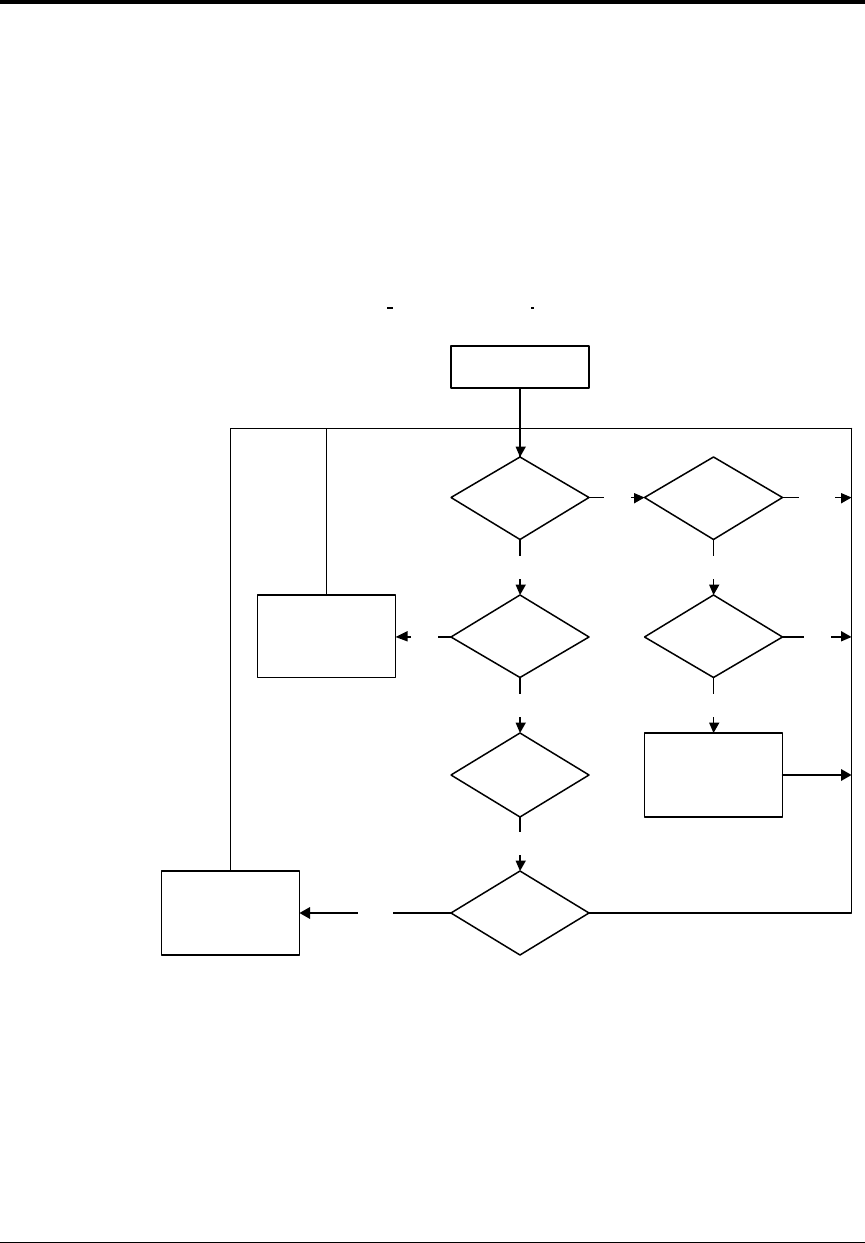
Chapter 12. 1+1 Protection System Operation
12-4 862-02411 February 04
• Indication if the DIU is currently driving the tributary channels on the user network
• The current Frame Lock status detected by the DIU for the radio link it is using
System Functional Description
Each DIU taking part in a protected radio link continuously monitors the PER of the
radio link it is receiving tributary data over. If the PER for the link increases above the
Sever Error Margin for more than 10 consecutive seconds, the DIU will request the
second DIU to take over the driving of the tributary channels if the second DIU sees a
frame lock.
Once the second DIU has started driving the tributary channels, the first DIU becomes
the redundant link.
The flow diagram for the algorithm that governs the protection switchover process in
each DIU is illustrated in Figure 12-2 below .
Is IU
driving the
Tribs
PER >
Threshold
YES
YES
Timer >= 10sec
Redundant
IU has frame lock
YES
Start Driving Tribs
& Signal
Redundant IU
Is
Redundant IU
driving Tribs
IU
has frame
lock
Reset Timer
Stop Driving Tribs
& Signal
Redundant IU
NO
NO
YES
YES
NO NO
YES
Reset
Figure 12 -2. Redundant System Switch-over Algorithm
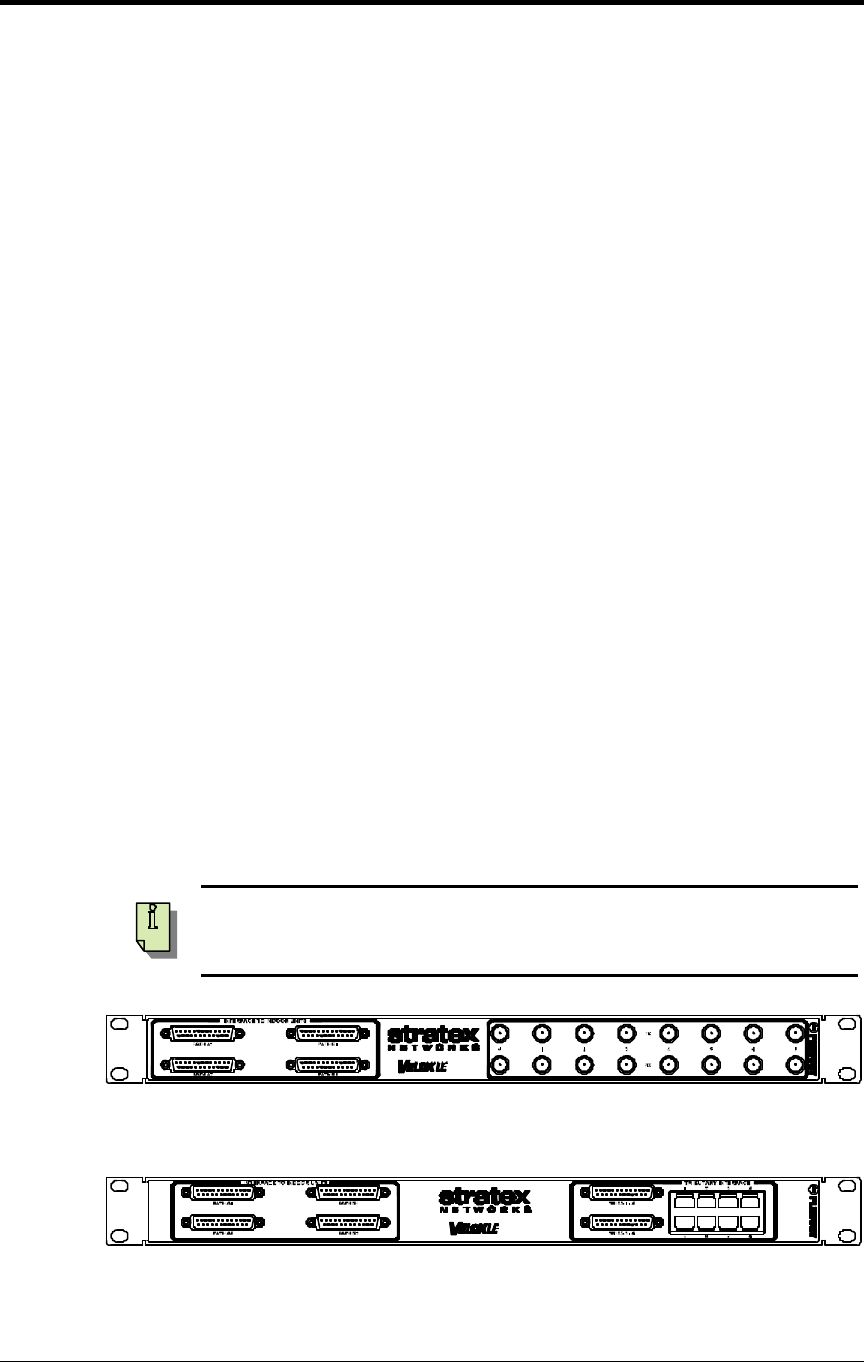
Velox LE Installation and Operations Manual
862-02411 February 04 12-5
Installation
Hardware Installation
The following list of equipment is required to set up a protected radio link:
• Four Velox LE DIUs
• Four Velox LE RFUs
• Two Velox LE Protection Kit 1RU panels (Supplied with protection kit)
• Four / Eight DIU interface loom cables (Supplied with protection kit)
• Tributary channel interface cables to connect to the user network
• Two DIU auxiliary communications cables (Supplied with protection kit)
• Standard tools and cabling required to set up a Velox LE radio link
Illustrations of the Protection Kits front panels can be seen in Figure 12-3 and Figure
12 -4 below. Note from the drawings that the Velox LE Protection Kit offers the ability
to protect eight E1/T1 tributary channels.
Follow the steps below at each site to interconnect and set up the protected radio
systems:
1. Install each DIU -RFU system as described in the Velox LE User Manual
2. Install the four / eight tributary channel Protection Kit panel in the rack mount
3. Connect tributary paths A and B on the Protection Kit panel to the two installed
DIUs using the provided DB-25 interface cables
4. Link the two DIU auxiliary ports of the DIUs through the DIU auxiliary
communications cable
5. Switch on the two units and configure the radios as explained in Radio Software
Configuration on page 12-6.
6. Connect the tributary interface of the Protection Kit panel to the user network
through the preferred interface (DB-25 / RJ48)
NOTE: Ensure that you acquire the correct protection kit, i.e. the one that matches
the DIU type you intend to use.
8U
Figure 12-3. Velox LE 8U Protection Kit Front Panel (Unbalanced)
8B
Figure 12-4. Velox LE 8B Protection Kit Front Panel (Balanced)
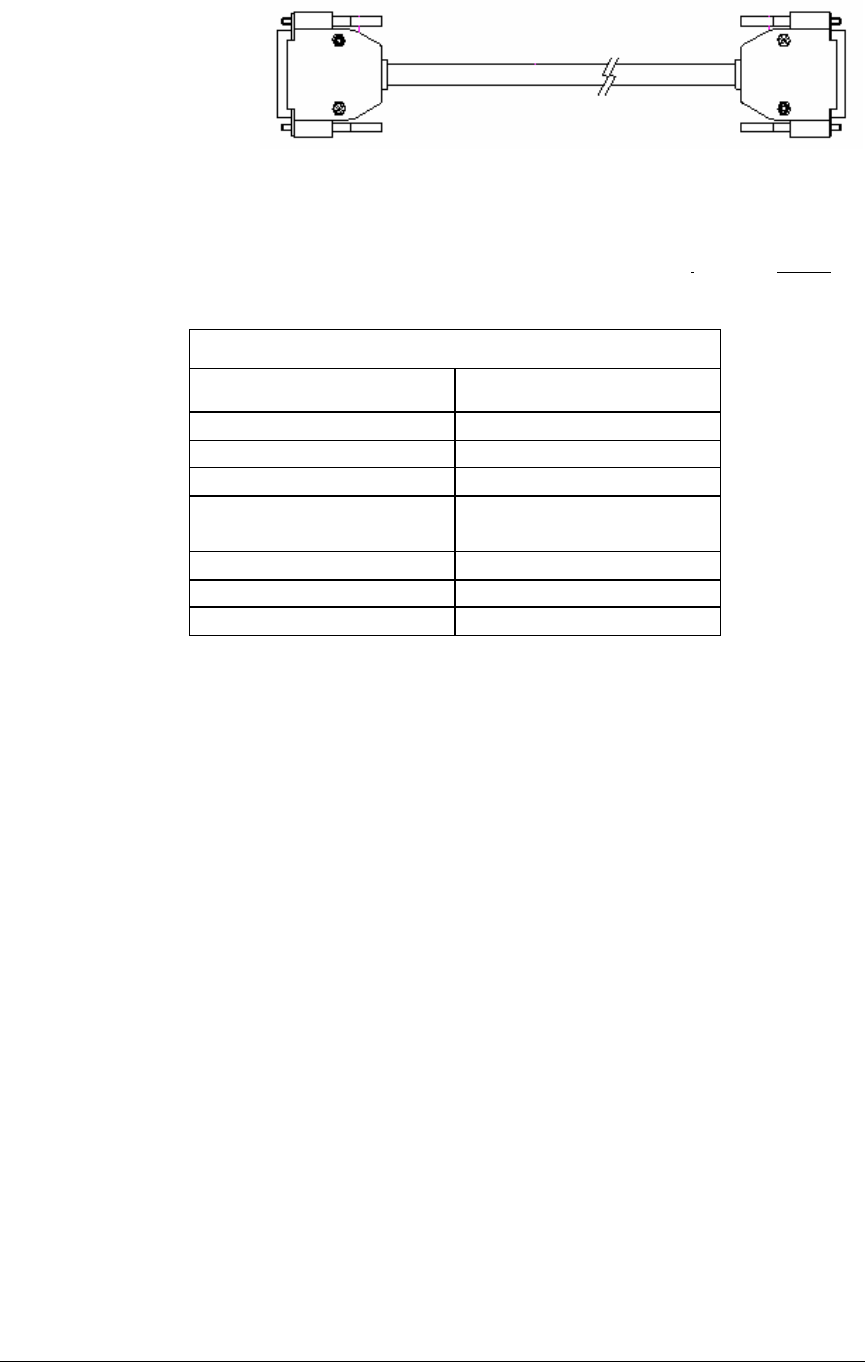
Chapter 12. 1+1 Protection System Operation
12-6 862-02411 February 04
Figure 12 -5. Tributary Channel Interface Cable used to connect Protection
Kit Paths A & B to the two DIUs
DIU auxiliary communications cables are supplied with the Protection Kit and are used
to connect the auxiliary ports of the two DIUs in accordance with Table 12-2 below.
The system diagram when using the two radio pairs in bridging mode is shown in
Figure 12-1 on page 12-3.
Table 12-2. Auxiliary Port Cross-connection
Radio 1A Pin No Radio 1B Pin No
1 12
2 13
8 14
9 15
12 1
13 2
14 8
15 9
Table 12-3. Auxiliary Port Cross-connection
Radio Software Configuration
Two MIB elements are used to configure the radios taking part in the protected radio
link. T hese MIB elements can be set using any SNMP element manager application, or
through the Velox LE NCT application. Please refer to the following for details on
using the above applications:
• Velox LE NCT HTML help file.
• 3rd party user manual (If a 3rd party SNMP element manager / MIB browser is used.
Set the following MIB element in all DIUs taking part in the protected radio link to 1
(Yes). MdrmteOnePlusOne (OID: 1.3.6.1.4.1.1316.1.1.1.2.4.17, Parent:
MdrmteGeneral)
The MIB element controlling the switch -over threshold, MdrmteSevereErrorMargin
(OID: 1.3.6.1.4.1.1316.1.1.1.2.2.18, Parent: MdrmteRFLinkConf), is set to 30% by
default. This value is a percentage and represents the switchover threshold for the
Packet Error Ratio (PER). When the PER exceeds 30%, the switchover will occur. The
value of this MIB element can be adjusted to meet the exact user requirements. It is
advisable to set the switchover threshold on all DIUs to the same value.

Velox LE Installation and Operations Manual
862-02411 February 04 12-7
System Verification
Since most of the functionality of the protected system is hidden from the user, it may
be difficult to monitor the status at times. It can however be determined by monitoring
the MIB elements listed below.
The status of the protected link can also be monitored through the Velox LE NCT.
Please refer to the Velox LE NCT user manual for more information on this option.
• Name: MdrmteOnePlusOne – shows if the protected mode is active (OID:
1.3.6.1.4.1.1316.1.1.1.2.4.17, Parent: MdrmteGeneral)
• Name: MdrmtePayloadDrive – shows if the DIU is driving the tributary channels of
the user network (OID: 1.3.6.1.4.1.1316.1.1.1.3.1.5, Parent: MdrmteInfo)
• Name: MdrmteLock – shows if frame lock is present (OID:
1.3.6.1.4.1.1316.1.1.1.3.1.6, Parent: MdrmteInfo)
• Name: MdrmtePeerPayloadDrive – shows if the Auxiliary port connected DIU
(Peer) is driving the tributary channels. This element is the inverse (opposite) of
MdrmtePayloadDrive (OID: 1.3.6.1.4.1.1316.1.1.1.3.1.7, Parent: MdrmteInfo)
• Name: MdrmtePeerLock - shows if the Auxiliary port connected DIU (Peer) has
frame lock (OID: 1.3.6.1.4.1.1316.1.1.1.3.1.8, Parent: MdrmteInfo)
• Name: MdrmteSevereErrorMargin – the threshold percentage value for link
unavailable to switch over (OID: 1.3.6.1.4.1.1316.1.1.1.2.2.18, Parent:
MdrmteRFLinkConf)
• Name: MdrmteAveragePER – average Packet Error Ratio (OID:
1.3.6.1.4.1.1316.1.1.1.1.2.15, Parent: MdrmteRFLinkPerf)
• Name: MdrmteCurrentPER – real time Packet Error Ratio. For example a PER of
1e-1 (10%) corresponds to a SevereErrorMargin value of 10. The Current PER has
to exceed the Severe Error Margin for 10 seconds continuously for the link to
become unavailable and switch over to its peer DIU. (OID:
1.3.6.1.4.1.1316.1.1.1.1.2.3, Parent: MdrmteRFLinkPerf)

Velox LE Installation and Operations Manual
862-02411 February 04 13-1
Chapter 13 : Frequently Asked
Questions (FAQ)
General FAQs
Q Can I operate several Velox LE radios in the same location?
A Yes. Up to 6 links (hops) have been operated from a single location. Please be advised
that inter-radio isolation considerations must be adhered to. This includes considerations
related to antenna transmission characteristics.
Q Can I use back-to-back RFs to make a straight repeater?
A Yes. Make sure to use either 2 high band or 2 low band radios at the same location.
Q Does the Velox LE provide channel banks or multiplex to “break down”
T1’s to DSO’s?
A No
Q Has the Velox LE been connected to a PBX with E1 interface?
A Yes. A Velox LE link conveys Primary Rate data transparently.
Q How does the Velox LE series equipment deal with interference?
A The Velox LE incorporates processing gain (through use of a spread spectrum technique).
This provides interference immunity.
Q What is the weight and dimensions of a packed Velox LE product?
A Velox LE 5800 and Velox 2400: 17.5 Kg (38.5 lb.) 57cm x 32cm x 42cm (weight
includes mounting brackets and manual).
Support FAQs
Q Do you have 24 hour 7 day technical support if I have a radio failure?
A Technical support queries should be routed to the supplier from whom the equipment was
purchased. As accredited distribution/sales channels, they are trained to deal with the
majority of technical support issues. Should it be required, they will escalate the issue to
Stratex Networks that has a worldwide support network. For informatio n on Stratex
Networks support facilities refer to Support on page 1-4.

Chapter 13. FAQ
13-2 862-02411 February 04
Q Where do I call for technical support?
A Your first call should be to the supplier from whom the equipment was purchased. As
accredited distribution/sales channels they have been trained to deal with the majority of
technical support issues which may arise. Should it be required, they will escalate the
issue to Stratex Networks itself. For information on Stratex Networks support facilities
refer to Support on page 1-4.
Q For protected systems, can I use a double feeder antenna?
A Yes, two independent links are used for a protection system. Stratex Networks suggest
using two different Tx frequencies. Essentially providing polarization diversity.
Q How do I upgrade my Velox LE 2400 or Velox LE 5800 radio from 1E1/T1 to
2 and 4 E1/T1?
A A tributary code must be purchased. You use the NCT, a graphical utility to "load" the
tributary code into the DIU. Thereafter, extra tributaries can be activated. See Chapter 5:
NCT Installation for information on the NCT and Chapter 7:Tributary Upgrading.
Q What T1/E1 configuration do I order if I only want to use radio for maximum
capacity (10 Mbit) Ethernet?
A Radios with a single T1/E1 active are all that are required to provide this capacity. You
then deact ivate the tributary using the graphical software utility supplied with the Velox
LE radios.

Velox LE Installation and Operations Manual
862-02411 February 04
Index
1
1+1 Protection System
Overview, 12-1
A
Abbreviations, 1-3
About
1+1 Protection System, 12-1
1+1 Redundancy Protected Payload System, 8-14
DIU, 8-11
Frequency Plans, 8-5
RFU, 8-4
Velox LE Digital Radio Systems, 8-1
Accessories Supplied, 4-9
Adding a Modem for Windows NT, 6-3
Adding Dial-up Networking for Windows NT, 6-3
Antenna Alignment, 4-23
Antenna Connector, 3-13
Antenna Installation, 4-16
Antenna Isolation, 2-6
Antenna Selection, 2-2
Associated Documents, 1-2
Auxiliary I/O, 3-10
Auxiliary Input Interface, 8-19
Auxiliary Output Interface, 8-19
B
Back Panel
Velox LE 75/120 Ohm DIU, 3-2
Back-to-Back test
With PC, 4-12
Without PC, 4-10
Balanced 120 Ohm
Pin Connections, 3-4, 3-6
BaseBand Loopback, 4-26
Bridged Configuration
IP Address Assignment, 6-7
C
Cables
DIU to RFU (RJ45 + power)
Cable type, 8-2
Cables Assemblies to be Manufactured, 4-7
Commissioning, 4-22
Information required, 4-22
Set Transmitted Power Level, 4-26
Commisssioning
Equipment required, 4-22
Configuring a 1+1 Protection System, 12-2
Control, Indicators and Connectors on the DIU, 3-1
Customer Supplied Equipment, 4-8
D
Diagnostics, 4-26
Dial-up networking
Add
Windows 95/98, 6-5
DIU
Installation, 4-19
Payload Interface Options, 8-13
Variants, 9-1
DIU Comms LED, 3-14
DIU DC In Connector, 3-14
DIU DC Power Input, 3-11
DIU description, 8-11
DIU Power LED , 3-14
DIU Status Diodes, 3-6
DIU to RFU Data cables
Installation, 4-21
DIU/RFU Data, 3-10
DIU/RFU Data Connector, 3-14
DIU/RFU Link LED, 3-9
E
Electrical Performance data, 8-15
Element Manager Port, 3-9
Element Manager Port Interface, 8-19
Environmental data, 8-14
Equipment Required for Commissioning, 4-22
Ethernet Traffic Interface, 8-18
ETSI Notice, 3
F
FAQs
General, 13-1
Support, 13-1
FCC Notice, 3
Firmware
Upload
FTP, 7-1
Firmware upgrades, 7-1
Fixed Antennas, 2-3
Frequency Multiplexing, 2-6
Frequency Plans, 8-5
Frequency Channel Plan D (FCC Compliant), 8-9
Velox LE 2410 and Velox LE 2410i, 8-6
Velox LE 2410 and Velox LE 2410i (USA Only), 8-5
Velox LE 2450 and Velox LE 2450i (FCC Compliant),
8-8
Velox LE 5810 and Velox LE 5810i, 8-5
Velox LE 5850 and Velox LE 5850i, 8-6
Front Panel
Velox LE 10 DIU, 3-2
Velox LE 25 DIU, 3-2
Velox LE 50 DIU, 3-3
Velox LE 75/120 Ohm DIU, 3-2
Velox LE DIU 120 Ohm, 3-2
Velox LE IP DIU, 3-3
Front Panels
Velox LE IRFU, 3-13
Full duplex mode at max transfer rate, 7-2
Fuse Holder, 3-12

Index
862-02411 February 04
G
General Hazards, 4-2
Graphical Cues, 1-2
Ground Terminal, 3-12
Ground Terminal (RFU), 3-15
H
Hardware Installation Overview, 4-5
Health and Safety
General, 4-1
General Hazards, 4-2
Operator, 4-2
Requirements, 4-1
Health and Safety Requirements, 4-1
I
IF Loopback, 4-26
Indoor/RFU Interface, 8-19
INDUSTRY CANA DA Notice, 3
Installation
Antenna, 4-16
Antenna Alignment, 4-23
Back-to-Back test (without PC), 4-10
Cables Assemblies to be Manufactured, 4-7
Commissioning, 4-22
Contents of Accessories Box, 4-9
DIU, 4-19
DIU to RFU Data cables, 4-21
IRFU, 4-19
Knowledge required, 1-1
ORFU, 4-16
Overview, 4-5
Power Cables, 4-21
Pre-Installation Checks, 4-6
RFU Mechanical, 4-17
Tools and Equipment, 4-6
Unpacking the Equipment, 4-8
User Supplied Equipment, 4-8
Installation Planning
Antenna Isolation, 2-6
Antenna Selection, 2-2
Fixed Antennas, 2-3
Frequency Multiplexing, 2-6
Interference, 2-4
Multipath Effects, 2-4
Site Evaluation, 2-3
System Type Selection, 2-1
Transmitted Power Levels, 2-5
Installation Record, 4-27
Installing a 1+1 Protection System, 12-5
Interfaces
Auxiliary Input, 8-19
Auxiliary Output, 8-19
Element Manager Port, 8-19
Ethernet Traffic, 8-18
Indoor/RFU, 8-19
Wayside Channel, 8-19
Interference considerations, 2-4
IP Address Assignment
Bridged configuration, 6-7
Routed Configuration, 6-9
IP configuration of the Velox LE, 6-7
IRFU
Installation, 4-19
L
Loopback Procedure, 4-27
M
Manual contents, 1-2
MIB Elements – OID (Object ID) Descriptions, 11-2
MIB Elements – Trap Descriptions, 11-19
Microcell Backhaul, 2-5
Modem
Add
Windows 95/98, 6-4
Modulation
Different types
Velox LE 2400, 8-15
Velox LE 5800, 8-16
Velox LE 5850, 8-10
Multipath Effects, 2-4
N
NCT
Installation, 5-2
JRE Installation, 5-2
PC requirements, 5-2
PC Set-up, 6-1
Using to configure a Radio, 5-3
NCT PC Set-up
Adding a Modem for Windows NT, 6-3
Adding Dial-up Networking for Windows NT, 6-3
Adding Dial-up Networking for Windows XP, 6-2
Dial-up Connection Properties for Windows
2000/Windows XP, 6-2
Dial-up Networking
Windows 2000, 6-1
PPP Serial Communications, 6-1
NCT Software Installation, 5-1
O
On/Off Switch, 3-12
ORFU
Installation, 4-16
Overview of the system, 8-4
P
Payload Data Interfaces specification, 8-18
Payload Interface Options, 8-13
Ethernet Payload, 8-13
Tributary Payload, 8-13
Payload T1/E1 Connectors, 3-3
Balanced/Unbalanced 25-Way DiType, 3-3, 4-20
Balanced/Unbalanced RJ48, 3-5
Unbalanced Payload Data (BNC), 3-6
Physical data, 8-14
Pin Connections for Balanced 120 Ohm Termination on
25-Way D-Type Connector, 3-4
Pin Connections for Balanced RJ48 Connectors on Velox
LE 10 and Velox LE 25 DIUs, 3-6
Pin Connections for Unbalanced 75 Ohm Termination on
25-Way D-Type Connector, 3-4, 4-20
Pinging on a Bridged Network, 6-7
Pin-outs
Auxiliary In/Out Connector, 3-10

Velox LE Installation and Operations Manual
862-02411 February 04
DC Power Connector (Velox LE 10, Velox LE 25,
Velox LE 50 DIU), 3-12
DC Power Connector (Velox LE DIU 120 Ohm &
75/120 Ohm), 3-12
RFU Antenna Connector, 3-14
RFU RSSI Connector, 3-14
Service Channel Connector, 3-9
Power
DIU DC requirement, 8-14
Power Cables
Installation, 4-21
Pre-Installation Checks, 4-6
R
Reset/Configuration Button, 3-7
RF Interface specification, 8-17
RF Loopback, 4-26
RF Power Output Options, 8-11
RFU
Variants, 9-1
RFU DC Out, 3-10
RFU description, 8-4
Routed Configuration
IP Address Assignment, 3-8, 6-9
RSSI Connector, 3-14
S
Service (Wayside) Serial Data Channel, 3-8
Set Transmitted Power Level, 4-26
Site Evaluation, 2-3
Site Installation, 4-15
Software configuration of a 1+1 Protection System, 12-6
Stratex Networks
Contacting, 1-4
Support, 1-4
System Matrix, 9-2
System Type Selection, 2-1
System Variants, 9-4
T
Test Record, 4-28
Tools and Equipment for Installation, 4-6
Transceiver Characteristics, 8-17
Transmitted Power Levels, 2-5
Tributary Upgrading, 7-3
U
Unbalanced 75 Ohm
Pin Connections, 3-4, 4-20
Unpacking the Equipment, 4-8
Upgrading
Firmware, 7-1
Tributaries, 7-3
V
Velox LE
Models available, 8-2
Verifying a 1+1 Protection System, 12-7
W
Wayside Channel Interface, 8-19